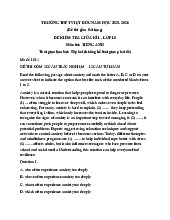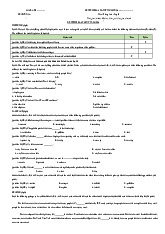
Trang 1
SỞ GIÁO DỤC VÀ ĐÀO TẠO GIA LAI
TRƯỜNG : THPT CHUYÊN HÙNG VƯƠNG
KỲ THI OLYMPIC TRUYỀN THỐNG 30 - 4 LẦN THỨ XXIV
ĐỀ THI ĐỀ NGHỊ MÔN: TIẾNG ANH ; KHỐI: 10
NĂM HỌC 2017 - 2018
I. MULTIPLE CHOICE QUESTIONS (40 pts)
QUESTION 1: WORD CHOICE ( 5pts)
Choose the word or phrase from A, B, C or D that fits each blank.
1.I’m afraid Jennifer’s very ______ She believes everything she’s told.
A. gullible B. trustworthy C. credible D. honest
2.In the hands of a reckless driver, a car becomes a _____ weapon.
A. lethal B. fatal C. mortal D. venal
3. I slept badly last night and am feeling particularly ______ this morning.
A. slow-witted B. far-reaching C. off-hand D. top-heavy
4.Radio and television make it possible for the news to be widely______ .
A. disseminated B. dislocated C. dismantled D. expressed
5. You can’t bury your head ______ and hope that this problem goes away, you know.
A. in the mud B. in the pool C. in the sand D. in the water
6.Unanswered, the demands for nuclear deterrents have _______ fears of civil war.
A. flashed up B. prognosticated C. sidetracked D. stoked up
7.This evidence should prove ______ that he was telling the truth
A.once and for all B.from time to time C.over and above D.now and then
8.A new computer has been produced, which will ______ all previous models
A.overdo B.supersede C.excel D.overwhelm
10. My decision to drop out of university after a year is one I now _____ regret.
A. painfully B. harshly C. heavily D. keenly
KEYS : 1A 2.A 3. D 4.A 5.C 6. D 7. A 8. B 9. D 10. A
QUESTION 2 : STRUCTURES AND GRAMMAR (5pts)
Choose the answer which best complete each sentence
1. I supposed, as ______ we all, that the meeting would be cancelled.
A. did B. would C. only D. just
2. Although the Moon appears ______, it reflects on average only 7 percent of the light that
falls on it.
A. bright to the eye B. brightly to the eye
C. bright in the eye D. brightly in the eye
3. “What would you do in my place?” - “Were ______ treated like that, I’d complain to the
manager.”
A. I to be B. I to had been C. I have been D. to I be
4. ______ the catfish is prized for its taste.
A. With ugly look B. As ugly looking
C. Ugly looking as it is D. As it is ugly looking
5. His advice that it ______ at once is reasonable.
A. should do B. be done C. needs to be done D. is done
6. At no time ______ you pay a rise.
A. did I ever promise B. do ever I promise
C. I have ever promised D. had ever I promised

Trang 2
7. Dick put ______ ball in ______ net in ______ second half but ______ goal was disallowed
A. a/a/a/a B. the/the/the/the C. the/the/a/a D. a/a/the/the
8. ______ about what he had heard, John telephoned hia brother
A. Having worried B.To worry C. He worried D. Worried
9. ______ given to the various types of microscopic plants and animals found in water
A. Named plankton B. the name of plankton
C. Plankton’s name D. Plankton is the name
10. You must ______ asleep in the train.
A. have been tired if you fallen B. be tired if you fallen
C. have been tired if you fell D. have been tired if you fall
KEYS : 1A 2.A 3. A 4.C 5.B 6. A 7. B 8. D 9. D 10. C
QUESTION 3 : PREPOSTIONS AND PHRASAL VERBS (5pts)
Choose the most suitable options to complete each sentence
1. Both the favourite and then the second favourite pulled out. Naturally, we thought we were
______ a chance.
A in with B up for C in for D up with
2. His company went bankrupt, three years of hard work ______ the drain.
A. into B. in C. down D. low
3. Don’t quote me. What I am about to say is ______ the record.
A. on B. off C. without D. above
4.I was so tired that I just ______ in the armchair
A.flaked out B.broke up C.dropped out D.fell over
5.The subject of sex equality seem to ______ in every discussion lesson in my school
A.burst out B.zero in C.crop up D.harp on
6.Our teacher tendsto ______ certain subjects which she finds difficult to talk about
A.boil down B.string along C. skate over D.track down
7.It’s a good idea to ______ people before taking them into your confidence
A.tumble to B.root out C.bank on D.size up
8.Some people can just ______ a cold,but my colds seem to linger for weeks
A.shrug off B.cough up C.pull through D.stamp out
9.The man in the market was selling leather coats very cheaply: they were such bargainsthat
were soon ______ .
A.cleared off B.done for C.bought out D. snapped up
10.I couldn’t remember where I had left my car , when it suddenly ______ me that I didn’t
have a car any longer!
A.dawned on B.ran into C.went through D.tumbled to
KEYS : 1A 2.C 3. B 4.A 5.C 6. C 7. D 8. A 9. D 10. A
QUESTION 4 : COLLOCATIONS AND IDIOMS ( 5pts)
Choose the answer which best complete each sentence
1. It’s great here. Have had ______ ever since we arrived. We’re having a wonderful time.
A. broken sunshine B. unbroken sunshine
C. unbroken light D. unbroken clouds
2. Palair Airlines offers excellent ______ entertainment, with the latest movies and music.
A. on-flight B. during-flight C. in-flight D. over-flight
3. The cottage is in some wonderful ______ countryside on the edge of a dense forest.
A. far B. unspoiled C. great D. spoilt
4. As students, David, Kevin and William were as thick as ______ .

Trang 3
A. thieves B. boy scouts C. a team D. thistles
5. Whenever I feel embarrassed I always go as red as ______ .
A. a rose B. lipstick C. a raspberry D. a beetroot
6. He might look kind and sympathetic, but deep down he’s as hard as ______ .
A. nails B. a mountain C. a gangster D. an iceberg
7. Nagging Susan to stop smoking has no effect on her. It’s like water off ______ .
A. a windmill B. a duck’s back C. a dripping tap D. an umbrella
8. My father ______ when he found out that I’d damaged the car.
A. hit the roof B. saw pink elephants
C. made my blood boil D. brought the house down.
9.My mother ______ for an anvironmental group. She helps raise money to protect wildlife
A. indentifies B. encourages C. shares D. volunteers
10.At the 1952 Olympics, speed skaters who had taken amphetamines became ______ ill.
A grimly B. gravely C. solemnly D. rigorously
KEYS : 1D 2.C 3. A 4.A 5.D 6. A 7. B 8. A 9. D 10. B
QUESTION 5: READING COMPREHENSIONS. (10ms)
Passage 1: Read the following passage and choose the best option to complete the blank or
answer the question. (5 pts)
Life originated in the early seas less than a billion years after Earth was formed.
Yet another three billion years were to pass before the first plants and animals appeared
on the continents. Life's transition from the sea to the land was perhaps as much of an
evolutionary challenge as was the genesis of life.
What forms of life were able to make such a drastic change in lifestyle ? The traditional
view of the first terrestrial organisms is based on megafossils ― relatively large specimens of
essentially whole plants and animals. Vascular plants, related to modern seed plants and
ferns, left the first comprehensive megafossil record. Because of this, it has been commonly
assumed that the sequence of terrestrialization reflected the evolution of modern terrestrial
ecosystems. In this view, primitive vascular plants first colonized the margins of continental
waters, followed by animals that fed on the plants, and lastly by animals that preyed on the
plant-eaters. Moreover, the megafossils suggest that terrestrial life appeared and diversified
explosively near the boundary between the Silurian and the Devonian periods, a little more
than 400 million years ago. Recently, however, paleontologists have been taking a closer look
at the sediments below this Silurian-Devonian geological boundary. It turns out that some
fossils can be extracted from these sediments by putting the rocks in an acid bath.The
technique has uncovered new evidence from sediments that were deposited near the shores of
the ancient oceans ― plant microfossils and microscopic pieces of small animals. In many
instances, the specimens are less than one-tenth of a millimeter in diameter. Although they
were entombed in the rocks for hundreds of millions of years, many of the fossils consist of
the organic remains of the organism.
These newly discovered fossils have not only revealed the existence of previously
unknown organisms, but have also pushed back these dates for the invasion of land by
multicellular organisms. Our views about the nature of the early plant and
animal communities are now being revised. And with those revisions come new
speculations about the first terrestrial life-forms.
1. The word “drastic” in the second paragraph is closest in meaning to ______.
A. widespread B. radical C. progressive D. risky
2. According to the theory that the author calls “the traditional view,” what was the first form
of life to appear on land?
A. Bacteria B. Meat-eating animals
C. Plant-eating animals D. Vascular plants
3. According to the passage, what happened about 400 million years ago?

Trang 4
A. Many terrestrial life-forms died out
B. New life-forms on land developed at a rapid rate.
C. The megafossils were destroyed by floods.
D. Life began to develop in the ancient seas.
4. The word “extracted” in line 18 is closest in meaning to _____.
A. located B. preserved C. removed D. studied
5. What can be inferred from the passage about the fossils mentioned in lines 17-20 ?
A. They have not been helpful in understanding the evolution of terrestrial life.
B. They were found in approximately the same numbers as vascular plant fossils.
C. They are older than the megafossils.
D. They consist of modern life-forms.
6. The word “instances” in line 21 is closest in meaning to ______.
A. methods B. processes C. cases D. reasons
7. The word “they” in line 22 refers to ______.
A. rocks B. shores C. oceans D. specimens
8. The word “entombed” in lime 22 is closest in meaning to ______.
A. crushed B. trapped C. produced D. excavated
9. Which of the following resulted from the discovery of microscopic fossils?
A. The time estimate for the first appearance of terrestrial life-forms was revised.
B. Old techniques for analyzing fossils were found to have new uses.
C. The origins of primitive sea life were explained.
D. Assumptions about the locations of ancient seas were changed.
10. With which of the following conclusions would the author probably agree?
A. The evolution of terrestrial life was as complicated as the origin of life itself.
B. The discovery of microfossils supports the traditional view of how terrestrial life
evolved.
C. New species have appeared at the same rate over the course of the last 400 million
years.
D. The technology used by paleontologists is too primitive to make
accurate determinations about ages of fossils.
KEYS:
1. B 2. D 3. B 4. C 5. C
6. C 7. D 8. B 9. A 10. A
Passage 2: Read the following passage and choose the best option to complete the blank or
answer the question. (5 pts)
Animation traditionally is done by hand-drawing or painting successive frames of an
object, each slightly different than the preceding frame. In computer animation, although the
computer may be the one to draw the different frames, in most cases the artist will draw the
beginning and ending frames and the computer will produce the drawings between the first
and the last drawing. This is generally referred to as computer-assisted animation, because the
computer is more of a helper than an originator.
In full computer animation, complex mathematical formulas are used to produce the final
sequence of pictures. These formulas operate on extensive databases of numbers that define
the objects in the pictures as they exist in mathematical space. The database consists of
endpoints, and color and intensity information. Highly trained professionals are needed to
produce such effects because animation that obtains high degrees of realism involves
computer techniques for three-dimensional transformation, shading, and curvatures.
High-tech computer animation for film involves very expensive computer systems along
with special color terminals or frame buffers. The frame buffer is nothing more than a giant

Trang 5
image memory for viewing a single frame. It temporarily holds the image for display on the
screen.
A camera can be used to film directly from the computer's display screen, but for the
highest quality images possible, expensive film recorders are used. The computer computes
the positions and colors for the figures in the picture, and sends this information to the
recorder, which captures it on film. Sometimes, however, the images are stored on a large
magnetic disk before being sent to the recorder. Once this process is completed, it is repeated
for the next frame. When the entire sequence has been recorded on the film, the film must be
developed before the animation can be viewed. If the entire sequence does not seem right, the
motions must be corrected, recomputed, redisplayed, and rerecorded. This approach can be
very expensive and time consuming. Often, computer-animation companies first do motion
tests with simple computer-generated line drawings before selling their computers to the task
of calculating the high-resolution, realistic-looking images.
1. What aspect of computer animation does the passage mainly discuss?
A. The production process B. The equipment needed
C. The high cost D. The role of the artist
2. According to the passage, in computer-assisted animation the role of the computer is to
draw the____.
A. first frame B. middle frames
C. last frame D. entire sequence of frames
3. The word "they" in the second paragraph refers to____.
A. formulas B. databases C. numbers D. objects
4. According to the passage, the frame buffers mentioned in the third paragraph are used
to____.
A. add color to the images B. expose several frames at the same time
C. store individual images D. create new frames
5. According to the passage, the positions and colours of the figures in high-tech animation
are determined by____.
A. drawing several versions B. enlarging one frame at a lime
C. analyzing the sequence from different angles D. using computer calculations
6. The word "captures" in the fourth paragraph is closest in meaning to____.
A. separates B. registers C. describes D. numbers
7. The word "Once" in the fourth paragraph is closest in meaning to____.
A. before B. since C. after D. while
8. According to the passage, how do computer-animation companies often test motion?
A. They experiment with computer-generated line drawings.
B. They hand-draw successive frames.
C. They calculate high-resolution images.
D. They develop extensive mathematical formulas.
9. The word "task" in the 4th paragraph is closest in meaning to____.
A. possibility B. position C. time D. job
10. Which of the following statements is supported by the passage?
A. Computers have reduced the costs of animation.
B. In the future, traditional artists will no longer be needed.
C. Artists are unable to produce drawings as high in quality as computer drawings.
D. Animation involves a wide range of technical and artistic skills.
KEYS: 1A 2B 3D 4C 5D 6B 7C 8A 9D 10D
QUESTION 6: CLOZE TEST (10 PTS)
Passage 1: Read the following passage and mark the letter A, B, C or D on your answer
sheet to indicate the correct word for each of the blanks. (5pts)

Trang 6
Why did you decide to read this, and will you keep reading to the end? Do you expect to
understand every single part of it and will you remember anything about it in a fortnight’s
(1) _________? Common sense (2) _________ that the answers to these questions depend on
“readability”- whether the (3) ________ matter is interesting, the argument clear and the
(4)___________ attractive. But psychologists are trying to (5)__________why people read -
and often don’t read certain things, for example technical information. They also have
examined so much the writing as the readers.
Even the most technically confident people often (6)__________ instructions for video or
home computer in favor of hands - on experience. And people frequently take little notice of
consumer information, whether on nutritional labels or in the small print of contracts.
Psychologists researching reading (7)__________to assume that both beginners and
competent readers read everything put in front of them from start to finish. There are
(8)__________among them about the roles of eyes, memory and brain during the process.
Some people believe that fluent readers take in very letter or word they see; others
(9)___________ that readers rely on memory or context to carry them from one phrase to
another. But they have always assumed that the reading process is the same: reading starts,
comprehension (10)___________ then reading stops.
1. A. term B. gap C. period D. time
2. A. informs B. transmits C. suggests D. advises
3. A. text B. content C. subject D. topic
4. A. layout B. assembly C. pattern D. formation
5. A. value B. determine C. rate D. ensure
6. A. pass B. miss C. ignore D. omit
7. A. tend B. lead C. undertake D. consent
8. A. contests B. arguments C. objections D. separations
9. A. direct B. insist C. press D. urge
10. A. issues B. sets C. establishes D. occurs
KEYS:
21D 22C 23C 24A 25B 26C 27A 28B 29B 30D
Passage 2: Read the following passage and mark the latter A, B, C or D on your answer
sheet to indicate the word or phrase that best fits each of the numbered blanks. (5pts)
Why is it that many teenagers have the energy to play computer games until late at night
but can’t find the energy to get out of bed (1) ________ for school? According to a new
report, today’s generation of children are in danger of getting so (2)_______ sleep that they
are putting their mental and physical health at (3)_______. Adults can easily survive on seven
to eight hours’ sleep a night, (4)_______teenagers require nine or ten hours. According to
medical experts, one in five youngsters (5)________ anything between two and five hours’
sleep a night less than their parents did at their age.
This (6) _____ serious questions about whether lack of sleep is affecting children’s
ability to concentrate at school. The connection between sleep deprivation and lapses in
memory, impaired reaction time and poor concentration is well (7) _______. Research has
shown that losing as little as half an hour’s sleep a night can have profound effects (8)
______how children perform the next day. A good night’s sleep is also crucial for teenagers
because it is while they are asleep (9)______ they release a hormone that is essential for their
‘growth spurt’ (the period during teenage years when the body grows at a rapid rate). It’s true
that they can, to some (10) ______, catch up on sleep at weekends, but that won’t help them
when they are dropping off to sleep in class on a Friday afternoon.
By Tim Falla and Paul A.Davies, Solutions Advanced. OUP
1. A. behind time B. about time C.in time D. at time
2. A. few B. less C. much D. little
3. A. jeopardy B. threat C. risk D. danger

Trang 7
4. A. or B. because C. whereas D. so
5. A. puts B. gets C. brings D. makes
6. A. raises B. rises C. results D. comes
7. A. organized B. arranged C. established D. acquired
8. A. in B. on C. to D. at
9. A. at which B. which C. where D. that
10. A. rate B. extent C. level D. point
KEYS:
1C 2D 3C 4C 5B 6A 7C 8B 9D 10B
B. WRITTEN TEST
QUESTION 1: OPEN CLOZE TEST: (20pts)
Close test 1: Fill each blank with ONE word. (10 pts)
CELL PHONES
Cell phones have been popular in Japan since the early 1990s, but it was not (1) ____ 1999
that their use really took off. The age of cell phones has emerged, but with it come problems.
Cell phones are used on buses and trains, in restaurants, and in all (2) ______ of life. They
cause problems when they (3) ______ during meetings, concerts, wedding, or even funerals.
What’s more, people speak loudly in public, and students read and text messages during
lessons. More seriously, when a cell phone is used near a person using a (4) ______ to
regulate his heartbeat, its radio waves may (5) ______ with the functioning of the pacemaker.
Now, something is being done to (6) ______ these problems. In many places, new
technology is being used to block cell phone calls. Airline (7) ______ are requested to stop
using cell phones while on board. Concert halls ask their audience to switch their phones to
the (8) ______ mode. However, phone users fear that if they do not answer their phones, they
will (9) ______ valuable business opportunities. That’s why many do not (10) ______ off
their phones even when they are asked to.
KEYS:
1. until 2. areas 3. ring 4. pacemaker 5. interfere
6. solve 7. passengers 8. silent 9. lose 10. turn
Close test 2: Fill each blank with ONE word. (10 pts)
The Importance of Being Sporty
It is a multi-million dollar industry and that attracts some of the most talented
individuals alive, it generates further millions (1) ______ advertising revenue and has
spawned a whole celebrity culture of its (2) ______ . But what role does sport play in our
ordinary lives?
Few people are untouched (3) ______ sport. We all have (4) _____ favorite football
team or tennis player or, at least, support our national side in major sporting events like the
Olympics. How can it be, then, that so (5) ______ people actually play sports and that obesity
is becoming a major threat in the developed world?
Well, in part, the answer is (6) ______ the question. Obesity is not a problem in the
developing world (7) ______ participation in sport is still high. True, there may be few
organized leagues but children the world still go out to play games like football with other
children and this comes the supremacy of countries like Brazil in the world of football.
So, what is stopping the British or the Americans? After (8) ______ , they still have
organized sports in schools and a myriad of clubs and teams to join in their spare time. What
they lack is a public space for children to play unsupervised outdoors. As a result, they are
kept indoors and encouraged to play online (9) ______ of getting our in the fresh air. They
may of course still develop a love of sport as spectators but this is unlikely to do much to
lower levels of obesity (10) ______ the young.
KEYS:

Trang 8
1. in 2. own 3. by 4. our 5. few
6. in 7. where 8. all 9. instead 10. among
QUESTION 2: WORD FORMS (20 pts)
Part 1: Complete the sentence with the correct form of the given word. (10 pts)
1. Janet’s exam results turned out to be __________ DISASTER
2.You look rather _______. Are you worried about something? OCCUPY
3. There are very few _______ places on earth today. Man has been nearly everywhere.
EXPLORE
4.The doctor gave him an injection to _______ the pain. DIE
5. Nowadays people may no longer suffer from lifetime physical _______. NORMAL
6. Home-made ice-cream is one of our _______. SPECIAL
7. The meeting has been _______ arranged for 3 p.m next Friday. PROVIDE
8. The government’s _____ approach has brought criticism. COMPROMISE
9. Jim is one of the most _______ members of the committee. SPEAK
10.Many newspapers today gave very sensational ______ about the private life of that
Hollywood star. CLOSE
KEYS:
1. disastrous 2. preoccupied 3. unexplored 4. deaden
5. abnormalities 6. specialties 7. provisionally 8. Uncompromisin9.
outspoken 10. disclosures
Part 2: Complete the passage with appropriate forms from the words given in the
box.(10 pts)
angry fashion foreign frustrate generate
patient polite secret serve tradition
“All things come to those who wait.” It’s a (1) ______ phrase that has kept the British
patiently in line for years. For (2) ______we’ve been waiting our turn. This may sometimes
have led to (3) _____ abroad, when (4) ______ haven’t always respected the rules of the
orderly queue. But at home we have (5) ______ enjoyed our reputation. It’s rather (6) ______,
though, isn’t it? Today’s highly developed culture of (7) _____ to the public seems to have
more in common with the American “I want it and I want it now” philosophy. But our (8)
______ seems to be growing. We may wait with less (9) ______ than we used to – you only
have to observe the (10) ______ shoppers in a supermarket queue. But wait we still do.
KEYS:
1. traditional 2. generations 3. anger 4. foreigners 5. secretly
6. unfashionable 7. service 8. patience 9. politeness 10. frustrate
QUESTION 3: ERROR IDENTIFICATION (10 pts)
Identify 10 errors in the following passage and correct them.
It is very difficult to succeed in the music business; nine out of ten bands that release a
first record fail to produce the second. Surviving in the music industry requires luck and
patience, but most of all it requires and intricate knowledge of how a record company is
functioned. The process begins when a representative of a company's Artists and Reportoire
(A & R) department visits bars and night clubs, scouting for young, talented bands. After the
representative identifies a promised band, he or she will work to negotiate a contract with that

Trang 9
band. The signature of this recording contract is a slow process. A company will spend a long
time to investigate the band itself as well as current trands in popular music. During this
period, it is important that a band reciprocates with an investigation of its own, learning as
much as possible about the record company and making personnel connections within the
different departments that will handle their recordings.
@
Write your answers here:
KEYS:
1. the second
à
a second
2. and intricate
à
an intricate
3. is functioned
à
functions
4. Reportoire
à
Repertoire
5. promised
à
promising
6. signature
à
signing
7. to investigate
à
investigating
8. trands
à
trends
9. reciprocates
à
reciprocate
10. personnel
à
personal
QUESTION 5: SENTENCE TRANSFORMATION (20pts)
Part 1:Finish each of the second sentences in such a way that they have the same
meaning as the original ones:
1. I left without saying goodbye as I didn’t want to disturb the meeting.
g Rather ________________________________________
2. For further information, please send a self-addressed envelope to the above address.
→ Further information can ________________________________________
3. It shouldn’t have surprised me that my children didn’t like the new, cheaper ice-cream..
→ I might ________________________________________
4. The noise made by the children didn’t prevent the baby from sleeping soundly.
→ Whatever ________________________________________
5. Don’t run away with the idea that this job is easy. (conclusion)
→ ________________________________________
6. Russ’s opinions on the new management policies were very different from those of his
fellow workers. (odds)
→ Russ ________________________________________ the new management policies.
7. The young actress was very nervous before the audition. (butterflies)
→ _____________________________________________________
8. Margaret is said to be a very good cook. ( reputation)
→ _____________________________________________________
9. She chooses the kind of hotels she stays in very carefully.
1
2
3
4
5
6
7
8
9
10

Trang 10
→ She’s very fussy _________________________________________
10. The rocketing prices have proved too much for most salaried people. (cope)
→ _____________________________________________________
KEYS:
1. Rather than disturb the meeting, I left without saying goodbye.
2. Further information can be obtained by sending a self-addressed envelope to the above
address.
3. I might have known my children would not like the new, cheaper ice-cream.
4. Whatever the noise the children made, the baby slept soundly.
5. Don’t come to/ draw the conclusion that job is easy.
6. Russ was at odds with his fellow workers over the new management policies.
7. The young actress had butterflies in her stomach before the audition.
8. Margaret has a reputation for being a very good cook.
9. She’s very fussy about the kind of hotels she stays in.
10. Most salaried people haven’t been able to cope with the rocketing prices.
SỞ GIÁO DỤC VÀ ĐÀO TẠO TP LONG XUYÊN , TỈNH AN GIANG
TRƯỜNG : THPT CHUYÊN THOẠI NGỌC HẦU
KỲ THI OLYMPIC TRUYỀN THỐNG 30 - 4 LẦN THỨ _____
ĐỀ THI ĐỀ NGHỊ MÔN: ANH ; LỚP : 10
A. MULTIPLE CHOICE QUESTIONS
Câu hỏi 1: ( 5 điểm)
I. WORD CHOICE
Choose the best option to complete each of the following sentences:
1. The criminal performed 100 hours of community service work to atone for his crime.
A. make out B. compensate C. give up D. scarifice
2. As a child, Mozart was considered to be an infant _____.
A. fantasy B. miracle C. prodigy D. sensation
3. Marie was nettled by her sister’s constant jocularity and preferred a _____ .
A. miserable B. indignant C. sycophantic D. staid
4. If the student had been less _____, he would not have been expelled from his grade school.
A. indefatigable B. perseverant C. refractory D. indigent
5. Despite his intense _____, he failed to secure the prestigious university’s coveted diploma.
A. imbibition B. lugubriousness C. lucubration D. magnanimity
6. It comes as no surprise that societies have codes of behavior; the character of the codes, on the
other hand, can often be _____ .
A. predictable B. unexpected C. explicit D. confusing
7. As my eyesight began to _____ , I spent a lot of time writing about it – both poems and ‘eye
journals’ – describing what I saw as I looked out through damaged eyes.
A. deteriorate B. sharpen C. recover D. adjust
Số phách

Trang 11
8. Her _____ should not be confused with miserliness; as long as I have known her, she has always
been willing to assist those who are in need.
A. stinginess B. thrift C. illiberality D. intolerance
9. Modern agricultural practices have been extremely successful in increasing the productivity of
major food crops, yet despite heavy use of pesticides, _____ losses to diseases and insects pests
are sustained each year.
A. reasonable B. equitable C. considerable D. incongruous
10. A recent study suggests that vitamin E supplements, despite widespread belief in their _____, are
no better than sugar pills for delaying the onset of the degenerative disease.
A. potential B. misuse C. popularity D. efficacy
Đáp án câu hỏi 1:
1. B
2. C
3. D
4. C
5. C
6. B
7. A
8. B
9. C
10. D
Câu hỏi 2: ( 5 điểm)
II. VOCABULARY AND STRUCTURES.
Choose the best option to complete each of the following sentences:
1. Natural selection is defined as the process _____the course of evolution by preserving those traits
best
adapted for an organism's survival.
A. to which directs B. of which directs it C. directs it D. that directs
2. Manufacturing is Canada's most important economic activity, ____17 percent of the workforce.
A. engages B. and to engage C. that it engage D. engaging
3. ____ 363 miles between the cities of Albany and Buffalo in New York State, the Eric Canal helped
link the
Atlantic Ocean with the Great Lakes.
A. The extension of B. The extension C. Extending D. Extends
4. ____ that life began billions of years ago in the water.
A. It is believed B. In the belief C. The belief D. Believing
5. In geometry, an ellipse may be defined as the locus of all points _____ distances from two fixed
points is
constant.
A. which as the sum of B. of the sum which
C. the sum of whose D. whose sum that the
6. _____ no two people think exactly alike, there will always be disagreement, but disagreement
should not
always be avoided; it can be healthy if handled creatively.
A. There are B. Why C. That D. Because
7. Social scientists believe that _____ from sounds such as grunts and barks made by early ancestors
of human
beings.
A. the very slow development of language B. language developed very slowly
C. language which,, was very slow to develop D. language, very slowly developing
8. _____ technically proficient; it also explores psychological questions.
A. Not only is Barbara Astman's artwork B. Not only Barbara Asiman's artwork
C. Barbara Astman’s artwork, which is not only D. Barbara Astman's artwork not only
9. Outbreaks of diseases in trees commonly occur _____ stressed because of drought or other
environmental
factors.
A. as forests that become B. in forests become
C. that become forests D. when forests become
10. _____ the evidence is inconclusive, it is thought that at least some seals have an echolocation

Trang 12
system akin to that of bats, porpoises, and shrews.
A. Rather B. Despite C. Although D. Why
Đáp án câu hỏi 2:
1. D
2. D
3. C
4. A
5. C
6. D
7. B
8. A
9. D
10. C
Câu hỏi 3: ( 5 điểm)
PREPOSITIONS AND PHRASAL VERBS
Choose the best option to complete each of the following sentences:
1. I’ve been _____ at this report for hours. I’m really fed up with it.
A. slogging away B. stowing away C. whittling away D. surfing away
2. The anaesthetic is _____ and my mouth is beginning to feel quite sore now.
A. dozed off B. wearing off C. tipping off D. rocketing off
3. There have been many complaints that universities are _____ their degree courses in order to
attract more students.
A. pelting down B. playing down C. dumbing down D. coming down
4. When parents are stressed at work, they sometimes _____their children.
A. take it out on B. miss it out on C. have it in for D. make it out of
5. Being spoken to like that really took me _____.
A. away B. on C. through D. aback
6. Therefore, _____ accordance with our regulations, you will be issued with a formal written
warning.
A. on B. at C. in D. for
7. Our aunt is really intolerant _____ anyone who has a different point of view to her own.
A. on B. at C. with D. of
8. I think that _____ the circumstances it would be a good idea if you stayed at home for a few
days.
A. under B. on C. at D. over
9. Following the financial scandal he left the job _____ disgrace.
A. on B. in C. for D. with
10. We solved the problem …………………. a new device developed by our engineers.
A. by means of B. by means C. by means to D. by mean of
Đáp án câu hỏi 3:
1. A
2. B
3. C
4. A
5. D
6. C
7. D
8. A
9. B
10. A
Câu hỏi 4: (5 điểm)
COLLOCATIONS AND IDIOMS
Choose the best option to complete each of the following sentences:
1. Today, while the vast majority of people are _____ opposed to the use of drugs in sport,
detection remains a real problem for the governing bodies.
A. staunchly B. securely C. steadily D. vaguely
2. Maps are made with the help of ____ photography.
A. air B. aeronautics C. aerial D. aeroplane
3. It’s hard to believe Brian and Stephen are brothers, isn’t it? They’re as different as _____.
A. Mars from Jupiter B. milk from honey C. chalk from cheese D. margarine from
butter
4. It’s a ____ shame that so little is done nowadays to help the homeless in our large cities.
A. sweeping B. crying C. dying D. pitying
5. Our dog looks very ferocious, but don’t worry, Liz. It’s gentle like ____.
A. a pony B. a lamb C. snowflakes D. a stone
6. I like my new job; the only fly in the ____ is the fact that I have to work every other weekend.
A. fat B. porridge C. soup D. ointment

Trang 13
7. + “I like that painting you bought. Did it cost much?” + “ No, the artist sold it to me for ____.”
A. close to nothing B. next to anything C. next to nothing D. anything next
8. True learning does not _____ in gathering facts from the teachers; it requires active assimilation
of knowledge.
A. achieve B. consist C. depend D. come
9. The saying that “Misfortunes don’t come ____,” means that Bad things can happen at the same
time.
A. soon B. at once C. single D. singly
10. He knows the interviewer already and that will give him an ______ advantage over me.
A. ardent B. significant C. unfair D. considerable
Đáp án câu hỏi 4:
1. A
2. C
3. C
4. B
5. B
6. D
7. C
8. B
9. D
10. C
Câu 5: Đọc hiểu (Reading comprehension)
Passage A
Read the following passage and choose the best answer for each of the following questions
Symbiotic Relationships
Symbiosis is a close, long-lasting physical relationship between two different species. In other
words, the two species are usually in physical contact and at least one of them derives some sort of
benefit from this contact. There are three different categories of symbiotic relationships: parasitism,
commensalism, and mutualism.
Parasitism is a relationship in which one organism, known as the parasite, lives in or on another
organism, known as the host, from which it derives nourishment. Generally, the parasite is much
smaller than the host. Although the host is harmed by the interaction, it is generally not killed
immediately by the parasite, and some host individuals may live a long time and be relatively little
affected by their parasites. Some parasites are much more destructive than other, however. Newly
established parasite/host relationships are likely to be more destructive than those that have a long
evolutionary history. With a longstanding interaction between the parasite and the host, the two
species generally evolve in such a way that they can accommodate one another. It is not in the
parasite’s best interest to kill its host. If it does, it must find another. Likewise, the host evolves
defenses against the parasite, often reducing the harm done by the parasite to a level the host can
tolerate.
Parasite that live on the surface of their hosts are known as ectoparasites. Fleas, lice, and some molds
and mildews are examples of ectoparasites. Many other parasites, like tapeworms, malaria parasites,
many kinds of bacteria, and some fungi, are called endoparasites because they live inside the bodies
of their hosts. A tapeworm lives in the intestines of its host where it is able to resist being digested and
makes use of the nutrients in the intestine.
Even plants can be parasites. Mistletoe is a flowering plant that is parasitic on trees. It establishes itself
on the surface of a tree when a bird transfers the seed to the tree. It then grows down into the water-
conducting tissues of the tree and uses the water and minerals it obtains from these tissues to support
its own growth.
If the relationship between organisms is one in which one organism benefits while the other is not
affected, it is called commensalism. It is possible to visualize a parasitic relationship evolving into a
commensal one. Since parasites generally evolve to do as little harm to their host as possible and the
host is combating the negative effects of the parasite, they might eventually evolve to the point where
the host is not harmed at all. There are many examples of commensal relationships. Orchids often use
trees as a surface upon which to grow. The tree is not harmed or helped, but the orchid needs a surface
upon which to establish itself and also benefits by being close to the top of the tree, where it can get
more sunlight and rain. Some, mosses, ferns, and many vines also make use of the surfaces of trees in
this way.

Trang 14
In the ocean, many sharks have a smaller fish known as a remora attached to them. Remoras have a
sucker on the top of their heads that they can use to attach to the shark. In this way, they can hitchhike
a ride as the shark swims along. When the shark feeds, the remora frees itself and obtain small bits of
food that the shark misses. Then, the remora reattaches. The shark does not appear to be positively or
negatively affected by remoras.
Mutualism is another kind of symbiotic relationship and is actually beneficial to both species
involved. In many mutualistic relationships, the relationship is obligatory; the species cannot live
without each other. In others, the species can exist separately but are more successful when they are
involved in a mutualistic relationship. Some species of Acacia, a thorny tree, provide food in the form
of sugar solutions in little structures on their steams. Certain species of ants feed on the solutions and
live in the tree, which they will protect from other animals by attacking any animal that begins to feed
on the tree. Both organisms benefit; the ants receive food and a place to live, and the tree is protected
from animals that would use it as food.
One soil nutrient that is usually a limiting factor for plant growth is nitrogen. Many kinds of plants,
such as beans, clover, and alder trees, have bacteria that live in their roots in little nodules. The roots
form these nodules when they are infected with certain kinds of bacteria. The bacteria do not cause
disease but provide the plants with nitrogen-containing molecules that the plants can use for growth.
The nitrogen-fixing bacteria from the living site and nutrients that the plants provide, and the plants
benefit from the nitrogen they receive.
1. The word it in the passsage refers to ____.
A. host B. organism C. parasite D. relationship
2. The word relatively in the passage is closest in the meaning to ____.
A. comparatively B. routinely C. adversely D. frequently
3. Which of the sentences below best expresses the information in the highlighted statement in the
passage? (The other choices change the meaning or leave out important information.)
A. A parasite is less likely to destroy the host when it attaches itself at first.
B. Parasite that have lived on a host for a long time have probably done a lot damage
C. The most destructive phase for a host is when the parasite first invades it.
D. The relationship between a parasite and a host will evolve over time
4. The word tolerate in the passage is closest in meaning to ____.
A. permit B. oppose C. profit D. avoid
5. According to paragraph 3, how do ectoparasites survive?
A. They live in mold and mildew on their hosts
B. They digest food in the intestines of their hosts
C. They live on the nutrients in their bacterial hosts
D. They inhabit the outside parts of their hosts
6. Which of the following is mentioned as an example of a commensal relationship?
A. Orchids B. Mistletoe C. Ants D. Fungus
7. The word actually in the passage is closest in meaning to ____.
A. frequently B. initially C. really D. usually
8. In paragraph 7, why does the author use the example of the Acacia tree?
A. To demonstrate how ants survive by living in trees
B. To explain how two species can benefit from contact
C. To show the relationship between plants and animals
D. To present a problem that occurs often in nature
9. According to paragraph 8, how does bacteria affect beans and clover?
A. It causes many of the plants to die B. It limits the growth of young plants
C. It supplies nitrogen to the crops D. It infects the roots with harmful nodules
10. In which of the following chapters would this passage most probably appear?
A. Environment and Organisms B. Pollution and Policies
C. Human Influences on Ecosystems D. Energy Resources
Đáp án câu hỏi 1:
1. C
2. A
3. C
4. A
5. D
6. A
7. C
8. B
9. C
10. A

Trang 15

Trang 16
Passage B
Read the following passage and mark the letter A, B, C, or D on your answer sheet to
indicate the correct answer to each of the questions.
GROUP DECISION MAKING
Advantages of Group Decision Making
Committees, task forces, and ad hoc groups are frequently assigned to identify and recommend
decision alternatives or, in some cases, to actually make important decisions. In essence, a group is a
tool that can focus the experience and expertise of several people on a particular problem or situation.
Thus, a group offers the advantage of greater total knowledge. Groups accumulate more information,
knowledge, and facts than individuals and often consider more alternatives. Each person in the group
is able to draw on his or her unique education, experience, insights, and other resources and contribute
those to the group. The varied backgrounds, training levels, and expertise of group members also help
overcome tunnel vision by enabling the group to view the problem in more than one way.
Participation in group decision making usually leads to higher member satisfaction. People tend
to accept a decision more readily and to be better satisfied with it when they have participated in
making that decision. In addition, people will better understand and be more committed to a decision
in which they have had a say than to a decision made for them. As a result, such a decision is more
likely to be implemented successfully.
Disadvantages of Group Decision Making
While groups have-many potential benefits, we all know that they can also be frustrating. One
obvious disadvantage of group decision making is the time required to make a decision. The time
needed for group discussion and the associated compromising and selecting of a decision alternative
can be considerable. Time costs money, so a waste of time becomes a disadvantage if a decision made
by a group could have been made just as effectively by an individual working alone. Consequently,
group decisions should be avoided when speed and efficiency are the primary considerations.
A second disadvantage is that the group discussion may be dominated by an individual or
subgroup. Effectiveness can be reduced if one individual, such as the group leader, dominates the
discussion by talking too much or being closed to other points of view. Some group leaders try to
control the group and provide the major input. Such dominance can stifle other group members’
willingness to participate and could cause decision alternatives to be ignored or overlooked- All group
members need to be encouraged and permitted to contribute.
Another disadvantage of group decision making is that members may be less concerned with the
group’s goals than with their own personal goals. They may become so sidetracked in trying to win an
argument that they forget about group performance. On the other hand, a group may try too hard to
compromise and consequently may not make optimal decisions. Sometimes this stems from the desire
to maintain friendships and avoid disagreements. Often groups exert tremendous social pressure on
individuals to conform to established or expected patterns of behavior. Especially when they are
dealing with important and controversial issues, interacting groups may be prone to a phenomenon
called groupthink.
Groupthink is an agreement-at-any-cost mentality that results in ineffective group decision
making. It occurs when groups are highly cohesive, have highly directive leaders, are insulated so they
have no clear ways to get objective information, and—because they lack outside information—have
little hope that a better solution might be found than the one proposed by the leader or other influential
group members. These conditions foster the illusion that the group is invulnerable, right, and more
moral than outsiders. They also encourage the development of self-appointed “mind guards” who
bring pressure on dissenters. In such situations, decisions—
often important decisions—are made without consideration of alternative frames or alternative
options. It is difficult to imagine conditions more conducive to poor decision making and wrong
decisions.
Recent research indicates that groupthink may also result when group members have
preconceived ideas about how a problem should be solved. Under these conditions, the team may not

Trang 17
examine a full range of decision alternatives, or it may discount or avoid information that threatens its
preconceived choice.
1. In paragraph 1, the author states that groups frequently _____.
A. generate more options than individuals
B. agree on the way that the problem should be approached
C. make recommendations instead of decisions
D. are chosen to participate because of their experience
2. According to paragraph 2, why do group decisions tend to be more successful?
A. When more people are involved, there are more ideas from which to choose.
B. People are more accepting of decisions when they have been involved in them.
C. Implementing ideas is easier with a large number of people to help.
D. people like to be participants in decisions that are successful.
3. The word Consequently in the passage is closest in meaning to _____.
A. About now B. Without doubt C. Before long D. As a result
4. According to paragraph 3, group discussion can be problematic because _____.
A. individual decisions are always more effective B. it takes more time for a group to arrive at
a decision
C. it costs more to pay all of the group members D. interaction among group members can be
a problem
5. What can be inferred about a group leader?
A. A good leader will provide goals for the group to consider and vote on.
B. The purpose of the leader is to facilitate the participation of all of the members.
C. A group leader should be the dominant member of the group.
D. Expectations for group behavior must be presented by the group leader.
6. The word controversial in the passage is closest in meaning to _____.
A. accepted B. debatable C. recent D. complicated
7. According to paragraph 5, how does the author explain compromise in a group?
A. The group may try to make a better decision by compromising.
B. A compromise may be the best way to encourage groupthink.
C. Compromising may allow the group members to remain friends.
D. To compromise can help one member to reach a personal goal.
8. The phrase the one in the passage refers to _____.
A. solution B. information C. hope D. leader
9. What does the term “mind guards” refer to _____?
A. People who conform to the group opinion without thinking
B. Group members who try to force others to agree with the group
C. Members of the group who are the most ethical and influential
D. Those people who disagree without offering an alternative view
10. According to paragraph 6, why are alternative solutions often rejected in groupthink?
A. Dissenters exert pressure on the group. B. Group leaders are not very creative.
C. Information is not made available. D. The group is usually right.
Đáp án câu hỏi 2:
1. A
2. B
3. D
4. B
5. B
6. B
7. A
8. C
9. B
10. C
Câu 6: Cloze test
Passage A
* Choose the best option to complete the reading text.
WATER FOR £50 A LITRE
Claridge's has taken luxury to a new (1) _____ by offering its guests more than 30 (2) _____ of
water - with prices stretching to as much as £50 a litre. The opulent hotel, in the heart of London, has
(3) _____ an extensive menu with water from countries as far flung as Norway, Patagonia, New
Zealand and Hawaii. Customers are given advice on which water is best (4) _____ to what occasion.
For those suffering from exhaustion or trying to get over jet lag, OGO spring water from Tilburg in the
Netherlands contains 35 times more oxygen than (5) _____ water (6) _____ the drinker. The most
expensive on the menu is 420 Volcanic, spring water from Tai Tapu in New Zealand, which can be
bought for £21 for 42 cl - the equivalent of £50 per litre. Its low mineral content and "smooth

Trang 18
sensation on the palate" comes from its journey from the (7) _____ at the bottom of an extinct
volcano through 200 metres of volcanic rock. Fiuggi from Italy has (8) _____ been admired since
Michelangelo wrote about its restorative effects in 1554 and it is said to be very popular with the
Vatican. (9) _____ included on the list is Mahalo Deep Sea Water, from Kailua-Kona in Hawaii,
which is £21 for 75cl. Originally a fresh water iceberg, the water melted thousands of years ago and
sank to the bottom of the ocean floor because of its different temperature and salinity. It is now (10)
_____ to the surface through a 3,000 ft pipeline. But among all the grandeur there is one option which
is free of charge - a glass of "old fashioned London tap water".
By Caroline Gammell
1. A. height B. peak C. summit D. rate
2. A. varieties B. differences C. variations D. options
3. A. revised B. advised C. comprised D. devised
4. A. appropriate B. suited C. suitable D. linked
5. A. common B. typical C. ordinary D. natural
6. A. revitalizing B. revitalized C. is revitalized D. to revitalize
7. A. source B. foundation C. basis D. beginning
8. A. much B. thoroughly C. once D. long
9. A. Furthermore, B. Also C. Plus, D. Moreover
10. A. dragged B. hauled C. pulled D. pumped
Đáp án câu hỏi 1:
1. A
2. A
3. D
4. B
5. C
6. A
7. A
8. D
9. B
10. D
Passage B
* Choose the best option to complete the reading text.
“HOMEWORK AT ROOT OF MANY FAMILY ARGUMENTS”
Homework can cause friction between parents and children, especially in middle-class families where
concerns about a child’s future can lead to a (1) _____ of pressure to succeed, according to a recent
report. Homework can also create anxiety, boredom, fatigue and emotional exhaustion in children,
who resent the encroachment on their free time, (2) _____ they think homework helps them do well at
school. The resulting (3) _____ to the parent-child relationship may (4) _____ any educational
advantage homework may (5) _____ , the Institute claimed. The report found that problems can (6)
_____ when parents try to help with homework, especially when they feel they (7) _____ the
knowledge or the time. Parents may inhibit their children’s effectiveness in doing homework by trying
to control the homework environment – telling children when and where to do homework or trying to
eliminate distractions – instead of helping them (8) _____ it to suit their learning styles, the body said.
On the plus side, parental (9) _____ in homework has been shown (10) _____ the strongest predictor
of better grades, the report said. Report author Dr Susan Hallam said: “Parents have the most positive
influence when they offer moral support, make appropriate resources available and discuss general
issues. They should only actually help with homework when their children specifically ask them to.”
1. A. atmosphere B. mood C. attitude D. climate
2. A. while B. even though C. supposing D. if
3. A. damage B. injury C. destruction D. hurt
4. A. exceed B. overbalance C. outweigh D. compensate for
5. A. bring B. do C. make D. grow
6. A. proceed B. derive C rise D. arise
7. A. go without B. miss C. lack D. are deprived of
8. A. amend B. adapt C. refine D. convert
9. A. involvement B. contribution C. collaboration D. connection
10. A. being B. having been C. as being D. to be

Trang 19
Đáp án câu hỏi 2:
1. D
2. B
3. A
4. C
5. A
6. D
7. C
8. B
9. A
10. D
___________________________________________________________________________
II. PHẦN TỰ LUẬN bao gồm:
Câu hỏi 1: OPEN CLOZE TEST: Read the text below and think of the word which best fits each
space. Use only ONE WORD for each space.
CLOZE TEST 1 (10 điểm)
Exercise is one of the best ways of keeping depression away. It improves your body and your
mind and (1) ……………….. you to perform better in the work place and at home. Proper
breathing is essential (2) ……………….. you want to get the most from exercise and you should
also take into (3) ……………….. your heart rate. It can be (4) ……………….. to do too much,
(5) ………………………… is why all fitness (6) ……………….. emphasize the importance of
"listening to your body". When you first start, you should use good (7) ………………………
because it's easy to make the mistake of using equipment (8) ………………………. or doing too
much at one time. Start slowly and build up gradually. Exercise should not be seen as a
demanding task, it can be as easy as a quick walk. To increase your fitness (9) …………………,
exercise for twenty minutes a day, four to six times a week and you will notice a difference (10)
…………………your body and your mind in a few weeks.
Đáp án:
1. enables 2. if
3. consideration 4. harmful
5. which 6. instructors
7. judgment 8. incorrectly
9. steadily 10. in
CLOZE TEST 2 (10 điểm)
A lot of people are familiar with the story of Brace Gelert, the dog that faithfully defended the
prince's baby son, but which was then killed while it was fast asleep through a terrible
misunderstanding. (1)
………………..
, only a few people know that the story is really a pack of lies.
Let me explain.

Trang 20
About a hundred or so years ago, there was a hotel owner in Wales who was (2)
………………..
up with business being so bad. His hotel was stuck in the middle of nowhere and
hardly (3)
………………..
came to stay. Then, one day, he had an idea. A famous prince called
Llewellyn had lived in the area during the Middle Ages and had been (4)
………………..
of dogs.
This is hardly surprising as hunting was extremely popular at that time. So what he did was to (5)
………………..
the story of the brave and faithful Gelert and how he had been killed by his
ungrateful master.
Of course, people would be far more (6)
………………..
to believe the story if there was
something they could see. Therefore, one day, the hotel keeper went to the top of a high hill and (7)
………………..
a sort of monument from the stones he found (8)
……………….
around. A friend of
his, who was, incidentally, an accountant, helped him to construct it. The 'legend' soon caught (9)
………………..
and developed a life of its own. Afterwards, people came from far and wide to see the
spot where the hound was buried. (10)
………………..
to say, business became very good for the
hotel owner!
Đáp án:
1. however 2. fed
3. anyone 4. fond
5. make 6. likely
7. built 8. lying
9. on 10. Needless
Câu hỏi 2: WORD FORM (20 điểm):
PART 1: Complete each sentence, using the correct form of the word in parentheses.
1. He is the most ………………………………………… person I know. (IDIOCY)
2. She found the idea deeply ………………………………………… (REPEL)
3. The two pairs of twins make a pleasant ………………………………………… during the game of
golf. (FOUR)
4. The ………………………………………… woman did not utter a single word when her husband
abused her. (SUBMIT)
5. Children of school age are very ………………………………………….and tend to believe what
they are told. (IMPRESS)
6. New scientific theories …………………………………………. reveal the limitations of the old
perspective. (OVERWHELM)
7.
He was very
…………………………………………
towards his father. (OBEY)
8. The meeting ended and some questions remained ………………………………………… (ASK)
9.
During the day I work in a
…………………………………………
agency as a telephonist.
(SECRETARY)
10. Like no other planet, Mars has left ………………………………………… marks on human
imagination and thought. (REPLACE)
Đáp án:
1. idiotic 2. repulsive
3. foursome 4. submissive
5. impressionable 6. overwhelmingly
7. disobedient 8. unasked

Trang 21
9. secretarial
10. irreplaceable
PART 2: Complete the passage with appropriate forms from the words given in the box.
ILLUSION - SURVIVE – AUTHORISE – IDENTIFY - HEART -MITATE - FACE –
ENDURANCE – PROBLEM - PERCEIVE
In 1997 I went back to Beijing for the first time since the disastrous events of 1989. The Chinese
(1)……..…. had been reluctant to re-admit foreign journalists who had witnessed the Tiananmen
Square student protests. Every eight years later, it was still (2) ……..…. to get into the Square with a
television camera, but we managed it. I looked for the bullet holes on the steps of the central
monument, but they had all been expertly filled in; a faint discoloration perhaps, but almost (3)
……..….. The most critical moment in Chinese history after Mao Zedong's death seemed to have been
entirely forgotten. My time in China had given me an(4) ……..…. interest in Chinese art, so I decided
to go to Liu Li Chang, where for centuries there has been an antiquities market. Unfortunately, many
things for sale there nowadays are modern (5) ……..…. empty-handed and I somewhat (6) ……..…., I
went into a tea house and sat through the usual ceremony, but there were (7) ……..…. differences here
too: it seemed quicker and the tea lacked that extraordinary lingering scent. Thoroughly (8) ……..….,
I returned to my hotel, one of the enormous, (9) ……..…. places which have sprung up everywhere.
Yet here, in a dark shop tucked away off the lobby, my melancholy mood disappeared, for I met a (10)
……..…. from 1989, who remembered me instantly. Not everything had been entirely forgotten.
Đáp án:
1. authorities 2. problematic
3. imperceptible 4. enduring
5. imitations 6. disillusioned
7. identifiable 8. disheartened / downhearted
9. faceless 10. survivor

Trang 22
___________________________________________________________________________
Câu hỏi 3: ( 10 điểm)
ERROR IDENTIFICATION (10 điểm)
The following passage contains 10 errors. Identify and correct them.
The word processor and calculator are without doubt here to stay, and in many respects of our lives are
much richer for them. But teachers and other academics are claiming that we are now starting to feel
the first significant wave of their effects on a generation for users. It seems nobody under the age of 20
can spell nor add up any more. Even several professors at leading universities have commented about
the detrimental effect the digital revolution has had at the most intelligent young minds in the country.
The problem, evidently, lies with the automatically spell-check now widely available on word
processing software. Professor John Silver of the Sydney University, Australia, said, “Why should we
bother to learn how to spell correctly or to learn even
if
the most basic of mathematical sums, when at
the press of a button we have our problem answering for us? The implications are enormous. Will
adults of the future look on the computer to make decisions for them, to tell them who to marry or
what house to buy? Are we heading for a future individually incapable of independent human
thought?"
Đáp án:
1. respects – aspects
2. them – us
3. generation for – generation of
4. nor – or
5. commented about – commented on
6. at – on
7. lies with – lies in
8. even if – even
9. answering – answered
10. look on – depend on

Trang 23
___________________________________________________________________________
Câu 4. SENTENCE TRANSFORMATION (20 điểm)
A. Complete the sentences in such a way that each of the sentences means almost the same
as the sentence printed before it.
1. There is not a pair of thermal socks left in the shop, madam!
à We are
……………………………………………………………………………………………..
2. A house in that district will cost you at least 1 billion VN Dong.
à You won’t be
…………………………………………………………………………………………
3. Alan worked too hard at the office, and this led to his illness.
à Alan’s illness
………………………………………………………………………………………….
4. Her success went beyond her expectation.
à Never
…………………………………………………………………………………………………
5. It’s nobody’s fault that the meeting was cancelled.
à Nobody
………………………………………………………………………………………………
Đáp án:
1. We are completely out of thermal socks, madam!
2. You won’t be able to buy a house in that district less than / under 1 billion VN Dong.
3. Alan’s illness was the result of his working too hard at the office.
caused by his working too hard at the office.
brought on / about by his working too hard at the office.
due to his working too hard at the office.
4. Never had she expected that she was successful.
5. Nobody is blamed for the meeting’s cancellation.

Trang 24
___________________________________________________________________________
B. Use the word(s) given in brackets and make any necessary additions to write a new
sentence in such a way that it is as similar as possible in meaning to the original sentence.
Do not change the form of the given word(s).
1. His arrival was completely unexpected. (TOOK)
à
…………………………………………………………………………………………………
………
2. I was not surprised to hear that Harry had failed his driving test. (CAME AS)
à
…………………………………………………………………………………………………
………
3. It was Walter Raleigh who introduced potatoes and tobacco into England. (OWE)
à
…………………………………………………………………………………………………
………
4. You can’t possibly expect me to have supper ready by 8 o’clock. (NO QUESTION)
à
…………………………………………………………………………………………………
………
5. In the end, I felt I had been right to leave the club. (REGRETS)
à
…………………………………………………………………………………………………
………
Đáp án:
1. His arrival took us completely by surprise.
2. It came as no surprise to me that Harry had failed his driving test.
3. The English owe the introduction of potatoes and tobacco to Walter Raleigh
4. There is no question of super being ready by 8 o’clock.
5. I had no regrets about/ on / over leaving / having left the club in the end.
SỞ GIÁO DỤC VÀ ĐÀO TẠO TỈNH BÌNH PHƯỚC

Trang 25
TRƯỜNG:THPT CHUYÊN BÌNH LONG
KỲ THI OLYMPIC TRUYỀN THỐNG 30 - 4 - LẦN THỨ
XIX
ĐỀ THI ĐỀ NGHỊ MÔN: TIẾNG ANH; KHỐI: 10
A. MULTIPLE CHOICE (40PTS)
I. WORD CHOICE (5PTS)
Choose the best alternative to fill the gap in each of the following sentences
1.When we used to take the caravan to Wales, my dad would drive and my mum used to
. Now she doesn’t need to, because we’ve got a satnav.
A. navigate B. ride C. pilot D. map
2. After our disastrous holiday we put in a ______ for compensation
A. query B. plea C. demand D. claim
3. It took me a long time to get the ______ of my new computer.
A. hang B. knack C. habit D. use
4. The men’s efforts to help only served to _________ the problem and they were finally
forced to call in the emergency services.
A. extricate B. enervate C. extirpate D. exacerbate
5.This report ______ the current problems faced by commuters and suggests a number of
improvements.
A. encapsulates B. encloses C. inspects D. involves
6. The company seeks to ______ staff and has a generous package of benefits.
A. possess B. retain C. own D. grasp
7. I used to be able to solve the Rubik cube very quickly but I seem to have lost the ______ .
A. hang B. knack C. habit D. use
8.The ______ workers were expecting thousands of refugees to turn up at the camps over the
next few weeks.
A. social B. concern C. relief D. agency
9. I don't know how George could ever find anything as his desk was always ______.
A. messed B. cluttered C. jumbled D. cramped
10. Having planned our weekends to watch football, we found the news of the home team’s
players’ strike most _________.
A. disconcerting B. refreshing C. activating D. debilitating
KEY
1. A 2. D 3. A 4. D 5. A
6. B 7. B 8. C 9. B 10. A
II. GRAMMAR AND STRUCTURES (5PTS)
Choose the best alternative to fill the gap in each of the following sentences
1.Because we hadn’t seen each other for ages, we sat ______ for hours.
A. to have talked B. to have been talking
C. talking D. to be talked
2. As soon as John ______, we can leave.

Trang 26
A. has the car starting B. has got the car started
C. got started the car D. was got starting the car
3.The pills are not harmful ______, but are dangerous when taken with alcohol.
A. as it all B. as such C. per se D. at that
4.“Does your uncle earn much?”
“Of course not. Otherwise, he ______ on his parents all the time.”
A. would not have had to rely B. doesn’t have to rely
C. would not have to rely D. won’t have to rely
5. A: You’re sitting on my bag, Linda.
B: ______. Sorry.
A: So, am I B. So I am C. So do I D. So I do
6. We will answer you in writing, if need ______.
A. is B. be C. was D. will be
7.________, the meeting began.
A. After we have sat down B. All of us having taken the seats
C. Our having seated D. Once we have seated
8. He managed to buy a car after all—and a nice one at ______.
A. that B. which C. it D. whom
9. They sat and talked ______ into the night.
A. deeply B. in a deep way C. deepeningly D. deep
10. For the first few months, the babies looked so alike I couldn’t tell ____.
A. who is whom B. which is which
C. which from which D. whom with whom
KEY
1. C 2. A 3. C 4. C 5. B
6. B 7. B 8. A 9. D 10. B
III.PREPOSITIONS AND PHRASAL VERBS (5PTS)
Complete each of the following sentences with a suitable preposition or particle.
1.Jane gave me the low-down ______ the other guests at the party.
A. of B. together with C. on D. to
2.The end- of- semester marks in each year all count _______ your final degree.
A. for B. towards C. in for D. as
3. He says he knows nothing about the missing documents but I’m sure he is holding ______
me.
A. up B. into C. out on D. off
4. I think that Jokovik is ______ a level with Federa.
A. at B. above C. in D. on
5. Thomas has a tendency to ______ when he has ants in his pants.
A. seal in B. horse around C. jerk out D. drag up
6. She rounded ______ the tour with a concert at Carnegie Hall.
A. up B. into C. off D. along
7. After a difficult childhood, Jeannie bounced ______ when she was adopted by a caring
family.
A. up B. off C. back D. over
8. He muttered a few words of apology and ______ that he left.
A. with B. in C. at D. before
9. His confessions were made ______ torture.
A. under B. of C. up of D. from
10. I was allowed to sit ______ on an executive meeting.

Trang 27
A. in B. about C. at D. up
KEY
1. C 2. B 3. C 4. D 5. C 6. C 7. C 8. A 9. A 10. A
IV.IDIOMS AND COLLOCATIONS. (5PTS)
Choose the best option to complete the following sentences.
1. I'd like to start the meeting and get down to ______ tacks.
A. silver B. brass C. copper D. gold
2. As the maestro lifted his baton the theater was so still you could hear ______ .
A. his heartbeat B. a pin drop C. bird wings D. the drum beating
I had to ______ the class all the answers to the test.
A. fork-feed B. knife-feed C. spoon feed D. happily feed
4. I think I understand the nuts and ______ of the operation.
A. screws B. hammer C. nails D. bolts
5. I'll be back in the twinkling of ______ .
A. an eye B. a lighting bolt C. a smile D. a laugh
6. Look, I will pay you back. Would you please call the ______?!
A. hunters off B. tigers off C. dogs off D. apes off
7.Meg had a ______ escape when she was hang-gliding yesterday.
A. slender B. close C. near D. narrow
8. I can’t tell you the exact amount, but I can give you a ______ estimate.
A. smooth B. tidy C. rough D. similar
9. Serena is still _______ ignorant of the fact that she is about to be made redundant.
A. blissfully B. jubilantly C. ecstatically D. delightedly
10.At the ______of its popularity in the late nineties, the band sold ten million albums a year.
A. height B. top C. summit D. peak
KEY
1. B 2. B 3. C 4. D 5. A 6. C 7. D 8. C 9.A 10.D
V. READING COMPREHENSION (10PTS)
1/ READING COMPREHENSION 1(5PTS)
Read the passage and choose the right answer for each question:
ANTHROPOLOGY OF RELIGION
The anthropology of religion is not the study of specific religions. Instead, the anthropology
of religion involves the study of various religious practices and beliefs, and their variations
throughout the world. The studies relate to the role of these practices and beliefs in the
smaller-scale societies in which they are practiced. The anthropology of religion studies the
different practices, not to determine their correctness, but to explain how the practices are
relevant to different cultures.
Rituals are important aspects of all religions. Whether the ritual is going to church on a certain
day of the week or wearing certain kinds of clothes and interacting with individuals in
particular kinds of ways, rituals involve symbolism - in words, actions, or the use of objects.
Usually rituals are performed in sacred locations such as temples or churches. Sometimes the
performance of a ritual involves an emotional outpouring which makes the performer feel
good and reinforces his or her religious practices.
The anthropology of religion also involves the study of peoples’ beliefs about supernatural
forces and supernatural beings. Several categories of these beliefs include animatism,
animism, ancestral spirits, gods and goddesses, and minor supernatural beings.

Trang 28
Many Polynesian cultures believe in animatism which is thought to be present in all objects,
whether plant or animal. Animatism, which is also referred to as “mana” is thought to be
present in objects in varying degrees. According to the believers, those objects possessing
greater amounts of mana are more dangerous than objects possessing less. The Polynesian
cultures believe that volcanoes are very dangerous because they contain much harmful mana.
Also, these cultures view tribal chiefs as having high degree of dangerous mana and believe
that the chiefs should be carried around all of the time so that their footprints do not leave a
residue that can injure people who later step in the places where the chief has walked. The
power of animatism is thought to be impersonal - without human-like qualities and traits.
Animism is another important belief of Polynesian cultures. With animism, the spirits are
considered to have personalities and human-like traits. Sometimes the spirits are referred to as
“he” end “she” by people who believe in animism. Spirits are reported to animate natural
objects and everything in nature - whether a flower, dirt, or a rock - are thought to have their
own unique, different spirit. The Native American cultures also believed in animism, but their
concept of this belief was somewhat different from the Polynesians’ belief. Where the
Polynesians believed everything possessed different spirits, the Native Americans believed
that everything in nature had the same spirit. Both cultures believed that the spirits could be
good, bad, or neutral and that the spirits could be loving, frightening, or mischievous.
They also believed that if people did things to displease the spirits then the spirits might
respond to those who had displeased them in unfriendly and unpleasant ways.
Most cultures believe in the ghosts or souls of ancestors because most cultures believe there is
a reparation of the body and soul upon death. The cultures which believe in ancestral spirits
believe these spirits remain an integral part of the family and that, if treated well, the
ancestors will bless the families in many ways - whether in business success, agricultural
production, or personal relationships. Asian cultures tend to have a more favorable attitude
about ancestral spirits than do the European cultures who often believe that the ghosts of
ancestors can be dangerous and do frightening things such as haunting houses.
Most cultures believe in deities who have supernatural powers with separate identities. These
supernatural beings are usually worshipped because they are considered so powerful. Those
praying to the deities often ask the deities to help in times of crisis and need. Some of the
religions are monotheistic but others are polytheistic. Polytheistic religions often rank the
gods, and while the more important gods are worshipped, the less important gods are
sometimes ignored.
A final category of supernatural beings includes those beings which are not gods, humans, or
spirits but are those beings which have supernatural powers and the ability to trick people.
Usually these beings are neither good nor bad. They move quickly and play tricks on people-
without doing my harm. Children’s fairy tales often include supernatural beings such as elves,
leprechauns, or rtxies who may hide something belonging to someone or steal something and
then disappear. In some cultures the trickster is an animal rather than human-like. Native
Americans considered the coyote, a sly animal, as a troublemaker. Certain birds, along with
mice and spiders, have also been considered tricksters in certain cultures.
Whether it is the belief in deities, the practice of rituals, or the belief in other types of
supernatural beings, the anthropology of religion is important to the understanding of various
religions and how religions function as part of the culture of people.
1. According to the passage, which of the following is mentioned about anthropology of
religion?
A. Anthropology of religion is the study of specific religions.
B. Anthropology of religion involves religions in specific locations.
C. Anthropology of religion attempts to determine the correctness of a religion.
D. Anthropology of religion studies various religious practices and beliefs.
2.According to paragraph 4, which of the following is NOT mentioned about animatism?
A. Animatism is considered to be present in all objects.
B. Some animals which have greater “mana” are worshipped more.

Trang 29
C. People try to avoid the footprints of tribal chiefs not to be harmed.
D. Mana has qualities that are somewhat different from human beings.
3. Based on paragraphs 4 and 5, which of the following is true about animatism and animism?
A. They are different in that animatism has human-like traits and animism does not.
B. They are different in that animatism is more related to natural objects.
C. The power of animatism is thought to be much dangerous than that of animism.
D. Animatism and animism exist only in Polynesian cultures.
4. Why does the author mention volcanoes in paragraph 4?
A. To illustrate an object which contains harmful mana
B. To point out that volcanoes erupt often and they are dangerous
C. To emphasize that every object has its own spirit
D. To contradict the fact that the author describes in the previous paragraph
5. Rituals, while are part of many persons’ lives, are important to understand in that
A. they are unimportant to religious practices and beliefs.
B. they involve no emotional aspect on the participants as they conduct the ritual.
C. they involve symbolism which conveys meaningful experiences to participants.
D. they are only important to specific religions and sects because they are sometimes thought
to undermine traditional religious concepts and practices.
6. Why does the author mention “elves, leprechauns, or pixies” in paragraph 8?
A. As an example of supernatural beings with the ability to trick people
B. As one of the most interesting fairy tale characters
C. As deities that have more mana than other supernatural spirits
D. As spirits that help tribal chiefs
7. Based on the passage above, which of the following can be inferred?
A. There is close correlation between religion and culture.
B. Supernatural beings are more important than deities.
C. Various religious rituals should be integrated into one.
D. People should not ignore ancestral spirits and supernatural beings.
8. Which of the following is true about European cultures mentioned in the passage?
A. European cultures are far superior to Asian cultures.
B. European cultures have more favorable attitudes about ancestral spirits.
C. European cultures interpret ancestral spirits differently from Asian cultures.
D. Haunted houses are often referred to as the most dangerous place in European cultures.
9.The word ‘residue’ in paragraph 4 is closest in meaning to________ .
A. remnant B. paean C. restock D. gorge
10.The word ‘mischievous’ in paragraph 5 is closest in meaning to___________ .
A. vicious B. misanthropic C. injudicious D. prankish
KEY
1.D 2.B 3.C 4.A 5.C 6.A 7.A 8.C 9.A 10.D
2/ READING COMPREHENSION 2(5PTS)
Read the passage and choose the right answer for each question:
Many varieties of ivy exist in North America, Europe, and other parts of the world. Some
types grow wild in Europe, North Africa, and Asia. Even though there are different types of
ivy, the plants are woody perennial plants which have beautiful green leaves with five points.
Their berries are usually black or yellow and their flowers are usually yellow and small. In
Europe one type of ivy is called Irish ivy but the same plant in America is called English ivy.
The ivy plants which grow as ground cover will spread horizontally and can reach heights of
more than seven feet. Usually the ivy which is used as ground cover in gardens is used for that
purpose because the plants grow well in the shade and can be used under trees where other
plants do not grow well or where the plant’s thickness is desired to keep out weeds. The
plants density is also a reason why many people use the plant to landscape slopes and hills
where erosion has been, is, or might be a problem.

Trang 30
Some ivy plants make beautiful exterior wall coverings. The plants which are considered to be
“climbers” can grow more than fifty feet and are used in landscaping situations where plant
growth is desired on or near a wall. Some people find the major disadvantage of ivy used as
ground cover is that once the desired effect and quantity is reached, the plant is extremely
difficult to eliminate.
Regardless of the type of ivy plants, their foliage, or leaves, will always remain green, and
most plants are grown because of the beautiful leaf quality. Decorators have also been using
ivy to add to flower baskets so their wonderful trailing qualities can be used to allow the
plants to cascade over the sides of the baskets.
Once very common as a house plant, German ivy, with its variegated or green leaves, is a
trailing vine that is also found in the United States. Where English ivy is generally an outdoor
plant, German ivy is an indoor or house plant even though it is not used as often today as it
was many years ago. Today the ivy is generally used in hanging baskets rather than grown in
pots.
Poison ivy, like other ivy plants, is a pretty plant. It is abundant in North America and is
sometimes found in the shape of shrubs, vines, and ground cover. Its leaves, in clusters of
three, are almond-shaped and dark green when the ivy is mature. Young ivy plants usually
have lighter green leaves but both the younger and more mature varieties have stunning red
leaves in the fall of the year. The edges of the poison ivy leaves do not have a saw-tooth edge
but instead have a smooth-lined edge. Many people refer to the leaves as “mitten”-shaped
leaves rather than almond-shaped leaves but in either situation is recognizable by its leaf
shape as well as by the clustering of the leaves. Poison ivy plants also bear berries which are
grey-white in color and are a source of food for birds during the winter months.
Poison ivy, in contrast to the other kinds of ivy, has leaves that are coated with a chemical
mixture called urushiol. The urushiol, in turn, causes an irritating, and sometimes serious,
itching 'kin rash on people. Some people are immune to poison ivy but other people’s reaction
to poison ivy is considered an allergic reaction and can be very severe. The rash is not always
found on the surface of the skin. Sometimes, if the poison ivy is being burned and its smoke
being inhaled, the rash will appear on the linings of a person’s lungs. People should never eat
poison ivy because the rash will line the stomach and may be fatal. Even dead poison ivy can
have an irritating effect on people because the plant’s leaves will still be coated with urushiol.
Swedish ivy and devil’s ivy are called ivy but are not really in the ivy family. Swedish ivy is a
member of the mint family even though it is a trailing vine. It, like ivy plants, has deep green
leaves rut the leaves are oval rather than five-pointed. Devil’s ivy is a vigorously-growing,
trailing rouse plant with bright green heart-shaped leaves which is used in hanging baskets. It
can be poisonous if consumed and it too, like Swedish ivy, is not in the ivy family. Devil’s
ivy is a climbing plant native to Southeast Asia and is considered a tropical plant.
1. What can we infer about ivy plants in the first paragraph?
A. Ivy plants do not grow in Australia. B. Ivy plants live for a short time.
C. All ivy plants have more than one name D. All ivy plants might cause erosion.
2. Poison ivy is usually not considered one of the useful varieties which horticulturists
cultivate for
A. property line borders and shrubs.
B. use in spaces where lush vegetation growth is intended and needed for ground cover.
C. decorative use in interior design projects within the home.
D. landscape design-inspired projects which require concealers for extended coverage on wall
areas.
3. Within the families of plant classification, why does the author discuss plants which are
called “ivy” but are not actually in the ivy family ?
A. To explain German ivy is difficult to eradicate as a house plant
B. To explain Swedish ivy’s brilliantly colored leaves place the plant in a different category
of plants
C. To explain English ivy’s designated identifying name renders its classification as a
member of the ivy family incorrect

Trang 31
D. To explain poison ivy, because of its horizontal growth pattern, does not fit the definition
of ivy to be classified as a member of that family of plants
4. How does the author describe “seasons of the year play a vital role in a plant’s
characteristics” in the passage?
A. German ivy’s usefulness as an outdoor plant become.' secondary to its role as an indoor
plant.
B. Poison ivy’s habitat and production of berries affect the plant's coloring because of the
nutrients and chlorophyll in the fall.
C. English ivy is unable to adjust to seasonal changes and loses its leaves as a result.
D. Irish ivy is unable to sustain severe climatic and temperature variations.
5. According to the passage, why might the “non” ivy plants be called “ivy”?
A. They are used as ground covers. B. They have green leaves.
C. They are trailing plants. D. They are perennials.
6. According to the passage, which ivy is considered a tropical plant?
A. Devil’s ivy B. Irish ivy C. German ivy D. Poison ivy
7. What is the reason the author discusses urushiol?
A. To illustrate it is a type of ivy which has become popular as a decorating item
B. To illustrate its properties may cause individuals with skin sensitivity to have reactions to
the ingredient
C. To illustrate that while a special substance, the scope and extent of coverage may extend to
all types of ivy plants
D. To illustrate its beautiful leaf quality and mitten-shaped formation make it a popular
ground cover for landscape design artists
8. What is the main idea of the passage?
A. That ivy is a horticulturist’s nightmare because of the numerous types of plants within the
family classification.
B. That ivy while used for many purposes is actually better suited for interior rather than
exterior use.
C. That ivy as a landscape design tool is rather ineffective.
D. That ivy is utilized for interior as well as exterior projects, displaying both desirable and
undesirable characteristics.
9.The word ‘cascade over’ in paragraph 3 is closest in meaning to___________ .
A. rise or hang in large amounts B. fall or hang in large amounts
C. rise or hang in small amounts D. fall or hang in small amounts
10.The word ‘variegated’ in paragraph 4 is closest in meaning to________ .
A. hardy B. mirthful C. motley D. flagrant
KEY
1.A 2.C 3.C 4.B 5.C 6.A 7.B 8.D 9.B 10.C
VI. CLOZE TEST
1/ CLOZE TEST 1 (5PTS)
Read the text below and decide which answer best fits each space.
Whenever we read about the natural world nowadays, it is generally to be (1) _____ dire
predictions about its imminent destruction. Some scientists go so far as to assert that from
now on, the world can no longer be called” natural’, is so far as suture processes of weather,
(2) _____ and all the interactions of plant and animal life will no longer carry on in their
time-honored way, unaffected by man. There will never be such a thing as “natural weather”
again, say such writers, only weather (3) _____ by global warming. It is hard to know
whether to believe such (4) _____ of doom, possibly because what they are saying seems too
terrible to be true.
There are other equally influential scientists who argue that climate, for example, has
changed many times over the (5) _____, and that what we are experiencing now may simply
be part of an endless cycle of change, rather than a disaster on a global (6) _____. One can

Trang 32
help wondering whether these attempts to wish the problem away (7) _____ underline the
extent to which western industrialized countries are to blame for upsetting the world’s
ecology. It is not our fault; they seem to be saying, because everything is all right, really! One
certain (8) _____ which is chilling in its implications, is that there is no longer anywhere on
the earth’s surface, whether in the Depths of the oceans or in the polar wastes, which is not (9)
_____ by polluted air or (10) _____ with empty cans and bottles. Now we are having to
come to terms with understanding just what that means, and it is far from easy.
1.A. make B. granted C. given D. told
2.A. atmosphere B. even C. climate D. change
3.A. organized B. manufactured C. built D. affected
4.A. warriors B. giants C. prophets D. champions
5.A. centuries B. again C. top D. world
6.A. existence B. sense C. form D. scale
7.A. to B. simply C. or D. that
8.A. must B. fact C. and D. fault
9.A. only B. breathing C. full D. stained
10.A. recycled B. littered C. even D. bothered.
KEY
1.C 2.C 3.D 4.C 5.A 6.D 7.B 8.B 9.D 10.B
2/ CLOZE TEST 2 (5PTS)
Read the text below and decide which answer best fits each space.
A village at the foothills of the Italian alps that sees no sun for nearly three months a year is to
(1) _____ its winters by using a giant mirror to reflect sunshine onto its main square.
This week, the 197 inhabitants of Viganella, which is buried in the narrow Antrona
valley, north of Turin, will gather for the arrival of a tailor-made (2) _____ of steel 8 m wide
and 5 m high. It will be flown by helicopter to a (7) _____ spot on the mountainside.
The mayor, Pier Franco Midali, who is spearheading the project, is (4) _____ that the
hamlet will no longer have to suffer from the complete absence of direct sunlight for 83 days
a year, from November 11 to February 2.
Midali first (5) _____ the ball rolling with a (6) _____ he made seven years ago, after he
(7) _____ a sundial for the façade of the parish church. He told the architect who made this
that if he could think of a solution to bring the sun to Viganella, he would (8) _____ it all the
way.
Weighing more than a ton, and (9) _____ on the nearby Colna peak, the mirror will
reflect the sun’s rays onto the village square half a mile away and light up an area of 30
square meters for at least six hours a day. The mirror’s maker has (10) _____ it will stand up
to the strongest winds and will last at least 30 years.
1. A. reduce B. lift C. brighten D. enlighten
2. A. layer B. piece C. material D. sheet
3. A. intentional B. designated C. best D. positioned
4. A. convinced B. confident C. ensured D. assertaining
5.A. keep B. set C. dropped D. threw
6. A. comment B. word C. speech D. saying
7. A. placed B. paid C. commissioned D. ordered
8. A. hold B. carry C. support D. stand
9. A. held B. positioned C. lain D. dropped

Trang 33
10. A. thought B. insured C. hoped. D. guaranteed
KEY
1.C 2.D 3.B 4.B 5.B 6.A 7.C 8.C 9.B 10.D
B. WRITTEN TEST ( 70PTS)
I. OPEN CLOZE TEST (20PTS)
1/ OPEN CLOZE TEST 1 (10PTS)
Fill in each blank with ONE suitable word
Mayor of London says the ride-hailing service gave the city no choice but to order it to cease
operations.
It’s almost (1) _______ to make Londoners panic but there were gasps of distress across the
capital Friday when the mayor announced that Uber was to be banned from the city.
Since its (2) _______in 2012, Uber has completely transformed London’s transport system.
Unlike major cities from New York to Mumbai, there has never been an affordable citywide
network of private-hire vehicles to complement the train and bus systems. Black cabs were
largely the preserve of city workers and tourists, being too expensive for weekly or even
monthly use for most Londoners. The explosion of Uber, which has 3.5 million (3) _______
in London, has fundamentally changed the way people navigate the city.
Sadiq Khan, the mayor of London, said he accepted that millions of Londoners had (4)
_______from Uber, but claimed that the company’s (5)______ to “play by the rules” meant
there was no option but to invalidate Uber’s license.
Transport officials ruled that the ride-sharing service (6) _______ the safety and security of its
passengers at risk and should be halted by the end of the month.
“Providing an innovative service must not be at the (7) _______ of customer safety and
security,” he said. “It would be wrong if [Transport for London] continued to license Uber if
there is any way that this could pose a threat to Londoners' safety and security.”
Uber’s current license will (8) ________ Sept. 30, although it will be allowed to carry on
operating during an appeal so it is unlikely that Ubers will disappear from London’s
congested roads before mid-October at the earliest.
There is no doubt that Uber will appeal against this shock ruling. “If this decision stands, it
will put more than 40,000 licensed drivers out of work and (9) _______ Londoners of a
convenient and affordable form of transport,” said Tom Elvidge, Uber’s general manager.
“This ban would show the world that, (10) ______ from being open, London is closed to
innovative companies who bring choice to consumers.”
KEY
1. impossible 2. arrival/appearance 3. users 4.benefited 5. refusal
6. puts 7. expense 9. expire 9. deprive 10.far
2/ OPEN CLOZE TEST 2 (10PTS)
Fill in each blank with ONE suitable word
The United State attracts the most diverse array of nationalities to its English language
classrooms – this heterogeneity being largely (1) ________ to immense pulling power as the
world’s foremost (2) ________ and resulting extensive focus on US culture. (3) ________ ,
throughout the non-European world, in Asia and North and South America especially, the
course books used to teach in most elementary and high school (4) ________ students to
American English and the American accent from a very early age. Canada also (5) ________
from world North American exposure, but has the most homogenous groups of students most
with French as their first language. Before furthering their English skills, students in Europe
study from predominantly British English materials; most European students,

Trang 34
naturally, opt (6) ________ neighboring Britain, but many Asian, Middle-Eastern, and
African students decides upon the same route too. Australia and New Zealand are often
overlooked, but hundreds of thousands of international students have discovered the delights
of studying in Southern Hemisphere. The majority are Asian for reasons that are not difficult
to understand: the proximity of the two countries (7) _______ Asia (Jakarta, the capital of
Australia’s closest Asian neighbor, Indonesia, is only 5,506 kilometers from Sydney), the
comparatively inexpensive cost of living and (8) _______ , and perhaps of most importance to
many Asian students whose English study is a prelude (9) ________ tertiary study, the
growing awareness that courses at antipodean university and colleges are of an exceptionally
high standard. In addition, revised procedures for (10) ________ students have made it
possible for an increasing number to attend class to improve their English for alternative
reasons.
KEY
1. due /owing 2. economy 3. Furthermore/Moreover 4. introduce 5. benefits
6. for 7. to 8. tuition 9. to 10. overseas
II. WORD FORMATION (20PTS)
1/Complete each sentence, using the correct form of the word in parentheses. (10PTS)
1.Some people prefer to rummage for .bargains than to waste their money in some
posh department store. (ONE)
2.The government imposed a ______ tax on some industries. (FALL)
3.It’s possible to send damaged banknotes, unacceptable for use as payment in shops and
other retail ______, to the Bank of England’s ‘Mutilated Notes Section’ (BEMS) in Leeds.
(LET)
4.My uncle is a ______, whose job is to advise people on what kind of food they should eat to
keep healthy. (DIET)
5.You need to take digital photos of the items from a variety of angles, write a(n) ______
description to attract potential bidders. (ENTICE)
6. At the heart of the complex stands the mausoleum itself: a massive eight-sided structure
______ with arched iwans, or half domes, of a classically Mogul design. (SET)
7.When he doesn't like anyone, he often speaks in__________________. (SYLLABLE)
8.He was one of the all-time great boxers with his quick jab and dazzling ______. (FOOT)
9.One of the cars involved in the accident was a complete__________________. (WRITE)
10.If you order these songs to be recorded on this high-quality disk, you should pay a
deposit. (FUND)
KEY
1.one-off 2.windfall 3.outlets 4.dietician/ dietitian 5.enticing
6. inset 7.monosyllables 8.footwork 9.write-off 10.non-refundable
2/ Read the following text. Use one word from the box to form a word that best fits each
numbered gap.
There is an example at the beginning (0).
Example: 0. architect
Love moves mountains, according to the proverb, but rarely does it provide work for
the architect. Faith and vanity, throughout the centuries, have often been the qualities that
have inspired men to build. The majestic Taj Mahal, however, is a (1)______ exception. The
spellbound claim console pilgrimage
child fervor note concert
itinerary shimmer architecture

Trang 35
famous domed building is a memorial to the (2)______ love of Shah Jahan, the fifth ruler of
the Mogul empire, for a cherished wife, who died in (3)______.
According to legend, the queen's last wish was that the shah build a monument so
beautiful that whoever saw it could not help but sense the perfection of their love. Indeed,
since its construction in the mid-17
th
century, the (4)______ monument of white marble, set
among tranquil gardens and pools, has attracted many tourists and (5)______. Visitors are as
moved by the many legends surrounding its creation as they are (6)______ by its serene
elegance…
Strangely enough, the architect of the Taj Mahal is unknown, although (7)______ to
the title are legion… The Indian version of the history of the Taj Mahal credits Ustad Isa, a(n)
(8)______ from Turkey or Persia, as being the designer. One legend tells that Ustad Isa
himself was a(n) (9)______ widower in search of an opportunity to erect a worthy monument
to his own wife. Other accounts claim variously that he was from the cities of Isfahan or
Samarkand or from Russian, and that he was either a Christian, a Jew, or an Arab.
It is probable that the Taj Mahal was not the work of a single master at all but the
(10)______ efforts of many artists and craftsmen from all over Asia. Begun in 1631, the
mausoleum took some 20,000 workmen 22 years to build at a cost of 40 million rupees.
KEY
1.notable 2.fervent 3. childbirth 4.shimmering 5.pilgrims
6.spellbound 7.claimants 8. itinerant 9.inconsolable 10.concerted
III. ERROR CORRECTION (10PTS)
1
5
10
15
20
Read the following passage. Identify 10 errors and underline them.
Then write the line number and give the correction in the space
provided in the right column.
Peace & Quiet?
The relatively soundless space - beyond significant road, rail, air and
mining noise - where the British picnic and play and do all things green
and pleasantly has shrunk from 91,000 sq km in the 1960s to 73,000 sq
km today. What's more, National Noise Action Day organized by a
coalision of pressure groups, recently lighted such varied stealers of
silence as in car stereos, mobile telephones and talking household
appliances as things which are driving up the desibels. In town, we're
even stealing it from us. One recent report recorded sound levels in
London restaurants which came close to the legal limits set for noisy
levels in the workplace.
As life gets louder, so silence becomes a commodity. Clever designers
and marketers have already begun to backage what was once naturally
freely available. To the traditional double glazing and thick curtaining
that keep external noise out of bay, are now added silent washing
machines and other appliances designed to keep the peace within. Other
products, ostensibly designed to prevent us polluting the oral comfort
zone of our neighbors, to me smack more of affected indulgence. One
company, for example, has just added the eerily silent cello to its range of
silent musical instruments; silent, that is, to everyone except the
headphone-clad player.
KEY
Line - Correction
(0).
1. …… - …….………
2. …… - …….………
3. …… - …….………
4. …… - …….………
5. …… - …….………
6. …… - …….………
7. …… - …….………
8. ……- …….………
9. …… - …….………
10. …… - …….……
Line Error Correction
3. pleasantly pleasant
5. coalision coalition
5. lighted highlighted

Trang 36
7. desibels decibels
8. us ourselves
9. noisy noise
12. backage package
14. out of at
16. oral aural
17. indulgence self-indulgence
IV. SENTENCE TRANSFORMATION (20PTS)
1. Finish each of the following sentences in such a way that
it
is as similar as possible in
meaning to the sentence printed before it.
1.It wasn’t until three days passed that the terms of agreement were set out in this document.
àNot until ……………………………………………………………………… of the
agreement.
2.You can’t beat a cup of tea to wake up in the morning.
àThere’s ……………………………………………………………………you up in the
morning.
3. Tony shouldn’t believe his girlfriend because her account of accident was too implausible.
(buy)
àWere …………………………………………………………………………………………
4. The likelihood of their having any work to offer me in the foreseeable future is nil.
à It is not………………………………………………………………………………………
2.
For questions 5-10, complete the second sentence so that it has a similar meaning to
the sentence, using the word given. Write only the missing words on the separate answer
sheet.
5. Jack and I obviously think very differently from one another. (wavelength)
àJack and I are …………………………………………………….. as you can see.
6. Joe didn’t think it was wrong of him to quit at such short notice. (qualms)
àJoe……………………………………………………………………………………………
7. Being dismissed didn’t seem to bother him. (dismissal)
à ………………………………………………………………………………………stride.
8. His son bears a striking resemblance to him. (carbon)
à…………………………………………………………………………………………
9. The 2000s saw the rise to fame of this famous female singer. (name)
à…………………………………………………………………………………………
10. I hope nothing wrong will happen.
à…………………………………………………………………………………………pass.
KEY
1. Finish each of the following sentences in such a way that
it
is as similar as possible in
meaning to the sentence printed before it.
1. Not until three days passed did the document give details of the terms of the agreement.
2. There is nothing like cup of tea to wake you up in the morning.
3. Were I Tony, I wouldn’t buy into his girlfriend’s account of accident.
4. It is not at all likely that they will have any work to offer me in the foreseeable future.

Trang 37
2. For questions 5-10, complete the second sentence so that it has a similar meaning to the
sentence, using the word given. Write only the missing words on the separate answer sheet.
5. Jack and I are on a different wavelength as you can see.
6. Joe had no qualms about quitting such short notice.
7. He seemed to take his dismissal in his stride.
8. His son is a carbon copy of him.
9. This female singer made her name in the 2000s.
10. I hope nothing wrong will come to pass.
-THE END-
SỞ GIÁO DỤC VÀ ĐÀO TẠO TỈNH BÌNH PHƯỚC
TRƯỜNG : THPT CHUYÊN QUANG TRUNG
KỲ THI OLYMPIC TRUYỀN THỐNG 30 - 4 LẦN THỨ 24 (2017-2018)
ĐỀ THI ĐỀ NGHỊ MÔN: ANH ; LỚP : 10
Số Phách

Trang 38
A. PHẦN TRẮC NGHIỆM:(80 questions / 40 points)
I. WORD CHOICE ( 5,0 points)
1. One other conundrum for the board and ______ investors to contemplate is the
question of future leadership
A. would-be B. desirous C. inspiring D. have-been
2. I could see that he took a couple of ___________glances at what I was doing, but he
wasn't really watching.
A. Futile B. furtive C. cold D. inconsequential
3. It included 105 job losses and a _____________ in shift work, with some of the large
staff numbers recruited in the past year expected to be let go first
A. breakdown B. layout C. cutback D. out-take
4. They also have the right to pursue a prosecution of those found to be in
_____________ of national agreements through the courts
A. eruptive B. crack C. fracture D. breach
5. And undoubtedly, their mysterious, indefinable quality is the source of their
___________ power.
A. disconcerting B. disembodied C. dismissive D. discordant
6. I slipped briefly back into sleep and emerged when breakfast was being served
outside in an _________garden-courtyard
A. whimsical B. extravagant C. extortionate D. enchanting
7. She's got a sexy voice that sounds effortless on nearly every note and some of the
tracks have a funky retro - 70s feel that is __________ easy to like
A. enticingly B. adoringly C. magickingly D. dazzlingly
8. A solid wooden floor supports an enormous desk and the latest model PC computer
__________ quietly, awaiting instruction
A. blares B. dines C. hums D. thuds
9. A woman who appears to be a __________person who lives under bridges, turns out
to be has a metamorphose into a princess and has a regal personage.
A. tumble-down B. downcast C. run-down D. down-and-cast
10. The depths of this understanding - which I had not at all expected - put me in a
_____________.
A. doubt B. quandary C. hitch D. complexity
Your answer :
1
2
3
4
5
6
7
8
9
10
KEY:
1 A
2B
3C
4D
5A
6D
7A
8C
9B
10B
Số phách

Trang 39
II. STRUCTURES AND GRAMMAR (5 points)
Choose the best option to complete the following sentences.
11. No amount of encouragement ___________ jump into the pool.
A. would he make B. he would make himself
C. would make him D. would he make himself
12. The film is __________ released at the end of next year.
A. due to be B. on the point of being
C. on the verge of being D. about to be
13. The government would be forced to use its emergency powers _________further rioting to occur.
A. should B. did C. were D. had
14. Wasn’t it you __________the door open?
A. to leave B. to have left C. that should leave D. who left
15. From 1949 onward, the artist Georgia O’Keeffe made New Mexico __________.
A. her permanent residence was B. where her permanent residence
C. permanent residence for her D. her permanent residence
16. He is our idol, __________ the man we all want to be.
A. as it is B. as it were C. as you can say D. as things stand
17. The mini dress was , but now it is making a comeback.
A. was once a fad thought to be finished B. was a fad once thought to be finished
C. was once thought to be a finished fad D. was a fad thought to be once finished
18. World War II ___________ millions of people were killed ended in 1945.
A. during which B. during that C. when D. which
19. It is imperative __________what to do when there is a fire.
A. he must know about B. that everyone know C. we knew D. that he knew
20. ___________, 70 percent alcohol is more effective than 100 percent alcohol.
A. An antiseptic used B. How an antiseptic is used
C. When used as an antiseptic D. An antiseptic when used
Your answer :
11
12
13
14
15
16
17
18
19
20
KEY:
11 C
12A
13C
14D
15D
16B
17B
18A
19B
20C

Trang 40
III. PREPOSITIONS AND PHRASAL VERBS (5points)
Ch
oose the best answer to complete each of the following sentences
21. We had to ____________ nearly two hours of speeches.
A. sit on B. sit through C. sit down D. sit for
22. I'm happy with the way things have __________.
A. panned off B. panned on C. panned out D. panned up
23. They decided to _________her interest in the project.
A. sound out B. sound off C. sound in D. sound into
24. I might _______through the exam if I'm lucky.
A. touch B. patch C. prop D. scrape
25. The hotel has been __________by the new owners.
A. smartened up B. paper over C. write off D. waste away
26. Attendance has _______severely during Christmas period.
A. fallen in B. fallen for C. fallen back on D. fallen off
27. He jumped off the bus and made a dash __________ the nearest bar.
A. with B. for C. into D. through
28. Her lack of experience _________ her.
A. told off B. told of C. told against D. told on
29. The schoolboy winced ________ the sight of the cane in the headmaster’s hand.
A. up B. through C. at D. for
30. Are you going to let them _________ your plans?
A. in on B. in for C. into D. off
Your answer :
21
22
23
24
25
26
27
28
29
30
KEY:
21 B
22C
23A
24D
25A
26D
27B
28C
29C
30A

Trang 41
IV. COLLOCATIONS AND IDIOMS (5 points)
31. The various locales where he painted, many_____________, continued to be a
source of inspiration throughout his long career.
A. for a wander B. away from it C. off the beaten path D. lazy
round
32. He is scheduled to be the next chairman of the council and, although he does not
want to ______ before they are hatched, is rationalizing his commitments.
A. have his cake and eat it B. make a meal of C. count his chickens D. eat
your word
33. I feel that I'm always _______Lori in her comments, which I'm not, because I like
Lori, and certainly wish she would post more.
A. having a go at B. looking up to C. looking down on D. putting a
strain on
34 Nasa had hoped to launch the shuttle again next spring but the target date could now
be missed as _____are put in place to radically improve safety and re-shape the agency.
A. sweeping changes B. fast changes C. refreshing changes D.
enforcing changes
35. Police issued an arrest _________for bigamy and John, who now lives on the Isle of
Man, turned himself in last week.
A. authorization, B. license C. permit D. warrant
36. The teachers now recognize that they face a very difficult decision: working alone
in the U.S. and scraping some money together to wire home, or bringing over their
families and _____________.
A. living beyond your means B. living from hand to mouth
C. putting aside D. putting down a deposit
37. The environmental benefits of telecommuting are pretty apparent, but business
leaders no doubt want to be sure that ______employees _________ to telecommute
yields bottom-line benefits.
A. putting …on the map B. giving …the green light
C. catching …on the hop D. winning … back
38. The secret to successful organic farming is to maintain a proper environment in the
fields, and to not depend on _____________fixes
A. fast B. speedy C. quick D. sudden
39. Whether you are window-shopping at Gucci, barging about Swarovski
___________or knocking over a cosmetics display at Christian Dior, the shop assistants
are unfailingly charming.
A. like a red rag to a bull B. like getting blood out of a stone
C. like a bull in a china shop D. Like looking for a needle in a
haystack

Trang 42
40. They are incensed by the Government's ___________thirst for higher taxes and
more public spending, which has failed to improve services.
A. inevitable B. inexorable C. insatiable D. inedible
Your answer :
31
32
33
34
35
36
37
38
39
40
KEY:
31 C
32C
33A
34A
35D
36B
37B
38C
39C
40C
V. READING COMPREHENSION
PASSAGE 1: ( 5,0 point)
Read the article below. For questions 41-50, choose the answer (A, B,
C
or D) which you
think fits best according to the text.
The penny press, which emerged in the United States during the 18-30's, was a powerful agent of
mass communication. These newspapers were little dailies, generally four pages in length, written for
the mass taste. They differed from the staid, formal presentation of the conservative press, with its
emphasis on political and literary topics. The new papers were brief and cheap, emphasizing
sensational reports of police courts and juicy scandals as well as human interest stories. Twentieth-
century journalism was already foreshadowed in the penny press of the 1830's.
The New York Sun, founded in 1833, was the first successful penny paper, and it was followed two
years later by the New York Herald, published by James Gordon Bennett. Not long after, Horace
Greeley issued the New York Tribune, which was destined to become the most influential paper in
America. Greeley gave space to the issues that deeply touched the American people before the Civil
War — abolitionism, temperance, free homesteads, Utopian cooperative settlements, and the problems
of labor. The weekly edition of the Tribune, with 100,000 subscribers, had a remarkable influence in
rural areas, especially in Western communities.
Americans were reputed to be the most avid readers of periodicals in the world. An English observer
enviously calculated that, in 1829, the number of newspapers circulated in Great Britain was enough to
reach only one out of every thirty-six inhabitants weekly; Pennsylvania in that same year had a
newspaper circulation which reached one out of every four inhabitants weekly. Statistics seemed to
justify the common belief that Americans were devoted to periodicals. Newspapers in the United
States increased from 1,200 in 1833 to 3,000 by the early 1860' s, on the eve of the Civil War. This far

Trang 43
exceeded the number and circulation of newspapers in England and France.
41. What is the author's main point in the first paragraph?
A. The penny press was modeled on earlier papers.
B. The press in the nineteenth century reached only a small proportion of the population.
C. The penny press became an important way of disseminating information in the first half of the
nineteenth century.
D. The penny press focused mainly on analysis of politics.
42. What does the author mean by the statement in line 6 that twentieth-century journalism was
foreshadowed by the penny press?
A. The penny press darkened the reputation of news writing.
B. Twentieth-century journalism is more important than nineteenth-century journalism.
C. Penny-press news reporting was more accurate than that in twentieth-century
newspapers.
D. Modern news coverage is similar to that done by the penny press.
43. Which of the following would LEAST likely be in a penny-press paper?
A. A report of theft of union funds by company officials
B. An article about a little girl returning a large amount of money she found in the street
C. A scholarly analysis of an economic issue of national importance
D.A story about land being given away in the West
44. The word "it" in line 7 refers to
A. the New York Sun B. the New York Herald C. America D. the Civil War
45. Who was Horace Greeley (line 9)?
A. The publisher of the first penny-press paper to make a profit
B. The founder of the penny-press paper that did the most to influence the thinking of the public
C. The most successful writer for the penny press
D. The man who took over James Gordon Bennett's penny-press paper and made it successful
46. The word "avid" in line 14 is closest in meaning to
A. intelligent B. eager C. critical D. thrifty
47. The figures concerning newspaper circulation in Pennsylvania in 1829 are relevant because they
A. explain why so many different periodicals were published
B. prove that weekly periodicals were more successful than daily papers
C. show the difference between reading habits before and after the Civil War
D. support the belief that Americans were enthusiastic readers of periodicals
48. The word "justify" in line 18 is closest in meaning to
A. generate B. calculate C. modify D. prove
49. The third paragraph is developed primarily by means of
A. descriptions
B. contrasts
C. ordering events in time sequence

Trang 44
D. analysis of a process
50. It can be inferred that penny-press newspapers were all of the following EXCEPT
A. inexpensive B. informal C. profitable D. thorough
Your answer :
41
42
43
44
45
46
47
48
49
50
ANSWERS:
41C
42 D
43 C
44 A
45 B
46 B
47 D
48 D
49 B
50 D

Trang 45
PASSAGE 2: ( 5,0 points)
Read the article below. For questions 51-60, choose the answer (A, B,
C
or D) which you think
fits best according to the text.
The languages spoken by early Europeans are still shrouded in mystery. There is no linguistic
continuity between the languages of Old Europe (a term sometimes used for Europe between 7,000
and 3,000 B.C.) and the languages of the modern world, and we cannot yet translate the Old European
script. Scholars have deciphered other ancient languages, such as Sumerian, Akkadian, and
Babylonian, which used the cuneiform script, because of the fortuitous discovery of bilingual
inscriptions. When cuneiform tablets were first discovered in the 18
th
century, scholars could not
decipher them. Then inscriptions found in Iran at the end of the 18
th
century provided a link: these
inscriptions were written in cuneiform and in two other ancient languages, Old Persian and New
Elamite – languages that had already been deciphered. It took several decades, but scholars eventually
translated the ancient cuneiform script via the more familiar Old Persian language.
Similarly, the hieroglyphic writing of the Egyptians remained a mystery until French troops
unearthed the famous Rosetta stone in the late 18
th
century. The stone carried the same message
written in ancient Greek, Egyptian hieroglyphs, and Egyptian hieratic, a simplified form of
hieroglyphs. The Rosetta stone thwarted scholars’ efforts for several decades until the early 19
th
century when several key hieroglyphic phrases were decoded using the Greek inscriptions.
Unfortunately, we have no Old European Rosetta stone to chart correspondences between Old
European script and the languages that replaced it.
The incursions of Indo-European tribes into Old Europe from the late 5
th
to the early 3
rd
millennia
B.C. caused a linguistic and cultural discontinuity. These incursions disrupted the Old European
sedentary farming lifestyle that had existed for 3,000 years. As the Indo-Europeans encroached on Old
Europe from the east, the continent underwent upheavals. These severely affected the Balkans, where
the Old European cultures abundantly employed script. The Old European way of life deteriorated
rapidly, although pockets of Old European cultural remained for several millennia. The new peoples
spoke completely different languages belonging to the Indo-European linguistic family. The Old
European language or languages, and the script used to write them, declined and eventually vanished.
Question 1. What is the main topic of the passage?
A. Reason for the failure to understand the written records of Old European culture.
B. Influences on the development of Old European script.
C. Similarities between Old European script and other ancient writing systems.
D. Events leading to the discovery of Old European script.
Question 2. According to the passage, New Elamite is _________.
A. a language that was used in Europe about 3,000 years ago
B. a modern language that came from Old Persian

Trang 46
C. one of the languages spoken by the Old Europeans
D. a language that was understood by the late 18
th
century
Question 3: When does the passage suggest that ancient Egyptian hieroglyphic script was finally
deciphered?
A. At around the same time as cuneiform script was deciphered.
B. Shortly before the Rosetta stone was unearthed.
C. As soon as additional bilingual inscriptions became available to scholars.
D. A few decades after the hieratic script was decoded.
Question 4: According to the passage, which of the following is TRUE of the Rosetta stone?
A. It was found by scholars trying to decode ancient languages.
B. It contains two versions of hieroglyphic script.
C. Several of its inscriptions were decoded within a few months of its discovery.
D. Most of its inscriptions have still not been decoded.
Question 5: According to the passage, scholars were able to decipher cuneiform form with the help of
_________.
A. the Sumerian, Akkadian, and Babylonian languages
B. Old Persian
C. tablets written in Old European
D. languages spoken in 18
th
century Iran
Question 6: The word “fortuitous” in the 1
st
paragraph is closest in meaning to _________.
A. important B. immediate C. early D. lucky
Question 7:The word “them” in the 1
st
paragraph refers to _________.
A. Sumerian, Akkadian, and Babylonian B. bilingual inscriptions
C. cuneiform tablets D. scholars
Question 8: The word “thwarted” in the 2
nd
paragraph is closest in meaning to _________
A. continued B. influenced C. encouraged D. frustrated
Question 9:According to the passage, Indo-European incursions caused Old European population to
________.
A. separated into different tribes B. move eastward
C. change their ways of living and obtain food D. start recording historical events in writing
Question 10: . The author mentions the Balkans in the passage in order to explain why _________.
A. Indo-European languages were slow to spread in Old Europe
B. the inhabitants of Old Europe were not able to prevent Indo-European incursions
C. the use of the Old European script declined
D. the Old European culture survived for a time after the Indo-European incursions
Your answer :
51
52
53
54
55
56
57
58
59
60
ANSWERS:
51A
52D
53A
54B
55B
56D
57C
58D
59C
60C

Trang 47
GUIDED CLOZE TEST 1:
VIETNAMESE CUISINE
Shaped like an elongated 'S', Vietnam lies on the eastern part of Indochinese peninsula in Southeast
Asia. Vietnamese cuisine differs (61) _______ radically in the north, centre and south of the country
but two key features stand out. Firstly, rice (62) ________ an essential role in the nation's diet and so
do noodles. In fact, the Vietnamese are crazy about noodles! Made from wheat, rice or mung beans,
noodles are eaten at any time of the day. They come in (63)
_______ shapes and thicknesses and are eaten in soups, as side dishes or simply plain. Secondly, fresh
vegetables and herbs are a major focus of every meal. (64) _________, most Vietnamese shops for
food are at least twice a day which (65) ________ why their cuisine is famous for its use of fresh
ingredients. Dishes are (66) ________ with vegetables such as bean sprouts, carrots, water spinach,
eggplants, cucumbers and bok choy, and seasoned with herbs like lemon grass, coriander, basil, chili
and mint. The characteristic flavours of Vietnamese food are sweet, spicy and sour. As in many Asian
countries, the Vietnamese do not eat their meals in (67) ________. Instead, all the food is served at
once and people (68) _______ from the dishes in the centre of the table. Vietnamese cuisine has been
growing in (69) _______ worldwide because it is not only delicious but also extremely healthy. Food
is rarely fried. (70) ________, it is steamed or simmered. Salads are oil free. It is thus very light and,
because of its focus on vegetables, incredibly nutritious.
61. A. slightly B. fully C. mainly D. quite
62. A. holds B. plays C. acts D. gives
63. A. unlike B. different C. uncommon D. altered
64. A. True B. Although C. However D. Indeed
65. A. explains B. justifies C. accounts D. reasons
66 A. handed B. given C. introduced D. presented
67. A. courses B. proportions C. parts D. starters
68. A. divide B. share C. split D. portion
69. A. esteem B. recognition C. popularity D. attraction
70 A. However B. Instead C. And D. Still
Your answer :
61
62
63
64
65

Trang 48
66
67
68
69
70
ANSWERS:
61 D
62 B
63 B
64 D
65 A
66 D
67 A
68 B
69 C
70 B
GUIDED CLOZE TEST 2: ( 5,0 points)
The newspaper has been a part of our daily life for several centuries. They have been a way for the
public to be 71. __________ of important events that are occurring around the world. Newspapers
have72. ________ dramatic changes over the 73. ___________ of history. Some of the earliest
newspapers date back to Ancient Rome where important announcements were74. __________ in stone
tablets and placed in highly populated areas where citizens could be informed of the announcements.
The biggest change was printing them on newsprint and use of the printing 75.__________ . By
automating the production of the newspaper, the number of papers available to the public greatly
increased, while making it affordable for people to purchase one. These developments led to a boom in
the newspaper industry where several different newspapers started to appear in major cities, publishing
morning, afternoon and evening editions. These papers gave readers news, weather, sports and other
features that informed and entertained them. However, newspaper costs continued to rise and the
number of newspaper 76. _________ continued to fall. This led to a vast reduction in the number of
newspapers and newspaper 77. ____________ in every market. In addition, with the increase in the
use of technology, the public no longer needed the newspaper for its source of information. Other
media such as radio, television and the Internet started to replace the paper as an information source.
In recent years, newspapers and other media have adapted to the changing technology environment by
starting to offer online editions to 78. __________ to the needs of the public. In the future, the trend
towards more electronic delivery of the news will continue with more 79. ____________ on the
Internet, social media and other electronic delivery methods. However, while the method of delivery is
changing, the newspaper and the industry still has a 80. __________ in the world.
71. A. announced B. informed C. revealed D. acknowledged
72. A. undergone B. undertaken C. underdone D. understriken
73. A. events B. time C. procedure D. course
74. A. given B. craved C. carved D. portraited
75. A. machine B. profession C. delivery D. house
76. A. installers B. subscribers C. editors D. commissioners
77. A. reporters B. stands C. editions D. articles
78. A. provide B. respond C. cater D. react
79. A. reliance B. foundation C. specialization D. emphasis
80. A. fame B. niche C. competition D. prospect

Trang 49
Your answer :
71
72
73
74
75
76
77
78
79
80
ANSWERS:
71 B
72 A
73 D
74 C
75 A
76 B
77 C
78 C
79 D
80 B
B. PHẦN TỰ LUẬN (70 Points)
I. OPEN CLOZE TEST (20 points)
Open cloze test 1: (10,0 points)
OPEN CLOZE 1:
Man probably could not live without the help of animals. The role of animals in the balance of nature
(1) ____________ as their most important service to man.
Animals also serve man (2) ___________ supplying him with many food and other useful products.
Without animals, man would have (3) ______________ meat, milk, eggs, or honey; or wool, fur, or
silk.
(4) ______________ thousands of years, man has (5) ________________ changes in the animal
kingdom. He has tamed many kinds of animals and used them for food and clothing. He has killed or
driven away animals that once attacked him or interfered with his use of land. Today, he tries to
protect many kinds of animals that are in (6) ___________________ of dying out.
Like man, most plants depend on animals (7) __________ many of their basic needs. Without
animals, many plants could not easily (8) ______________ . For example, many plants with flowers
depend on bees and other (9) ______________ carry their pollen from plant to plant. Many oak trees
grow from acorns that squirrels bury and then forget, or from acorns that deer step on and push deep
into the soil. Birds often fly from one place to (10) ______________ with seeds clinging to their feet.
The seeds may sprout a great distance from the parents plants.
Your answer :
1
2
3
4
5
6
7
8
9
10
ANSWERS
1
ranks
6
danger
2
by
7
for

Trang 50
3
no
8
reproduce
4
For
9
insects
5
caused
10
another
Open cloze test 2: (10,0 points)
Negative impacts from tourism occur when the level of visitor use is greater than the environment's
ability to cope with this use within the acceptable limits of change. Uncontrolled conventional tourism
(1) ____________ potential threats to many natural areas around the world. It can put enormous pressure
on an area and (2) ______________ to impacts such as soil erosion, increased pollution, discharges into
the sea, natural habitat(3) ________________ , increased pressure on endangered species and heightened
vulnerability to forest fires. It often puts a (4) _____________ on water resources, and it can force local
populations to compete for the use of critical resources.
Water, and (5) _________________ fresh water, is one of the most critical natural resources. The
tourism industry generally overuses water resources for hotels, swimming pools, golf (6)
________________ and personal use of water by tourists. This can result in water shortages and
degradation of water (7) ______________, as well as generating a greater volume of waste water.
Tourism can create great pressure on local resources like energy, food, and other (8) ______________
materials that may already be in short supply. Greater extraction and transport of these resources
exacerbates the physical impacts (9) _________________ with their exploitation. Because of the
seasonal character of the industry, many destinations have ten times more inhabitants in the high season
as in the low season. A high demand is placed upon these resources to (10) ______________ the high
expectations tourists often have (proper heating, hot water, etc.).
Your answer :
1
2
3
4
5
6
7
8
9
10
ANSWERS
1
poses
6
courses
2
lead
7
supplies
3
loss
8
raw
4
strain
9
associated

Trang 51
5
especially
10
meet
II. WORD FORM (20points)
Word form 1. Complete the sentences with the correct forms of the given words. ( 10.0
points)
1. The trouble with a back injury is that there is a great risk of _________. (OCCUR)
2. Nobody can _________his claims. (SAY)
3. Sections of the rails were sent to a laboratory for __________analysis.(METAL)
4. People were __________by the pictures the satellite sent back to Earth.( AWE)
5. The college is a _________of the child-centred approach to teaching. (STRONG)
6. ____________items are items that cannot decay or be broken down by living organisms
(DEGRADE)
7. The department’s budget was badly __________. (MANAGE)
8. Housework is a _______ task.(END)
9. A new electronic link-up that will connect 500 hospitals around the world has checked
into _________.(SPACE)
10. It would be __________ to sail in weather like this. (HARD)
Your answer :
1
2
3
4
5
6
7
8
9
10
KEY
1. Recurrence. 2. Gainsay 3. Metallurgical 4. Awestruck
5. Stronghold 6.Non-biodegradable 7. Mismanaged 8. Never-ending
9. Cyberspace 10. Foolhardy

Trang 52
Word form 2. Put the words given in the correct blanks. You have to use their correct
forms to make a meaningful passage.(10.0 points)
help sight play memory team
chill rehearse indicate authentic lie
Watching a successful theatre production is an amazing experience. The performance
looks effortless and everything goes smoothly but this often (1)_______ the amount of work
that was actually involved. At the Palace Theatre, the average time from the first (2)_______
to opening night is just four weeks of intensive work. Everyone involved attends the first
read-through by the cast, so this is an ideal opportunity to get an (3)________ into how a
production germinates.
I took myself to the theatre on a (4)________ October morning to attend the read-through
of the theatre's new production - the British premiere of Sive, by the acclaimed Irish
(5)________ John S Keane. It is about a young girl about to be married off for money to an
old man, while her true love can only look on (6)________. It is a poignant portrayal of rural
family life, rich in comedy and filled with (7)________ characters played by an Irish cast for
linguistic (8)________ .
"It's important for people to have a sense of common purpose and (9)______ ," explains
director Ben Barnes. "The play has been in preproduction since June but this is the first
reading and it will be (10)________of how the actors work together. And it's for the theatre
staff as much as the actors.
Your answer :
1.
2.
3.
4.
5.
6.
7.
8.
9.
10.

Trang 53
KEY :
11. belies 12. Rehearsal 13. Insight 14. Chilly 15. Playwright
16. Helplessly 17. memorable 18. Authenticity 19. Teamwork 20. Indicative
III. ERROR IDENTIFICATION (10.0 points)
Read the following passage. Identify 10 errors and underline them.
Then write the line number and give the correction in the space
provided in the right column.
If Britain and other European nations are to fulfilling forest protection
goals, they must ban the use of palm oil for biofuel and tight oversight of
supply chains, a delegation of forest peoples told parliamentarians this
week.
The call of urgent, concrete action comes amid an increasing heated
diplomatic row over the issue between the EU and the governments of
major palm-produced nations such as Indonesia, Malaysia and Costa Rica.
The European parliament voted last April to prohibit sales of biofuels made
from vegetable oils by 2020 in order to take its climate goals. This was
followed by a related vote last month. Whether and how this might be
implemented is now being considered by the European Commission and
member states.
The pushback has been strong, particularly in south-east Asia, the origin of
90% of the world palm oil exports, which is used in hundreds of
supermarket products. Palm oil can also be blended with diesel to power
engines, which is that the ban would halt.
Line - Correction
11. …… - …….………
12. …… - …….………
13. …… - …….………
14. …… - …….………
15. …… - …….………
16. …… - …….………
17. …… - …….………
18. …… - …….………
19. …… - …….………

Trang 54
Influential politics in these countries, many of whom are closely linked to
the industry, accuse the EU of trade protectionism, colonial thinking and
underminingly poverty reduction efforts. Malaysia’s plantations minister
described the proposed ban as “crop apartheid.”
20. …… - …….………
KEY
Line Error Correction
1. to fulfilling to fulfill
2. tight tighten
5. of for
5. increasing increasingly
7. palm-produced palm-producing
9. take meet
14. world palm world’s palm
16. that what
17. politics politicians
19. undermininingly undermining
IV. SENTENCE TRANSFORMATION
Rewrite the following sentences using the words given.
1. Having bad table manners is the most annoying thing.
There
is………………………………………………………………………………………………
2. It wasn’t Tom that you saw in the department store, for sure.
It couldn’t
………………………………………………………………………………………….
3. On receipt of your cheque, we shall send the goods to you.
As
………………………………………………………………………………………………….
4. Advances in science should soon yield a cure for cancer. BRINK
Scientists are thought …………….…………………………finding a cure for
cancer.
5. Russ’s opinions on the new management policies were very different from those of his
fellow workers. ODDS
Russ …………………………………………………………….… the new management
policies.
6. “I don’t think we will survive David.” I said, but of course we did. TALE
I told David I thought we ……………………………………………….…., but of course we
did.
7. No one nowadays believes in witches, do they ? AGE

Trang 55
No one …………………………………………………………….. believes in witches, do
they?
8. The sound of a young children attempting to play the violin never fails to
irritate me. EDGE
The sound of a young children attempting to play the violin really
……………………………
9. It’s pretty certain that we’ll win a gold medal this year in the 100 metres.
FORGONE
It’s …………………………………………….for the taking in the 100 metres
this year.
10. I think they’re largely responsible for what’s happened. SMALL
I hold them …………………………………………………..responsible for what’s happened.
KEY
1. There is nothing more annoying than people with bad table manners
2. It couldn’t have been Tom that you saw in the department store, for sure.
3. As soon as we receive your cheque, we shall send the goods to you.
4. Scientists are thought to be on the brink of finding a cure for cancer.
5. Russ was at odds with his fellow workers over/ concerning the new management policies.
6. I told David I thought we wouldn’t live to tell (the) tale, but of course we did.
7. No one in this day and age believes in witches, do they?
8. The sound of a young children attempting to play the violin really sets my teeth on edge.
9. It’s a forgone conclusion that the gold medal is ours for the taking in the 100 metres this
year
10. I hold them in no small way responsible for what’s happened.
THE END OF THE TEST
SỞ GIÁO DỤC VÀ ĐÀO TẠO BÌNH THUẬN
TRƯỜNG THPT CHUYÊN TRẦN HƯNG ĐẠO
KỲ THI OLYMPIC TRUYỀN THỐNG 30-4 LẦN THỨ XXIV
ĐỀ THI ĐỀ NGHỊ MÔN: TIẾNG ANH ; KHỐI 10
NĂM HỌC: 2017-2018
A. MULTIPLE CHOICE QUESTIONS (40 points)
I. 1-10 WORD CHOICE
Choose the word or phrase that best completes each sentences
1. These days the castle is swamped with ________ of tourists.
A. hordes B. cliques C. mobs D. assemblies
2. By being rude to his superiors he is considered to have __________ the mark.
A. transcended B. outrun C. surpassed D. overstepped
3. I have been back to the doctor three times and he still hasn't ____________ the reason for
all the pain I have been suffering from recently.
A. indicated B. highlighted C. pinpointed D. looked up
4. If you continue to ____________ debts at this rate, you will have to declare bankruptcy
eventually.
A. save B. raise C. incur D. default
5. He ___________ a yawn as the actor began yet another long speech
A. squashed B. suffocated C. submerged D. stifled
Số phách

Trang 56
6. I have tried every product on the market and still I can't rid these curtains of the
___________ of cigarette smoke.
A. fumes B. fragrance C. stench D. aroma
7. Granddad would spend hours talking to us youngsters around the dinner table
___________ about his happy younger days back east on the farm.
A. recalling B. reminiscing C. reminding D. memorising
8. The winning team were roundly criticised by the local media for the way in which they
had ___________ over the losing team. It was considered very unsporting.
A. gloated B. relished C. showed up D. dominated
9. I retired three years ago and didn't know what to do with myself. Getting this dog has
given me a new ___________ of life.
A. burst B. loan C. lease D. extension
10. As soon as the bomb was discovered by one of the cleaning staff, the police had the area
___________ off and no-one was allowed within two blocks of the cafe.
A. fenced B. cordoned C. walled D. isolated
KEY
1. A 2.D 3.C 4.C 5.D 6.C 7.B 8.A 9.C 10.B
II. 11-20 GRAMMAR AND STRUCTURES
Choose the best options to complete the following sentences.
11. To be honest, Harry has _________ than you have.
A. been more helpful considerably B. been considerably more helpful
C. been more considerably helpful D. considerably been more helpful
12. There are ________ words in English having more than one meaning. Pay close attention
to this fact.
A. a large many B. quite many
C. quite a lot D. a great many
13. The doctor insisted that his patient ________.
A. he did not work too hard for three months
B. take it easy for three months
C. take it easy inside of three months
D. could take some vacations for three months
14. On being told about her sack, _________ .
A. her boss felt sorry for Mary B. Mary was shocked
C. Mary’s face turned pale D. all are correct
15. In no way _________ that people will be prevented from organising peaceful protests.
A. this law means B. means this law
C. does this law mean D. this law does mean
16. You can’t just demand _________, you have to earn it.
A. a respect B. any respect
C. the respect D. respect
17. ‘Which of these two men is Japanese?’ ‘_________ is.’
A. Both of them B. All of them
C. Neither of them D. None of them
18. I have never seen _________ before.
A. such good film B. so good film
C. so good a film D. such good a film
19. Since they aren’t answering the phone, they _________ .
A. need have left B. can’t have left
C. must have left D. should have left
20. _________ to his brother’s graduation party, George wouldn’t have met Mary.
A. Had he not gone B. Hadn’t he gone
C. If he has not gone D. If he shouldn’t have gone

Trang 57
KEY
11. B 12.D 13.B 14.B 15.C 16.D 17.D 18.C 19.C 20.A
III. 21-30 PREPOSITIONS - PHRASAL VERBS
Choose the best options to complete the following sentences.
21. The service was slow and the bill was incorrect. I put it ______ _______ poor
management.
A. down for B. in by C. in for D. down to
22. If you were giving a talk, would you want your colleagues in the audience rooting ______
you?
A. on B. up C. for D. out
23. A couple of boys were _____________ in the pool.
A. impinging on B. larking about C. ploughing ahead D. floating out
24. We were ____________ the task of writing a report of the college´s games.
A. assigned to B. taken over C. run up D. saddled with
25. He didn´t use his position on the council to lord it ________ people.
A. over B. upon C. for D. on
26. Anti-terrorist squad officers _________ the area to search for possible bombs.
A. sealed off B. set off C. come through D. split up
27. Two men who had _________ in the container were arrested when the police opened it.
A. stowed away B. seen to C. broken off D. sat around
28. As we were in an urgent need of syringes and other medical equipment, the aid
organization promised to deliver them the double.
A. with B. in C. at D. round
29. The secretary dashed ___________ the weekly report to his director
A. up B. off C. of D. for
30. I __________ an important deal yesterday and she was so thrilled!
A. came across B. mucked up C. shot down D. gunned for
KEY
21.D
22. C
23. B
24. D
25. A
26. A
27. A
28. C
29. B
30. B
IV. 31-40 COLLOCATIONS AND IDIOMS
Choose the best options to complete the following sentences.
31. There’s been a slight improvement in his heallth, but he’s not out of the _______ yet.
A. bush B. wood C. hand D. reach
32. He’s unreliable at the best of times, but forgetting my birthday was the last _______.
A. drop B. breath C. straw D. despair
33. The government has been forced into a ________ after the revelation of a cover-up.
A. climbdown B. getaway C. outbreak D. breakout
34. The workforce has been pared to the _______.
A. quick B. fruit C. ball D. bone
35. I don’t know if Ash would be right for the job; he’s a bit of an unknown ________.
A. quality B. qualification C. quantity D. identity
36. She now says she didn’t really want the job that she failed to get, but I think it’s just
________.
A. a cup of tea B. an act C. full of beans D. sour grapes
37. Be realistic! You can’t go through life looking at the world through _______.
A. rosed-coloured spectacles B. bright sights
C. magnificent spectacles D. green fingers
38. Those were the ethnic ___________ we put people in then.
A. dogholes B. pigeonholes C. boltholes D. foxholes
39. I slept badly last night and am feeling particularly ___________ this morning.
A. slow-witted B. far-reaching C. off-hand D. top-heavy
40. Searching for one man in this city is like looking for a _________.
A. salt of the earth B. sand in the desert

Trang 58
C. needle in a haystack D. drop in the ocean
KEY
31.B
32.C
33. A
34. D
35. C
36. D
37. A
38. B
39. A
40. C
V. 41-60 READING COMPREHENSION
41-50 READING 1
Read the following passage and choose the best option for each questions below.
The Atlantic Cod Fishery
Off the northeastern shore of North America, from the island of Newfoundland in Canada
south to New England in the United States, there is a series of shallow areas called banks.
Several large banks off Newfoundland are together called Grand Banks, huge shoals on the
edge of the North American continental shelf, where the warm waters of the Gulf Stream
meet the cold waters of the Labrador Current. As the currents brush each other, they stir up
minerals from the ocean floor, providing nutrients for plankton and tiny shrimp-like creatures
called krill, which feed on the plankton. Herring and other small fish rise to the surface to eat
the krill. Groundfish, such as the Atlantic cod, live in the ocean’s bottom layer, congregating
in the shallow waters where they prey on krill and small fish. This rich environment has
produced cod by the millions and once had a greater density of cod than anywhere else on
Earth.
Beginning in the eleventh century, boats from the ports of northwestern Europe arrived to
fish the Grand Banks. For the next eight centuries, the entire Newfoundland economy was
based on Europeans arriving, catching fish for a few months in the summer, and then taking
fish back to European markets. Cod laid out to dry on wooden “flakes” was a common sight
in the fishing villages dotting the coast. Settlers in the region used to think the only sea
creature worth talking about was cod, and in the local speech the word “fish” became
synonymous with cod. Newfoundland’s national dish was a pudding whose main ingredient
was cod.
By the nineteenth century, the Newfoundland fishery was largely controlled by merchants
based in the capital at St.John’s. They marketed the catch supplied by the fishers working out
of more than 600 villages around the long coastline. In return, the merchants provided fishing
equipment, clothing, and all the food that could not be grown in the island’s thin, rocky soil.
This system kept the fishers in a continuous state of debt and dependence on the merchants.
Until the twentieth century, fishers believed in the cod’s ability to replenish itself and
thought that overfishing was impossible. However, Newfoundland’s cod fishery began to
show signs of trouble during the 1930s, when cod failed to support the fishers and thousands
were unemployed. The slump lasted for the next few decades. Then, when an international
agreement in 1977 established the 200-mile offshore fishing limit, the Canadian government
decided to build up the modern Grand Banks fleet and make fishing a viable economic base
for Newfoundland again. All of Newfoundland’s seafood companies were merged into one
conglomerate. By the 1980s, the conglomerate was prospering, and cod were commanding
excellent prices in the market. Consequently, there was a significant increase in the number of
fishers and fish-processing plant workers.
However, while the offshore fishery was prospering, the inshore fishermen found their
catches dropping off. In 1922 the Canadian government responded by closing the Grand
Banks to groundfishing. Newfoundland’s cod fishing and processing industries were shut
down in a bid to let the vanishing stocks recover. The moratorium was extended in 1994,
when all of the Atlantic cod fisheries in Canada were closed, except for one in Nova Scotia,
and strict quotas were placed on other species of groundfish. Canada’s cod fishing industry
collapsed, and around 40,000 fishers and other industry workers were put out of work.
Atlantic cod stocks had once been so plentiful that early explorers joked about walking on
the backs of teeming fish. By 2008, cod stocks were still a historically low levels and showed
no signs of imminent recovery, even after drastic conservation measures and severely limited
fishing. Some fishermen blamed the disminished stocks on seals, which prey on cod and other
species, but scientists believe that decades of overfishing are to blame. There have been

Trang 59
occasional signs of hope. For example, studies on fish populations show that cod disappeared
from Newfoundland at the same time that stocks started rebuilding in Norway, raising the
possibility that the cod had simply migrated to a different region. Still, in the early twenty-
first century, it remains uncertain whether or when the cod will return to Grand Banks or the
moratorium will end.
41. The word shoals in paragraph 1 is closest in meaning to
A. shallow
B. currents
C. mountains
D. islands
42. What physical process occurs in the region of the Grand Banks?
A. Underwater hot springs heat the water.
B. Warm and cold currents come together.
C. Nutrient-rich water flows in from rivers.
D. Tides transport plankton and small fish
43. Which sentence below best expresses the essential information in the highlighted sentence
in paragraph 1? Incorrect choices change the meaning in important ways or leave out essential
information.
A. Millions of cod come to the Grand Banks every year to feed on the abundant supplies
of herring and other small fish.
B. The Grand Banks used to have the world’s largest concentration of cod because of
favorable natural conditions.
C. The Grand Banks is the only place on Earth where cod are known to come together in
extremely large groups.
D. The environmental resources of the Grand Banks have made many people wealthy
from cod fishing.
44. The squares {n} indicate A, B, C, D, respectively in paragraph 5. Where could the
following sentence could be added to the paragraph ?
They suspected this was because the offshore draggers were taking so many cod that the
fish did not have a chance to migrate inshore to reproduce.
However, while the offshore fishery was prospering, the inshore fishermen found their
catches dropping off. n In 1922 the Canadian government responded by closing the Grand
Banks to groundfishing. n Newfoundland’s cod fishing and processing industries were shut
down in a bid to let the vanishing stocks recover. n The moratorium was extended in 1994,
when all of the Atlantic cod fisheries in Canada were closed, except for one in Nova Scotia,
and strict quotas were placed on other species of groundfish. n Canada’s cod fishing industry
collapsed, and around 40,000 fishers and other industry workers were put out of work.
45. Why does the author mention Newfoundland’s national dish in paragraph 2?
A. To encourage the development of tourism in Newfoundland
B. To describe the daily life of people in Newfoundland
C. To stress the economic and cultural significance of cod
D. To show that Newfoundland used to be a separate country
46. All of the following statements characterized Newfoundland’s cod fishery in the past
EXCEPT:
A. Fishers were dependent on merchants in the capital.
B. Cod were the foundation of the island’s economy.
C. Fishers competed with farmers for natural resources.
D. Cod were placed on wooden “flakes” for drying.
47. The word replenish in paragraph 4 is closest in meaning to
A. defend
B. repair
C. reproduce
D. improve
48. What event first signaled the overfishing of the Atlantic cod?

Trang 60
A. The failure of cod to support thousands of fishers in the 1930s
B. The merging of seafood companies into one huge conglomerate
C. An increase in the number of fishers and fish-processing plants
D. The government moratorium on cod fishing during the 1990s
49. Why did the Canadian government decide to build up the Grand Banks fishing fleet?
A. The 200-mile limit was seen as an economic opportunity.
B. There had not been enough boats to handle all the fish.
C. The shipbuilding sector of the economy was in a slump.
D. Canada faced stiff competition from other fishing nations.
50. It can be inferred from paragraph 6 that the author most likely believes which of the
following about the future of the Atlantic cod fishery?
A. The fishery will improve if the government lifts the fishing ban.
B. It may be a long time before cod stocks recover from overfishing.
C. The center of the Atlantic cod fishery will shift to Norway.
D. The cod will return to the Grand Banks if seal hunting is allowed.
41. A
42. B
43. B
44.A
45. C
46. C
47. C
48. A
49. A
50. B
51-60 READING 2
Read the following passage and choose the best answers.
Monarch Migration
The Monarch butterfly (Danaus plexippus), which inhabits regions from the northern area
of South America through The United States to southern Canada in North America, is a well-
known garden butterfly. It is easily spotted because of its bright orange and black coloring
and large size; its popular name means “king,” in fact. Adult Monarch butterflies lay eggs on
the milkweed plant, which provides food for the newly hatched caterpillars when they
emerge.
The Monarch is perhaps best known for its unusual life cycle and dramatic migration
habits. Not only do Monarchs go through the four stages of life typical for a butterfly – the
egg; the larva, or caterpillar; the pupa, or chrysalis; and the adult butterfly – but the also go
through four generations in one year.
The first generation of Monarchs hatches from eggs in March and April. The caterpillars
eat the milkweek plant and do little else; in about two weeks , the caterpillars are ready to
create a chrysalis. Once inside the chrysalis, the former caterpillar transforms into the adult
butterfly, a process that takes about ten days. After the adult buterflies have emerged from the
chrysalis, they lay eggs for the next generation. An adult Monarch butterfly lives for only two
to six weeks.
In May and June, the second generation of Monarchs is born, and the third comes in July
and August. In September and October, though, comes the most interesting generation, the
fourth. While the first three parts of the life cycle are the same as those of the other three
generations, the fourth generation of Monarchs does not die in two to six weeks but
instead enters a non-productive phase as diapause, during which they do not lay eggs,
and during this phase, the Monarchs make an incredible migration.
Great clouds of fourth-generation Monarchs migrate from the cold regions in the north
and east to warmer regions in the south and west. Although they are not the only butterflies to
do so, migration is more commonly associated with birds. In fact, most other adult butterflies
in North America die in the winter, leaving their chrysalises to winter over. This fourth
generation of Monarchs, though, lives not for a few weeks but for six to eight months, long
enough to lay the eggs for the new first generation.
Monarchs actually have two reasons for migrating: one is because they could not survive
the cold winter temperatures, and the second is because milkweed plants also die in winter.
While Monarchs are the only butterfly to migrate both south in the fall and back north in the
spring, the generation that moves north is not the same one that flew south, but rather the first
generation of the next year. No one is sure how the new generation of Monarchs knows the
way back north – current theories include the notion that flight patterns are inherited from

Trang 61
previous generations, and also that the insects are guided by the sun or by magnetic fields
from the Earth’s surface – but they do, and the next cycle of four generations begins again.
The migration path of the Monarchs can stretch for 2,500 miles (4,023 kilometers).
Monarchs in the United States that live to the west of Rocky Mountains migrate to southern
California, while those that live to the east winter in Mexico. Interestingly, the Monarchs
settle in the same trees in their winter spots every year – even though it is different butterflies
that make the trip each year. How this happens is not yet fully understood. However, a major
threat to Monarch butterflies is the removal of these perennial nesting trees for reads,
housing, and the other development projects.
In warmer areas of the world, such as Bermuda, Monarchs live year round and do not
migrate; in Australia, Monarchs living in cooler areas migrate and others, in warmer regions,
don’t.
51. The word spotted in paragraph 1 could best be replaced by
A. noticed
B. removed
C. marked
D. understood
52. The word which in paragraph 1 refers to
A. eggs
B. the milkweed plant
C. adult butterflies
D. caterpillars
53. What is implied about butterflies other than the Monarch in paragraph 2?
A. They do not go through four stages of life.
B. They have interesting migration habits
C. They are not as well-known as the Monarch.
D. They do not go through four generations in a year.
54. Which of the sentences below best expresses the essential information in the highlighted
sentence in paragraph 4?
A. Monarchs from the fourth generation die more quickly than ones from the first three
generations.
B. The fourth generation of Monarchs is special because they do not lay eggs, a
phenomenon known as diapause.
C. Fourth-generation Monarchs are unusual because they live long enough to migrate.
D. If the generations of Monarchs could migrate, then they would not die so quickly.
55. Why does the author use the phrase “great clouds” in paragraph 5?
A. To indicate that Monarchs prefer to travel in cool weather
B. To show that Monarchs travel in large groups
C. To explain that Monarchs travel together with birds
D. To show that Monarchs travel first in one direction, and then in another
56. The word so in paragraph 5 refers to
A. associate with birds
B. migrate
C. die in the winter
D. leave their chrysalises to winter over
57. The squares {n} indicate A, B, C, D, respectively in paragraph 6. Where could the
following sentence could be added to the paragraph ?
If the fourth generation Monarchs behaved as the first three did, then when
their eggs hatched, the emerging caterpillars would have nothing to eat.
n Monarchs actually have two reasons for migrating: one is because they could not
survive the cold winter temperatures, and the second is because milkweed plants also die in
winter. n While Monarchs are the only butterfly to migrate both south in the fall and back
north in the spring, the generation that moves north is not the same one that flew south, but
rather the first generation of the next year. n No one is sure how the new generation of
Monarchs knows the way back north – current theories include the notion that flight patterns

Trang 62
are inherited from previous generations, and also that the insects are guided by the sun or by
magnetic fields from the Earth’s surface – but they do, and the next cycle of four generations
begins again. n
58. According to paragraph 6, what is true about how Monarchs migrate north?
A. The flight path is taught from one generation to the next.
B. No one has directly observed the northern migration.
C. The butterflies that migrate north have never made the trip brfore.
D. The route is different from the southern migration path.
59. According to paragraph 7, what is a danger for Monarchs?
A. Their short lifespan
B. A lack of food
C. Loss of habitat
D. Climate change
60. The word perennial in paragraph 7 is closest in meaning to
A. safe for insects
B. not well understood
C. typical of warm climates
D. used again and again
KEY
51. A
52. B
53. D
54. C
55. B
56. B
57. B
58. C
59. C
60. D
VI. 61-80 GUIDED CLOZE TESTS
Read the following passages and choose the option that best fits each blank.
PASSAGE 1
Hyping, or to (61)__________ it more politely, marketing movies can double their budget.
And in the end, does it really play the trick? Those without the major studios’ huge spending
(62)__________ are not convinced. ‘There will always be an audience that follows the big
campaigns,’ says Andrea Klein, of the British Film Institute, ‘but there is another which
doesn’t (63)__________ to four-page colour ads.’ For this audience, reviews are all-
important. Publicist Jonathan Rutter concurs: ‘Most of our films can be killed
(64)__________ dead by bad reviews,’ he says. Although he is not (65)__________ to the
odd gimmick, he warns against too much hype: ‘I get put off films which are over-marketed,’
he says. ‘People don’t like to be (66) _________, they prefer to make up their own minds.’
For hollywood blockbusters, (67)__________ people to make up their own mind is not a
viable marketing strategy. Films on this scale are caught up in a (68)__________ circle. To
(69)__________ inflated production costs a mass audience must be found, and to find that
audience take a (70) _________ publicity budget.
61. A. take B. put C. turn D. set
62. A. force B. strength C. weight D. power
63. A. rise B. trigger C. respond D. stir
64. A. stone B. flat C. point D. cold
65. A. reluctant B. counter C. averse D. obstinate
66. A. deluged B. spawned C. self-confessed D. spoon-fed
67. A. leaving B. availing C. consenting D. giving
68. A. relentless B. vicious C. brutal D. merciless
69. A. restore B. refund C. recover D. reimburse
70. A. giant B. redundant C. equitable D. costly
KEY
61. B
62. D
63. C
64. A
65. C
66. D
67. A
68. B
69.C
70. A
PASSAGE 2

Trang 63
It only requires the completion of the reconstruction of the human genetic map for a whole
host of hereditary diseases to be (71) ______. Originally, it was forecast that the venture
would take until the beginning of the 21
st
century to be accomplished. At present, it is clear
that the task can be finished much earlier. Hundreds of scholars have gone to (72) ______ to
help (73) ______ the mystery of the human genetic structure with an ardent hope for
liberating mankind from disorders such as cancer, cystic fibrosis or arthritis.
The progress in this incredible undertaking is (74) ______ by an accurate interpretation of
the information (75) ______ in the chromosomes forming the trillions of the cells in the
human body. Locating and characterizing every single gene may (76) ______ an
implausible assignment, but very considerable (77) _______ has already been made. What
we know by now is that the hereditary code is assembled in DNA, some parts of which may
be diseased and (78) ______ to the uncontrollable transmission of the damaged code from
parent to their children.
Whereas work at the completion of the human genome may last for a few years more,
notions like gene therapy or genetic engineering don’t evoke much surprise any longer. Their
potential application has already been examined in the effective struggle against many
viruses or in the genetic treatment of blood disorders. The hopes are, then, that hundreds of
maladies that humanity is (79) ______ with at present might eventually cause to exist in the
not too (80) ______ future.
71. A. terminated B. interfered C. eradicated D. disrupted
72. A. maximum B. utmost C. supreme D. extremes
73. A. dissolve B. interrogate C. respond D. unravel
74. A. dependent B. reliant C. qualified D. conditioned
75. A. associated B. contained C. involved D. derived
76. A. sound B. hear C. voice D. perceive
77. A. headline B. heading C. headway D. headship
78. A. amiable B. conceivable C. evocative D. conducive
79. A. aggravated B. teased C. persecuted D. plagued
80. A. far-away B. outlying C. distant D. imminent
KEY
71. C
72. D
73. D
74. D
75. B
76. A
77. C
78. D
79. D
80. C
B. WRITTEN QUESTIONS (70 points)
I. 1-20 OPEN CLOZE TESTS
Fill in each blank in the following passages with ONE suitable word to make meaningful
passages.
PASSAGE 1
It is sometimes suggested that tornadoes never strike big cities. In an attempt to (1) _______
this theory. Some say that the higher temperatures at the centre of large urban areas, together
with the air turbulence created by very tall building, somehow (2) _______ to disrupt
tornadoes, or even keep them away entirely. (3) _______ is made of the apparent lack of
recorded cases of severe damage to major cities.
The (4) _______, however, is rather different. While it is true that smaller tornadoes do
indeed seem to be less common in the middle of cities (5) _______ by millions of people,
claims by their citizens that they are in some way immune to the effects of major tornadoes
would seem to be no more than wishful (6) _______.
For a start, a couple of degrees difference in (7) _______, or a handful of 200-metre office
blocks, are hardly likely to impede the (8) _______ of the kinds of 12-kilometre-high
monsters seen in recent years.
Equally unconvincing is the argument that ‘big cities are never hit’. Most people , when they
think of a city, tend to imagine (9) _______ like downtown New York or Tokyo, when in

Trang 64
reality this is a very small ‘target’ area. Unfortunately, there are plenty of well-documented
cases of severe destruction to suburbs, which form by far the most extensive part of any big
town. It is only by (10) _______ that a dense populated city centre has not yet been hit – but
sooner or later it is bound to happen.
KEY
1. prove
2. manage
3. much
4. reality
5. populated
6. thinking
7. temperatures
8. progress
9. somewhat
10. chance
PASSAGE 2
Volcanic eruption has been a constant threat to our natural environment for millions of years,
but seldom in recent times _______ a volcano erupted with the felocity of Krakatoa.
Krakatoa, _______ is a volcanic island group in Indonesia, erupted on 27
th
August 1883.
_______only was the explosion _______ loud that was heard as far away (more than
3,000km) as Perth in Australia, but it is also recognised as _______ the loudest sound
_______ recorded.
Tens of thousands of people in the region were killed, many _______ in the enormous
tsunamis which the eruption produced – tsunamis which eventually reached South Africa and
the English Channel.
The explosion also had a major effect on the _______ world’s weather system. The volcanic
dust in the atmosphere reduced the _______ of sunlight reaching the earth’s surface, reducing
global temperatures by more than one degree centigrade. Only after five years had passed
_______ global temperatures begin to return to normal.
KEY
11. has
12. which
13. Not
14. so
15. being
16. ever
17.drowning/dying/
perishing
18. entire/ whole
19. amount
20. did
II. 21-40 WORD FORMATION
21-30 Give the correct form of the word in brackets to complete each following sentence.
21. Though many parties regard his behaviors as a(n) ____________, the public still had
much faith in his ability to become a leader. ERR
22. Matilda found it hard to overcome the powerful sense of ____________she felt on waking
for the first time in the new house. ORIENTATE
23. You should avoid those journalists. They are just ____________only distressing and
prying into your private life. CHIEF
24. Our local newspaper is often full of stories that are hardly ____________, but they need to
fill the pages somehow. NEWS
25. The rocks appear to be stationary but in the high winds that whip across this desert
landscape, they are in reality moving ____________. PERCEIVE
26. I was a bit ____________by my performance in the first exam, but I decided to make an
extra effort in the ones left. MORAL
27. His performance in the match today ____________his reputation as a great player. LIE
28. Many countries have agreed on the ____________ treaty. ARM
29. The main reason I believe children shouldn’t be exposed to violence on TV is that they are
so ____________at that age. IMPRESS
30. The positive relationship between a business and a customer, often referred to as
‘___________’, is difficult to quantify financially. GOOD
KEY
21. aberration
22. disorientation
23.mischief-
makers
24. newsworthy
25.
imperceptibly
26. demoralised
27. belies
28.
29.
30. goodwill

Trang 65
disarmament
impressionable
Give the correct form of the word in brackets to complete the following passage.
A day out to Rosslyn Chapel
lf you have a spare afternoon why not take the kids to visit the remarkable Rosslyn Chapel?
This must surely be one of Britain's most (31-ORDINARY) ____________ buildings. lf
you were shown pictures of it without any clues to its (32- LOCATE) ____________, you
might guess it to be somewhere like Moldavia or Transylvania. ln fact, it is just outside
Edinburgh. The chapel and the (33- NEIGHBOUR) ____________village of Rosslyn are
both quite stunning; in fact, the whole area is generally very (34- PICTURE). Nearly
the entire surface of the chapel's stonework is carved with flowers or stars and another
(35- IDIOSYNCRACY) ____________ feature of the chapel is that although most of the
design of the chapel is Gothic, the aisles are similar to architecture found in Babylon or
Egypt. The chapel's 15th-century builder, St Clair Prince of Orkney, believed that he
was (36- ESSENTIAL) ____________ buying his way into heaven by creating such
an exquisite chapel. He was famous for his (37- PERFECT) ____________but this in
itself created problems. Because everything had to be exactly as he dreamed it should be it
was (38- REAL) ____________of him to expect the work to be finished in his lifetime.
The chapel is now considered to be a local treasure and a (39-CHARITY)
____________ trust was set up in 1996 to oversee and fund its (40- GO)
____________restoration.
KEY
31.
extraordinary
32. location
33.
neighbouring
34.
picturesque
35.
idiosyncratic
36. essentially
37.
perfectionism
38. unrealistic
39. charitable
40. ongoing
III. 41-50 ERROR CORRECTION
Identify 10 errors in the following passage and correct them.
Line
1
2
3
4
5
6
7
8
9
10
11
12
13
14
15
The BBC World Service on radio claims a regular worldwide audience of about 25
million for their English language programmes. It is funded directly by the British
Foreign Office, even if any Government attempt to control the content of progammes
is vigorously fought off. It is broadcast around the world and anyone who has access
to a radio with short wave need be without it. The archetypal listener today is under
30, male, likely to be quietly well-educated, for whom English is likely to be a
second or even third language. Few women tune off, which is why there is no
women’s programmes included in its 24-hour service. The biggest and most
significance of the news programmes is Newshour, a 60-minute survey of world
news which goes out all night at 10p.m, British time. This slot cannot please
everyone but is the optional time to catch any listeners having breakfast in Hong
Kong or setting down for the night in West Africa. It can have been recommended
to anyone who wants to understand the world, not just Britain. At any rate, that is its
aim and certainly by comparison, almost British domestic news programmes seems
trivial and parochial.
41. ______________--> ______________ 42. _____________--> ______________
43. ______________--> ______________ 44.______________--> ______________
45. ______________--> ______________ 46.______________--> ______________
47. ______________--> ______________ 48.______________--> ______________
49. ______________--> ______________ 50.______________--> ______________

Trang 66
KEY
Line
Mistake
Correction
41.
2
their
its
42.
3
if
though
43.
4
anyone
no one/ nobody
44.
6
quietly
relatively
45.
7
off
in
46.
9
significance
significant
47.
10
all
at
48.
11
optional
optimum/ optimal
49.
12
have been
be
50.
14
almost
most
IV. 51-60 SENTENCE TRANSFORMATION
I. Finish each of the following sentences in such a way that it is as similar as possible in
meaning to the sentence printed before it.
51. Maria shouldn’t have many problems with the administrative side of the job.
à It’s unlikely
________________________________________________________.
52. In a nutshell, Joseph’s not up to the job.
à The long
__________________________________________________________.
53. Standing as tall as he could, he passionately denied any involvement in the affair.
à Drawing
__________________________________________________________.
54. We would be extremely grateful if you could reply as soon as possible.
à A prompt
__________________________________________________________.
KEY
51. that Maria will have many problems with the administrative side of the job
52. and the short of it is that Joseph’s not up to the job
53. himself up to his full height, he passionately denied any involvement in the affair
54. reply would be greatly/ much appreciated
II. For each of the sentences below, write a sentence as similare as possible in meaning to
the original sentence, but using the word given. This word must not be altered in any
way.
55. This kitchen table is also the desk where I work. DOUBLES
à
___________________________________________________________.
56. You can’t just suddenly decide to go on a safari. You need to plan things very carefully.
SPUR
à ___________________________________________________________.
57. She still hasn’t really recovered from losing her job in August. BEING
à _____________________________________________________________.
58. Nobody really expected Glen to do so well in his Biology exams. TAKEN
à ___________________________________________________________.
59. You can’t expect everything to run on an even keel all the time. SMOOTH
à ___________________________________________________________.
60. The public were up in arms over the proposed change to privacy law. OUTCRY
à ___________________________________________________________.
KEY

Trang 67
55. This kitchen table doubles as the desk where I work.
56. Going on safari isn’t a decision you can make on the spur of the moment. You need to
plan things very carefully.
57. She still really hasn’t got over being made redundant in August.
58. Everyone was taken aback that Glen did so well in his Biology exams.
59. You have to learn to take the rough with the smooth.
OR You can’t expect to have a smooth run all the time.
60. There was a public outcry over the proposed change to privacy laws.
END OF THE TEST
SỞ GIÁO DỤC VÀ ĐÀO TẠO CÀ MAU
TRƯỜNG THPT CHUYÊN PHAN NGỌC HIỂN
-------------------
KỲ THI OLYMPIC TRUYỀN THỐNG 30/4
LẦN THỨ XXIV NĂM 2018
ĐỀ THI ĐỀ NGHỊ MÔN TIẾNG ANH LỚP 10
A. MULTIPLE CHOICE (40 pts)
I. WORD CHOICE (10 pts)
Choose the best options to complete the following sentences.
1. The sky darkened and there was a distant ____________ of thunder.
A. clap B. clang C. groan D. flash
2. Vietnam ____________ war against French colonial empire has gone down in history
as one of the most epic, destroying the harrowing shackles of tyranny after nearly a
century.
A. emancipation B. remission C. liberation D. salvation
3. Everyone was shocked to hear that a politician of his ____________ would stoop so
low.
A. credence B. stature C. guile D. affinity
4. A new treatment ______________, it became less prohibitive and more effective to
deal with patients infected with tuberculosis.
A. tainted B. assorted C. repudiated D. effected
5. On 6th August 1945, an atomic bomb was dropped on Hiroshima, killing thousands of
citizens and almost ____________ the city.
A. overruling B. annulling C. eradicating D. annihilating
6. His smirk suggested some vicious _____________, which terrified everyone at the
meeting.
A. subtleties B. allusions C. insinuations D. inertia
7. She was ____________ with guilt when she realized that the accident had been her
fault.
A. consumed B. ravaged C. devoured D. dazzled
8. That my brother ______________ boasts about his achievements is absolutely
annoying!
A. inexorably B. incessantly C. intricately D. intrepidly
9. She lifted it over the fence and set off across the little meadow, _____________
speed and thoroughly enjoying it.
A. gathering B. collecting C. consuming D. firing
10. One of Kim’s secretarial works include taking the _____________ of the meeting.
A. gist B. crux C. minutes D. fundamentals
ANSWER KEYS:
1.A
2.C
3.B
4.D
5.D
6.C
7.A
8.B
9.A
10.C
II. GRAMMAR AND STRUCTURES (10 pts)
Choose the best options to complete the following sentences.
1. Everything looks very positive for the company, _____ the current investors do not
default on their agreements.
A. assuming that B. whether C. whereas D. as if

Trang 68
2. Probably no man had more effect on the daily lives of most people in the United States
_____.
A. as Henry Ford, a pioneer in automobile production.
B. rather than Henry Ford, a pioneer in automobile production.
C. than did Henry Ford, a pioneer in automobile production.
D. more than Henry Ford, a pioneer in automobile production.
3. ………………………..the invention of the steam engine, most forms of transport were
horse-drawn.
A. With reference B. Akin C. Prior to D. In addition to
4. Suppose she _________ that outrageous story circulating around the office; she’d be
furious!”
A. has heard B. were heard C. would hear D. had heard
5. I’d rather you __________ a noise last night; I couldn’t get to sleep.
A. wouldn’t make B. didn’t make C. haven’t made D. hadn’t made
6. A new generation of performers, ____________ those who by now had become household
name, honed their skills before following the same path onto television.
A. no less talented than B. together with talented with
C. along with talented with D. having been more talented than
7. We all wished to be treated ___________.
A. as equal B. as equally C. as equals D. as equal as
8. _____________ the US superiority at that time, it was probable that any threatened US
response would have deterred the Soviet Union.
A. If B. Given C. Although D. Since
9. Business has been thriving in the past year. Long __________ it continue to do so.
A. could B. does C. may D. might
10. The man ___________ of carrying out the burglary was released __________ by police.
A. to be suspected - following questioning B. having been suspected - following
questioned
C. suspected - following questioning D. being suspected - following questioned
ANSWER KEYS:
1. A
2.C
3. C
4. D
5. D
6.A
7. C
8. B
9.C
10. C
III. PHRASAL VERB AND PREPOSITIONS (10 pts)
1. The love of life shone______the author’s book, giving me as much inspiration as I could
ever ask for.
A. through B. over C. into D. upon
2. You shouldn’t take ________ more than you can handle, otherwise you’ll suffer from
stress.
A. on B. over C. out D. away
3. He’s so stubborn and stupid. I just couldn’t get ________ him that she can never make
money from gambling.
A. over B. out of C. across to D. out of
4. The success of our project hinges _________ Mike’s ability persuade the locals to move to
the renewal quarter.
A. in B. on C. about D. over
5. The government’s plans to reduce crime came _________ for a lot of criticism from
freedom groups.
A. across B. around C.in D. with
6. Before they open the new factory, a lot of the young people round here were __________
the dole.
A. on B. in C. over D. above
7. The two countries met at the conference to iron _______ their differences.

Trang 69
A. on B. out C. over D. into
8. He tried to paper _______ the country’s deep-seated problems.
A. over B. with C. into D. down
9. Linda chats so much; she could talk the hind leg _______ a donkey.
A. up to B. over C. off D. under
10. I’m going to put my head _______ for a while as I feel very tired.
A. down B. over C. up D. through
ANSWER KEYS
1. A
2. A
3. C
4. B
5. C
6.A
7. B
8. A
9.C
10. A
IV. COLLOCATION AND IDIOMS (10PTS)
Choose the best options to complete the following sentences.
1. I had to get through a lot of__________tape, but I finally got the documents I needed.
A. red B. blue C. link D. yellow
2. The hospital staff pulled out all the _______ to make sure the children had a wonderful day.
A. roadblocks B. barricades C. plugs D. stops
3. Neither side is prepared to _____ an inch in the negotiations.
A. stir B. budge C. push D. bend
4. Congressman Saunders fired the opening _______ during a heated debate on
capital punishment.
A. salvo B. barrage C. cannonade D. burst
5. I like the way people here always queue up. Back home we just push and shove, and the
devil take the ________!
A. outermost B. foremost C. hindmost D. utmost
6. The manager attached himself to the luncheon club and became a _______ fixture there.
A. perennial B. enduring C. stable D. permanent
7. I was so hungry, and that meal was absolutely delicious! It was just what the _______
ordered.
A. scientist B. doctor C. expert D. healer
8. Although the Government has increased allocations to the social sector by as much as 40
per cent, State funding still falls ________ short of needs.
A. well B. totally C. severely D. abjectly
9. Last week’s violence was _______ condemned by foreign governments.
A. grimly B. roundly C. roughly D. bitingly
10. She hasn’t had an accident yet but she has had a number of……. Shavers.
A. narrow B. near C. close D. tiny
ANSWER KEYS
1.A
2.D
3.B
4.A
5.B
6.D
7.B
8.A
9.B
10.C
V.READING COMPREHENSION (20 pts)
Read the texts below and choose the best answer to each question.
PASSAGE A
Questions 1-10. Read the following passage and mark the letter A, B, C, or D on your
answer sheet to indicate the best answer to each of the following questions.

Trang 70
Color in textiles is produced by dyeing, by printing, or by painting. Until the nineteenth
century, all dyes were derived from vegetable or, more rarely, animal or mineral sources,
Since madder plants could be grown practically everywhere, the roots of some species of the
madder plant family were used from the earliest period to produce a whole range of reds. Red
animal dyes, derived! from certain species of scale insects, were also highly valued from
ancient times through the Middle Ages. Blues were obtained from indigo, which was widely
.cultivated in India and exported from there, and from woad, a plant common in Europe and
also used in the Near East from the beginning of the Christian era. Before the first, nonfading
"solid" green was invented in the early nineteenth century; greens were achieved by the
overdyeing or overprinting of yellow and blue. However, yellow dyes± whether from weld or
some other plant source such as saffron or turmeric, invariably fade or disappear. This
accounts for the bluish tinge of what were once bright greens in, for example, woven tapestry.
The range of natural colors was hugely expanded and, indeed, superseded by the chemical
dyes developed during the eighteen hundreds. By 1900 a complete range of synthetic colors
had been evolved, many of them reaching a standard of resistance to fading from exposure to
light and to washing that greatly exceeded that of natural dyestuffs. Since then, the petroleum
industry has added many new chemicals, and from these other types of dyestuffs have been
developed. Much of the research in dyes was stimulated by the peculiarities of some of the
new synthetic fibers- Acetate rayon, for example, seemed at first to have no affinity for dyes
and a new range of dyes had to be developed; nylon and Terylene presented similar problems.
The printing of textiles has involved a number of distinct methods. With the exception of
printing patterns directly onto the cloth, whether by block, roller, or screen, all of these are
based on dyeing; that is, the immersion of the fabric in a dye bath.
1. The passage mainly discusses the __________ .
A. Development of synthetic colors for texiles during the nineteenth century.
B. Advantages of chemical dyes over dyes derived from plants and animals
C. Differences between dyeing texibles and printing items
D. History of the use of natural and chemical dyes to colour textile.
2. According to the passage, what was the source of most textile dyes that were used before
the nineteenth century?
A. Animals
B. Minerals
C. Plants
D. Chemicals
3. What was the advantage of using madder plants for different shades of red?
A. It was possible to cultivate madder plants in almost every location.
B. Madder plants produced brighter colors than other plant sources.
C. Plant sources produced more lasting colors than other plant sources.
D. Dyes derived from the madder plants were easier to work with than other dyes
4. One disadvantage of green dyes before the nineteenth century was ___________.
A. The yellow dyes were expensive
B. They lost their original color
C. The blue dyes involved lost their color
D. The final color varied
5. The green areas in women tapestries developed a bluish tinge because ___________.
A. A darker color, like blue, dominates a light color, like yellow
B. Light changed some of the green dye used in the tapestries to blue
C. The yellow dye that was used in the tapestries had faded
D. The dyes used to color woven tapestries were made from minerals
6. Red dyes came mostly from ___________.
A. Animals
B. Plants and insects
C. Indigo
D. Minerals

Trang 71
7. How did chemical dyes compare to natural dyes?
A. The chemical dyes had less attractive colors.
B. The chemical dyes were less easy to use
C. The chemical dyes lost their brightness more quickly when exposed to light.
D. The chemical dyes held up better after washing.
8. The chemical dyes keep color because they are less prone to _____________.
A. sunshine
B. wind
C. restriction
D. wear
9. According to the passage, what problem led to the development of the new dyes after
1900?
A. Previously developed dyes did not work on new types of fibers
B. Dyes derived from petroleum caused damage to new synthetic fibers
C. New synthetic fibers lost required brighter colors than natural fibers did.
D. New fabrics easily lost their colors when washed.
10. What does the author mean by “block, roller, or screen”?
A. To give examples of textile printing techniques that are based on dyeing.
B. To argue that all methods printing patterns onto textiles involve dyeing.
C. To emphasize the variety of special tools used the process of dyeing textiles.
D. To give examples of textile printing techniques that do not involve dyeing.
KEY:
1.D
2.C
3.A
4.B
5.C
6.B
7.D
8.A
9.A
10.D
PASSAGE B:
More good than evil?
It is a commonly held belief that today’s teens are in trouble. They spend hours
communicating via social network sites instead of socializing in person and send countless
text messages that are in a virtually unrecognizable language. In a study analyzing today’s
youth in the digital world, renowned scientist, Susan Greenfield, laments: “We are raising a
generation of children who are shallow, thrill-seeking and in danger of detaching themselves
from reality.” In spite of such pessimistic beliefs, recent research seems to indicate that social
network sites may not be as detrimental as some may think.
A crucial point is that we need to maintain a broader perspective. New technologies have
always provoked generational panic, which usually has more to do with adult fears than any
real harm they may do. In the 1930s, parents worried that radio was taking over the lives of
their children. In the 60s, the great danger was the television and then in the 80s, the Sony
Walkman was claimed to be turning teens into mindless zombies.
In fact, social scientists who study young people have found that technology and the
digital world can essentially benefit today's youth. It seems that if teens use a lot of social
media, it has no negative effect on their engaging in face-to-face contact. Actually, the
evidence suggests that the most avid texters are also the kids most likely to spend time with
friends in person. One form of socializing doesn’t replace the other. It augments it. Then, as
the young get older and are given more freedom, they often ease up on social networking.
Early on, the web is their own personal space, but by their late teens, it is replaced as they
acquire greater independence.
But isn’t all this short-form writing eroding language skills? Studies of first-year
college papers from 1917 is show that this is not the case. The rates of grammar and
vocabulary errors by these freshmen in their compositions were the same as in the ones
written by their modern counterparts. There is one essential difference, however. Student
essays have blossomed in size and complexity. They are now six times longer and offer
arguments supported by a wealth of evidence. Why? Because computers have vastly

Trang 72
increased the ability of students to gather research, consider different points of view and write
more analytically.
If truth be told, the online world also offers kids remarkable opportunities to become
literate and creative because young people can now publish ideas not just to their circle of
friends, but to the whole world. And it turns out that when they write for strangers, it makes
them work harder, push themselves further, and create powerful new communicative forms.
1. What is meant by the phrase virtually unrecognizable in the first paragraph?
A.Teenagers use foreign languages when they speak or write.
B.Teenagers are very creative when they communicate with one another.
C.Teenagers enjoy taking on a different identity when they communicate.
D.The language used in text messages has been greatly altered.
2. Why is Susan Greenfield quoted in the first paragraph?
A.She has teenage children who use computers.
B.She strongly contradicts what society believes.
C.Her research supports that teens are negatively affected by today’s technology.
D.She believes more information is needed to draw conclusions.
3.According to Susan Greenfield, what may be a consequence of teens using technology?
A.They may become overly cynical about their lives.
B.They may not be connected to what is happening around them.
C.They may not find pleasure in exciting activities.
D.They may not grow up into mature adults.
4. Why does the author use examples from past decades?
A.to prove that technology has always been harmful
B.to argue that new inventions always seem suspicious
C.to show that teenagers will never obey their parents
D.to present a trend that is getting more dangerous
5. The author implies that a teen who uses a cell phone frequently is _____
A.less athletic B. a poor student C. highly introverted D. more sociable
6.The word augments in the third paragraph is closest in meaning to______
A. substitutes for B. adds to C. explains D. decreases
7. What happens when teenagers get older?
A.They don’t need personal space anymore.
B.Their studies become more important to them than their social lives.
C.The digital world becomes increasingly important to them.
D.They do not participate in social networks as much.
8. What does the word counterparts in the fourth paragraph refer to?
A. compositions B. first-year college students
C. grammar and vocabulary errors D. language skills
9. How does a modern college freshman’s paper compare to one from 1917?
A. It has almost no linguistic errors. B. It has the same amount of content.
C. It has a less complicated writing style. D. It is based on more information.
10. What is the author’s view of social networks?
A.Their access must be strictly controlled by parents.
B.They play a positive role in young people’s lives.
C.They are detrimental to young people’s relationships.
D.They have evolved faster than most people realize.
ANSWER KEYS:
1.D
2.C
3.B
4.B
5.D
6.B
7.D
8.B
9.D
10.B
VI.GUIDED CLOZED TEST (20PTS)
Passage 1
Read the passage carefully and choose the answer (A, B, C or D) that best fits each
space.
It only requires the completion of the reconstruction of the human genetic map for a whole
host of hereditary disease to be ___________ (1). Originally, it was forecast that the venture

Trang 73
would take until the beginning of the 21st century to be ___________ (2). At present, it is
clear that the task can be finished much earlier. Hundreds of scholars have gone to
___________ (3) to help unravel the mystery of the human genetic structure with an ardent
hope for __________(4) mankind from disorders such as cancer, cystic fibrosis or arthritis.
The progress in this incredible undertaking is conditioned by an accurate interpretation
of the information contained in the chromosomes forming the trillions of the cells in the
human body. Locating and characterizing every single gene may _________(5) implausible
an assignment, but very considerable _________(6) has already been made. What will you
know my now is that the hereditary code is assembled in DNA, some of which may be
diseased and ________ (7) to the uncontrollable transmission of the damaged code from
parents to their children? Whereas work at the completion of the human genome may last for
a few years more, notions like gene therapy or genetic engineering don't _________ (8) much
surprise any longer. Their potential application has already been _________ (9) in the
effective struggle against many viruses or in the genetic treatment of blood disorders. The
hopes are, then, that hundreds of maladies that humanity is _________ (10) with at the present
might eventually cease to exist in the not too distant future.
1. A. terminated B. interfered C. eradicated D. disrupted
2. A. accomplished B. discharged C. dismantled D.
exterminated
3. A. maximum B. utmost C. supreme D. extremes
4. A. liberating B. surviving C. insulating D. averting
5. A. sound B. hear C. voice D. perceive
6. A. headline B. heading C. headway D. headship
7. A. amiable B. conceivable C. evocative D.
conducive
8. A. evoke B. institute C. discharge D. encourage
9. A. examined B. inquired C. accounted D. corroborated
10. A. aggravated B. teased C. persecuted D. plagued
ANSWER KEYS:
1.C
2.A
3.D
4.A
5.A
6.C
7.D
8.A
9.A
10.D
Passage 2
Very few of us would admit putting much trust in horoscopes and the fact that the movements
of astronomical bodies _________ (1) to earthly occurrences affecting peoples' everyday
lives.
We all know about the zodiac signs which reflect the position of the sun, the moon and the
planets at the moment of a man's birth and about the peculiar characteristics _________ (2) to
them by astrologers. We say we will take these phenomena with a pinch of salt while we keep
_________ (3) our eyes over them in every tabloid we lay our hands on. Most frequently, we
expect horoscopes to predict the future, to ___________ (4) our optimistic mood with a piece
of comforting information or to ___________ (5) our ego by confirming the superlative
features that we tend to attribute to our zodiacs.
However, there's no scientific evidence to ___________ (6) the assumption that human
existence is so closely __________ (7) with the parameters of the celestial bodies. Our
curiosity in horoscopes may, then, _________(8) our sheer fascination with the unexplained
or the unpredictable as well as in the enticing insight into the future that the horoscopes offer,
thus establishing the sense of our __________ (9) an extreme power over our own lives. An
additional explanation is that humans tend to have a soft ____________ (10) for any form of
flattery, which is the fact to which astrologers and the horoscope writers seem to attach the
greatest deal of weight.
1. A. rely B. correspond C. match D. compare
2. A. identified B. associated C. incorporated D. ascribed
3. A. running B. sending C. fixing D. putting
4. A. restore B. adjust C. upgrade D. reassure
5. A. boost B. escalate C. revitalize D. improve

Trang 74
6. A. conclude B. concede C. corroborate D. confound
7. A. fused B. adhered C. coalesced D. intertwined
8. A. stem B. crop C. rear D. dawn
9. A. disposing B. wielding C. effecting D. committing
10. A. pit B. dot C. spot D. nick
ANSWER KEYS:
1.B
2.D
3.A
4.A
5.A
6.C
7.D
8.A
9.B
10.C
B.WRITTEN TEST (70 pts)
I. OPEN CLOZE TEST (20 pts)
Read the texts below and think of the word which best fits each space. Use only ONE
WORD for each space.
Passage A
Read the text below and think of the word which best fits each gap. Use only ONE word
in each gap. There is an example at the beginning (0)
INDOOR AIR POLUTION
The citizens (0)....of……four major European countries think the (1)………………………of
climate change such as severe floods and storms are already affecting them, according to a
major new polling study.The research dispels the idea that global warming is widely seen as a
future problem, and also shows strong support for action to tackle global warming,
(2)…………………………subsidies for clean energy and big financial penalties for nations
that refuse to be part of the international climate deal signed in Paris in 2015 –
(3)………………US president Donald Trump has threatened. There was also strong support
for giving financial (4)……………………..to developing nations to cope with the impacts of
climate change.Renewable energy was viewed very positively in all nations, but fracking had
little support, with just 20% of people seeing it positively in the UK, 15% in Germany and 9%
in France. Nuclear power was also unpopular: only 23% of those in
France,(5)………………………..it supplies the vast majority of electricity, have a favourable
opinion. Overwhelming majorities of people in the UK, Germany, France and Norway said
climate change was at (6)………………………partly caused by human activities, such as
burning fossil fuels. But only a third thought the vast majority of scientists agreed with this,
despite about 97% of climate scientists doing so.“It is encouraging to see that most people in
this very large study recognise that climate change is happening, and that support for the need
to tackle it remains high (7)……………………..the people we surveyed,” said Prof Nick
Pidgeon at Cardiff University, who led the international project.He said the firm backing of
the public could be important in the light of Trump’s opposition to climate action: “
(8)………………………… the recently shifting political mood in some countries, climate
policy is now entering a critical phase. It is therefore even (9)…………………. important that
the public’s clear support for the Paris agreement is carried (10)……………… by
policymakers Europe and worldwide.”
KEY:
1. impacts/effect
2. including
3. as
4. aid/ support
5. where
6. least
7. among/amongst
8. with
9. more
10. through
Passage B
THE TRIUNE BRAIN
The first of our three brains to evolve is what scientists call the reptilian cortex. This brain
sustains the elementary activities of animal (1)………. such as respiration, adequate rest and a
beating heart. We are not (2)………….. to consciously “think” about these activities. The
reptilian cortex also houses the “startle centre”, a mechanism that facilitates swift (3)………..
to unexpected occurrences in our surroundings. That panicked lurch you experience when a
door slams shut somewhere in the house, or the heightened awareness you feel when a twig
cracks in a nearby bush while out on an evening stroll are both examples of the reptilian
cortex at work. When it comes to our interaction with others, the reptilian brain offers up only

Trang 75
the most basic impulses: aggression, mating, and territorial defence. There is no great
difference, in this (4)………, between a crocodile defending its spot along the river and a turf
war between two urban gangs.(5)………… the lizard may stake a claim to its habitat, it exerts
total indifference toward the well-being of its young. Listen to the anguished squeal of a
dolphin separated from its pod or witness the sight of elephants mourning their dead,
however, and it is clear that a new development is at play. Scientists have identified this as the
limbic cortex. Unique (6)……….. mammals, the limbic cortex impels creatures to nurture
their offspring by (7)……… feelings of tenderness and warmth to the parent when children
are nearby. These same sensations also cause mammals to develop various types of social
relations and (8)………… networks. When we are with others of “our kind” – be it at soccer
practice, church, school or a nightclub – we (9)……………. positive sensations of
togetherness, solidarity and comfort. If we spend too long away from these networks, then
loneliness (10)………. in and encourages us to seek companionship.
ANSWER KEYS:
1. survival
2. required
3. reactions
4. sense
5.although
6. to
7. delivering
8. kinship
9. experience
10. sets
II. WORD FORMATION (20 pts)
Part 1: Complete each sentence, using the correct form of the word in parentheses.
1. I'm not against_______, but obviously we all want to avoid animals suffering
unnecessarily. (SECTION)
2. The administration announced that the U.S. would no longer produce ______________
landmines or acquire new ones, including replacing expiring munitions in its
stockpile. (PERSON)
3. And lastly, it provided the authorities with an opportunity to dispose of troublesome true
believers or neighborhood __________ (CONTENT)
4. She hopes to _______ her success as a model into an acting career. (LAY)
5. Mohammed Zardah, 26, a slim, _______ man with an academic mien, studied computer
engineering in Damascus, he says. (SPECTACLE)
6. Hunger and a _________ meal did not sit happily side by side.(SLAP)
7. The machine must be ________________, executing as fast as a mower is able to
cut.(EXPEDITE)
8.
________________ are medicines that lower the chance of blood clotting.
(COAGULATE)
9.
With the great achievement of U-23 Vietnam team, many international newspapers wrote
__________ praising our heroes.( COME)
10.In the countryside, farmers try to _______ their land with a view to keeping out their
neighbours’ cattle.(MARKER)
ANSWER KEYS
1. vivisection
2. antipersonnel
3. malcontents
4. parlay
5.bespectacled
6. slap-up
7. expeditious
8.anticoagulants
9.encomia
10.demarcate
Part 2: Complete the passage with appropriate forms from the words given in the box.
PRODUCE UTILE REPLACE INFECT DEPEND
LUMINAIRE EXTRACT TEMPORATE ORIENT RESPECT
The natural uses of bioluminescence vary widely, and organisms have learnt to be very
creative with its use. Fireflies employ bioluminescence primarily for (1)……………means -
their flashing patterns advertise a firefly's readiness to breed. Some fish use it as a handy
spotlight to help them locate prey. Others use it as a lure; the anglerfish, for example, dangles

Trang 76
a (2)……………. flare that draws in gullible, smaller fishes which get snapped up by the
anglerfish in an automated reflex. Sometimes, bioluminescence is used to resist predators.
Vampire squids eject a thick cloud of glowing liquid from the tip of its arms when threatened,
which can be(3)………….. Other species use a single, bright flash to(4) …………blind their
attacker, with an effect similar to that of an oncoming car which has not dipped its headlights.
Humans have captured and (5)……….. bioluminescence by developing, over the last decade,
a technology known as Bioluminescence Imaging (BLI). BLI involves the of a DNA protein
from a bioluminescent organism, and then the integration of this protein into a laboratory
animal through transgeneticism. Researchers have been able to use aluminized pathogens and
cancer cell lines to track the (6)……… spread of (7)……….and cancers. Through BLI,
cancers and infections can be observed without intervening in a way that affects their
(8)………….development. In other words, while an ultra-sensitive camera and
bioluminescent proteins add a visual element, they do not disrupt or mutate the natural
processes. As a result, when testing drugs and treatments, researchers are permitted a single
perspective of a therapy's progression.
Once scientists learn how to engineer bioluminescence and keep it stable in large quantities, a
number of other human uses for it will become available. Glowing trees have been proposed
as (9)………...for electric lighting along busy roads, for example, which would reduce our
dependence on (10)………………energy sources.
ANSWER KEYS:
1. REPRODUCTIVE
2. LUMINESCENT
3. DISORIENTING
4. TEMPORARILY
5. UTILISED
6. RESPECTIVE
7. INFECTIONS
8. INDEPENDENT
9. REPLACEMENTS
10.NON-RENEWABLE
III. ERROR CORRECTION (10 pts)
The following passage contains 10 errors. Identify and correct them.
It is not easy to have a rational discussion with people about the nature of their language.
They feel that the language belongs to them, and they are entitled to hold cut and dry opinions
about it. And when opinions differ, emotions run high. Arguments can easily stem from minor
points of usage as from major education policies. In English, the origin of many popular
misconceptions lies in the work of the linguists of the eighteenth century who first attempted
to codify the English grammar. Unfortunately, they worked under the premise that English
grammar is derived from Latin grammar and that the rules of the latter are to determine the
former. It was this fundamentally misunderstanding that resulted in the absurd but time-
honored 'never-end-a-sentence-with-a-preposition' type of rule that many people still cling to.
These days, many people complain that the Internet is the source of much unforgivable
distortion of English, and such the ease and speed of email communication engenders a lazy
approach to writing. This is possibly a short-sighted view: perhaps we should be more broad-
minded and view such changes as potential enrichment other than corruption of the language.
Perhaps those who argue it is only the latter are guilty of stick-in-the-sand mentality which is
often not confined to their own language. The American linguist Leonard Bloomfield tells the
story of a doctor who was so firm in his view that the American language Chippewa had only
few hundred words. When Bloomfield tried to dispute the point, the doctor had no thoughts of
losing down. He turned away and refused to listen.
ANSWER KEYS:
ERRORS
CORRECTIONS
hot and dry
hot and dried
education
educational

Trang 77
fundamentally
fundamental
under
on
cling to
cling
other
rather
such
that
sand
mud
few
a few
loosing down
backing down
IV. SENTENCE TRANSFORMATION (20PTS) For each of the sentences below, write a
new sentence as similar as possible in meaning to the original one, using the word given.
1. Going to and fro with all the cases is what I can’t stand about holidays.
® It’s all……………………………………………………………………………..…..
2. The village shop is now being managed by a national supermarket chain.
® A national supermarket chain has taken..........................................................................
3. This door is an emergency exit and must never be locked for any reason.
→ On ............................................................... be locked because it is an emergency exit.
4. Yolanda’s family persuaded her to enter the competition.
→ Yolanda was talked......................................................... the competition by her family.
5. So many people were really delighted when the government lost the election.
(JUBILATION)
6. The board had a secret meeting in order to discuss changes in company policy. (DOORS)
->………………………………………………………………………………………….
7. Peter was in trouble with his boss because he didn’t finish an important project by the
deadline. (HOT)
-
>…………………………………………………………………………………………………
8. She told everyone that she had been fired by the company. (SACK)
She let……………………………………………………………………………………………
9. Should there be a problem, contact us at all costs. (LINE)
->In the
……………………………………………………………………………………………
10. Although the manager is sluggish, he is a smooth speaker. (GIFT)
->Sluggish ……………………………………………………………………………………
ANSWER KEYS:
1. It’s all toing and froing with all the cases that I can’t stand about holidays.
2. A national supermarket chain has taken charge over the management.
3. On no account must this door ever be locked because it is an emergency exit.
4. Yolanda was talked into entering the competition by her family.
5. There was much JUBILATION when the government lost the election.
6. The board met behind the closed door in order to discuss changes in company policy.
7. Peter was in hot water because he didn’t finish an important project by the deadline.
8. She let it be known that she had been given the sack by the company.
9. In the event of a problem, drop a line at all costs.
10. Sluggish as the manager is, he has the gift of the gab

Trang 78
II. WORD CHOICE (5pts)
Choose the best options to complete the following sentences.
1. The man’s choice to run away virtually _______ to an admission of guilt.
A. resulted B. came C. amounted D. added
2. Environmental pollution has _______ many species to the verge of extinction.
A. sent B, thrown C. brought D. driven
3. After years of working together, the partners found themselves _______ linked.
A. permanently B. indelibly C. perpetually D. inextricably
4. It was decided that the cost of the project would be _______ and so it was abandoned.
A. repressive B. prohibitive C. restrictive D. exclusive
5. Living by the ocean really _______ your _______. Once you’ve lived there, you never
want to leave.
A. came in/heart B. get in/heart C. run in/blood D. came
in/blood
6. Tamara has set her _______ on becoming a ballet-dancer.
A. feet B. brain C. head D. heart
7. Paul’s been in Alice’s bad _______ ever since he offended her at the party.
A. eyes B. books C. likes D. treats
8. Knowing the confidential details gave him a(n) _______ over the other candidates.
A. edge B. possibility C. exertion D. fringe
9. He promised me an Oxford dictionary and to my great joy, he _______ his word.
A. stood by B. stuck at C. went back on D. held onto
10. His new play is not only interesting but also unique. It is really off the beaten ______.
A. track B. road C. path D. route
@
Write your answers here:
1.
2.
3.
4.
5.
6.
7.
8.
9.
10.
Keys:
1. C
2. D
3. D
4. B
5. C
6. D
7. B
8. A
9. C
10. A
III. STRUCTURE AND GRAMMAR (5pts)
Choose the word or phrase which best completes each sentence.
1. John: “Our teacher, Mr. Jones, is not very flexible. He always requires us to submit his
assignments on time.”
Jack: “_______. He should know that we have to learn many subjects.”
A. I can’t disagree with you more B. I can’t agree with you more
C. That can be true D. I am not with you here
2. The more expensive carpet is a good choice _______ it will last longer.
A. by means of B. due to C. in that D. in view of
3. There was no one downstairs; so he turned off the lights again and decided that she
_______ imagined things.
A. must have B. should have C. can’t have D. needn’t have
4. Little Deon : “This herb smells horrible!” Mommy: _______, it will do you a power of good.
A. Be that as it may B. Come what may
C. How much horrible is it D. Whatever it smells
5. _______ I’ve told him not to go out with those people, but he wouldn’t listen. Just let him
face the music now.
A. Many a time B. Many the time C. Quite a time D. For a time
6. _______ as taste is really a composite sense made up of both taste and smell.
A. That we refer to B. What we refer to
C. To which we refer D. What do we refer to

Trang 79
7. _______ the water clear but also prevent the river from overflowing.
A. Not only the hippo’s eating habits keep
B. Keep not only the hippo’s eating habits
C. The hippo’s eating habits not only keep
D. Not only keep the hippo’s eating habits
8. Computer are said to be _______ for the development of mankind.
A. here today B. here and there
C. here to stay D. neither here nor there
9. Did the minister approve the building plans?- Not really, he turned them down _______
that the costs were too high.
A. in case B. provided C. on the grounds D. supposing
10. It was such a loud noise _______ everyone in the house
A. as to wake B. that to wake C. so as to wake D. that waking
@
Write your answers here:
1.
2.
3.
4.
5.
6.
7.
8.
9.
10.
Keys:
1. A
2. C
3. A
4. A
5. A
6. B
7. C
8. C
9. C
10. A
IV. PREPOSITIONS AND PHRASAL VERBS (5pts)
Choose the word or phrase which best completes each sentence.
1.He _______ a big fortune when he was young, so he didn't have to work hard.
A. came into B. came up C. came across D. came round
2. Are you taking _______ all of these phrasal verbs?
A. for B. down C. off D. in
3. The medicine takes one hour to _______. .
A. bear with B. kick in C. make out D. get by
4. Have you _______ with your homework yet?
A. gotten through B. taken over C. thought up D. checked over
5. Jennifer _______ the invitation to join us for dinner.
A. called on B. come out C. got out of D. passed on
6. If he's clumsy, he can bump _______ the desk.
A. by B. over C. into D. through
7. We can put you _______ for a few days if you have nowhere else to live.
A. on B. out C. up D. off
8. Mary was astonished that she was _______ for the counselor's position.
A. got by B. turned down C. caught on D. come to
9. After running up the stairs, I was _______ breath.
A. without B. out of C. no D. away from
10. She nearly lost her own life _______ attempting to save the child from drowning.
A. with B. for C. at D. in
@
Write your answers here:
1.
2.
3.
4.
5.
6.
7.
8.
9.
10.
Keys:
1. A
2. D
3. B
4. A
5. D
6. C
7. C
8. B
9. B
10. D

Trang 80
IV. COLLOCATIONS AND IDIOMS (5 pts)
1. I felt a bit _______ and seemed to have more aches and pains than usual.
A. out of sorts C. on the mend
B. over the worst D. under the fever
2. A: ‘Oh, I’m exhausted! I’ve been doing homework all day.’
B: ‘Come and put your _______ up for 5 minutes and I’ll make you a cup of
tea.’
A. hands B. hair C. heart D. feet
3. His English was roughly _______ with my Greek, so communication was rather
difficult!
A. levelled B. on a par C. equal D. in tune
4. Although she had never used a word-proceesor before, she soon got the _______
of it.
A. feel B. touch C. move D. hang
5. I overslept this morning and caught the last bus to school by the skin of my
_______.
A. mouth B. leg C. neck D. teeth
6. If you want a flat in the centre of the city, you have to pay through the _______ for
it.
A. teeth B. back of your head C. nose D. arm
7. You will be putting your life on the _______ if you take up skydiving.
A. ground B. line C. way D. lane
8. As far as her future goes, Olivia is _______. She hasn't got a clue what career to
follow.
A. on the level B. all at sea C. behind the scenes D. in the know
9. Your husband was a bit out of control at the party, to _______ mildly.
A. take it B. put it C. say D. tell
10. There is a large effort ________ to rebuild arts education in the New York
city public schools.
A. under way B. a long way C. out of the way D. in the way
@
Write your answers here:
1.
2.
3.
4.
5.
6.
7.
8.
9.
10.
Keys:
1. A
2. D
3. B
4. D
5. D
6. C
7. B
8. B
9. B
10. A
V. READING COMPREHENSION (10PTS): Read the pasages below and choose the
best answer to each question.
Passage 1
They are just four, five and six years old right now, but already they are making
criminologists nervous. They are growing up, too frequently, in abusive or broken homes,
with little adult supervision and few positive role models. Left to themselves, they spend
much of their time hanging out on the streets or soaking up violent TV shows. By the year
2005 they will be teenagers–a group that tends to be, in the view of Northeastern University

Trang 81
criminologist James Alan Fox, “temporary sociopaths–impulsive and immature.”. If they also
have easy access to guns and drugs, they can be extremely dangerous.
For all the heartening news offered by recent crime statistics, there is an ominous flip
side. While the crime rate is dropping for adults, it is soaring for teens. Between 1990 and
1994, the rate at which adults age 25 and older committed homicides declined 22%; yet the
rate jumped 16% for youths between 14 and 17, the age group that in the early ’90s
supplanted 18- to 24-year-olds as the most crime-prone. And that is precisely the age group
that will be booming in the next decade. There are currently 39 million children under 10 in
the U.S., more than at any time since the 1950s. “This is the calm before the crime storm,”
says Fox. “So long as we fool ourselves in thinking that we’re winning the war against crime,
we may be blindsided by this bloodbath of teenage violence that is lurking in the future.”
Demographics don’t have to be destiny, but other social trends do little to contradict
the dire predictions. Nearly all the factors that contribute to youth crime–single-parent
households, child abuse, deteriorating inner-city schools – are getting worse. At the same
time, government is becoming less, not more, interested in spending money to help break the
cycle of poverty and crime. All of which has led John J. DiIulio Jr., a professor of politics and
public affairs at Princeton, to warn about a new generation of “super predators,” youngsters
who are coming of age in actual and “moral poverty,” without “the benefit of parents,
teachers, coaches and clergy to teach them right or wrong and show them unconditional love.”
Predicting a generation’s future crime patterns is, of course, risky; especially when
outside factors (Will crack use be up or down? Will gun laws be tightened?) remain
unpredictable. Michael Tonry, a professor of law and public policy at the University of
Minnesota, argues that the demographic doomsayers are unduly alarmist. “There will be a
slightly larger number of people relative to the overall population who are at high risk for
doing bad things, so that’s going to have some effect,” he concedes. “But it’s not going to be
an apocalyptic effect.” Norval Morris, professor of law and criminology at the University of
Chicago, finds DiIulio’s notion of super predators too simplistic: “The human animal in
young males is quite a violent animal all over the world. The people who put forth the theory
of moral poverty lack a sense of history and comparative criminology.”
Yet other students of the inner city are more pessimistic. “All the basic elements that
spawn teenage crime are still in place, and in many cases the indicators are worse,” says
Jonathan Kozol, author of Amazing Grace, an examination of poverty in the South Bronx.
“There’s a dramatic increase of children in foster care, and that’s a very high-risk group of
kids. We’re not creating new jobs, and we’re not improving education to suit poor people for
the jobs that exist.”
Can anything defuse the demographic time bomb? Fox urges “reinvesting in children”:
improving schools, creating after-school programs and providing other alternatives to gangs
and drugs. DiIulio, a law-and-order conservative, advocates tougher prosecution and wants to
strengthen religious institutions to instill better values. Yet he opposes the Gingrich-led effort
to make deep cuts in social programs. “A failure to maintain existing welfare and health
commitment for kids,” he says, “is to guarantee that the next wave of juvenile predators will
be even worse than we’re dealing with today.” DiIulio urges fellow conservatives to think of
Medicaid not as a health-care program but as “an anticrime policy.”
(Source: Time Magazine)
1. Young children are making criminologists nervous because _______.
A. they are committing too much crime
B. they are impulsive and immature
C. they may grow up to be criminals
D. they have no role models
2. The general crime rate in the US is _______.
A. increasing B. decreasing C. not changing D. difficult to predict
3. The age group which commits the highest rate of crime is _______.
A. 14 – 17 B. 18 – 24 C. 24 + D. the old
4. James Fox believes that the improvement in crime figures could _______.

Trang 82
A. make us complacent in the fight against crime
B. result in an increase in teenage violence
C. make us become fooled and blindsided
D. result in a decrease in teenage violence
5. According to paragraph 3, the government _______.
A. cutting down on the budget
B. is doing everything it can to solve the problem
C. is not interested in solving the problem
D. is not doing enough to solve the problem
6. In comparison with James Fox, Michael Tonry is _______.
A. more pessimistic B. less pessimistic
C. equally pessimistic D. indifferent
7. Jonathan Kozol believes that _______.
A. there is no solution to the problem
B. employment and education are not the answer
C. employment and education can improve the situation
D. people can solve the problem by improving schools
8. Professor DiIulio thinks that spending on social programs _______.
A. should continue as it is B. should be decreased
C. is irrelevant to crime rates D. is a better solution to the problem
9. The word ‘lurking” in the paragraph 2 can be best replaced by _______.
A. happening B. hiding C. impending D. looming
10. The sentence “This is the calm before the crime storm.” means "_______.".
A. There will be population booming in in the next decade
B. The age group committing crime most in the next decade is now under 10
C. The age group 14 – 17 will commit the most crimes in the next decade
D. People will be successful in dealing with the war against crime in the next decade
@
Write your answers here:
1.
2.
3.
4.
5.
6.
7.
8.
9.
10.
Keys:
1. C
2. B
3. A
4. A
5. D
6. B
7. C
8. A
9. B
10. B

Trang 83
Passage 2: For questions 1-6, read the text below and choose the correct heading for
each paragraph B–G from the list of headings below (i-x). There are more headings than
paragraphs. Write your answers in the corresponding numbered boxes. There is an
example at the beginning. (5pts)
HOW DOES THE BIOLOGICAL CLOCK TICK?
A. Our life span is restricted. Everyone accepts this as 'biologically' obvious. ‘Nothing lives for
ever!’ However, in this statement we think of artificially produced, technical objects, products
which are subjected to natural wear and tear during use. This leads to the result that at some
time or other the object stops working and is unusable ('death' in the biological sense). But
are the wear and tear and loss of function of technical objects and the death of living
organisms really similar or comparable?
B. Our ‘dead’ products are ‘static’, closed systems. It is always the basic material which
constitutes the object and which, in the natural course of things, is worn down and becomes
'older’. Ageing in this case must occur according to the laws of physical chemistry and of
thermodynamics. Although the same law holds for a living organism, the result of this law is
not inexorable in the same way. At least as long as a biological system has the ability to
renew itself it could actually become older without ageing; an organism is an open, dynamic
system through which new material continuously flows. Destruction of old material and
formation of new material are thus in permanent dynamic equilibrium. The material of which
the organism is formed changes continuously. Thus our bodies continuously exchange old
substance for new, just like a spring which more or less maintains its form and movement,
but in which the water molecules are always different.
C. Thus ageing and death should not be seen as inevitable, particularly as the organism
possesses many mechanisms for repair. It is not, in principle, necessary for a biological
system to age and die. Nevertheless, a restricted life span, ageing, and then death are basic
characteristics of life. The reason for this is easy to recognise: in nature, the existent
organisms either adapt or are regularly replaced by new types. Because of changes in the
genetic material (mutations) these have new characteristics and in the course of their
individual lives they are tested for optimal or better adaptation to the environmental
conditions. Immortality would disturb this system - it needs room for new and better life. This
is the basic problem of evolution
D. Every organism has a life span which is highly characteristic. There are striking differences
in life span between different species, but within one species the parameter is relatively
constant. For example, the average duration of human life has hardly changed in thousands
of years. Although more and more people attain an advanced age as a result of
developments in medical care and better nutrition, the characteristic upper limit for most
remains 80 years. A further argument against the simple wear and tear theory is the
observation that the time within which organisms age lies between a few days (even a few
hours for unicellular organisms) and several thousand years, as with mammoth trees.
E. If a lifespan is a genetically determined biological characteristic, it is logically necessary to
propose the existence of an internal clock, which in some way measures and controls the
aging process and which finally determines death as the last step in a fixed programme. Like
the fife span, the metabolic rate has for different organisms a fixed mathematical
relationship to the body mass. In comparison to the life span this relationship is ‘inverted’:
the larger the organism the lower its metabolic rate. Again this relationship is valid not only
for birds, but also, similarly on average within the systematic unit, for all other organisms
(plants, animals, unicellular organisms).
F. Animals which behave ‘frugally’ with energy become particularly old for example,
crocodiles and tortoises. Parrots and birds of prey are often held chained up. Thus they are
not able to ‘experience life’ and so they attain a high life span in captivity. Animals which
save energy by hibernation or lethargy (e.g. bats or hedgehogs) live much longer than those
which are always active, The metabolic rate of mice can be reduced by a very low

Trang 84
consumption of food (hunger diet) They then may live twice as long as their well-fed
comrades. Women become distinctly (about 10 per cent) older than men. If you examine the
metabolic rates of the two sexes you establish that the higher male metabolic rate roughly
accounts for the lower male life span. That means that they live life ‘energetically’ - more
intensively, but not for as long.
G. It follows from the above that sparing use of energy reserves should tend to extend life.
Extreme high performance sports may lead to optimal cardiovascular performance, but they
quite certainly do not prolong life. Relaxation lowers metabolic rate, as does adequate sleep
and in general an equable and balanced personality. Each of us can develop his or her own
‘energy saving programme’ with a little self-observation, critical self-control and, above all,
logical consistency. Experience will show that to live in this way not only increases the life
span but is also very healthy. This final aspect should not be forgotten.
For question 1-6, choose the correct heading for paragraphs A-G from the list
of headings below.
Write the correct number, i-x, in the corresponding numbered boxes.
LIST OF HEADINGS
i
ii
iii
iv
v
vi
vii
viii
ix
x
The biological clock
Why dying is beneficial
The ageing process of men and women
Prolonging your life
Limitations of life span
Modes of development of different species
A stable life span despite improvements
Energy consumption
Fundamental differences in ageing of objects and organisms
Repair of genetic material
Example answer: Paragraph A: v
Your answers:
1. Paragraph B __________
2. Paragraph C __________
3. Paragraph D __________
4. Paragraph E __________
5. Paragraph F __________
6. Paragraph G __________
Questions 77- 90, complete the notes below
Choose NO MORE THAN TWO WORDS from the passage for each answer.
Write your answers in boxes 77-90
• Objects age in accordance with principles of (7) _______________ and of (8)
______________
• Through mutations, organisms can (9) _______________ better to the environment.
• (10) _______________ would pose a serious problem for the theory of evolution.
7.
8.
9.
10.
Keys:
1. ix
2. ii
3. vii
4. i
7. physical chemistry
8. thermodynamics
9. adapt
10. immortality

Trang 85
5. viii
6. iv
(7 and 8 can be in either order)

Trang 86
VI. GUIDED CLOZE TEST (10pts): Read the following passages and decide which
option A,B, C or D best fits each space.
Passage 1
The coolest kids in Europe share a single (1) ______ they want to get married, have
children and live happily ever after. They know it means (2) ______ their children first and
sticking with their spouses even if they slip out of love. This news comes from the report of a
new study that (3) ______ out to find the answer to the modem riddle: What will today's
youth really, really want tomorrow?
Poignantly, one of the clearest answers is that they want to have happy families. Even
in the most (4) ______ countries there was condemnation for divorce, demands that parents
should keep their marriage (5) ______ and admiration for stable couples.
It appears that among the middle classes, the quality of our children's lives has
suffered from the pressures on parents in high-stress professions. In the days when the
concept of 'quality time' first (6) ______, I remember seeing a TV producer on (7) _______
dial home on her mobile phone to read her son a bedtime story. This is just not good enough.
Quality time cannot be time (8) ______. Children need unconditional time in the same
way that they need unconditional love. This study found a generation that had given up trying
to (9) ______ its parents' attention but was (10) ______ to do better by its own children.
1. A. drive B. eagerness C. ambition D. yearning
2. A. putting B. keeping C. having D. wanting
3. A. made B. aimed C. looked D. set
4. A. loose B. relaxed C. generous D. liberal
5. A. oaths B. vows C. pledges D. promises
6. A. proceeded B. revealed C. emerged D. rose
7. A site B. place C. situation D. location
8. A organized B. managed C. controlled D. disciplined
9. A have B. make C. get D. take
10. A determined B. firm C. persistent D. stubborn
@
Write your answers here:
1.
2.
3.
4.
5.
6.
7.
8.
9.
10.
Keys :
1. C
2. A
3. B
4. D
5. B
6. C
7. D
8. B
9. C
10. A

Trang 87
Passage 2
KIWI SURPRISE
When a work project gave me the opportunity to return to New Zealand, I spent several
weeks (1) _______ a country I had left in my early twenties. I’d forgotten about the petrol
stations where men in smart uniforms (2) _______ to you. They fill your tank, check your oil
and still (3) _______ you less than one third of the British price for fuel. And the people rush
to your assistance if they see you (4) _______ over a map. Or the blissful absence of tips.
Locals simply cannot understand why anybody should expect to pay extra for friendly
efficient service.
Given that New Zealand has about 3,000 kilometers of coastline, it should come as no
(5) _______ that social life (6) _______ around the sea. When Auckland office workers leave
their desks at the end of the working day, they don’t (7) _______ home. Instead, they (8)
_______ a beeline for the marina and spend the evening under sail on the Hauraki Gulf. There
are more yachts in Auckland than in any other city in the world- no wonder it’s called the City
of Sails. Even those who can’t afford a (9) _______ of their own will always know someone
who has one, or at the very least, will windsurf the offshore breezes at speeds that make the
commuter ferries appear to stand (10) _______.
1. A. regaining B. recapturing C. refamiliarizing D.
rediscovering
2. A. assist B. attend C. supply D. serve
3. A. charge B. ask C. require D. demand
4. A. pointing B. doubting C. clamoring D. puzzling
5. A. wonder B. surprise C. amazement D. news
6. A. centers B. revolves C. turns D. gathers
7. A. move B. aim C. head D. divert
8. A. have B. do C. get D. make
9. A. vehicle B. hull C. vessel D. receptacle
10. A. still B. dead C. afloat D. upright
@
Write your answers here:
1.
2.
3.
4.
5.
6.
7.
8.
9.
10.
1. D
2. B
3. A
4. D
5. B
6. B
7. C
8. D
9. C
10. A

Trang 88
B. WRITTEN TEST (70pts)
I. OPEN CLOZE TEST (20 pts): Read the passages below and fill each blank with ONE
word.
Cloze Test 1 (10pts)
As a result of the recent discovery of lunar water, the moon has suddenly become a far
more interesting place for investors, (1) _______ must now view the long-term prospects with
optimism. The last manned mission to the moon drew (2) _______ a close in 1973, when two
astronauts from Apollo 17 climbed back into their lunar module, (3) _______ collected a lot
of moonrock, but bereft (4) _______ any future plans. Now the moon shines brighter for
astronauts and scientists alike, (5) _______ to the existence of (6) _______ might be billions
of tonnes of water at the poles.
There is (7) _______ high-tech substitute for water in space exploration. To support the
international space station, (8) )___________ has cost at least $100,000 a day to send water
into orbit. Not only would lunar water cut these costs, but it would additionally be used for
rocket fuel, (9) _______ two components, liquid hydrogen and liquid oxygen, are the
elements found in water.
Scientists are particularly excited (10) _______, given the absence of an atmosphere,
lunar water has never been recycled and they believe, therefore, that it could very well hold
clues to the formation of the solar system itself.
@
Write your answers here:
1.
2.
3.
4.
5.
6.
7.
8.
9.
10.
Keys:
1. who
2. to
3. having
4. of
5. due
6. what
7. a
8. it
9. including
10. that

Trang 89
Cloze Test 2 (10pts)
For over two hundred years, scholars have shown an interest in the way children learn to
speak and understand their language. Several small-scale studies were carried out, especially
towards the end of the nineteenth century, (1)_______ data recorded in parental diaries. But
detailed, systematic investigation did not begin until the middle decades of the twentieth
century, when the tape recorder (2) _______ into routine use. This made it possible to keep a
permanent record of samples of child speech, so that analysts could listen repeatedly to
obscure (3) _______, and thus produce a detailed and accurate description. The problems that
have (4) _______ when investigating child speech are quite different from (5) _______
encountered when working with adults. It is not possible to carry out certain kinds of
experiments, because aspects of children’s cognitive development, such as their ability to (6)
_______ attention or to remember instructions, may not be sufficiently advanced. (7) _______
is it easy to get children to (8) _______ systematic judgments about language – a task that is
virtually impossible below the age of three. Moreover, anyone who has tried to make a tape
recording of a representative sample of a child’s speech knows how frustrating this can be.
Some children, it seems, are innately programmed to (9) _______ off as soon as they notice a
tape recorder (10) _______ switched on.
@
Write your answers here:
1.
2.
3.
4.
5.
6.
7
8.
9.
10.
Keys
1. using/ analysing
6. pay
2. came
7. nor
3. extracts/ sounds/ utterances
8. make
4. faced/ tackled/ considered/ solved
9. switch
5. those
10. being

Trang 90
II. WORD FORMATIONS (20 pts)
Part 1: Complete the sentence with the correct form of the given word. (10 pts)
1. The private school feared losing its _______ with the state's university system. (CREDIT)
2. That the child behaved _______ made the couple happy. (DEAR)
3. The candidate made a(n) _______ speech that incensed all those who heard it. (FLAME)
4. The business is _______ as it can no longer meet the repayments on its debt. (SOLVE)
5. A _______ is a popular place for tourists and travellers to send and receive e-mails.
(CAFÉ)
6. In Scotland, there is greater emphasis on _______ by individual schools. (VALUE)
7. Babies affected by the disease will be born small, _______ and brain-damaged. (FORM)
8. She stood there completely _______, so I had no idea at all what she was thinking.
(EXPRESS)
9. “What if” questions involving _______ are familiar in historical speculations. (FACT)
10. The Prime Minister warned the people of his country that they must be ready for any
_______ - even the possibility of war. (EVENT)
@
Write your answers here:
1.
2.
3.
4.
5.
6.
7.
8.
9.
10
Keys:
1. accreditation
6. self-evaluation
2. endearingly
7. deformed
3. inflammatory
8. expressionless
4. insolvent
9.counter-factuals
5.cyber-café
10. eventuality

Trang 91
Part 2: Complete the passage with appropriate forms from the words given in the box.
(10pts)
OFFEND)
RESPECT
IRRITATE
TEMPER
TOLERATE
GROUND
CONSTRUCT
ORGANIZE
COMPOSE
BURST
ANGER
We’ve all felt anger at some time, whether as faint annoyance or blind rage. Anger is a
normal, sometime useful human emotion, but uncontrolled (1) _______ of temper can be
destructive. People who give free rein to their anger, regardless of the (2) _______ this may
cause, haven’t learned to express themselves (3) _______ , says Martin Smolik, who runs
weekend residential courses in anger management. ‘It is important to maintain your (4)
_______ and put your case in an assertive, not aggressive manner without hurting others.
Being assertive doesn’t mean being pushy or demanding; it means being (5) _______ of
yourself and other people.’ He adds that people who are easily angered are (6) _______ of
frustration, inconvenience or irritation and, not surprisingly find relating to other people very
difficult. But what causes people to behave like this? It seems there is evidence to support the
idea that some children may be born (7) _______ and prone to anger and this tendency is
sometimes apparent from a very early age. However, research also suggests that a person’s
family (8) _______ may have an influence. Very often, people who are (9) _______ and often
find it difficult to express their emotions come from (10) _______ and disruptive families.
@
Write your answers here:
1.
2.
3.
4.
5.
6.
7
8.
9.
10.
Keys
1. outbursts
2. offence
3. constructively
4. composure
5. respectful
6. intolerant
7. . irritable
8. background
9. . quick-
tempered/
hot-tempered/
bad-tempered
10. disorganized

Trang 92
III. ERROR CORRECTION (10 pts): Read the following text which contains 10
mistakes. Underline the errors and write the corrections in the corresponding numbered
boxes. There is an example at the beginning (0).
Line
1
2
3
4
5
6
7
8
9
10
11
The arrival of satellite TV has brought up a whole new world of viewing into our
living rooms – if we can afford to pay for it, that is, major sport events can now be
seen live. Beside this, a wider variety of sports is now available. The viewer can
choose anything from dog-racing and sumo wrestling. Certain channels show 20 film
every day, again, the choice is enormous-from old classics to the latest Hollywood
releases. For them who like to keep informed, 24-hour news is available for the touch
of a button. Children are not forgotten neither. A special junior channel broadcasts
cartoons and children’s films. But do we really need all this choice? The danger is
that we will become a population of passive couch-potato with square eyes and
fingers glued to the remote-control. Of course choice is a good thing, but viewers
should use his ability to select the best and disregard of the rest.
Your answers: 0. up → on (line 1)
@
Write your answers here:
line
Correction
line
Correction
0. line 1
up à Ø
Keys:
Lines
Mistakes
Correction
Lines
Mistakes
Correction
0. (l. 0)
Up
Ø
1. (l. 2)
sport
sports/sporting
6. (l. 6)
for
at
2. (l. 3)
Beside
Besides
7. (l. 7)
neither
either
3. (l. 4)
and
to
8. (l. 9)
couch-potato
couch-potatoes
4. (l. 5)
film
films
9. (l. 11)
his
their
5. (l. 6)
them
those
10. (l. 11)
of
Ø
IV. SENTENCE TRANSFORMATION (20 PTS): Rewrite the following sentences using
the words given.
Part 1: Complete the second sentence in such a way that it means exactly the same as the
sentence printed before it. (10 points)
1. I was too scared to tell him what I really thought.
→ I lacked
.....................................................................................................................................
2. It’s a widespread assumption that George was wrongly accused.
→ George
....................................................................................................................................... 3. He
declared his disapproval of the behaviour of some of his supporters.
→ He let it
..................................................................................................................................... 4. The
collision didn't damage my car much.

Trang 93
→ Not a great
................................................................................................................................
5. Although he is 8 years older than her, they were good friends.
→ Despite
......................................................................................................................................
Part 2: Complete the second sentence so that it has a similar meaning to the first one. Use
the word given in block letter, and this word must not be changed in any way. (10 points)
6. I presume you are coming to the party Miriam. READ
→ Can I …………….........................…………………… you are coming to the party
Miriam?
7. After a long hard journey, I cheered up when I saw my home. SIGHT
→ After a long hard journey, my spirits……………….....…………..................… of my
home.
8. Yvonne did everything she could to ensure the trip was successful. LENGTHS
→ Yvonne .................................................................................................. to ensure the
success.
9. Russ’s opinions on the new management policies were very different from those of his
fellow workers. ODDS
→ Russ ………...……………………………………..………..... the new management
policies.
10. I tried as hard as I could to make sure that this problem would not arise. POWER
→ I did ............................................................................................. this problem from
arising.
Keys:
1. I lacked the courage to tell him what I really thought.
2. George is widely assumed to have been wrongly accused.
3. He let it be known that he disapproved of the behaviour of some of his supporters.
4. Not a great deal of damage was done/caused to my car by the collision.
5. Despite a 8-year-old difference they were good friends.
Part 2: 10 points (2x5=10)
6. Can I take it as read that you are coming to the party Miriam?
7. After a long hard journey, my spirits rose/were raised/lifted up when I caught sight of
my home.
8. Yvonne went to great lengths to ensure the success.
9. Russ was at odds with his fellow workers over/concerning the new management policies.
10. I did everything within my power to prevent this problem from arising.
THE END

Trang 94
A. MULTIPLE CHOICE (40 pts)
I. WORD CHOICE (05 pts)
Choose the best options to complete the following sentences.
1. The plague, otherwise known as the Black Death, was a ..............disease.
A. contagious B. contiguous C. contingent D. congenial
2. The young man felt..............in the presence of so many young ladies.
A. inhospitable B. hindered C. inhibited D. prohibited
3. The Conservatives declared their intention of..............the whole Act once they came into
power.
A. repulsing B. repelling C. impelling D. repealing
4. The Prime Minister will decide whether to release the prisoner or not; that's his.............. .
A. prerogative B. derogatory C. abdication D. humanity
5. The new town development has begun to..............on the surrounding green belt.
A. reach B. encroach C. enter D. intrude
6. I was informed by the police officer that he would be forced to take me into.............. .
A. guardianship B. bail C. custody D. protection
7. They continued fighting despite all the..............they met with.
A. adversities B. amenities C. properties D. liabilities
8. The media are always keen on reporting.............. .
A. mishaps B. calamities C. reverses D. hardships
9.Not only is little Johnny's grammar incoherent and his spelling atrocious but also
his punctuation.............. .
A. slothful B. sluggish C. hazard D. haphazard
10. The dealer wanted £40 and I was only willing to pay £30, but we finally agreed
to..............the difference.
A. drop B. decrease C. split D. divide
KEY TO WORD CHOICE
1.A
2.C
3.D
4. A
5. B
6. C
7.A
8. B
9. D
10.C

Trang 95
II. GRAMMAR AND STRUCTURES (05 pts)
Choose the best options to complete the following sentences.
1. I am in a favor of his proposal that a special committee ..............to examine the problem.
A. set up B. be set up C. will be set up has to be set up
2. A new generation of performers, ..............those who by now had become a household
name, honed their skills before following the path onto television.
A. no less talented than B. along with talented as
C. together with talented as D. having been more talented than
3. I..............at the exam paper lying on Mr. Gregson’s desk, but I didn’t want to risk it.
A. could look B. can look C. can have looked D. could have
looked
4. If I ..............hear from Nigel, I’ll tell him you were asking after him.
A. happened B. should happen to C. should to D. will happen to
5. They had ..............that it was invisible from the road.
A. so designed it B. designed it to be C. desgned it such as D. designed it
like
6. Beacon Hill, ..............cobblestone streets, is one of boston’s most charming historical
sections.
A. where Colonial brick houses line B. where Colonial brick lines houses
C. Colonial brick houses line where D. houses where
Colonial brick lining
7. In the Eastern part of New Jersey .............. , a major shipping and manufacturing center.
A. lies the city of Eliaebeth B. the city of Elizabeth lies there
C. around the city of Elizabeth lies D. there lies the city of Elizabeth around
8. Although most of algae are predominantly single-celled, those masked with brown and red
pigments ..............multicellular.
A. for B. the C. are D. when
9. The growth of psychobiology owes ..............to major conceptual advances in the way
people think about the brain.
A. much B. as much as C. much which D. there is so
much
10. Owning and living in a freestanding house is a goal of young adults, ..............earlier
generations.
A. as did B. as it was of C. like that of D. so have
KEY TO GRAMMAR AND STUCTURES
1. B
2. A
3. D
4. B
5. A
6. A
7. A
8. C
9. A
10. B

Trang 96
III. PHRASAL VERBS AND PREPOSITIONS (05 pts)
Choose the best options to complete the following sentences.
1. I was sitting in a train looking out of the window, when my mind suddenly ..............back to
that amazing trip we made to India.
A. put B. flashed C. stirred D. associated
2. Roberto should try not to let his regrets for what he has done ..............away at him.
A. come B. eat C. stick D. flood
3. The class went to see the performance of Macbeth because it ..............in well with the
project they were doing on Scottish history.
A. crammed B. stood C. tied D. booked
4. Morag is very good at ..............off the teacher in her school.
A. sending B. calling C. taking D. putting
5. Why don’t you get your homework ..............with so you can enjoy the rest of the evening?
A. around B. over C. by D. away
6. She hasn’t spoken German for over a year and I think she wants to blush.............. a few
things.
A. out in B. on with C. up on D. over on
7. I’d been cooped ..............in my office all morning so I went out for a walk and a spot of
fresh air.
A. over B. by C. down D. up
8. As their bookshop wasn’t doing well, they decided to branch ..............and sell compact
discs and cassettes as well.
A. out B. over C. down on D. out for
9. The door burst open and his mother barged ............... “I thought so”, she said. “You’re not
doing your homework.”
A. into B. in C. on D. along
10. Polynesia. The very name conjures ..............images of sundrenched beaches and warm
turquoise seas.
A. out B. up C. over D. in
KEY TO PHRASAL VERBS AND PREPOSITIONS
1. B
2. B
3. C
4. C
5. B
6. C
7. D
8. A
9. B
10. B

Trang 97
IV. COLLOCATIONS AND IDIOMS(05 pts)
Choose the best option to complete the following sentences.
1. When asked about his own party’s transport policies, the candidates.............. asideswipe at
his opponent by mentioning the recent rail strikes.
A. made B. did C. took D. gave
2. The threat of redundancy is ..............over everyone at the factory.
A. hanging B. holding C. keeping D. swinging
3. I hope you didn’t ..............exception to any of my comments.
A. find B. take C. make D. put
4. I wish he wouldn’t make such unkind and.............. remarks.
A. lapse B. disparaging C. inconsolable D. rough
5. I always use mnemonics to help me recall important ..............of information.
A. spots B. objects C. items D. stuff
6. We ..............all the different ways of getting home before eventually deciding to fly.
A. exploded B. exploited C. explicated D. explored
7. It is a good idea to divide a task up into ..............chunks.
A. portable B. manageable C. edible D. thinkable
8. I know you have a good voice and have ambitions to be an opera singer but don’t give up
your day.............. yet.
A. situation B. work C. job D. place
9. Breaking his leg dealt a ..............to his chances of becoming a professional footballer.
A. thump B. strike C. hit D. blow
10. Harry blew a .............. when his holiday was cancelled.
A. switch B. fuse C. plug D. socket
KEY TO COLLOCATIONS AND IDIOMS
1. C
2. A
3. B
4. B
5. C
6. D
7. B
8. C
9. D
10. B
V. READING COMPREHENSION (10 pts)
Read the text below and choose the best answer to each question.
READING PASSAGE 1:
Demographic transition
Historically, as countries have developed industrially, they have undergone declines in death
rates following by declines in birth rates. Over time they have tended to move from rapid
increases in population to slower increases, then to zero growth and finally to population
decreases. The model which demographers use to help explain these changes in population
growth is known as the demographic transition model. In order to properly appreciate the
demographic transition model, it is necessary to understand two basic concepts: the crude
birth rate (CBR) and the crude death rate (CDR). The CBR is determined by taking the
number of births in a country in a given year and dividing it by the total population of the
country and then multiplying the answer by one thousand. So, for example, the CBR of the
United States in 2004 was 14 (in other words, there were 14 births per thousand living people

Trang 98
in that year). CDR is worked out in a similar way. The CDR for the United States in 2004 was
8 per thousand.
The first stage of the demographic transition model portrays a preindustrial era when both
the birth rate and the death rate were high. Typically, women gave birth to a large number of
babies. This was partly due to cultural and religious pressures but also because families
required a large number of children, since often many didn’t survive into adulthood due to the
harsh living conditions. Furthermore, children were needed to help adults work the land or
perform other chores. The death rate was high due to the high incidence of diseases and
famine and also because of poor hygiene. Total population tended to fluctuate due to
occasional epidemics, but overall there was only a very gradual long-term increase during this
stage.
During the second stage, improvements in hygiene, medical care, and food production led to a
decrease in the death rate in newly industrializing regions of Western Europe. However, birth
rates remained high due to tradition and because many people were involved in agrarian
occupations. The combination of a lowered CDR and a stable CBR led to dramatic increases
in population starting at the beginning of the nineteenth century.
In stage three, birth rates also began to fall. In cities there was less incentive to produce large
numbers of children, since city dwellers no longer worked the land, and the cost of raising
children in an urban environment was greater than in rural districts. Furthermore, more
children survived into adulthood due to improved living conditions. The economic pressures
led to a lower CBR and over time the numbers of people being born started to approximate
the numbers dying.
The final stage, which some demographers have called the postindustrial stage, occurs when
birth rates and death rates are about equal. In this case there is zero natural population growth.
Over time the birth rate may fall below the death rate, and without immigration the total
population may slowly decreases. By the early twenty-first century, several European
countries were experiencing population declines due to the CDR outstripping the CBR. For
example, in Italy in 2004 there were about 9 births per thousand against 10 deaths per
thousand.
The demographic transition took about 200 years to complete in Europe. Many developing
countries are still in stage two of the demographic transition model: births far outstrip deaths.
In these countries, CDR has declined due to improvements in sanitation and increases in food
productivity, but the birth rate has still not adjusted downward to the new realities of
improved living conditions. This imbalance of births over deaths in the developing world is
the fundamental reason for the dramatic population explosion in the latter half of the twentieth
century. However, population statistics indicate that in many less developed countries the
CBRs have begun to decline over recent decades, giving rise to optimism in some quarters
about future trends. The rapid industrialization of many parts of the developing world has
meant that these countries have reached stage three of the model much faster than countries in
the developed world did during the nineteenth century. This fact has led many demographers
to predict that world population will reach an equilibrium level sooner and at a lower total
than more pessimistic earlier predictions.
1. The word “it” in the passage refers to
A. population B. year C. country D. number
2. According to the paragraph 1, what is useful about the demographic transition model?
A. It helps explain trends in population growth over time.
B. It can be used to measure birth and death rates.
C. It clarifies the causes of population increase.
D. It predicts the relative speed of population patterns.
3. The word “portrays” in the passage is closest in meaning to
A. suggests B. represents C. transmits D. associates
4.In paragraph 2, which of the following is NOT mentioned as relevant to the high birth rates
in the preindustrial stage?
A. The high level of childhood deaths
B. The need for help in work situation

Trang 99
C. The pressures of tradition
D. The high rate of maternal deaths
5.What can be inferred from paragraph 2 about eh effect of epidemic diseases on population
during the preindustrial stage?
A. They tended to dramatically lower the population growth.
B. They caused the population to decline temporarily.
C. They reduced overall population significantly.
D. They led to sudden overall increases in the birth rate.
6. The word “agrarian” in the passage is closest in meaning to
A. basic B. menial C. farming D. village
7.According to paragraph 4, what was one of the main causes of the drop in birth rates?
A. The improvements in hygiene
B. The lack of agricultural work
C. The development of urbanization
D. The superior environment
8. The word “equilibrium” in the passage is closest in meaning to
A. economic B. stable C. variable D. fixed
9. According to paragraph 6, what is at the root of the huge population increases during the
twentieth century?
A. The improvements in health throughout the developing world
B. The fact that birth rates are increasing in many countries
C. The lack of resources in many developing countries
D. The failure of the CDR to respond to economic pressures
10.Why does the author mention the optimism felt in some quarters about future population
trends?
A. To introduce the fact that birth rates in some developing countries may be declining
faster than anticipated
B. To emphasize that most researchers have taken a pessimistic view of population
expansion
C. To show that the demographic transition is a valid model of population trends
D. To suggest that some countries have worked hard at reducing birth rates
READING PASSAGE 2:
The word ‘laser’ was coined as an acronym for Light Amplification by the Stimulated
Emission of Radiation. Ordinary light, from the Sun or a light bulb, is emitted spontaneously,
when atoms or molecules get rid of excess energy by themselves, without any outside
intervention. Stimulated emission is different because it occurs when an atom or molecule
holding onto excess energy has been stimulated to emit it as light.
Albert Einstein was to first to suggest the existence of stimulated emission in a paper
published in 1917. However, for many years physicists thought that atoms and molecules
always were much more likely to emit light spontaneously and that stimulated emission thus
always would be much weaker. It was not until after the Second World War that physicists
began trying to make stimulated emission dominate. They sought ways by which one atom or
molecule could stimulate many others to emit light, amplifying it to much higher powers.
The first to succeed was Charles H. Townes, then at Columbia University in New York.
Instead of working with light, however, he worked with microwaves, which have a much
longer wavelength, and built a device he called a ‘maser’, for Microwave Amplification by
the Stimulated Emission of Radiation. Although he thought of the key idea in 1951, the first
maser was not completed until a couple of years later. Before long, many other physicists
were building masers and trying to discover how to produce stimulated emission at even
shorter wavelengths.
The key concepts emerged about 1957. Townes and Arthur Schawlow, then at Bell
Telephone Laboratories, wrote a long paper outlining the conditions needed to amplify
stimulated emission of visible light waves. At about the same time, similar ideas crystallized
in the mind of Gordon Gould, then a 37-year-old graduate student at Colombia, who wrote

Trang 100
them down in a series of notebooks. Townes and Schawlow published their ideas in a
scientific journal, physical Review Letters, but Gould filed a patent application. Three
decades later, people still argue about who deserves the credit for the concept of the laser.
1. The word ‘coined’ in paragraph 1 can best be replaced by
A. created B. mentioned C. understood D. discovered
2. The word ‘intervention’ in paragraph 1 can best be replaced by
A. need B. device C. influence D. source
3. The word ‘it’ in paragraph 1 can best be replaced by
A. light bulb B. energy C. molecule D. atom
4. Which of the following statements best describes a laser?
A. A device for stimulating atoms and molecules to emit light
B. An atom in a high-energy state
C. A technique for destroying atoms or molecules
D. An instrument for measuring light waves
5. Why was Townes’ early work with stimulated emission done with microwaves?
A. He was not concerned with light amplification.
B. It was easier to work with longer wavelengths.
C. His partner Schawlow had already begun work on the laser.
D. The laser had already been developed.
6. In his research at Colombia University, Charles Townes worked with all of the following
EXCEPT
A. stimulated emission
B. microwaves
C. light amplification
D. a maser
7. In approximately what year was the first maser built?
A. 1917 B. 1951 C.1953 D. 1957
8. The word ‘emerged’ in paragraph 4 is closest in meaning to
A. increased B. concluded C. succeeded D. appeared
9. The word ‘outlining’ in paragraph 4 is closest in meaning to
A. assigning B. studying C. checking D. summarizing
10. Why do people still argue about who deserves the credit for the concept of the laser?
A. The researchers’ notebooks were lost.
B. Several people were developing the idea at the same time.
C. No one claimed credit for the development until recently.
D. The work is still in complete.
KEY TO READING 1
1. D
2. A
3. B
4. D
5. B
6. C
7. C
8. B
9. A
10. A
KEY TO READING 2
1. A
2. C
3. B
4. A
5. B
6. C
7. C
8. D
9. D
10. B

Trang 101
VI. GUIDED CLOZE TEST(10 pts)
Read the following passage and mark the letter A, B, C, or D on your answer sheet to
indicate the correct word for each of the blanks.
GUIDED CLOZE 1
The knowledge and eloquence that people gain through travelling is usually perceived as the
best ________ in life. It is the inquisitive human nature that impels people to seek (2)______
experiences and to set out on an exploration trip. Those who travel frequently and to diverse
places benefit from establishing new relationships and (3)________a better knowledge about
other cultures and lifestyles. However, there is a grain of truth in the assumption that people
are prone to (4)________ cliché and unfounded prejudices about other nations and their
characteristics. Sometimes, it is only the first-hand encounter that can help change the
(5)________ towards the so-called “inferior communities”. This direct contact with a
different civilization enables travelers to (6)_________ their baseless assumptions and get (7)
_________ with the real concept of life in all four corners of the globe. Beyond question,
travelling (8)__________ friendship and makes it easier for many individuals to acknowledge
the true value of different traditions and customs. Yet, it does not always mean enjoyment. It
may also (9)_________coming close with the atrocities of real existence as well as becoming
aware of the challenges and hardships that other people have to struggle with. Hence, a true
voyage is the one with a good deal of experience to (10) _________ about, very often
combined with exposure to abhorrent sights and incredible ordeals. The learning to be
complete, thus, requires an ability to observe and analyze the surroundings, both their
glamour and brutality.
1. A. completion B. fulfillment C. conclusion D. resolution
2. A. irritating B. bewildering C. delighting D. thrilling
3. A. acquiring B. educating C. learning D. studying
4. A. preserving B. cherishing C. indulging D. persisting
5. A. prejudice B. manner C. outlook D. approach
6. A. drop B. cease C. fail D. quit
7. A. informed B. realized C. acquainted D. defined
8. A. facilitates B. affords C. effects D. influences
9. A. involve B. derive C. consist D. enclose
10. A. commemorate B. reminisce C. resemble D. remind
KEY TO GUIDED CLOZE 1
1. B
2. D
3. A
4. B
5. D
6. A
7. C
8. A
9. A
10. B
GUIDED CLOZE 2
A new threat to our health seems to have arisen in our midst, confusion and stress caused by
technology. All you need to do to (1)_________ this to yourself is to telephone a large
company ; a recorded voice will offer you a bewildering list of choices, and when you have
finished answering its questions, you will probably be (2)_________to several minutes of
piped music before you eventually make (3)_________ with a human being. But the stress
you undergo as a result is negligible compared to the impression the telegraph (4)_________
on people 150 years ago. Until then, messages could only travel as fast as a messenger could
carry them. But now they could be sent great distances in seconds. Before long, submarine
cables were (5)_________ across the oceans, and thirty years later, the network reached
20,000 towns around the world. When the first transatlantic cable was completed in 1858, the
Queen and the President exchanged messages, preachers found (6)_________ for it in the
Bible , and the New York jewelers, Tiffany’s , bought unused pieces of the cable and sold

Trang 102
them as souvenirs. But then, as now, everyone was not (7)_________of the technological
advantages .
Information arrived so quickly, often (8)_________ what had previously been transmitted ,
that businessmen had to work much harder to (9)_________ up with developments. They
arrived home tired and stressed. If we find difficulty with the Internet, which is technological
evolution, not revolution, our (10)_________ had afar harder task in getting used to the
invention in the first place.
1. A. confirmed B. prove C. show D. test
2. A. oppressed B. subdued C. subjected D. submitted
3. A. collision B. connection C. communication D. contact
4. A. did B. got C. made D. worked
5. A. laid B. lain C. put D. set
6. A. apology B. argument C. excuse D. justification
7. A. believed B. convinced C. pleased D. satisfied
8. A. contradicting B. differing C. disagreeing D. objecting
9. A. keep B. maintain C. remain D. stay
10. A. ancestors B. elders C. fathers D. forerunners
KEY TO GUIDED CLOZE 2
1. B
2. C
3. D
4. C
5. A
6. D
7. B
8. A
9. A
10. A

Trang 103
B. WRITTEN TEST (70 pts)
I. OPEN CLOZE TEST(20 pts)
Fill in each blank in the following passages with ONE suitable word.
OPEN CLOZE 1
SKATEBOARD
Some sports or activities have traditionally been (1) _______ with people, even though it is
not always clear why. Skateboarders, for instance, are expected to (2) _______ teenagers
wearing clothes four sizes too big for them. When you come to think of it, there’s (3) _______
practical reason why people over the age of 21 shouldn’t take up the sport.
Skateboarding involves a certain (4) _______ of falling off the board, (4) _______ can of
course be painful, but this also (6) _______ to other sports like skiing or surfing. Sports
should not be restricted to teenagers. There is (7) _______ wrong with a grown - up gliding
down the road on his or her board.
At the same time, I must confess that I (8) _______ a certain sympathy for my niece Emily
when her father, my older brother Tom, announced that he was going skateboarding with her.
At the age of 14 you are very conscious of what other people think of you. She knew all her
friends would laugh at her if she arrived for the regular Saturday morning skateboarding
sessions in the local park with her dad.
Emily felt (9) _______ embarrassment would be more than she could bear, so she kindly
asked her father ifhe could go skateboarding somewhere else. Tom realized how embarrassed
Emily must felt and (10) _______ out laughing.
OPEN CLOZE 2 (10 pts)
THE SAHARA MARATHON
One of the most amazing marathon races in the world is the Marathon of the Sands. It takes
place every April in the Sahara Desert in the south of Morocco, a part of the world where
temperatures can (1) ________ fifty degrees centigrade. The standard length of a marathon is
42.5 kilometres but this one is 240 kilometres long and takes seven days to complete.
It began in 1986 and now attracts about two hundred runners, the majority of (2) ________
ages range from seventeen to forty-seven. About half of them come from France and the rest
from all over the world. From Britain it costs £2,500 to enter, which includes return air fares.
The race is rapidly becoming more and more popular (3) ________, or perhaps because of,
the harsh conditions that runners must endure. They have to carry food and anything else they
need for seven days in a rucksack (4) ________ no more than twelve kilograms. (5) ________
this, they are given a litre and a half of water every ten kilometres.
Incredibly, nearly all the runners finish the (6) ________. One man, Ibrahim El Journal, took
part in (7) ________ race from 1986 to 2004. Runners (8) ________ suffer terrible physical
hardships. Sometimes they lose toenails and skin peels (9) ________ their feet. However,
doctors are always on hand to deal with minor injuries and to make sure that runners do not
push (10) ________ too far.
KEY TO OPEN CLOZE 1
1. connected
2. be
3. no
4. amount
5. which
6. applies
7. nothing
8. felt
9. the
10. burst
KEY TO OPEN CLOZE 2
1. reach
2. whose
3. despite
4. weighing
5. Besides
6. course
7. every
8. do
9. off/from/on
10. themselves

Trang 104
II. WORD FORMATION(20 pts)
WORD FORMATION 1
Complete the following sentences with the correct forms of the words given in parentheses.
1. It was a _______ minor accident but tragically, one of the two drivers died. (SEEM)
2. I was a bit _______ by my performance in the first exam, but I decided to make extra
efforts in the one left. (MORAL)
3. Some snakes are _______ in the natural world but actually they are not fearsome
predators, and are harmless to humans. (FRIGHT)
4. The study showed a significant _______ between baby's sleeping position and the risk of
cot death. (RELATE)
5. The control centre is deep undergrounded and completely _______ except by a direct hit
from a nuclear missile. (DESTROY)
6. A crowd of curious _______ soon gathered to see what was happening. (LOOK)
7. In Scotland there is greater emphasis on _______ by individual school. (VALUE)
8. Vietnam has depended heavily on foreign _______ organizations to train teachers.
(GOVERN)
9. Like their wild cousins, house cats _______ have streamlined bodies, classically shaped
skulls, elongated tails and specially evolved teeth and claws. (CHARACTER)
10. These policies could cause severe economic and social _______. (LOCATE)
WORD FORMATION 2
Complete the passage with the appropriate forms from the words given in the box.
ration part idol hero mutualism
smite side plato play requite
Youngsters in their teens or even earlier sometimes (1)______ film stars or other celebrities
with a kind of blind, devoted (2)______ . The objects of such adoration are regarded as gods
by their (3) ______ worshippers. How sad that such devotion is almost always (4) ______
(though pop-stars have been known to marry their fans).
Young people also sometimes develop an (5) ______ obsession for another, often older,
person that is not an adult, mature feeling but simply a youthful infatuation. At parties a boy
may (6) ______ try to attract a girl, or vice versa, without intending any serious, lasting
relationship. This is just a flirtation. A relationship which gives deep and lasting happiness to
both partners must not be (7)______ (felt more strongly by one of the pair than by the other).
It should be based on a (8)______ love and respect, felt equally by each of the two. Of course
it can take many forms. It might be very deep but entail no physical desire, in which case it is
described as (9)______ . Certainly, for any relationship to be stable, the two people involved
must be compatible. This does not necessarily mean that they must have attitudes and interests
in common, for (10) ______ of opposites can work very well. The different characters of the
two people somehow complement each other.
KEY TO WORD FORMATION 1

Trang 105
1. seemingly
2. demoralized
3. frightening-looking
4.correlation
5. indestructible
6. onlookers
7. self-evaluation
8. non-governmental
9. characteristically
10. dislocation
KEY TO WORD FORMATION 2
1. idolize
2. hero-worship
3. smitten
4. unrequited
5. irrational
6. playfully
7. one-sided
8. mutual
9. platonic
10. partnerships

Trang 106
III. ERROR CORRECTION (10 pts)
Read the text, find the10 mistakes and correct them. You should indicate in which line the
mistake is.
1
2
3
4
5
6
7
8
9
10
11
12
13
14
15
16
17
18
19
20
21
The role of the traditional zoo, inheriting from the 19th century, has undergone a
dramatic shift. A growing recognition that zoos ought to be in the vanguard of the
fight for the devastation of our natural world has begun a zoologic revolution. The
change occurred in the 1960s, when the Jersey zoo was set up to breed endangered
species. As a result, the breeding of animals in captive has become a complex
science, with zoos around the world co-ordinate their efforts to avoid the genetic
dangers of in-breeding small populations.
The answer for the question of whether zoos can have much impact on the
preservation of endangered species is probably minimal. Zoos do not focus their
education efforts on those people in the strongest positions to affect the future of the
wildlife being exhibited. For the most part, conservation education is targeted at children
and other non-decision makers in a process too slow or too far away to address the
extinction crisis which exists now. Furthermore, the efforts of zoos to inform lawmakers
and government authorities are usually low-key or un-existent. Campaigns are more
likely to be for an animal exhibit other than for the existence of the animal itself.
Nevertheless, it does not do to address the future from a foundation of pessimism. A
vision of the future is embraced in which the human population has leveled off at about
8.8 billion and wherein human effects upon the environment have been tethered and
considerable wildlife remain. It certainly will not be as rich or abundant as today’s
wildlife, but with substantially diversity, numbers of more or less wild ecosystems, and
the zoos’ work, this vision can become reality.
KEY TO ERROR CORRECTION
Number
Line
Mistake
Correction
0.
1
inheriting
inherited
1.
3
for
against
2.
3
zoologic
zoological
3.
5
captive
captivity
4.
6
co-ordinate
co-ordinating
5
8
for
to
6
11
being exhibited
exhibited
7
14
un-existent
non-existent
8
15
other than
rather than
9
19
remain
remains
10
20
substantially
substantial

Trang 107
IV. SENTENCE TRANSFORMATION (20 pts)
Rewrite the following sentences with the given words or beginning in such a way that their
meanings remain unchanged. You MUST NOT change the given words in any way.
1. No one listened to what the politician was saying last night. (EARS)
__________________________________________________________________________
2. His father was very angry with him when he heard he had damaged the car. (BLEW)
__________________________________________________________________________
3. Winning the lottery has its good and bad points. (BLESSING)
__________________________________________________________________________
4. He’s a pleasant man socially but he is a tough businessman. (BARGAIN)
__________________________________________________________________________
5. Sharon and I are not speaking to each other. (TERMS)
___________________________________________________________________________
6. In my opinion, it was an absolute miracle that they survived the accident.
The fact that they survived the accident was___________________________, in my opinion.
7. When do you think this bridge was built?
How ____________________________________________________________bridge is?
8. Rita doesn’t realize how serious her husband’s operation is going to be.
Little ___________________________________________________________ going to be.
9. Tim insisted on being told the complete story.
Nothing _______________________________________________________________Tim.
10. I don’t really like her, even though I admire her achievements.
Much __________________________________________________________________ her.
KEY TO SENTENCE TRANSFORMATION
1. What the politician was saying last night fell on deaf ears.
2. His father blew up at him when he heard he had damaged the car.
3. Winning the lottery has definitely been a missed blessing.
4. He’s a pleasant man socially but he drives a hard bargain in business.
5. Sharon and I are not on speaking terms with each other.
6. nothing short of miraculous / a miracle
7. old do you think this bridge is?
8. does Rita realize how serious her husband’s operation is
9. but the complete story would satisfy
10. as I admire her achievements, I don’t really like
002
KỲ THI OLYMPIC TRUYỀN THỐNG 30 - 4 LẦN THỨ 24
ĐỀ THI ĐỀ NGHỊ MÔN: TIẾNG ANH; LỚP: 10
I. MULTIPLE CHOICE (40 pts)
1. WORD CHOICE (10 pts)
Choose the best options to complete the following sentences.
1. I always take my lucky _________with me into an exam.
A. sign B. item C. charm D. spell
2. I didn’t know my guess was going to be right – It was just __________
A. pot luck B. odds C. draw D. gamble
3. Why are all your clothes in a __________on the floor?
A. bulk B. heap C. batch D. sum
4. Sending out e-mails that people haven’t asked for to ______addresses is often known.

Trang 108
A. sufficient B. countless C. widespread D. multiple
5. We all have to follow the rules, and none of us is ________ the law.
A. beyond B. over C. above D. onto
6. We are pleased to inform you that we have decided to _________your request for British
citizenship.
A. give B. grant C. permit D. donate
7. We can only _______ as to the causes of the disaster.
A. think B. consider C. speculate D. ponder
8. I didn’t _________out to be a millionaire – I just wanted to run a successful business.
A. set B. go C. begin D. watch
9. I’m not sure if I’m doing it right, but I’ll try to ___________ahead with it anyway.
A. drive B. bang C. touch D. press
10. Could you lend me some money to _____________ me over to the end of the month?
A. hand B. tide C. get D. make
KEY TO WORD CHOICE
1.
2.
3.
4.
5.
6.
7.
8.
9.
10.
2. STRUCTURE AND GRAMMAR (10pts)
1. I supposed, as ______ we all, that the meeting would be cancelled.
A. just B. would C. equally D. did
2. A study has been made of the microbiology of rock surfaces and ___________ stones.
A. weathered B. rugged C. jagged D. rough
3. Well, it _____ but will it taste the same?
A. is smelling good B. is smelling well
C. smells good D. smells well
4. You _____ in this report to the managing director personally. Do you understand?
A. are to hand B. would like to hand
C. may have handed D. would sooner hand
5. _____________________ up early, he would have caught the early train.
A. Were he to get B. If he got
C. Had he not got D. Were he to have got
6. You should be very glad that Bob didn’t recognize you that night. Can you imagine his fury
if he _____?
A. had B. did C. did not D. would have
7. The research suggests that infants ____________ highly susceptible to allergy at the first 3
months.
A. should be B. are C. will be D. being
8. When reaching the top of the hill, _________.
A. we suddenly caught sight of the sea B. it was the sea that extended below us
C. we extended the sea below us D. the sea came into view
9. Consumers should boycott all products _____ has involved the use of child labour.
A. who manufacture B. whose manufacturers
C. which manufacture D. whose manufacture
10. Such _____ that the firefighters could not get near it.
A. hot was the fire B. the fire was hot
C. the heat was of the fire D. was the heat of the fire
KEY TO GRAMMAR & STRUCTURES
l.
2.
3.
4.
5.
6.
7.
8.
9.
10.
3. PREPOSITIONS AND PHRASAL VERBS (10pts)

Trang 109
1. I just want to settle _____ and start a family before I got too old.
A. in B. through C. down D. up
2. She spent twenty years studying the history of London. She knows it _____ out.
A. through B. inside C. all D. over
3. Capital punishment was done ____ in Britain nearly half a century ago.
A. out for B. away with C. off by D. over from
4. He wants to pay the bill himself, but I won’t hear _________ it.
A. from B. about C. of D. for
5. This situation is analogous _____ the one we had faced last year.
A. for B. in C. from D. to
6. When John was arrested for drunken driving, he expected to lose his driving license, but he
was _____ with a fine.
A. let through B. let off C. got away D. kept away
7. My wife checks ___________ our elderly neighbour every few days to make sure that he's
alright.
A. on B. in C. at D. out
8. The rain ran _____ the roof of the house.
A. on B. onto C. from D. into
9. You may come _____ different kinds of problems when you first settle in a different
country.
A. out with B. into C. up with D. up against
10. A Japanese company tried to ____________ the deal.
A. get in on B. get on with C. catch up on D. walk in on
KEY TO PREPOSITIONS AND PHRASAL VERBS
1
2
3
4
5
6
7
8
9
10
4. IDIOMS & COLLOCATIONS (10pts)
Choose the right phrase in the box to complete each of the following sentences. Use each
phrase only ONCE and write your answer in the numbered box.
1. I’m sick and _______ of studying grammar.
A. cross B. ill C. tired D. bored
2. No, I don’t want to watch a war film. I don’t like to see too much blood and ______.
A. guts B. tears C. pain D. bone
3. Mice ________!
A. give me creeps B. give me the creep
C. give me the creeps D. give me creep
4. When his parents are away, his eldest brother ___.
A. knocks it off B. calls the shots C. draws the line D. is in the same boat
5. I will do everything in my ___________ to rescue the victims.
A. ability B. power C. mind D. effort
6. Be careful or he'll take you for a _________.
A. trick B. cheat C. fraud D. ride
7. Just because Laura makes a lot of money, everyone expects her to _____ all the bills.
A. foot B. stand C. run D. carry
8. My sister told me to pack some trousers and shirts for the trip, _________, not to forget my
toothbrush.
A. after all B. but more or less C. before long D. but above all
9. His English was roughly _____ with my Greek, so communication was rather difficult!
A. level B. on a par C. equal D. in tune
10. I didn’t want to make a decision _____ so I said I’d like to think about it.
A. on and off B. in one go C. there and then D. at a stroke
KEY TO IDIOMS & COLLOCATIONS

Trang 110
1
2
3
4
5
6
7
8
9
10
5. READING COMPREHENSION (20pts)
Reading 1: Read the following passage and choose the best answer
Maginot Line
The Maginot Line was one of the largest military structures ever built, second only to the
Great Wall of China. It was a series of bunkers, forts, turrets, and obstacles that spanned more
than 450 miles of France's border with Germany. Built between 1930 and 1940, it was one of
the world's most impressive forts, yet it proved to be almost useless.
The Maginot Line was named after the man who argued for its construction, French Minister
of War André Maginot. André Maginot had fought with the French against the Germans in
the First World War. Much of this conflict took place along the Western Front, which was a
line of trenches across which the two sides faced one another. Both sides dug in deep and
each lost many men over little ground. Conditions were horrid for all and there was a
stalemate for many years as neither side was able to move the other.
Maginot never forgot these awful conditions. He wanted to build a line of defenses that would
give the French an advantage in a similar conflict. He feared, rightfully so, that the Germans
would attack France again. Germany's population nearly doubled France's. The line of
defenses that Maginot pictured would allow a smaller French army to hold off a larger
German force. In 1929, Maginot convinced the French Parliament to fund his vision.
Though calling it a line makes it seem thin, the Maginot Line was in fact quite deep. It was
fifteen miles wide at some points and varied in structure. There were outposts disguised as
houses. These were manned by troops and rigged with explosives. There were antitank rails
and obstacles. These were planted in the ground to prevent tanks and trucks from passing.
There were bunkers armed with mounted machine guns and anti-tank guns. These were for
pushing back attackers. And there were many large and small fortresses along the line. Each
had mess halls, lots of supplies, and air conditioning. The Maginot line would give the French
a supreme edge in the case of a head-on invasion by the Germans.
Unfortunately for the French, the Germans did not attack head-on. They positioned a decoy
army in front of the line to distract the French. While the French waited, the Germans snuck a
larger force through Belgium. Belgium is France's northeastern neighbor. The French did
have some defenses along their border with Belgium, but this part of the Maginot line was
weak. The Germans made quick work of these defenses. Within five days of their initial
attack they were well into France.
Once they were in France, the Germans attempted to seize the main forts along the Maginot
Line. They were not successful. The forts had proved to be strong, but they failed to hold back
the Germans. The Germans had taken Paris, France's capital city. Soon after the French
commander ordered his men to stand down. He commanded the French defenders to leave
their bases along the Maginot Line. These soldiers were then taken to POW camps.
While the Maginot Line did not work in the way that the French had hoped, they did benefit
by having built it. Belgium and England were strong allies. England had pledged to protect
Belgium. Belgium declared itself a neutral country, one which wanted to stay out of wars.
When Germany invaded Belgium to bypass the Maginot Line, they violated Belgium's
neutrality. This led to England entering the war sooner.
Though the Maginot Line is no longer used militarily, many of the buildings remain. Some of

Trang 111
the forts are now wine cellars or mushroom farms. One was turned into a disco club. Today
the Maginot Line is often used as a metaphor. People may refer to a failed project in which
someone placed a lot of hope as a Maginot Line. Also, the Maginot Line lives on as the best-
known symbol of the common saying that "generals always fight the last war."
1. Which of the following statements is true?
A. The Maginot Line provided absolutely no benefit to the French.
B. The Maginot Line is still used by the French army today.
C. Maginot's experiences during WWI led to his support for the line.
D. The French were betrayed by the Belgians during World War II.
2. Which best expresses the author's purpose in writing the fourth paragraph?
A. To persuade readers that the Maginot Line was not at all thin.
B. To inform readers of the types of defenses along the Maginot Line.
C. To describe what the inside of the Maginot Line looked like.
D. To compare and contrast defenses along the Maginot Line.
3. Which best describes the weakness of the Maginot Line?
A. It was built from cheap material and could not resist attack.
B. Poor screening let spies take control of the forts from within.
C. The line was not fortified along France's border with Belgium.
D. The French underestimated the power of newer German tanks.
4. Which of the following is a false statement?
A. André Maginot fought against the French in the First World War.
B. André Maginot served as the Minister of War for France.
C. The Maginot Line is named after André Maginot.
D. After WWI, André Maginot believed that Germany would attack France again.
5. Which best explains why André Maginot wanted to build up France's defense rather than
their offense?
A. After WWI, France and Germany became history's greatest allies.
B. France needed protection from the Germans and the hostile Belgians.
C. Maginot feared that French commanders might invade Germany if they had the
power.
D. France had far fewer people than Germany and needed to save manpower.
6. Which best defines the meaning of the word stalemate as it is used in the second
paragraph?
A. When troops lose morale because they miss their families
B. When two sides are locked in a draw
C. When breathing is made difficult by foul odors
D. When one side has a large advantage over the other
7. Which best expresses the main idea of the last paragraph of this text?
A. It describes how the Maginot Line is still used today.
B. It restates the main points of the text.
C. It discusses how the French used the Maginot Line during World War II.
D. It explains how the Maginot Line is used as a symbol.
8. How did the French lose control of the Maginot Line?
A. The Germans overtook the fortresses with military power.
B. The Germans tunneled into the fortresses using new technology.
C. The French were starved out of the fortresses by German siege.
D. The French surrendered the fortresses.
9. Which was NOT part of Germany's strategy to invade France in World War II?
A. Position a decoy force in front of the Maginot Line
B. Sneak troops into France by tunneling underneath the Maginot Line
C. Bring a large army through Belgium
D. Move very quickly
10. Which title best expresses the main idea of this text?
A. Undefeatable: How the Maginot Line Became the World's Strongest Fortress
B. André Maginot: France's Greatest Patriot

Trang 112
C. Strong as the Weakest Link: The Mighty Maginot Wall and Its Shortcomings
D. Blood Feud: The History of War Between France and Germany
KEY TO READING 1
1
2
3
4
5
6
7
8
9
10
Reading 2: Read the following passage and choose the best answer
MODERN SURGERY
The need for a surgical operation, especially an emergency operation, almost always
comes as a severe shock to the patient and his family. Despite modern advances, most people
still have an irrational fear of hospitals and anesthetics. Patients do not often believe they
really need surgery - cutting into a part of the body as opposed to treatment with drugs.
In the early years of the twentieth century there was little specialisation in surgery. A good
surgeon was capable of performing almost every operation that had been devised up to that
time. Today the situation is different. Operations are now being carried out that were not even
dreamed of 60 years ago. The heart can be safely opened and its valves repaired. Clogged
blood vessels can be cleaned out, and broken ones mended or replaced. A lung, the whole
stomach, or even part of the brain can be removed and still permit the patient to live a
comfortable and satisfactory life. However, not every surgeon wants to, or is qualified to carry
out every type of modern operation.
The scope of surgery has increased remarkably. Its safety has increased too. The hospital stay
after surgery has been shortened to as little as a week for most major operations.
Many developments in modern surgery are almost incredible. They include the
replacement of damaged blood vessels with stimulated ones made of plastic; the replacement
of heart valves with plastic substitutes; the transplanting of tissues such as the lens of the eye;
the invention of the artificial kidney to clean the blood of poisons at regular intervals and the
development of heart and lung machines to keep patients alive during very long operations.
All these things open a hopeful vista for the future of surgery.
One of the most revolutionary areas of modem surgery is that of organ transplants. Until a
few years ago, no person, except an identical twin, was able to accept into his body the tissues
of another person without reacting against them and eventually killing them. Recently,
however, it has been discovered that with the use of x-rays and special drugs, it is possible to
graft tissues from one person to another which will survive for periods of a year or more.
Kidney’s have been successfully transplanted between non-identical twins. Heart and lung
transplants have been reasonably successful in animals, though rejection problems in humans
have yet to be solved.
‘Spare parts’ surgery, the simple routine replacement of all worn-out organs by new
ones, is still a dream of the distant future. As yet, surgery is not ready for such miracles. In the
meantime, you can be happy if your doctor says to you. ‘Yes, I think it is possible to operate
on you for this condition.’
- vista (n) /ˈvɪstə/ (nghĩa bóng) viễn cảnh, viễn tượng, triển vọng
1. Most people are afraid of being operated on _______
A. in spite of improvements in modern surgery
B. because they think modern drugs are dangerous
C. because they do not believe they need anesthetics
D. unless it is an emergency operation
2. Surgeons in the early years of the 20 century, compared with modern ones, _______
A. had less to learn about surgery
B. needed more knowledge
C. could perform every operation known today
D. were more trusted by their patients
3. Open heart surgery has been possible _______
A. only in the last sixty years
B. from prehistoric times

Trang 113
C. since the nineteenth century
D. since the invention of valves
4.: A patient can still live a comfortable and satisfactory life, even after the removal of
_______
A. his brain
B. his lungs
C. a major organ such as the stomach or one lung
D. part of the stomach or the whole liver
5. Modern surgeons _______
A. do not like to perform operations of the new type
B. are not as highly qualified as the older ones
C. are obliged to specialise more than their predecessors
D. often perform operations which are not really needed
6. The word irrational in the passage can best be replaced by _______
A. logical B. understandable C. unreasonable D. unusual
7. Some of the more astonishing innovations in modern surgery include _______
A. ear, nose and throat transplants B. valveless plastic hearts
C. leg transplants D. plastic heart valves
8. The main difficulty with organ transplants is _______
A. it is difficult to find organs of exactly the same size
B. the body’s tendency to reject alien tissues
C. only identical twins can give permission for their organs to be exchanged
D. the patient is not allowed to use drugs after them
9. ‘Spare parts’ surgery _______
A. will be available in the near future
B. is only possible for animals
C. has been replaced by modern drug treatments
D. has yet to become a reality
10. You can be happy if your surgeon can operate because it means _______
A. he thinks your condition may be curable
B. he is a good doctor
C. he knows you will survive
D. you are getting better already
KEY TO READING 2
1.
2.
3.
4.
5.
6.
7.
8.
9.
10.
6. CLOZE TEST: (20 pts)
Cloze test 1: Read the following passage, and choose the letter A, B, C, or D on your
answer sheet to indicate the correct word or phrase for each of the blanks
In the United States, an encounter with summer’s most annoying pest - the mosquito -
is trouble enough, but in many parts of the world, it can be (1) _____ . Malaria infects 300 to
500 million people every year and kills nearly 3 million, (2) _____ 1 million children. A
single mosquito bite can (3) _____ the disease, which causes fever, chills, nausea and, in
some (4) _____, death. This disease, which was eradicated in the United States during the
1950s, is one of the world’s biggest killers of children.
The greatest problem impeding the struggle against malaria is the rise of resistance (5)
_____ the drugs that treat the disease. In many parts of the world, the drugs (6) _____
commonly used to treat malaria no (7) _____ work, and doctors are (8) _____ to more
expensive alternatives - and in some countries (9) _____ these are failing to work. (10) _____
, countries that had previously seen a decline in malaria cases are now seeing a resurgence.
1. A. dead B. death C. deadly D. deathly
2. A. particularly B. including C. about D. even

Trang 114
3. A. spread B. emit C. contract D. catch
4. A. times B. occasions C. instants D. cases
5. A. for B. to C. with D. of
6. A. were B. which C. most D. least
7. A. longer B. sooner C. more D. further
8. A. using B. turning C. experimenting D. going
9. A. which B. where C. only D. even
10. A. Nonetheless B. As a result C. In short D. On balance
KEY TO CLOZE TEST 1:
1.
2.
3.
4.
5.
6.
7.
8.
9.
10.
Cloze test 2:
Read the following passage, and choose the letter A, B, C, or D on your answer sheet
to indicate the correct word or phrase for each of the blanks
The joys and tribulations of being a pet owner! During our lifetime most of us have some
experience of either owning a pet or being in (1) ___________ contact with someone who
does. Is there such a thing as “the ideal pet”? If so, what goes to make up the ideal pet?
Various (2) __________ influence one’s choice of pet, from your reasons for getting a pet to
your lifestyle. For example, although quite a few pets are relatively cheap to buy, the cost of
(3) ___________ can be considerable. Everything must be (4) ____________ into account,
from food and bedding, to vaccinations and veterinary bills. You must be prepared to (5)
______________ time on your pet, shopping for it, cleaning and feeding it. Pets can be
demanding and a big responsibility. Are you prepared to exercise and housetrain an animal or
do you prefer a more independent pet? How much (6) ___________ room do you have? Is it
right to lock an energetic animal into a (7) ____________ space? Do you live near a busy
road which may threaten the life of your pet? Pets (8) _____________ turtles and goldfish can
be cheap and convenient, but if you prefer affection pets a friendly cat or dog would be more
(9) _______________. People get pets for a number of reasons: for company, security or to
teach responsibility, especially to children. Pets can be affectionate and loyal and an excellent
source of company as long as you know what pet (10) _____________ you and your lifestyle.
- tribulation (n) /ˌtrɪbjuˈleɪʃn/ nỗi đau khổ, nỗi khổ cực; sự khổ não
1. A. near B. close C. narrow D. tight
2. A. measures B. elements C. factors D. points
3. A. upkeep B. maintenance C. upbringing D. raising
4. A. considered B. held C. taken D. kept
5. .A. take B. waste C. occupy D. spend
6. A. free B. spare C. empty D. vacant
7. A. confined B. detained C. reduced D. closed
8. A. so that B. as for C. as if D. such as
9. A. suited B. appropriate C. likely D. good
10. A. fits B. matches C. suits D. goes with
KEY TO CLOZE TEST 2:
1.
2.
3.
4.
5.
6.
7.
8.
9.
10.
II. WRITTEN TEST (70pts)
1. OPEN CLOZE TEST (20 points)
Open close test 1: Read the texts below and think of the word which best fits each space.
Use only one word in each space.
MARKETS
Most people in Britain and the US now buy their fresh food in supermarkets rather
than traditional markets. But markets are still important (1) ______ the life of many cities and

Trang 115
towns and in recent years farmers’ markets, where local farmers and others sell (2) _______
or home-made foods directly to the public, have grown in popularity.
In Britain, most markets are held in the open air, in town squares or market places.
They usually take (3) ______ only on market day, the same day each week, and sometimes on
Saturday, and the stalls are put (4) _______ for each occasion. Towns where markets have
traditionally been held are called market towns. Many still have a market cross, indicating
where the market was originally held, or an old market (5) ______ , a covered area open at the
sides. Today, markets (6) _________ flowers, fruit and vegetables, fish and meat, clothes and
household goods.
Some towns and cities in Britain and the US have a (7) _______ or indoor market.
These markets are usually open more days of the week than outdoor markets and operate
more like shops. Markets that sell cheap second-hand goods, (8) ______ clothes, jewellery
and books are called flea markets. In the US, these are usually in buildings and open during
normal shopping hours.
The word market is sometimes used in American English to (9) ______ to any food shop. A
(10) _________ or superstore in both Britain and the US is a very large store or supermarket.
KEY TO OPEN CLOZE TEST 1
1.
2.
3.
4.
5.
6.
7.
8.
9.
10.
Open close test 2: Read the texts below and think of the word which best fits each space.
Use only one word in each space.
Face-to-face conversation is a (1) _________ process: you speak to me, I reply to you
and so on. Two-way (2) ______ depends on having a coding system that is understood by
both (3) ______ and receiver, and an agreed convention about signalling the beginning and
end of the (4) ______ . In speech, the coding system is a language like English or Spanish; the
convention that one person speaks at a time may seem too obvious to (5) ______. In fact, the
signals that people use in conversations and meetings are often non-verbal. For example,
lowering the pitch of the (6) ______ may mean the end of a sentence; a sharp intake of
breath (7) ______ signal the desire to interrupt, catching the chairman’s (8) ______ may
indicate the desire to speak in a formal setting (9) __________ a debate; a clenched fist may
indicate anger. When these (10) ______ signals are not possible, more formal signals may be
needed.
KEY TO OPEN CLOZE TEST 2
1.
2.
3.
4.
5.
6.
7.
8.
9.
10.
2. WORD FORMS (20pts)
Part 1: Complete the sentence with the correct form of the given word. (10 pts)
1. Scholarship and awards are usually given on the ______________. ( speech)
2. The legislation must be applied ___________ of someone's ethnic origins. (respect)
3. It is not possible for everyone to put their own ______________ on the law. (interpret)

Trang 116
4. Many people think that the famine was a result of the civil war, but it is _________.
(truth)
5. You'll need to be a little more ____________ if you want to hold their attention to your
writings. (imagine)
6. Andi has correctly ___________ the order of a pack of cards in just 31.16 seconds.
(memory)
7. A ____________ is a person who writes a book, etc. for another person, under whose
name it is then published. (write)
8. Don’t believe what they said. I think they are _________________ witnesses. (worth)
9. William Shakespeare is probably the most famous _______________ in history. ( play)
10. The novel was published and quickly became a (an) _____________. (sell)
11. Desert areas have little ________________. (vegetable)
12. Water will ________________ quickly in the hot weather. (vapour)
13. They used chemicals to clear the _______________. (block)
14. _____________ is a common problem during the draught. (arid)
15. Unfortunately, this level of output is ________________ . (sustain)
KEY TO WORD FORM Part 1
1.
2.
3.
4.
5.
6.
7.
8.
9.
10.
11.
12.
13.
14.
15.
Part 2: Write the correct FORM of each bracketed word in the numbered space provided.
(10 pts)
respiration
anxiety
act
emotion
order
treat
addicted
tense
term
digest
THE EFFECTS OF STRESS
There is a famous expression in English. “Stop the world, I want to get off!” This expression
refers to a feeling of panic, or stress, that makes a person want to stop whatever they are
doing, try to relax, and become calm again. “Stress” means pressure or (11) _________. It is
one of the most common causes of health problems in modern life. Too much stress results in
physical, (12) ___________, and mental health problems.
Stress can affect the heart. It can increase the pulse rate, make the heart miss beats, and can
cause high blood pressure. Stress can affect the (13) __________ system. It can lead to
asthma. It can cause a person to breathe too fast, resulting in a loss of important carbon
dioxide. Stress can affect the stomach. It can cause stomach aches and problems (14)
_________ food. These are only a few examples of the wide range of illnesses and symptoms
resulting from stress.
Emotions are also easily affected by stress. People suffering from stress often feel (15)
_______. They may have panic attacks. They may feel tired all the time. When people are
under stress, they often (16) _________ to little problems. For example, a normally gentle
parent under a lot of stress at work may yell at a child for dropping a glass of juice. Stress can
make people angry, moody, or nervous.
(17) __________ stress can lead to a variety of serious mental illnesses. Depression, an
extreme feeling of sadness and hopelessness, can be the result of continued and increasing

Trang 117
stress. Alcoholism and other (18) ___________ often develop as a result of overuse of alcohol
or drugs to try to relieve stress. Eating (19) _________, such as anorexia, are sometimes
caused by stress and are often made worse by stress. If stress is allowed to continue, then
one’s mental health is put at risk.
It is obvious that stress is a serious problem. It attacks the body. It affects the emotions. (20)
_________, it may eventually result in mental illness. Stress has a great influence on the
health and well-being of our bodies, our feelings, and our minds. Then, try to reduce stress:
stop the world and rest for a while.
KEY TO WORD FORM Part 2
11.
12.
13.
14.
15.
16.
17.
18.
19.
20.
3. ERROR IDENTIFICATION (10pts)
Read the text below and find 10 words which should not be there. Underline the 10 words
and correct them.
The Statue of Liberty is the famous statue that stands in Liberty Island in New York
Harbour. At a height of 151 feet, it is extremely tall. The statue was a gift to the United States
from the people of France, and over the years it has become a symbol of freedom. Many
people think an American designed it, but it in fact created by a French artist, Frédéric
Bartholdi.
The designer tried many designs and models, included children and animals, before he
chose a female figure, wearing a gown and cloak, holding a torch high above his head. The
statue’s body looks like a Greek goddess. In the early drawings, the statue’s face was going to
look like the president’s wife, and Bartholdi decided to copy the face of Charlotte Beysser,
Bartholdi’s mother.
Bartholdi decided to make the skin of copper sheets. This was a good choice because
the workmen were able to lift and work with the sheets with no difficulty. He considered other
cheaper metals but thought they might be so hard to work with because of its weight.
On October 28th 1886, the President of the United States opened the Statue of Liberty
in a ceremony in front of a huge, exciting crowd. The President gave a long speech, and
Bartholdi was asked to give one too but he refused because he was a shy man. A fireworks
display was delayed to November 1
st
because of poor weather, but the parade went ahead as
planned.
KEY TO ERROR IDENTIFICATION
1. Line ____ :
2. Line _____:
3. Line _____:
4. Line _____:
5. Line _____:
6. Line _____:
7. Line _____:
8. Line _____:
9. Line _____:
10. Line ____:

Trang 118
4. SENTENCE TRANSFORMATION (20 pts)
A. Finish each of the following sentence in such a way that it is as similar as possible in
meaning to the sentence printed before it
1. Whatever the methods used to obtain the result, drugs were definitely not involved.
→ There was no question ____________________________________________________
2. Those terrapins which survive their first year may live to be twenty.
→ Should _______________________________________________________________
3. You will have to give up the whole idea.
→ I have no ____________________________________________________________
4. He had a strong impulse to open the letter.
→ He couldn’t resist _______________________________________________________
5. It can be conclude from the research, heart diseases correlate with smoking.
→ The research shows a __________________________________________________
B. For each of the following sentences, write a new sentence as similar as possible in
meaning to the original sentence, using the word given. This word must not be altered in
any way.
6. The diplomat has been arrested because it is believed he has been spying for his
government. (SUSPICION)
→ The diplomat ________________________________________________________
7. Tom’s presence at parties adds to everyone’s enjoyment. (SOUL).
→ Tom ___________________________________________________________parties.
8. They remained close friends, despite having had many differences. (FALLEN)
→ Though ____________________________________________________________
9. His colleague will do anything to avoid confrontation. (LENGTHS)
→ His colleague ______________________________________ to avoid confrontation
10. Fortunately his route took him very near where they lived. (LUCK)
→ As ________________________________________________________________
The end.

Trang 119
002
KỲ THI OLYMPIC TRUYỀN THỐNG 30 - 4 LẦN THỨ 24
ĐỀ THI ĐỀ NGHỊ MÔN: TIẾNG ANH; LỚP: 10
I. MULTIPLE CHOICE (40 pts)
1. WORD CHOICE (10 pts)
1. C
2. A
3. B
4. D
5. C
6. B
7. C
8. A
9. D
10. B
2. STRUCTURE AND GRAMMAR (10pts)
l. D
2. B
3. C
4. A
5. D
6. C
7. B
8. A
9. D
10. D
3. PREPOSITIONS AND PHRASAL VERBS (10pts)
1C
2B
3B
4C
5D
6B
7C
8B
9D
10A
4. IDIOMS & COLLOCATIONS (10pts)
1 C
2 A
3C
4D
5B
6D
7A
8D
9B
10C
5. READING COMPREHENSION (20pts)
Reading 1: Read the following passage and choose the best answer
1 C
2 B
3 C
4 A
5 D
6 B
7 A
8 D
9 B
10 C
Reading 2: Read the following passage and choose the best answer
1. A
2. A
3. A
4. C
5. C
6. C
7. D
8. B
9. D
10. A
6. CLOZE TEST: (20 pts)
Cloze test 1:
1. C
2. B
3. A
4. D
5. B
6. C
7. A
8. B
9. D
10. B
Cloze test 2:
1. B
2. C
3. A
4. C
5. D
6. B
7. A
8. D
9. B
10. C
II. WRITTEN TEST (70pts)
1. OPEN CLOZE TEST (20 points)
Open close test 1: Read the texts below and think of the word which best fits each space.
Use only one word in each space.
1. to
2. produce
3. place
4. up
5. hall
6. sell
7. covered
8. including
9. refer
10. hypermarket
Open close test 2: Read the texts below and think of the word which best fits each space.
Use only one word in each space.
1. two-way
2. communications
3. sender
4. message
5. mention
6. voice
7. may
8. eye
9. like
10. sensory
2. WORD FORMS (20pts)
Part 1: Complete the sentence with the correct form of the given word. (10 pts)

Trang 120
1. speech-day
2. irrespective
3. interpretation
4. untrue
5. imaginative
6. memorized
7. ghostwriter
8. untrustworthy
9. playwright
10. best-seller
11. vegetation
12. vaporize
13. blockage
14. aridity
15. unsustainable
Part 2: Write the correct FORM of each bracketed word in the numbered space provided.
(10 pts)
11. tension
12. emotional
13. respiratory
14. digesting
15. anxious
16. overreact
17. Long-term
18. addictions
19. disorders
20. Untreated
3. ERROR IDENTIFICATION (10pts)
Read the text below and find 10 words which should not be there. Underline the 10 words
and correct them.
1. Line 1 : in
on
2. Line 4: it in fact
it was in fact
3. Line 6: included
including
4. Line 7: his head
her head
5. Line 9: and Bartholdi
but Bartholdi
6. Line 11: of copper
from copper
7. Line 11: so hard
too hard
6. Line 13: its weight
their weight
9. Line 15: exciting
excited
10. Line 17: to November
until November
4. SENTENCE TRANSFORMATION (20 pts)
1. There was no question of drugs being involved, whatever the methods used to obtain the
result.
2. Should terrapins survive their first year, they may live to be twenty.
3. I have no option/ choice/ alternative but to give up the whole idea.
4. He couldn't resist the temptation to open the letter.
5. The research shows a correlation between heart diseases and smoking.
6. The diplomat has been arrested on suspicion of spying for his government.
7. is (always) the life and soul of
8. Though had had many differences, they haven’t fallen out.
9. will go to any lengths
10. As luck would have it, his route took him very near where they lived.
KỲ THI OLYMPIC TRUYỀN THỐNG 30-4 LẦN THỨ XXIV
ĐỀ THI ĐỀ NGHỊ MÔN: TIẾNG ANH; LỚP: 10
SỞ GIÁO DỤC VÀ ĐÀO TẠO TỈNH ĐỒNG THÁP
TRƯỜNG TRUNG HỌC PHỔ THÔNG CHUYÊN NGUYỄN ĐÌNH CHIỂU

Trang 121
A. MULTIPLE CHOICE QUESTIONS (40 PTS)
I. WORD CHOICE (5 PTS)
Choose the best options to complete the following sentences.
1. Employees who have a _________ are encouraged to discuss it with the management.
A. hindrance B. grievance C. disadvantage D. disturbance
2. The police are _________ certain who the culprit is.
A. in some ways B. more or less C. here and there D. by and by
3. Women’s participation _________ in the workforce was lower in the countries which had
less-developed economies.
A. scale B. speed C. velocity D. rate
4. Although the patient received intensive treatment, there was no _________ improvement in
her condition.
A. decipherable B. legible C. discernible D. intelligible
5. I’ve been doing my best to reduce the backlog but I must admit that I’ve hardly put
_________ in the problem so far.
A. a dent B. a foot C. a brave face D. damper
6. From time to time he _________ himself to a weekend in a five-star hotel.
A. craves B. indulges C. treats D. benefits
7. Men still expect their jobs to take _________.
A. superiority B. imposition C. priority D. seniority
8. According to a recent survey, most people are on good _________ with their neighbors.
A. terms B. relations C. relationships D. acquaintance
9. The police have been ordered not to _________ if the students attack them.
A. combat B. rebuff C. retaliate D. challenge
10. The police finally arrested the _________ criminal
A. famous B. renowned C. respectable D. notorious
KEY TO WORD CHOICE:
1. B
2. B
3. D
4. C
5. A
6. C
7. C
8. A
9. C
10. D

Trang 122
II. STRUCTURES AND GRAMMAR (5 PTS)
Choose the best options to complete the following sentences.
1. It is only recently that ballets have been based on themes ________ American life.
A. reflecting B. reflects C. is reflecting D. reflected
2. Between the California Coast Range and the Sierra Nevada ________.
A. great Central Valley B. the great Central Valley
C. being the great Central Valley D. lies the great Central Valley
3. Blue-green algae are found ________ there is ample moisture.
A. wherever B. ever where C. ever D. there ever
4. ________ of staging a play that help the audience understand its structure and meaning
A. Specific aspects B. When specific aspects
C. Specific aspects are D. There are specific aspects
5. George belongs to the ________.
A. class of the upper middle B. upper middle class
C. class from the center up D. high medium class
6. Only ________ of the breeds of cattle have been brought to the United States.
A. a small amount B. a little amount C. a small number D. a little
number
7. According to anthropologists, the earliest ancestors of humans that stood upright resembled
chimpanzees _______, with sloping foreheads and protruding brows.
A. facially B. their faces C. having facial D. they had faces
8. A communications satellite orbits the earth at the same rate that the earth revolves
________ over a fixed point on the surface.
A. so it can remain B. so that it can remain C. it can remain D. so can remain
9. Anxiety about uncontrollable situations is thought to cause ________.
A. to fitfully sleep B. fitful sleep C. fitful in sleep D. sleep fitfully
10. ________ as the most important crop in Hawaii is sugar cane.
A. It ranks B. It is ranked C. What ranks D. The rank
KEY TO STRUCTURES AND GRAMMAR:
1. A
2. D
3. A
4. D
5. B
6. C
7. A
8. B
9. B
10. C

Trang 123
III. PREPOSITIONS AND PHRASAL VERBS (5 PTS)
Choose the best options to complete the following sentences.
1. You may be set now , but you’ll _________ it .
A. get through B. get along C. get over D. get around
2. Why not buy the dress______ approval then you can take it back if it doesn't fit your
mother?
A. in B. with C. by D. on
3. A car suddenly pulled ________________ in front of me and I couldn’t stop in time.
A. at B. forward C. out D. backward
4. The result of his examinations reduced him _________ fears .
A. in B. to C. with D. by
5. My meeting with him was previous _________ my meeting with you .
A. to B. at C. of D. on
6. He ran _________ his inheritance in less than two years .
A. down B. away C. through D. out of
7. Stop quarrelling ! You’re holding _________ the queue !
A. up B. back C. on D. off
8. Sales are up 10% on this period last year. We need to build ________ that if we are to save
this company.
A. up B. on C. against D. for
9. Don’t take ________ your bad friends any more or you’ll regret it!
A. up with B. in for C. down at D. for
10. I am not averse _________ an occasional crop of brandy or two .
A. of B. for C. about D. to
KEY TO PREPOSITIONS AND PHRASAL VERBS:
1. A
2. D
3. C
4. B
5. C
6. C
7. B
8. B
9. A
10. A

Trang 124
IV. COLLOCATIONS AND IDIOMS (5 PTS)
Choose the best options to complete the following sentences.
1. Just because we’ve had a good year, this does not mean that we cannot do better: we must
not ______.
A. have our heads in the clouds B. burry our heads in the sand
C. count on blessings D. rest on your laurels
2. That’s exactly what I mean, Ben. You’ve ______!
A. put your foot on it B. killed two birds with one stone
C. put two and two together D. hit the nail on the head
3. Those campers are really ______. They have no idea how to set up a tent.
A. white B. blue C. green D. black
4. I don't agree with his policies but I'm going to ______ them for now.
A. play along with B. play cat and mouse with
C. play havoc with D. play down
5. Well, I’m sorry, that’s all I can offer you. ______.
A. Take it or forget it B. Get it or forget it
C. Take it or leave it D. Leave it or take it
6. His English was roughly ______ with my Greek, so communication was rather difficult!
A. level B. on a par C. equal D. in tune
7. If you go on a diet, you’ll find that giving up butter will help you…..a few pounds.
A. shed B. drop C. leave D. fall
8. Although the Moon appears ______, it reflects on average only 7 percent of the light that
falls on it.
A. bright to the eye B. brightly to the eye
C. bright in the eye D. brightly in the eye
9. We managed to___ the last economical depression by cutting down our workforce.
A weather B surmount C override D float
10. Don't ____ to any conclusions before you know the full facts.
A rush B dive C leap D fly
KEY TO COLLOCATIONS AND IDIOMS:
1. D
2. D
3. C
4. A
5. C
6. B
7. A
8. A
9. A
10. C

Trang 125
V. READING COMPREHENSION
Read the passages carefully and choose the best answer to each question.
DIRTY BRITAIN
Before the grass has thickened on the roadside verges and leaves have started growing
on the trees is a perfect time to look around and see just how dirty Britain has become. The
pavements are stained with chewing gum that has been spat out and the gutters are full of
discarded fast food cartons. Years ago, I remember traveling abroad and being saddened by
the plastic bags, discarded bottles and soiled nappies at the edge of every road. Nowadays,
Britain seems to look at least as bad. What has gone wrong?
The problem is that the rubbish created by our increasingly mobile lives lasts a lot
longer that before. If it is not cleared up and properly thrown away, it stays in the
undergrowth for years; a semi-permanent reminder of what a tatty little country we have
now.
Firstly, it is estimated that 10 billion plastic bags have been given to shoppers. These will
take anything from 100 to 1,000 years to rot. However, it is not as if there is no solution to
this. A few years ago, the Irish government introduced a tax on non-recyclable carrier bags
and in three months reduced their use by 90%. When he was a Minister, Michael Meacher
attempted to introduce a similar arrangement in Britain. The plastics industry protested, of
course. However, they need not have bothered; the idea was killed before it could draw
breath, leaving supermarkets free to give away plastic bags.
What is clearly necessary right now is some sort of combined initiative, both individual
and collective, before it is too late. The alternative is to continue sliding downhill until we
have a country that looks like a vast municipal rubbish tip. We may well be at the tipping
point. Yet, we know that people respond to their environment. If things around them are
clean and tidy, people behave cleanly and tidily. If they are surrounded by squalor, they
behave squalidly. Now, much of Britain looks pretty squalid. What will it look like in five
years?
1. The writer says that it is a good time to see Britain before the trees have leaves because
_______.
A. Britain looks perfect
B. you can see Britain as its dirtiest
C. you can see how dirty Britain is now
D. the grass has thickened on the verges
2. The words “spat out” in the first paragraph could best be replaced with _______.
A. smeared B. smudged C. stuck D. expectorated
3. According to the writer, things used to be_______.
A. worse abroad B. the same abroad
C. better abroad D. worse, but now things are better abroad
4. For the writer, the problem is that_______.
A. rubbish is not clear up B. rubbish last longer than it used to
C. our society is increasingly mobile D. Britain is a tatty country.
5. Michael Meacher _______.
A. followed the Irish example with a tax on plastic bags
B. tried to followed the Irish example with a tax on plastic bags
C. made no attempt to follow the Irish example with a tax on plastic bags.
D. had problems with the plastics industry who weren’t bothered about the tax.
6. The writer thinks _______.
A. it is too late to do anything B. we are at the tipping point
C. there is no alternative D. we need to work together to solve the problem
7. The writer thinks that _______.

Trang 126
A. people are squalid
B. people behave according to what they see around them
C. people are clean and tidy
D. people are like a last municipal rubbish tip
8. The word “tatty” in the second paragraph is closest in meaning to _______.
A. shabby B. nasty C. disgusting D. deteriorating
9. The word “they” in the third paragraph refers to _______.
A. shoppers B. Michael Meacher and his cabinet
C. plastic bags D. those involved in the plastics industry
10. It can be inferred from the whole passage that the writer _______.
A. shows his deep concern for environmental preservation in Britain
B. blames the British for their squalid behaviors
C. hates Britain because much of the country looks pretty squalid
D. feels shocked to look at how dirty Britain has become.
KEY TO READING PASSAGE 1:
1. C
2. D
3. A
4. B
5. B
6. D
7. B
8. A
9. D
10. A

Trang 127
READING PASSAGE 2 (5 PTS)
Rocky Mountain Spotted Fever, an acute febrile illness, is transmitted to man by
ticks. Prevention is attained primarily by avoidance of tick-infested areas. When this
impractical, personal prophylactic measures include the wearing of clothing which interferes
with attachment of ticks, i.e., boots and a one-piece outer garment, preferably
impregnated with a tick repellent, and daily inspection of the entire body, including the
hairy parts, to detect and remove attached ticks.
In removing attached ticks, great care should be taken to avoid crushing the arthropod,
with resultant contamination of the bite wound. Touching the tick with gasoline or whisky
encourages detachment, but gentle fraction with tweezers applied close to the mouth parts
may be necessary. The skin area should be disinfected with soap and water or other
antiseptics. Similarly, precautions should be employed in removing engorged ticks from dogs
and other animals, since infection through minor abrasions on the hands is possible. Vaccines are
available commercially and should be used for those exposed to great risk, viz., persons frequenting
highly endemic areas and laboratory workers exposed to the agent. Since the broad-spectrum
antibiotics were shown to be such excellent therapeutic agents in Spotted Fever, there has been less
impetus for vaccination of persons who run only a minor risk of infection.
1. What is the main purpose of the passage?
A. To describe the symptoms of Spotted Fever.
B. To explain how to treat Spotted Fever.
C. To warn of the danger of Spotted Fever.
D. To outline the types of Spotted Fever.
2. The word “acute” in line 1 is closet in meaning to _______.
A. fatal B. violent C. serious D. incurable.
3. From the passage, it can be inferred that ticks are _______.
A. prickly plants B. biting animals
C. poisonous reptiles D. blood-sucking insects.
4. The word “this” refers to _______.
A. prevention B. avoidance C. attachment D. clothing
5. The author suggests all of the following as preventative measures against Spotted Fever
EXCEPT _______.
A. removing hair from body C. staying away from infested areas.
B. dressing in suitable clothes D. using appropriate sprays.
6. The word “fraction” could be replaced by _______.
A. dissection B. examination C. investigation D. removal
7. The author states that most people become ill with Spotted Fever through _______.
A. squeezing the body of a tick B. playing with dogs
C. working in laboratories D. not washing with soap and water.
8. According to the passage, if whisky is applied to a tick, it _______.
A. attaches itself to the mouth B. becomes very confused
C. bites the person D. falls off the body
9. The word “impetus” is closest in meaning to _______.
A. haste B. need C. chance D. thought
10. The passage supports which of the following conclusions?
A. There is no known cure for Spotted Fever.

Trang 128
B. All people in the Rocky Mountains should vaccinated
C. Most medicines are ineffectual against Spotted Fever.
D. Spotted Fever is controllable with the use of suitable antibiotics.
KEY TO READING PASSAGE 2:
1. B
2. C
3. D
4. B
5. A
6. D
7. A
8. D
9. A
10. D

Trang 129
VI. GUIDED CLOZE TEST
Read the following passages and choose the options that best complete the blanks.
GUIDED CLOZE TEST 1 (5 PTS)
A new VR (virtual really) headset for the home user will be in the shops soon. The
makers (1)_______ that it will change the way that computer games are played. Unlike the
heavy VR headsets that people have been using in arcades for the last few years, the new sets
look more like a pair of sunglasses than a fireman’s (2)_______. A spokesman for the
company said: “A lot of people had (3)_______ with the old headsets. They were so heavy
that if you more them (4)_______ for more than an hour or so, they could cause quite a lot of
(5)_______. Our new headsets are very comfortable, and will be perfect for games, as well as
in education.
Some scientists, however, are worried about the effects of VR. Child psychologist
Brenda smith explained: “There have already been several cases of violence among young
children where computer games were to (6)_______ with VR, we will soon have children
who are not (7)_______ to playing with other people. (8)_______ your life in a constant with
aliens and monsters is not really a ((9)_______ environment for someone young. WE
recommend that a child should experience actual really, and it would be a great (10)_______
for parents to bring this sort of technology into the home.
1. A. claim B. threaten C. offer D. recommend
2. A. hat B. cap C. helmet D. hood
3. A. mistakes B. faults C. problems D. errors
4. A. continuously B. throughout C. always D. regularly
5. A. hurt B. ache C. pain D. suffering
6. A. fault B. errors C. defect D. blame
7. A. used B. made C. allowed D. interested
8. A. Spending B. Doing C. Making D. Passing
9. A. convenient B. suitable C. real D. right
10. A. defect B. fault C. mistake D. blame
KEY TO GUIDED CLOZE TEST 1
1. A
2. C
3. C
4. A
5. C
6. D
7. A
8. A
9. B
10. C

Trang 130
GUIDED CLOZE TEST 2 (5 PTS)
Read the following passage and decide which option A, B, C or D best fits each space.
Stressful situations that (1)_____ almost every day in life seem to be unavoidable.
However, we can do little sometimes to avoid a misfortune or an unpleasant occurrence which
may (2)_____ us expectedly as only it can. At such a moment, one may hit the (3)_____, give
in to the helplessness of the situation or, ideally, put a brave face on it trying to (4)_____ the
burden.
Can you (5)______in your mind an hour spent in a traffic jam, say, this morning? Do
you light one cigarette after another? Do you sound the horn every few seconds like the other
neurotics? Or do you take a different (6)______ and withstand the stressful moment you can
also do a crossword puzzle, listen to your favourite music or even compose a menu for your
Sunday dinner.
In fact, whatever way you (7)_____ to the annoying situation, you can exert no impact
on it as the traffic jam will only reduce in due (8)_____. Nevertheless, your reaction might
considerably influence your mood for the rest of the day. The inability to confront a stressful
occurrence like that with a deal of composure and sensibility adds much more strain to your
life and in this way puts your well-being in (9)_____. Surprisingly, it’s the seemingly
negligible hardships we stumble on daily that run double the risk of developing serious health
disorders rather than our isolated tragedies however painful they may be.
(10)_____ that so many of those wretched stress inducing troubles affect us in a day,
we should, at best, try to avoid them or possibly make radical alterations in the way we lead
our daily lifestyles.
1. A. devise B. create C. originate D. emerge
2. A. arise B. happen C. befall D. occur
3. A. post B. roof C. bottom D. wall
4. A. subsist B. remain C. cow D. bear
5. A. envision B. observe C. picture D. image
6. A. manner B. stance C. practice D. mode
7. A. strike B. deal C. respond D. challenge
8. A. term B. course C. timing D. period
9. A. risk B. weakness C. insecurity D. jeopardy
10. A. Providing B. Given C. Hence D. As much
KEY TO GUIDED CLOZE TEST 2
1. D
2. C
3. B
4. D
5. A
6. B
7. C
8. B
9. D
10. B

Trang 131
B. WRITTEN TEST (70 PTS)
I. OPEN CLOZE TESTS
Fill in each of the numbered blanks with ONE suitable word.
OPEN CLOZE TEST 1 (10 PTS)
CARROT ADDICTION
Eating carrots may be as addictive as cigarette smoking and every bit as difficult to give
up, according to recent research. (1)________ it has been known since the early 1900s that
excessive carrot intake can turn the skin orange, the psychological effects of (2)_______
behaviour are only (3)________ coming to light. One woman patient who was eating a
kilogram of raw carrots a day had to be treated in a psychiatric hospital. Another woman
started consuming huge quantities of carrots (4)_________ pregnant and managed to stop for
15 years after the baby was born. The habit resumed (5)__________ an illness when she
resorted to buying and eating carrots secretly. Swiching to (6)__________ vegetable helped
reduce her dependency. She now survives happily (7)___________ a carrot-free diet. Another
case concerns a man who sought help to give up tobacco. His wife advised him to replace
smoking (8)__________ eating vegetables. He was soon consuming up to five bunches of
carrots a day. The man abandoned the carrot habit. (9)__________, he resumed smoking. One
researcher suggests that the psychological dependence arises not only from the carotene
contained in the vegetable, but also from some other ingredient. He says that the withdrawal
symptoms are so intense that the addicts get hold of and consume carrots (10)__________ in
socially unacceptable situations!
KEY TO OPEN CLOZE TEST 1
1. Although/though
2. such/this
3. just/now
4. while/when/whilst
5. after/during
6. another
7.. on
8. with/by
9. However
10. even

Trang 132
OPEN CLOZE TEST 2 (10 PTS)
Society does not encourage crying as a form of self (1)_________. The (2)_________
of tears tends to make people feel uncomfortable and embarrassed. The human race is the
only species that sheds emotional (3)_________. What (4)_________ does crying serve?
It has been suggested that emotional tears play a role in the (5)__________ of stress.
Scientists’ studies have revealed that emotional tears contain a chemical which is one of the
body’s (6)__________ pain killers. The chemical is not found in tears shed as a response to
slicing onions. Scientists think that tears may (7)__________ to remove substances that
accumulate in the body under stress. This would explain why many people feel much
(8)__________ after crying. As a result of the view that it is not manly to cry, men tend to
hold back their tears. This may explain why men develop more stress-related diseases than
women. (9)__________ emotion, be it a feeling of sadness or happiness, is stressful. Tears are
therefore shed as a response to sorrow, anger or joy. It is natural to cry. Indeed, it may be
(10)__________ to hold back tears.
KEY TO OPEN CLOZE TEST 2
1. expression 2. shedding 3. tears 4. function 5. reduction
6. natural 7. serve 8. better 9. intense 10. harmful

Trang 133
II. WORD FORMS
PART 1. Supply the correct word form of the word in bold. (10PTS)
CROSSING ICELAND BY ROAD
Iceland, the second largest island in Europe, emerge from the bed of the Atlantic
Ocean as a result of volcanic activity which is still going on today. The island has a
(1)_____________ RELATE small population, most of which lives around the deeply
indented coastline, while the uninhabited interior represents an impenetrable barrier between
north and south for most of the year. Regularly blocked by the first winter snowfalls each
year, routes through the interior traditionally served only as summer short cuts for intrepid
travellers. And it wasn’t just the (2)_____________ HARSH of the terrain that put people off.
Outlaws – wild men who (3)______________ ALLEGE attacked and robbed poor
(4)_____________ SUSPECT travellers – were rumoured to roam the area.
Nowadays, adventurous tourists, looking for a challenge, find these interior routes
irresistibly attractive. Camping is the only accommodation option, and there are no rescue
services, so most choose four – wheel drive vehicle for the trip. Nonetheless, it can be a
(5)___________ HAZARD undertaking. The roads themselves are mostly (6)___________
SURFACE and even in summer, bad weather is a fact of life in this (7)____________
HOSPITALITY area. The greatest threats, however, are posed by un-bridged rivers. Fed by
(8)_____ CAPRICE glaciers, these have a (9)_____________ TEND to change course
without warning. Yesterday’s shallow crossing point may easily have turned into today’s
(10)______________ RAGE torrent.
KEY TO WORD FORM 1
1. Relatively 2. Harness 3. Allegedly 4. unsuspecting 5. Hazardous
6. Unsurfaced 7. inhospitable 8. Capricious 9. Tendency 10. raging

Trang 134
PART 2. Supply each gap with the correct form of the word given in the box. (10PTS)
OCCUPY
KNOW
EXPEND
SENTENCE
SWELL
HEART
SPEAK
MEMORY
RACE
COMPROMISE
1. Barack Obama was the first President of The United States with ___________ background.
2. She’s family suffered from his ____________.
3. You look rather ____________ are you worried about something?
4. My ankle is really ____________ and I can’t walk easily.
5. The government’s ____________ approach has brought criticism.
6. Please ____________ our letter of the 14
th
. We have not had a reply.
7. Jim is one of the most ____________ members of the committee.
8. This statue ____________ the soldiers who died in the war.
9. You shouldn’t interrupt someone in ____________
10. Low income and little administrative support make teachers ____________ with their
profession.
KEY TO WORD FORM 2
1. multiracial 6. acknowledge
2. over-expenditure 7. outspoken
3. preoccupied 8. commemorates
4. swollen 9. mid-sentence
5. uncompromising 10. disheartened

Trang 135
III. ERROR IDENTIFICATION
Read the following passage. There are 10 errors. Identify the errors and then correct
them. (10 PTS)
1
2
3
4
5
6
7
8
9
10
11
12
13
14
15
16
The number of unemployment seems to increase each year and the competition for each
job is also increasing. Consequently, young adults need to do as many as they can to
prepare to enter the working place. There are several things that children can do at
school and at home to help them.
Firstly, once they reach 15 or 16 years of age, children should be encouraged to plan
their profession. No matter what profession they choose, choosing early will help them
to make sure they learn the appropriate knowledge during their studies. For example, if
they choose a career in the advertisement industry, it can help if they study the arts.
Teachers can also help by showing children the best way to respond to an advertisement
for a job.
At home, parents can teach children how to be stick to a budget. If a country experiences
an economic crisis, these skills are valuable. They can begin by making children gain
their pocket money by doing work in the home. They could even be paid more or less
money based on the quality of their work. If children develop a strong work ethics from
an early age then this should ensure that they have enough money when they reach
retirement age.
LINES
MISTAKES
CORRECTIONS
KEY TO ERROR IDENTIFICATION
LINES MISTAKES CORRECTIONS
1
unemployment
unemployed
2
many
much

Trang 136
3
working place
workplace
6
profession
career
7
knowledge
skills
8
advertisement
advertising
11
be stick
stick
12
valuable
invaluable
12
gain
earn / make
14
ethics
ethic

Trang 137
IV. SENTENCE TRANSFORMATION
PART 1: Use the word(s) given in brackets and make any necessary additions to
complete a new sentence in such a way that it is as similar as possible in meaning to the
original sentence. Do NOT change the form of the given word(s). (10 PTS)
1. You can rely on Frances to always say exactly what she thinks. ( count)
à You can ……………………………………………… her mind.
2. She gets bored quickly at parties because there is so much trivial conversation. ( small)
à Too much ………………………….. she gets bored quickly at parties
3. We simply must pay them the whole amount before the end of the month. ( alternative)
à We …………………………………… the whole amount before the end of the
month.
4. Carter joined the Conservatives after he left the Liberals in 1998. ( broke)
à Carter ………………………………….. favour of joining the Conservatives
5. Though he may seem uninterested in the business, I know John will try to get part of the
profit. ( act)
à John will try …………………………… his apparent disinterest in the business.
KEY TO SENTENCE TRANSFORMATION 1
1. count on Frances to always speak her mind
2. small talk means that/is the reason why
3. have no alternative but to pay them
4. broke away from the Liberals (in 1998) in
5. to get in on the act despite
PART 2: Rewrite the sentences with the given words or beginning in such a way that
they are as similar as possible in meaning to the original sentences. (10PTS)
1. Words are not as important as actions.
à Actions speak _______________________________________________
1. The gun going off was the signal for everyone to panic.
à As soon ___________________________________________________
3. It was impossible to get back home because of the snow.
à There _____________________________________________________
4. I want to take this chance of seeing them, or I may never see them.
à I don't _____________________________________________________
5. In a nutshell, Joseph’s not up to the job.
à The long and ________________________________________________
KEY TO SENTENCE TRANSFORMATION 2
1. Action speak louder than words.
2. As soon as the gun went off, everyone started to panic.
3. There was no way of getting back home because of the snow.
4. I don’t want to miss this chance of seeing them.
5. The long and the short of it is that Joseph’s not up to the job.
----------------------THE END------------------------

Trang 138
SỞ GD VÀ ĐT HẬU GIANG
TRƯỜNG THPT CHUYÊN VỊ THANH
ĐỀ THI ĐỀ NGHỊ
KỲ THI OLYMPIC TRUYỀN THỐNG 30-4 LẦN THỨ XXIV
MÔN: TIẾNG ANH - LỚP 10
(Thời gian làm bài: 150 phút)
PHẦN TRẮC NGHIỆM: (80 câu- 40 điểm)
Part 1. WORD CHOICE.
Choose the word/ phrase that best completes each of the following sentences.
Write your answer in the space provided. (10 pts)
1. However strict ____we took, we couldn’t eliminate the risk of any further riots in
the streets.
A. controls B. discipline C. measures D. regulations
2. I always clean the flat before my mum comes round, but she always finds at least
one _______ of dust and says it’s filthy!
A. scrap B. gust C. speck D. blade
3. Some of the passengers spoke to reporters about their _______ in the burning plane.
A. knowledge B. experience C. occasion D. event
4. The use of robots and automated machinery has eliminated certain _______ factory
jobs.
A. thriving B. timid C. thrilling D. tedious
5. Mr. John’s job is to teach the young offers to _______ their duty in the right way.
A. operate B. perform C. commit D. proceed
6. The National Theatre received a large ______ from the government this year.
A. donation B. gift C. subsidy D. support
7. Simon _______ in me on the understanding that I wouldn't tell anyone else.
A. intimated B. confided C.confessed D. disclosed
8. If you want to be a rock star, talent helps, but what it really _______ down to is
luck.
A. boils B. revolves C. centres D. refines
9. Although he was experienced, he was not ______.
A. mistaken B. flawed C. erroneous D. infallible
10. He was arrested for trying to pass ______ notes at the bank.
A. false B. fake C. counterfeit D. fraudulent
Đáp án: 1C 2C 3B 4D 5A 6C 7B 8A 9D 10C
Part 2. STRUCTURE AND GRAMMAR
Choose the word or phrase that best fits each blank in the following sentences
1. Jane wasn’t in when I arrived. I suppose she ___________ I was coming.
A. may forget B. must have forgotten C. must forget D. can’t have
forgotten
2. _______ the invention of the steam engine, most forms of transport were horse-
drawn.
A. With reference B. Akin C. Prior to D. In addition to
3. It’s imperative that ________what to do when there is a fire.
A. everyone know B. everyone knows
C. everyone knew D. everyone knows about

Trang 139
4. ______, the balcony chairs will be ruined in this weather.
A. Leaving uncovered B. Having left uncovered
C. Left uncovered D. Been left uncovered
5. ______ with about fifteen times its weight in air does gasoline allow the carburetor
to run smoothly.
A. It is mixed B. Only when mixed C. When mixed D. To mix
it
6. You have cut the material in the wrong place. It ought ______ just here but it
wasn’t.
A. to have been cut B. to be cut C. to have cut D. to
cut
7. _______ that we had to ask a police officer for directions.
A. So confusing was the map B. was so confusing the map
C. So confusing the map was D. Such confusing was the map
8. George wouldn't have met Mary________ to his brother’s graduation party.
A. hadn't he gone B. had he not gone
C. if he has not gone D. if he should not have gone
9. Dick put _____ ball in ______ net in ______ second half but _____ goal was
disallowed.
A. a/a/a/a B. the/the/the/the C. a/a/the/the D. the/the/a/a
10. _______ to Jim myself, I can’t tell why he would do such terrible things.
A. Not to be speaking B. Not to have spoken
C. Because of not being spoken D. Not having spoken
KEY: 1B 2C 3A 4C 5B 6A 7A 8B 9B 10D
Part 3. PREPOSITIONS AND PHRASAL VERBS
Choose the best answers.
1. The teacher asked a difficult question, but finally Ted _________ a good answer.
A. put up with B. keep pace with C. made way for D. came up
with
2. Remember to appreciate what your friends do for you. You shouldn’t take
them_______.
A. as a rule B. as usual C. out of habit D. for granted
3. The detectives made a _________ search of the suspect’s house.
A. thorough B. whole C. deep D. solid
4. The children are well-behaved in school. They only act_______ when their parents
are around.
A. in B. up C. on D. off
5. Don’t _______! I haven’t finished explaining yet !
A. hang on B. hang up C. hold up D. hold on
6. We were doing a project when Peter hit ______ this ingenious method of freezing
food.
A. up B. on C. upon D. out
7. You should always have an alternative plan to ____________
A. bring about B. ask after C. feel up to D. fall back on
8. What were you two _____________ just now in the garden?
A. bringing about B. getting up to C. coming up with D. getting round to
9. The school exam for eleven-year-olds was _____________ some years ago.

Trang 140
A. followed up B. drawn up C. carried out D. done away
with
10. The authorities are worried about the recent phenomenon of students dropping
______ of college to seek employment.
A. out B. down C. back D. off
Đáp án: 1D 2D 3A 4B 5B 6C 7D 8B 9D 10A
Part 4. COLLOCATIONS AND IDIOMS
Choose the best answers.
1. Tourists often go to the Louvre but most Parisians only go ____________
A. in the red B. out of the blue C. a black sheep D. once in a blue moon
2. The firm is __________. It owns a lot of money.
A. in the red B. out of the blue C. a black sheep D. in the blue
3. He never panics in a difficult situation. He stays as cool as a ___________
A. tomato B. apple C. potato D. cucumber
4. This conversation project looks promising, but it’s still _______.
A. in the early stages B. in advance C. under stress D. at first sight
5. When finding a new house, parents should ________all the conditions for their
children’s education and entertainment.
A. make all the conditions B. get a measure of C. take into account D. put into
effect
6. I accidentally ________ Mike when I was crossing a street downtown yesterday.
A. lost touch with B. caught sight of C. paid attention to D. kept an eye
on
7. The Jacksons won’t contribute to the Red Cross unless you _____.
A. go down on your knees B. stand on your own feet
C. are on your last legs D. keep your head
8. His response was as sharp as a______
A. sword B. knife C. scissors D. needle
9. John has finally found a new job after being _______ for three months.
A. out of reach B. out of order C. out of work D. out of mind
10. The boss ______him because his mother had just passed away.
A. made allowance for B. made up for B. made use of C. made fun
of
KEY : 1D 2A 3D 4A 5C 6B 7B 8D 9. C 10A
Part 5. Reading Comprehension
Reading1: Read the passage below carefully and choose the best answer for each
question.
Telecommuting is some form of computer communication between employees’
homes and offices. For employees whose job involve sitting at a terminal or word
processor entering data or typing reports, the location of the computer is of no
consequence. If the machine can communicate over telephone lines, when the work is
completed, employees can dial the office computer and transmit the material to their
employers. A recent survey in USA Today estimates that there are approximately 8,7
million telecommuters. But although the numbers are rising annually, the trend does
not appear to be as significant as predicted when Business Week published “The

Trang 141
Portable Executive” as its cover story a few years ago. Why hasn’t telecommuting
become more popular ?
Clearly, change simply takes time. But in addition, there has been active
resistance on the part of many managers. These executives claim that supervising the
telecommuters in a large work force scattered across the country would be too
difficult, or, at least, systems for managing them are not yet developed, thereby
complicating the manager’s responsibilities.
It is also true that employees who are given the option of telecommuting are
reluctant to accept the opportunity. Most people feel that they need regular interaction
with a group, and many are concerned that they will not have the same consideration
for advancement if they are not more visible in the office setting. Some people feel
that even when a space in their homes is set aside as a work area, they never really get
away from the office.
1. With which of the following topics is the passage primarily concerned ?
A. The advantages of telecommuting. B. A definition of telecommuting.
C. An overview of telecommuting. D. The failure of telecommuting.
2. How many Americans are involved in telecommuting ?
A. More than predicted in Business Week. B. More than 8 million.
C. Fewer than estimated in USA Today. D. Fewer than last year.
3. The phrase “of no consequence” means
A. of no use B. of no good C. unimportant D. irrelevant
4. The author mentions all of the following as concerns of telecommuting, EXCEPT
A. the opportunities for advancement. B. the different system of supervision.
C. the lack of interaction with a group. D. The work place is in the home.
5. The word “ executives “ in line 10 refers to
A. telecommuters B. managers C. employees D. most people
6. The word “ them” in line 11 refers to
A. systems B. telecommuters C. executives D.
responsibilities
7. The reason why telecommuting has not become popular is that the employees
A. need regular interaction with their families.
B. are worried about the promotion if they are not seen at the office.
C. feel that a work area in their home is away from the office.
D. are ignorant of telecommuting.
8. The word “reluctant” in line 13 can best be replaced by
A. opposite B. willing C. hesitate D. typical
9. When Business Week published “ The Portable Executive “, it implied that
A. systems for managing telecommuters were not effective.
B. the trend for telecommuting was optimistic.
C. most telecommuters were satisfied with their work.
D. there was resistance on the part of many managers about telecommuting.
10. It can be inferred from the passage that the author is
A. a telecommuter B. the manager C. a statistician D. a reporter
KEY: 1C 2B 3C 4B 5B 6B 7B 8C 9D 10D

Trang 142
Reading 2 : Read the following passage and mark the letter A, B, C, or D on
your answer sheet to indicate the correct answer to each of the questions
from 1 to 10.
The attraction of gold is as old as history. Since ancient times, gold has been
the object of dreams and obsessions. Western literature is full of characters who kill
for gold or hoard it, from King Midas in the ancient Greek myths, to Fagin in Dickens’
Oliver Twist. These characters go to evil extremes to get or keep their gold and they
get the punishment they deserve. Most people would not be willing to go to such
extremes, of course, but they would not question the assumption that gold has lasting
value above and beyond any local currency. Societies change over time, customs and
currencies evolve, but gold remains . A wedding ring, for example, must be gold, and
so should any serious gift of jewelry. In fact, giving and wearing gold is still a mark of
prestige in our postindustrial society, though gold is no longer valued as it used to be
just as it has been for thousands of years.
Why is gold so valuable? True, it is shiny, durable, and rare, but it is far less
useful than many other minerals or metals. It is also not like stock in a company,
where the value of the stock depends on the performance of the company. Gold, on the
contrary, like any currency, is valuable precisely because people believe it is valuable.
That is, if people were willing to accept seashell for their labor and could use them to
pay for food, fuel and other commodities, then seashells would become a valuable
currency. Thus, the value of gold depends on the collective belief that gold will
continue to be valuable. As long as demand for gold remains steady, the price will
hold steady; if demand is high, it will continue to increase in value. But if people
should someday lose faith in gold, ( ……)
A_____ Another factor that has affected the price of gold has been the
increasing difficulty in acquiring it. Today, most of the gold left in the ground is in
microscopic pieces mixed with rock. B______ For one ounce of gold-a wedding ring,
for example-the mine processes about 30 tons of rock. This is already a costly
operation. C______ But there are also hidden social and environmental costs. The
mining and processing of gold is ruinous to the environment and to the health of
people living nearby. Most of these mines are in poor regions where the people have
had little voice in weather there should be mines and how the mines should be run.
D______ The large multinational mining companies simply bought the land and
opened the mines. However, as people and governments begin to realize the extent of
the damage caused by the mines, the situation might change. Indeed, if the mining
companies ever have to pay the full environmental and social costs of mining gold, the
price of gold is likely to climb yet higher.
1. According to the passage, what is people’s behaviour towards gold?
A. Many of them are mentioned in Western literature for their gold.
B. Many of them are punished for not having it.
C. They all have spent their life searching for it.
D. They have dreamed of and wanted to have it.
2. What do many people believe about gold?
A. They don’t believe in its value. B. Its value is greater than diamond.
C. It is worth their extreme actions. D. Its value remained unchanged.
3. What can be inferred about a traditional wedding ring?
A. It is not a serious piece of jewelry.
B. It can be silver.
C. It is about an ounce.
D. It is a mark of prestige.

Trang 143
4. Which of the following is NOT True about gold?
A. It is scarce.
B. It is durable.
C. It is much more useful than any other metals.
D. It is shining
5. Which of the following is can best finish the final sentence of the second
paragraph where the (……..) is found?
A. The demand for gold would increase.
B. The price of gold could fall sharply.
C. People would need more gold for industry.
D. The dollar would be worth less than before.
6. According to the passage what decides the value of gold?
A. The collective belief that gold will continue to be value.
B. The constantly high demand for gold.
C. The usefulness of gold.
D. The industrial demand for gold.
7. What does the author believe influences the price of gold on the market?
A. The constant fight for gold.
B. Scarcity of areas where gold can be found.
C. The scarcity of gold.
D. The hardship in acquiring gold.
8. Look at the last paragraph of the passage. Where does the following sentences
best fit in the passage?
To get it, miners must dig up tons and tons of rock, and then spray it with diluted
cyanide ( a poison ) to separate out the gold.
A. B. C. D.
9. Which of the following can serve as the best title for the passage?
A. The price of gold.
B. Collective belief in the value of gold.
C. Difficulty in searching for gold.
D. Currently high demand for gold.
10. Which of the following does the author most probably agree with?
A. The government should be better aware of the environmental damage the search
for gold creates.
B. Gold companies should increase the price of gold to cover the cost caused by
their search for gold.
C. Societies change over time so people should devalue gold.
D. The companies should make the search for gold much easier and cheaper.
Đáp án: 1. D 2D 3 C 4C 5B 6A 7D 8B 9A 10A
Part 6. Cloze test.
Cloze test 1. Read the passage below carefully and choose the best option for each
blank.
United Parcel Service (UPS) believes that its employees should give the firm a
fair day’s work for a fair’s day pay. The package delivery firm seems willing to give
more than a fair’s day pay. But in (1) ______, UPS expects maximum output from its
employees. Since 1920s, the firm’s industrial engineers have been studying every
detail of every task (2) ______ by most UPS employees. From their studies have come

Trang 144
time and motion standards that (3) ______ how those tasks are performed and how
long they should take. Drivers, for example, are expected to walk to a customer’s door
at a speed of exactly three feet per second. They are told to knock as soon as they get
there, rather than (4) ______ time looking for a doorbell.
Work engineers are (5) ______ riding with drivers, timing everything from
stops at traffic lights, to wait at customers’ doorway, to stairway climbs, to coffee
break. And they are not (6) ______ to pointing out the occasional inefficiency.
Additionally, supervisors ride with the least good drivers, noting how they work and
constantly (7) _____ them until their work is up to standard.
The (8) ______of all this work engineering is efficiency, and UPS has been
called one of the most efficient companies anywhere. It's also a highly profitable
company. Most drivers take the regimentation in stride: many show (9) ______ in
meeting the UPS standards each day. Others, however, feel that they are constantly
being pushed, that it is impossible for them to (10) ______ at work. UPS officials
claim that the standards provide accountability. And, they say, employees who work
according to UPS standards should feel less tired at the end of the day.
1: A. fact B. exchange C. return D.short
2: A. hold B. performed C. accepted D.under
3: A. indicate B. govern C. demonstrate D.tell
4: A. wasting B. spend C. spending D.waste
5: A. consistently B. continually C. constructively D.chronically
6: A. impolite B. brave C. intimate D.averse
7: A. scolding B. criticizing C. encouraging D.correcting
8: A. task B. reason C. object D.target
9: A. pride B. passion C. interest D.pleasure
10: A. rest B. relieve C. relax D. restrain
Đáp án: 1C 2B 3B 4D 5B 6D 7D 8C 9A 10C
Cloze test 2. Read the passage below carefully and choose the best option for each
blank.
Health is something we tend to (1) ___ when we have it. When our body is doing well,
we are hardly (2) ____ of it. But illness can come, even (3) _____ we are young. In
fact, childhood has been a very susceptible time. Many diseases attack children in
particular, and people know very little (4) ______ to cure them once they struck. The
result was that many children died. About a century ago, (5) _________, scientists
found out about germs, and then everything changed. The (6) _____ of many diseases
was found, and cures were developed. As this medical discovery spread, the world
became (safer for children. The result is that (8) _________ a hundred years ago, the
average man lived for 35 years, nowadays, in many areas of the world, people can (9)
______ to live for 75 years. And what do we expect by the year 2020 ? Undoubtedly,
medical science will continue to (10) ______. Some people will be able to avoid
medical problems that are unavoidable today.
1. A. forget B. ignore C. give up D. throw away
2. A. awake B. keen C. aware D. concerned
3. A. if B. so C. when D. while
4. A. how B. what C. which D. when
5. A. therefore B. however C. although D. moreover
6. A. reason B. origin C. source D. cause

Trang 145
7. A. more B. much C. very D. quite
8. A. where B. when C. why D. whereas
9. A. desire B. hope C. want D. expect
10. A. speed up B. advance C. accelerate D. run
Đáp án: 1B 2C 3C 4A 5B 6D 7A 8D 9D 10B
II. PHẦN TỰ LUẬN (60 câu – 70 điểm)
Part 1. Open cloze test
Open cloze test 1. Fill in each gap with one suitable word (10ps)
The knowledge and eloquence that people gain through travelling is usually perceived
(1)…… the best fulfillment in life. It is the inquisitive human nature that impels
people to seek thrilling experiences and to set out on an exploration trip. (2) ...............
who travel frequently and to diverse places benefit from establishing new relationships
and (3)……a better knowledge about other cultures and lifestyles. However, there is a
grain of truth in the assumption that people are prone to cherishing clichés and
unfounded prejudices about other nations and their characteristics. Sometimes, it is
only the first-hand encounter (4)……... can help change the approach towards the so-
called 'inferior communities'. This direct (5)……with a different civilization enables
travelers to drop their baseless assumptions and get acquainted with the real concept of
life in all four (6)……of the globe. Beyond question, travelling facilitates friendship
and makes (7)……easier for many individuals to acknowledge the true value of
different traditions and customs. Yet, it does not always (8)……enjoyment. It
(9)……also involve coming close with the atrocities of real existence as well as
becoming aware of the challenges and hardships that other people have to struggle
with. Hence, a true voyage is the one with a good (10) .............. of experience to
reminisce about, very often combined with exposure to abhorrent sights and
incredible ordeals. The learning to be complete, thus, requires an ability to observe and
analyze the surroundings, both their glamour and brutality.
Đáp án:
1. as
2. Those
3. acquiring
4. that
5. contact
6. corners
7. it
8. mean
9. may
10. deal
Open cloze test 2. Read the text below and think of one word which best fits each
space. Use only ONE WORD for each space. Write your answer in the space
provided. (10 pts)
From Royalist to Republican

Trang 146
Erskine Childers was not what you would call your (1) _______ Irish freedom fighter,
A Briton by birth, and a proud (2) _______ at that – for most of the early years of his
life, Childers was a decorated soldier of the British Admiralty (3) _______ had
demonstrated unwavering commitment and loyalty to both king and country. And yet,
somewhere along the way, disillusionment (4) _______ in.
While it is difficult to pinpoint the precise moment when doubt started to creep into
Childers' mind (5) _______ to whether his loyalty was misguided, what was
essentially a complete philosophy shift - a total realignment of ideals - did occur.
Childers went from (6) _______ a royalist to a staunch nationalist, obsessed with the
cause of Irish freedom.
He befriended the (7) ______ of Eamon DeVelera and Michael Collins, key figures in
the Irish Republican camp, and even went so far as to ship illegal armaments to the
leaders of the ill-fated Easter Rising of 1916, which was easily put (8) _______ by the
British army.
Later, he would fight on the side of the Irish rebels in the War of Independence, (9)
_______ an uneasy truce was agreed between Britain and Ireland. Eventually, a treaty
was signed partitioning the country. For Childers, by now totally devoted to the cause
of Irish freedom and the notion of a united Ireland, partition was (10) _______ bitter a
pill to swallow.
Đáp án:
1. average 2. one 3. who 4. set 5. as
6. being 7. likes 8. down 9. until 10. too
Part 2 ERROR IDENTIFICATION (10ps)
Identify 10 errors in the following passage by underlining them and correct them
in the space provided in the second column
Water scarcity is fast becoming one of the major limited factors
in world crop production. In many areas, poor agricultural
practices have led to increasing desertification and the losing of
formerly arable lands. Consequently, those plants species that are
well adapted with survival in dry climates are being looked at for
an answer in development more efficient crops to grow on
marginally arable lands.
Plants use several mechanisms to ensure their survival in desert
environments. Some involve pure mechanical and physical
adaptations, such as the shape of the plant’s surface, smaller leaf
size, and extensive root systems. Some of the adaptations are
related to chemistry mechanisms. Many plants, such as cacti,
have internal gums and mucilages which give them water-
retaining properties. Other chemical mechanism is that of the
epicuticular wax layer. This wax layer acts like an impervious
cover to protect the plant. It prevents excessive loss of internal
moist. It also protects the plant from external aggression, which
can come from inorganic agents such as gases, or organic agents
which include bacterium and plant pets.
______________
______________
______________
______________
______________
______________
______________
______________
______________
______________
______________
______________
______________
______________
______________
______________
______________
______________

Trang 147
Đáp án:
Water scarcity is fast becoming one of the major limited factors
in world crop production. In many areas, poor agricultural
practices have led to increasing desertification and the losing of
formerly arable lands. Consequently, those plants species that are
well adapted with survival in dry climates are being looked at for
an answer in development more efficient crops to grow on
marginally arable lands.
Plants use several mechanisms to ensure their survival in desert
environments. Some involve pure mechanical and physical
adaptations, such as the shape of the plant’s surface, smaller leaf
size, and extensive root systems. Some of the adaptations are
related to chemistry mechanisms. Many plants, such as cacti,
have internal gums and mucilages which give them water-
retaining properties. Other chemical mechanism is that of the
epicuticular wax layer. This wax layer acts like an impervious
cover to protect the plant. It prevents excessive loss of internal
moist. It also protects the plant from external aggression, which
can come from inorganic agents such as gases, or organic agents
which include bacterium and plant pets.
limiting
……………
……………
loss
to
developing
……………
……………
purely
……………
……………
chemical
……………
Another
……………
as
moisture
……………
……………
bacteria
Part 3: WORD FORMS: (20 điểm)
Word form 1. Supply the correct word form:
1. ………… is the ongoing process that deepens and broadens the relationships
and interdependence among countries. (globe)
2. A bath is not the same thing as sleep, but anything that lets you relax for a
while is…............., too. (restore)
3. Not sick, Mai guessed, but probably………..now that she drank a lot at the
party last night. (hang)
4. These students voluntarily spent their summer vacations helping the
……..(advantage)
5. Mr. Joseph Tan is working in the ……….department. He is always carrying
out investigations. (crime)
6. Eating fish and lots of vegetables greatly increases your life…………..(expect)
7. Her kindness to my children greatly…………….her to me. (dear)
8. This chemical removes unsightly…………in order to restore wood to its
natural colour. (colour)
9. The lawyer said that his…………is accused of smuggling cigarettes into Long
An province. (defense)
10. No one wanted to ……….the obnoxious boy, so he was alone. (friend)
Đáp án:
1. globalization 2. restorative 3. hungover 4. disadvantaged
5. criminology 6. expectancy 7. endeared 8. discoloration

Trang 148
9. defendant 10. befriend
Word form 2. Fill each blank with ONE suitable word from the box and change
its word form where necessary.
1. assume 2. go 3. overwhelm 4. high 5. destroy
6. be 7. technology 8. question 9. perfection 10. pessimism
The image that we have of science has………….radical change in the last
hundred years. An enormous …………….explosion, together with a number of very
real anxiety about the environment and all the moral and political ramfications of
economic growth have…………put science at the centre of public debate.
The twentieth century began with a challenge to the …………that human
knowlegde was approaching completion. It will come, perhaps, as something of a
surprise to all of us to realise that the emergence of this highly…………..process came
both from within and outside science.
New scientific theories…………..reveal the limitations of the old perspective.
We had thought that the world, understood through the medium of rational………….,
was, indeed, the real world. Now we know that this was no more than a simplification
that just happened to work. Once we realise this, though, we can move in a number of
opposing directions. We can re-evaluate all knowledge……………and decide that it is
eternally fragmentary and full of a vast number of …………, or we can be more
possitive and view these vast explosions of scientific
awareness as new challenges still to come and as celebrations of the………….that the
human imagination has so far scaled.
Đáp án:
1. undergone 2. technological 3. unquestionably 4. assumption
5. destructive 6. overwhelmingly 7. beings 8.pessimistically
9. imperfections 10. heights
Part 4: SENTENCE TRANSFORMATION: (20 điểm)
Rewrite the sentences with the given words or phrases or beginning in
such a way that their meanings remain unchanged.
1. It was only because I owed him a favour that I agreed to help him.
But…………………………………………………………………………………
…
2. “Why can’t you do your work more carefully?” Helen’s boss said to her.
Helen’s boss criticised……………………………………………………………
3. Arguing with her won’t get you anywhere.
It won’t do…………………………………………………………………………
4. His description of the incident was completely different from what really
happened.
His description of the incident bore………………………………………………
5. He didn’t mention our previous conversation at all. (preference)
……………………………………………………………………………………
…
6. In don’t feel like going to the party. (mood)
……………………………………………………………………………………
…

Trang 149
7. We should waste no words talking that stubborn guy. (breath)
……………………………………………………………………………………
…
8. Why do I always get the boring jobs? (donkey)
……………………………………………………………………………………
…
9. I am afraid there is no room in the concert hall tonight. (booked)
……………………………………………………………………………………
…
10. Don’t panic about something so trivial. (mountain)
……………………………………………………………………………………
…
Đáp án:
1. But for the fact that I owed him a favour, I wouldn’t have agreed to help him.
2. Helen’s boss criticized her for not doing her work carefully enough/ for doing
her work carelessly.
3. It won’t do (you) any good to argue with her.
4. Her description of the incident bore no ressemblance to/ relation to what really
happened.
5. He made no preference to our orevious conversation.
6. I’m not on the right mood for going to the party.
7. We should save our breath by not talking that stubborn guy.
8. I’m fed up with/ bored with/ tired of doing the donkey work.
9. I am afraid the concert hall is fully booked.
10. Don’t make a mountain out of a molehill
THE END
KỲ THI OLYMPIC TRUYỀN THỐNG 30-4 LẦN THỨ XXIV
ĐỀ THI ĐỀ NGHỊ MÔN: TIẾNG ANH; LỚP: 10
SỞ GIÁO DỤC VÀ ĐÀO TẠO TỈNH KHÁNH HÒA
TRƯỜNG TRUNG HỌC PHỔ THÔNG CHUYÊN LÊ QUÝ ĐÔN

Trang 150

Trang 151
A. MULTIPLE CHOICE QUESTIONS (40 PTS)
I. WORD CHOICE (5 PTS)
Choose the best options to complete the following sentences.
1. The vegetation on the island was ______.
A. exuberant B. chivalrous C. overcast D. ingenious
2. He became an outlaw by ______ the law.
A. defying B. observing C. sticking to D. abiding by
3. The plague, otherwise known as the Black Death, was a ______ disease.
A. contagious B. contiguous C. contingent D. congenial
4. The Prime Minister will decide whether to release the prisoner or not; that’s his ______.
A. prerogative B. derogatory C. abdication D. humanity
5. He ______ the illusion that he will live to be a hundred.
A. grows B. relishes C. develops D. cherishes
6. They continued fighting despite all the ______ they met with.
A. adversities B. amenities C. properties D. liabilities
7. I’d love to live in these ______ surroundings.
A. desolate B. bashful C. gloomy D. serene
8. The Secretary of State handled the matter ______ and prevented a war.
A. adroitly B. intensely C. abjectly D. slightly
9. Her condition seems to be ______. We’ll have to take her to intensive care.
A. ameliorating B. deteriorating C. amputating D. imitating
10. Not only is little Jonny’s grammar incoherent and his spelling atrocious but also his
pronunciation ______.
A. slothful B. sluggish C. hazard D. haphazard
KEY TO WORD CHOICE:
11. A
12. A
13. A
14. A
15. D
16. A
17. D
18. A
19. B
20. D

Trang 152
II. STRUCTURES AND GRAMMAR (5 PTS)
Choose the best options to complete the following sentences.
1. ______ so incredible is that these insects successfully migrate to places they have never
seen.
A. That makes the monarch butterflies’ migration
B. The migration of the monarch butterflies is
C. What makes the monarch butterflies’ migration
D. The migration of the monarch butterflies, which is
2. It is mandatory that smoking in public ______.
A. prohibited B. prohibit C. be prohibited D. is prohibited
3. ______ with about fifteen times its weight in air does gasoline allow the carburetor to run
smoothly.
A. It is mixed B. Only when mixed C. When mixed D. To mix it
4. He ______safety goggles, but he wasn’t and, as a result, the hot steel badly damaged his
eyes.
A. could have been wearing B. must have been wearing
C. should wearing D. ought to have been wearing
5. If the Moon ______ one orbit around the Earth and one complete revolution on its axis at
the same rate, we sometimes ______ the other side of it.
A. won't complete – will see B. didn’t complete – would see
C. doesn’t complete – had seen D. wouldn’t complete – see
6. The two boys were caught ______ the exam papers from the teachers’ room, so they
definitely deserved ______ from school.
A. to be stealing – having suspended B. to steal – being suspended
C. stealing – to be suspended D. having stolen – suspended
7. No whale has ever been known to attack human except in defence; ______ stories have
come down since the Biblical Jonah of men being swallowed by whales.
A. consequently B. whatever C. inasmuch as D. nonetheless
8. After the First World War, the author Anais Nin became interested in the art movement
known as Surrealism and in psychoanalysis, both ______ her novels and shorts stories.
A. in which the influence B. of which influenced
C. to have influence D. its influence in
9. Nebraska has floods in some years, ______.
A. in others drought B. droughts are others
C. while other droughts D. others in drought
10. ______ native to Europe, the daisy has now spread throughout most of North America.
A. Although B. If it were C. In spite of D. That it is
KEY TO STRUCTURES AND GRAMMAR:
11. C
12. C
13. B
14. D
15. B
16. C
17. D
18. B
19. A
20. A

Trang 153
III. PREPOSITIONS AND PHRASAL VERBS (5 PTS)
Choose the best options to complete the following sentences.
1. I need to ______ your offer very carefully before I make a decision.
A. look over B. see out C. figure out D. mull over
2. There’s nothing to ______ as it’s a general knowledge quiz.
A. come round to B. face up to C. swot up on D. come up with
3. The account of their journey has been ______ together from personal letters and diaries.
A. pieced B. set C. pulled D. got
4. Perhaps it is the almost universal use of flavourings that makes it so hard to ______ the
products ______.
A. take – apart B. tell – apart C. come – apart D. fall – apart
5. We finally ______ out a way to get the band into the hotel without the press knowing.
A. tried B. set C. puzzled D. put
6. He has taken some painkillers but when the effects ______, his leg will hurt quite badly.
A. wear away B. wear down C. wear off D. wear out
7. Following years of intense training, the accomplished athlete ______ the medal
triumphantly.
A. took off B. went off C. ran off D. carried off
8. Could you lend me some money to ______ me over to the end of the month?
A. hand B. tide C. get D. make
9. My parents had a lot of children, so sometimes there wasn’t enough food to _____.
A. put on B. fall back on C. give out D. go round
10. The noise from the unruly fans celebrating their team’s victory didn’t _____ until early in
the morning.
A. shut off B. give away C. let up D. fall over
KEY TO PREPOSITIONS AND PHRASAL VERBS:
11. D
12. C
13. A
14. B
15. C
16. C
17. D
18. B
19. D
20. C

Trang 154
IV. COLLOCATIONS AND IDIOMS (5 PTS)
Choose the best options to complete the following sentences.
1. How did they manage to keep me completely ______ about this for so long?
A. in the dark B. under the shadow C. in the shade D. out of shape
2. You’ve got to ______ to succeed in advertising.
A. go to your head B. have your wits about you
C. have your head in the clouds D. gather your wits
3. It took Dane a long time to understand what was going on. He’s usually ______ than that,
isn’t it?
A. round the bend B. harder and faster
C. easier on the ear D. quicker on the uptake
4. Stop wasting time splitting ______ and look at the big picture.
A. hairs B. ears C. eyes D. noses
5. The country is an economic ______ with chronic unemployment and rampant crime.
A. lost cause B. basket case C. false dawn D. dark horse
6. My mother nearly ______ when I said I was going to buy a motorbike.
A. let the cat out of the bag B. put the cat among the pigeons
C. had kittens D. got out of the rat race
7. Fresh evidence has recently ______ which suggests that he didn’t in fact commit the
murder.
A. come a long way B. come under fire
C. come into bloom D. come to light
8. We’d been working hard for a month and so decided to go out and ______.
A. paint the town red B. face the music
C. read between the lines D. steal the show
9. The boss was ______ with the new employee over his qualifications and ability to perform
his job well.
A. at a loose end B. at a loss C. at a standstill D. at odds
10. I’m so ______ under with work at the moment – it’s awful!
A. iced B. rained C. fogged D. snowed
KEY TO COLLOCATIONS AND IDIOMS:
11. A
12. B
13. D
14. A
15. B
16. C
17. D
18. A
19. D
20. D

Trang 155
V. READING COMPREHENSION
Read the passages carefully and choose the best answer to each question.
READING PASSAGE 1 (5 PTS)
While most desert animals will drink water if confronted with it, for many of them the
opportunity never comes. Yet all living things must have water, or they will expire. The
herbivores find it in desert plants. The carnivores slave their thirst with the flesh and blood of
living prey. One of the most remarkable adjustments, however, has been made by the tiny
kangaroo rat, who not only lives without drinking but subsists on a diet of dry seeds
containing about 5% free water. Like other animals, he has the ability to manufacture water in
his body by a metabolic conversion of carbohydrates. But he is notable for the parsimony
with which he conserves his small supply by every possible means, expending only minuscule
amounts in his excreta and through evaporation from his respiratory tract.
Investigation into how the kangaroo rat can live without drinking water has involved various
experiments with these small animals. Could kangaroo rats somehow store water in their
bodies and slowly utilize these resources in the long periods when no free water is available
from dew or rain? The simplest way to settle this question was to determine the total water
content in the animals to see if it decreases as they are kept for long periods on a dry diet. If
they slowly use up their water, the body should become increasingly dehydrated, and if they
begin with a store of water, this should be evident from an initial high water content. Results
of such experiments with kangaroo rats on dry diets for more than 7 weeks showed that the
rats maintained their body weight. There was no trend toward a decrease in water content
during the long period of water deprivation. When the kangaroo rats were given free access to
water, they did not drink water. They did nibble on small pieces of watermelon, but this did
not change appreciably the water content in their bodies, which remained at 66.3% to 67.2%
during this period.
This is very close to the water content of dry-fed animals (66.5%), and the availability of free
water, therefore, did not lead to any ‘storage’ that could be meaningful as a water reserve.
This makes it reasonable to conclude that physiological storage of water is not a factor in the
kangaroo rat’s ability to live on dry food.
1. What is the topic of this passage?
A. Kangaroo rats. B. Water in the desert.
C. Desert life. D. Physiological experiments.
2. The word ‘expire’ in the first paragraph is closest in meaning to ______.
A. become ill B. die C. shrink D. dehydrate
3. Which of the following is NOT a source of water for the desert animals?
A. Desert plants.
B. Metabolic conversion of carbohydrates in the body.
C. The blood of other animals.
D. Streams.
4. The word ‘it’ in the first paragraph refers to ______.
A. a living thing B. the desert C. the opportunity D. water
5. The author states that the kangaroo rat is known for all of the following EXCEPT ______.
A. the economy with which it uses available water
B. living without drinking water
C. breathing slowly and infrequently
D. manufacturing water internally

Trang 156
6. The word ‘parsimony’ in the first paragraph is closest in meaning to ______.
A. intelligence B. desire C. frugality D. skill
7. It is implied by the author that desert animals can exist with little or no water because of
______.
A. less need for water than other animals
B. many opportunities for them to find water
C. their ability to eat plants
D. their ability to adjust to the desert environment
8. The word ‘deprivation’ in the second paragraph is closest in meaning to ______.
A. preservation B. renewal C. examination D. withholding
9. According to the passage, the results of the experiments with kangaroo rats showed that
______.
A. kangaroo rats store water for use during dry periods
B. kangaroo rats took advantage of free access to water
C. there was no significant change in body weight due to lack of water or accessibility to
water
D. a dry diet seems detrimental to the kangaroo rat’s health
10. The word ‘access’ in the second paragraph is closest in meaning to ______.
A. right B. method C. opportunity D. entrance
KEY TO READING PASSAGE 1:
11. A
12. B
13. D
14. D
15. C
16. C
17. D
18. D
19. C
20. C

Trang 157
READING PASSAGE 2 (5 PTS)
The end of the 19th century and the early years of the 20th century were marked by the
development of an international Art Nouveau style, characterized by sinuous lines, floral and
vegetable motifs, and soft evanescent coloration. The Art Nouveau style was an eclectic one,
bringing together elements of Japanese art, motifs of ancient cultures, and natural forms. The
glass objects of this style were elegant in outline, although often deliberated distorted, with
pale or iridescent surfaces. A favored device of the style was to imitate the iridescent surface
seen on ancient glass that had been buried. Much of the Art Nouveau glass produced during
the years of its greatest popularity had been generically termed ‘art glass’. Art glass was
intended for decorative purposes and relied for its effect on carefully chosen color
combinations and innovative techniques.
Trance produced a number of outstanding exponents of the Art Nouveau style; among the
most celebrated was Emile Galle (1846-1904). In the United States, Louis Comfort Tiffany
(1843-1933) was the most noted exponent of this style, producing a great variety of glass
forms and surfaces, which were widely copied in their time and are highly prized today.
Tiffany was a brilliant designer, successfully combining ancient Egyptian, Japanese, and
Persian motifs.
The Art Nouveau style was a major force in the decorative arts from 1895 to 1915,
although its influence continued throughout the mid-1920s. It was eventually to be overtaken
by a new school of thought known as Functionalism that had been present since the beginning
of the 20th century. At first restricted to a small avant-garde group of architects and designers,
Functionalism emerged as the dominant influence upon designers after the First World War.
The basic tenet of the movement that function should determine form - was not a new
concept. Soon a distinct aesthetic code evolved: form should be simple, surfaces plain, and
any ornament should be based on geometric relationships. This new design concept, coupled
with the sharp postwar reactions to the styles and conventions of the preceding decades,
created an entirely new public taste which caused Art Nouveau types of glass to fall out of
favor. The new taste demanded dramatic effects of contrasts, stark outline and complex
textural surfaces.
1. Paragraph 1 of the passage mainly discusses ______.
A. design elements in the Art Nouveau style
B. the popularity of the Art Nouveau style
C. production techniques for art glass
D. color combinations typical of the Art Nouveau style
2. The word ‘one’ in paragraph 1 refers to ______.
A. century B. development C. style D. coloration
3. Paragraph 1 mentions that Art Nouveau glass was sometimes similar to ______ of ancient
buried glass.
A. the distortion of the glass B. the appearance of the glass surface
C. the shapes of the glass objects D. the size of the glass objects
4. The main purpose of paragraph 2 is to ______.
A. compare different Art Nouveau styles
B. give examples of famous Art Nouveau artists
C. explain why Art Nouveau glass was so popular in the United States
D. show the impact Art Nouveau had on other cultures around the world
5. The word ‘prized’ in paragraph 2 is closest in meaning to ______.
A. valued B. universal C. uncommon D. preserved

Trang 158
6. The word ‘overtaken’ in paragraph 3 is closest in meaning to ______.
A. surpassed B. inclined C. expressed D. applied
7. By stating that ‘function should determine form’ the author means that ______.
A. a useful object should not be attractive
B. the purpose of an object should influence its form
C. the design of an object is considered more significant than its function
D. the form of an object should not include decorative elements
8. It can be inferred from the passage that one reason functionalism became popular was that
it ______.
A. clearly distinguished between art and design
B. appealed to people who like complex painted designs
C. reflected a common desire to break from the past
D. was easily interpreted by the general public
9. Paragraph 3 supports the idea that ______.
A. functionalism's design concept avoided geometric shapes
B. functionalism started on a small scale and then spread gradually
C. Functionalism was a major force in the decorative arts before the First World War
D. Functionalism was not attractive to architects and designers
10. According to the passage, an object made in the Art Nouveau style would most likely
include ______.
A. a flowered design B. bright colors
C. modern symbols D. a textured surface
KEY TO READING PASSAGE 2:
11. B
12. C
13. B
14. B
15. A
16. A
17. B
18. C
19. B
20. A

Trang 159
VI. GUIDED CLOZE TEST
Read the following passages and choose the options that best complete the blanks.
GUIDED CLOZE TEST 1 (5 PTS)
THE TRADE IN RHINO HORN
Last year thieves broke into a Scottish castle and stole only one thing: a rhino horn, which is
at 1.5 metres, was the longest in the world. In China, pharmaceutical factories have been
building up (1) ______ of antiques made from rhino horn, for the sole purpose of smashing
them to powder to make the (2) ______ ingredient of many of their medicines. And in Africa
poachers continue to die in the (3) ______ for the black rhino.
Recently, conservationists have met to (4) ______ a campaign to persuade countries where
rhino horn is still a part of the traditional medicine to switch to substitutes. The biggest (5)
______ to the survival of the rhinoceros is the refusal of certain countries to enforce a ban on
domestic (6) ______ in rhino horn.
The rhino horn is included in many aids for disorders ranging from fevers to nosebleeds.
Horn, like fingernails, is made of keratin and has no proven medicinal (7) ______ .
Traditional substitutes, such as horn from buffalo or antelope, are regarded as second best.
The battle is (8) ______ to be winnable. But it may be harder than the battle against the trade
in ivory, for there is a (9) ______ between the two commodities. Ivory is a luxury, while rhino
horn, people believe could (10) ______ the life of their child.
1. A. bundles B. collections C. amounts D. groups
2. A. real B. actual C. essential D. true
3. A. tight B. chance C. search D. race
4. A. design B. plan C. programme D. form
5. A. threat B. danger C. disaster D. menace
6. A. business B. commerce C. selling D. trading
7. A. capacity B. property C. control D. powers
8. A. thought B. dreamed C. imagined D. viewed
9. A. variation B. comparison C. gap D. difference
10. A. make B. save C. help D. survive
KEY TO GUIDED CLOZE TEST 1
11. D
12. C
13. C
14. B
15. A
16. D
17. B
18. A
19. D
20. B

Trang 160
GUIDED CLOZE TEST 2 (5 PTS)
Read the following passage and decide which option A, B, C or D best fits each space.
NOISE POLLUTION
Noise is more than a mere nuisance. At certain levels and durations of exposure, it can cause
physical damage to the eardrum, and (1) ______ in temporary or permanent hearing loss. In
addition to causing hearing loss, (2) ______ noise exposure can also (3) ______ blood
pressure and pulse rates, cause irritability, anxiety, and mental fatigue, and interfere with
sleep, recreation, and personal communication. Noise pollution control is, therefore, (4)
______ importance in the workplace and in the community.
Noise effects can be (5) ______ by a number of techniques, for example, increasing the
distance or blocking the path between the noise source and the recipient, reducing noise levels
at the source, and (6) ______ recipients with earplugs or earmuffs. Increasing path distance is
very effective because, as a sound wave spreads outward from the source, the fixed (7)
______ of energy in the wave is dissipated over an ever-expanding wave front. Path barriers
(8) ______ walls, ceilings, and floors can be effective by absorbing as well as reflecting sound
energy. Special earmuffs are (9) ______ to protect industrial and construction workers. The
best way (10) ______ noise pollution is to reduce the sound levels at the source, for instance,
by improving design, muffling machinery and engines, and properly maintaining and
lubricating machinery to reduce vibrations.
1. A. bring B. result C. create D. affect
2. A. exceedingly B. excess C. excessively D. excessive
3. A. enlarge B. maximize C. raise D. rise
4. A. for B. of C. at D. within
5. A. done B. created C. brought D. minimized
6. A. protecting B. protect C. protected D. protects
7. A. kind B. type C. amount D. number
8. A. as B. such as C. like D. or
9. A. available B. ready C. accessible D. enough
10. A. prevent B. preventing C. for preventing D. to prevent
KEY TO GUIDED CLOZE TEST 2
11. B
12. D
13. C
14. B
15. D
16. A
17. C
18. B
19. A
20. D

Trang 161
B. WRITTEN TEST (70 PTS)
I. OPEN CLOZE TESTS
Fill in each of the numbered blanks with ONE suitable word.
OPEN CLOZE TEST 1 (10 PTS)
ELDEST CHILD
The first-born is an only child until the second child comes (1) ______ - when they go from
(2) ______ the centre of attention to sharing the care (3) ______ parents. This ‘dethronement’
may be extremely traumatic and forever shape the first-born’s outlook (4) .. life. They may
spend the rest of their lives striving (5) ______ regain their parents’ approval. They could
even unconsciously feel their parents had (6) ______ child (7) ______ somehow they weren’t
good (8) (9) ______ may lead to feelings of inadequacy and also contributes to resentment of
subsequent siblings. The first-born is often the least warm (10) ______ frequently the most
hostile to their brothers and sisters.
(adapted from “Does your place in the family mould you forever?” in Daily Mail)
KEY TO OPEN CLOZE TEST 1
1. along
2. being
3. of
4. on
5. to
6. another
7. because
8. enough
9. this
10. and

Trang 162
OPEN CLOZE TEST 2 (10 PTS)
SOUTH AFRICA PLAGUED BY HIV VIRUS
Nearly one-in-four adults of working age in South Africa is believed to be infected with (1)
______ HIV / Aids virus. (2) ______ is a shocking statistic, and one (3) ______ potentially
catastrophic economic and social consequences for the country. The limp response from the
South African government has already been condemned, and it has been left to the country’s
financial community to tackle what (4) ______ become an epidemic.
At the forefront of a campaign to recognise, report and raise awareness about (5) ______
disease (6) ______ the South African Institute of Chartered Accountants (Saica). It is drafting
guidelines on Aids (7) ______ be presented to the Johannesburg stock exchange. These might
(8) ______ day be incorporated into its listings requirements. Thingle Pather, a chartered
accountant and project director at Saica, heads the HIV working group that is putting together
the first draft.
Pather is working with the Global Reporting Initiative, an organisation (9) ______ issues
guidelines on non-financial reporting, and the South African Actuarial Society to put together
a document that will push (10) ______ voluntary disclosure of information about the
prevalence levels of HIV / Aids and the estimated financial impact.
(adapted from “Businesses count the cost of Aids epidemic” in The Guardian Weekly)
KEY TO OPEN CLOZE TEST 2
1. the
2. it/this
3. with
4. has
5. the
6. is
7. to
8. one
9. that/which
10. for

Trang 163
II. WORD FORMS
PART 1. Supply the correct word form of the word in parentheses. (10PTS)
1. He gave a ___________________ shrug. He is always making his own achievements
seem unimportant. (DEPRECATE)
2. It's a ___________________ article which is fair to both sides of the dispute. (ROUND)
3. My friends started going out late to nightclubs so I decided to ___________________
myself from the group. (SOCIAL)
4. New immigrants have been successfully ___________________ into its community.
(SIMILAR)
5. She felt her husband constantly ___________________ her achievements. (LITTLE)
6. Steroids often help reduce the ___________________ and itching in the skin. (FLAME)
7. The amounts of radioactivity present were ___________________ small. (FINITE)
8. The museum’s collection includes ___________________ dating back to prehistoric
times. (FACT)
9. There is a strong smell of ___________________ in the hospital. (INFECT)
10. This document needs ___________________ before sending to the publishing house.
(PROOF)
KEY TO WORD FORM 1
1. self-deprecating
2. well-rounded
3. dissociate
4. assimilated
5. belittled
6. inflammation
7. infinitesimal
8. artefacts / artifacts
9. disinfectant(s)
10. proofreading

Trang 164
PART 2. Supply each gap with the correct form of the word given in the box. (10PTS)
-ANIM-
CATTLE
EMIT
FIRM
GOVERN
LIVE
VOICE
POSE
PRAISE
PROJECT
In January 2001 the (1) _________________ Panel on Climate Change (IPCC) issued its
latest report on climate change. Climate models worked out by giant super-computers had
become far more reliable since the previous report in 1995 and allowed them to (2)
_________________ the earlier (3) _________________ for global warming. Their
conclusions were that something very serious is happening and that it cannot be a natural
process. The 1990s was the hottest decade for 1.000 years and the Earth is warming faster
than at any time in the last 10.000 years. According to the report, human activities are (4)
_________________ to blame for the temperature rise. The burning of fossil fuels releases
carbon dioxide and, due to deforestation, there are fewer trees to absorb this gas and recycle it
back into oxygen. Methane concentrations have also gone up dramatically because of
increases in rice culture and (5) _________________, both of which generate methane from
(6) _________________ vegetation. These greenhouses gases trap heat in the Earth’s
atmosphere and cause the temperature to rise.
The IPCC reported that, in the worst case, the average temperature could rise by 5.8
°
C this
century, 2
°
C higher than their original predictions. The resulting melting of ice-caps and
glaciers would cause sea levels to rise by up to 88 cm, endangering the homes and (7)
_________________ of tens of millions of people who live in low-lying regions.
Unfortunately, there is far greater (8) _________________ among the world’s scientists over
the issue than among politicians. As long ago as 1990, the IPCC recommended a 60%
reduction in carbon dioxide (9) _________________, as the basic level required to return the
planet’s climate to a healthy level.
Now that Governments globally failed to enact these proposals. Now that the dangers have
been (10) _________________ by the latest report, it is high time that governments took an
active interest in exploring alternative, renewable energy sources.
KEY TO WORD FORM 2
1. intergovernmental
2. reappraise
3. projections
4. unequivocally
5. cattle-raising / cattle-rearing
6. discomposing
7. livelihoods
8. unanimity
9. emissions
10. reaffirmed

Trang 165
III. ERROR IDENTIFICATION
Read the following passage. There are 10 errors. Identify the errors and then correct
them. (10 PTS)
(1)
(5)
(10)
(15)
(20)
OAK
Oak wood has a density of about 0.75 g/cm
3
, great strong and hardness, and is very
resistant to insect and fungal attack because of its high tannin content. It also has very
appeal grain markings, particularly when quarter-sawn. Oak planking was common on
high status Viking long ships in the 9
th
and 10
th
centuries. The wood was hewn from
green logs, with axe and wedge, to produce radial planks, similar to quarter-sawn
timber. Wide, quarter-sawn boards of oak have been prized since the Middle Ages for
use in interior paneling off prestigious buildings such as the debating chamber of the
House of Commons in London, and in the construction of fine furniture. Oak wood,
from Quercus robur and Quercus petraea, was used in Europe for the construction of
ships, especial naval men of war, until the 19
th
century, and was the principal timber
used in the construction of European timber-framed build.
Today oak wood is still commonly used for furniture making and flooring, timber
frame buildings, and for veneer production. Barrels in which wines, sherry, and spirits
such as brandy, Scotch whisky and Bourbon whiskey are age are made from European
and American oak. The use of oak in wine can add many different dimensions to wine
based on the type and style of the oak. Oak barrels, which may be charred before use,
contribute to the colour, taste, and aroma of the contents, imparting a desirable oaky
vanillin flavour to these drinks. The great dilemma for wine product is to choose
between French and American oakwoods. French oaks give the wine greater
refinement and are chosen for the best wines since they increase the price compared to
those aged in American oak wood. American oak contributes greater texture and resist
to ageing, but produces more violent wine bouquets. Oak wood chips are used for
smoking fish, meat, cheeses and another foods.
1. Line _____: _________
à
_________
6. Line _____: _________
à
_________
2. Line _____: _________
à
_________
7. Line _____: _________
à
_________
3. Line _____: _________
à
_________
8. Line _____: _________
à
_________
4. Line _____: _________
à
_________
9. Line _____: _________
à
_________
5. Line _____: _________
à
_________
10. Line _____: _________
à
_________
KEY TO ERROR IDENTIFICATION
1. Line 1: strong
à
strength
6. Line 11: build
à
buildings
2. Line 3: appeal
à
appealing
7. Line 14: age
à
aged
3. Line 5: with
à
by
8. Line 18: product
à
producers
4. Line 7: off
à
of
9. Line 21: resist
à
resistance
5. Line 10: especial
à
especially
10. Line 24: another
à
other

Trang 166
IV. SENTENCE TRANSFORMATION
PART 1: Use the word(s) given in brackets and make any necessary additions to
complete a new sentence in such a way that it is as similar as possible in meaning to the
original sentence. Do NOT change the form of the given word(s). (10 PTS)
1. Immediately after winning the race, Sandy began training for the next one. (had)
¨ No sooner
2. Going to and fro with all the cases is what I can’t stand about holidays. (toing)
¨ It’s all
about holidays.
3. As a result of the bad weather, there may be delay to some international flights. (subject)
¨ Due to the bad weather
possible delay.
4. Bill changed his ways when he came out of prison. (leaf)
¨ Bill has
5. The committee had a long discussion but they could not make up their mind. (reach)
¨ Lengthy
KEY TO SENTENCE TRANSFORMATION 1
1. No sooner had Sandy won the race than she began training for the next one.
2. It’s all the toing and froing with all the cases that I can’t stand about holidays.
3. Due to the bad weather some international flights are / will be subject to possible delay.
4. Bill has turned over a new leaf since he came out of prison.
5. Lengthy as / though their discussion was / might be, the committee couldn’t reach any /
a decision.
PART 2: Rewrite the sentences with the given words or beginning in such a way that
they are as similar as possible in meaning to the original sentences. (10PTS)
1. The president's bodyguards stood behind him watching.
¨ Watchfully
2. Success in the academic field depends on your ability to amass qualifications.
¨ The more
3. I find his clothes the most irritating about him.
¨ What most
4. Richard only took over the family business because his father decided to retire early.
¨ But for
5. It wasn’t Melanie’s fault that she ended up breaking the law.
¨ Through no
KEY TO SENTENCE TRANSFORMATION 2
1. Watchfully standing behind the president were his bodyguards.
2. The more qualifications you are able to amass, the more success you will have in the
academic field.
3. What most irritates me about him is his clothes.
4. But for his father’s early retirement Richard would not have taken over the family
business.
5. Through no fault of her own, Melanie ended up breaking the law.

Trang 167
KỲ THI OLYMPIC TRUYỀN THỐNG 30-4 LẦN THỨ XXIV – 2018
ĐỀ THI ĐỀ NGHỊ MÔN: TIẾNG ANH; LỚP : 10
SỞ GIÁO DỤC VÀ ĐÀO TẠO TỈNH QUẢNG NGÃI
TRƯỜNG : THPT CHUYÊN LÊ KHIẾT
1

Trang 168
A. MULTIPLE CHOICE
I. WORD CHOICE (5pts)
Mark the letter A, B, C or D on your answer sheet to indicate the correct answer to each
of the following questions
1. Brain cancer requires ................. treatment such as surgery.
A. aggressive B. confrontational C. malignant D. rigorous
2. He praised his wife for her dignity under the ................of the tabloid press.
A. onslaught B. assault C. onset D. offensive
3. Buying a car was an important ................ for them.
A. transformation B. translation C. transaction D. transportation
4. She’s ................. She tends to think a lot and not to say a lot.
A. an introvert B. inverted C. an extrovert D. subdued
5. It’s ............... that he never mentioned our argument; I wonder why he didn’t.
A. special B. rare C. curious D. eccentric
6. In all .............., he’s already left.
A. odds B. probability C. certainty D. possibilities
7. Many people don’t use their computers to their full ..............
A. future B. expectation C. potential D. hope
8. When our friends have bad fortune, we try to show ................
A. love B. sympathy C. affection D. pity
9. There’s no doubt about the outcome of the trial. The man is a ............ criminal.
A. self-conscious B. self-contained C. self-confessed D. self-centered
10. The job you’ve been offered is a(n)................ opportunity to travel and meet people.
A. sole B. only C. unique D. single
Your answers:
1. A
2. A
3. C
4.A
5. C
6. B
7. C
8. B
9.B
10. C

Trang 169
II. STRUCTURES AND GRAMMAR
Choose the word or phrase which best completes each sentence.
11. He works until nine o’clock every evening, and that’s quite .............. the work he does
over the weekend.
A. except for B. apart from C. without D. not for
12. The report makes the recommendation that no more prisons ..................
A. must be built B. be built C. had to be built D. should be building
13. I ............. a lot as an accountant but the work was just too boring.
A. was supposed to be earned B. ought to be earning
C. could have been earning D. should have earned
14. ................, I’d like to talk about myself as the happiest person in the world.
A. Be that it may B. Strange as it might sound
C. How much strange it may be D. Strange though might it sound
15. ............. her job, her sons and the housework, she doesn’t have a minute for herself.
A. What with B. If it weren’t for C. Barring D. Given
16. ................. as a masterpiece, a work of art must transcend the ideas of the period in which
it was created.
A. Ranking B. To be ranked C. Being ranked D. In order to be ranking
17. We have ..............what action to take.
A. yet decided B. not yet decide C. not yet to decide D. yet to decide
18. So incredible ............ of the Yellowstone area that people didn’t believe in its existence.
A. explorer John Colter’s descriptions were
B. was explorer John Colter’s descriptions
C. explorer John Colter’s descriptions
D. were explorer John Colter’s descriptions
19. On the island ................ the only representation of the island’s handicraft.
A. remains B. does it remain C. did it remain D. remain it
20. ............... had worsened so quickly surprised the doctor.
A. Which the patient’s condition B. The patient’s condition
C. That the patient’s condition D. As the patient’s condition
Your answers:
11. B
12. B
13. C
14. B
15. A
16. B
17. D
18. D
19. A
20. C

Trang 170
III. PHRASAL VERBS AND PREPOSITIONS (5pts)
Choose the best option
21. The weather seems to be ............. up after heavy rains.
A. tuning B. improving C. picking D. bringing
22. Because of the controversy, he packs ............. his job.
A. out B. in C. over D. up
23. I think she made ............. the whole story.
A. up B. out C. up for D. to
24. We have a lot of financial difficulties, but at last, we carry it .............
A. out B. on C. off D. over
25. Ethan ............... such a great deal of effort ............training for the marathon
that it is a pity he broke his leg two days before it took place.
A. wore/ down C. set/ off
B. carried/ on D. put/ into
26. Rebecca .............. on our conversation to tell us that James had just been
rushed to hospital.
A. cut in B. faced up C. got ahead D. broke up
27. I waited in Time Square for Alfonzo for more than two hours, but he never ................
A. showed up B. hung around C. pulled off D. turned in
28. Issac wishes that he could ............ what he had said to Christina because he really upset
her.
A.talk out B. take back C. throw up D. tell off
29. If you pay the restaurant bill with your credit card, I will ............. with you later.
A. settle down B. settle up C. pay back D. pay up
30. For a whole month, Muslims .............. eating and drinking during daylight hours.
A. abstain from B. keep from C. stay from D. stand from
Your answers:
21. C
22. B
23. A
24. C
25. D
26. A
27. A
28. B
29. B
30. A

Trang 171
IV. COLLOCATIONS AND IDIOMS (5pts)
Choose the best option
31. Unfortunately, our local cinema is on the ________ of closing down.
A. verge B. hint C. edge D. threat
32. When it is very hot, you may _______ the top button of your shirt.
A. undress B. unwrap C. untie D. undo
33. She clearly joined the firm with a (n) ______ to improving herself professionally .
A. view B. aim C. plan D. ambition
34. I shouldn't go outside without a raincoat because it's raining cats and dogs.
A. it's just started to rain B. it's raining very heavily
C. it's going to rain D. it's raining a little
35. On second thoughts, I believe I will go with you to the theater.
A. Upon reflection B. After discussing with my wife
C. For this time only D. For the second time
36. I realized ______ that he was a thief.
A. sooner of later B. all a long C. at the beginning D. eventually
37. Mr.Dawson was given the award in ______ of his services to the hospital.
A. spite B. charge C. recognition D. sight
38. The sixth time he called me at night was the _________.
A. lost cause B. last straw C. touch and go D. hot air.
39. His flat looks so ______ that it is difficult to believe he just had a party last night.
A. spick and span B. by and large C. safe and sound D. sick and tired
40. I am not able to go anywhere this weekend because I am up to my ______ in work.
A. neck B. nose C. waist D. ankle
Your answers:
31. A
32.D
33. A
34. B
35.A
36. B
37. C
38. B
39. A
40. A

Trang 172
V. READING COMPREHENSION
READING 1
You are going to read a passage and choose the answer (A, B, C or D) which you think fits
best according to the text.
41. ______Telephone, television, radio, and the telegraph all help people communicate with
each other. Because of these devices, ideas and news of events spread quickly all over the
world. For example, within seconds, people can know the results of an election in Japan or
Argentina. An international soccer match comes into the home of everyone with a
television set. News of a disaster such as an earthquake or a flood can bring help from distant
countries. Within hours, help is on the way.
42. ______
How has speed of communication changed the world? To many people, the
world has become smaller. Of course, this does not mean that the world is physically
smaller. Two hundred years ago, communication between the continents took a long time.
All news was carried on ships that took weeks or even months to cross the oceans. In the
seventeenth and eighteenth centuries, it took six weeks for news from Europe to reach
the Americas. This time difference influenced people's actions. For example, one battle in
the war of 1812 between the English and the United States armies could have been avoided
if the warring sides had known that a peace agreement had already been signed. Peace
was made in England, but the news of peace took six weeks to reach America. During those
six weeks, the large and serious Battle of New Orleans was fought and many lives were lost.
43. ______
An important part of the history of the world is the history of communication. In
prehistoric times, people had limited knowledge of the world. They had little information
about geography, the study of the Earth. People knew very little beyond their small groups
except what was happening near their homes. Later, people were organized into villages, and
verbal communication between small towns was possible. Still, the people’s knowledge
was limited because they had no outside information. Kingdoms and small countries
then developed, with a king directing the people. Cities developed, too, but still
communication was limited to the small geographical area of the country. Much later in
history, after the invention of the printing press, many more people learned to read, and
communication was improved.
44. ______
In this modern age, communication is so fast that it is almost instant. People's lives
have been changed because of the immediate spread of news. Sometimes the speed is so
great that it does not allow people time to think. For example, leaders of countries have only
minutes, or, at most, hours to consider all the parts of a problem. They are expected to answer
immediately. Once they had days and weeks to think before making decisions.
45. ______
The speed of communication demands a new responsibility from all people of
the world. People in different countries must try harder to understand each other. An
example is that people with different religions must try to understand each other's beliefs
and values, even if they do not accept them. Sometimes their cultures are quite different.What
one group considers a normal part of life is strange to another culture. In some cases, a normal
part of one culture might be bad or impolite to people of another culture. That kind of
difference is a possible basis for misunderstanding. People must learn not to judge others, but
to accept them as they are. As the world grows smaller, people must learn to talk to each other
more effectively as well as communicate more rapidly.
Match the headings given in the box below with their appropriate numbers
(41 - 45) that lead the five paragraphs and write the letters A-H in the
corresponding numbered boxes. (The headings outnumber the paragraphs, so you will
not use all of them).
A. A disadvantage of fast communication
B. High speed of communication and its benefits
C. Our shrinking world

Trang 173
D. Communication devices
E. A brief history of communication development
F. Modern communication and a change in thinking pattern
G. The changing world resulting from fast communication
H. Modern communication and expected responsibility
Then choose the correct answer to each of the following questions by circling A, B, C, or D.
46. Modern communications have ______.
A. affected the results of elections and news of disasters
B. only allowed people to see world sports events at home
C. kept people better informed of their world and beyond
D. made people happier, busier, but less informed
47. Before the invention of communication devices, ______.
A. people gave better care to their local affairs
B. there was no transportation between countries
C. people were much interested in world affairs
D. people were mostly kept in the dark about the world
48. A negative aspect of fast communication is that it ______.
A. makes people think too fast
B. will push governments into dead ends
C. deprives decision makers of correct information
D. may rush governments into decisions
49. There were instances in which lives could have been saved if ______.
A. intercommunication had been established
B. there had not been a delay in communication
C. officers’ demands of information had been met
D. carrier pigeons had arrived in time
50. The speed of communication has helped create opportunity for ______.
A. mutual understanding and cultural tolerance
B. better understanding and freer trade
C. the expansion of cultural differences
D. the growth of the physical world
Your answers:
41. B
42. G
43. E
44. F
45. H
46. C
47. D
48. D
49. B
50. A

Trang 174
Part 2. Read the following passage and answer questions 51-60.
Bringing up children
Where one stage of child development has been left out, or not sufficiently
experienced, the child may have to go back and capture the experience of it. A
good home makes this possible - for example, by providing the opportunity for
the child to play with a clockwork car or toy railway train up to any age if he
still needs to do so. This principle, in fact, underlies all psychological
treatment of children in difficulties with their development, and is the
basic of work in child clinics.
The beginnings of discipline are in the nursery. Even the youngest baby is
taught by gradual stages to wait for food, to sleep and wake at regular intervals
and so on. If the child feels the world around him is a warm and friendly one,
he slowly accepts its rhythm and accustoms himself to conforming to its
demands. Learning to wait for things, particularly for food, is a very
important element in upbringing, and is achieved successfully only if too great
demands are not made before the child can understand them. Every parent
watches eagerly the child's acquisition of each new skill: the first spoken
words, the first independent steps, or the beginning of reading and writing. It is
often tempting to hurry
the child beyond his natural learning rate, but this can set up dangerous
feelings of failure and states of anxiety in the child. This might happen at
any stage. A baby might be forced to use a toilet too early, a young
child might be encouraged to learn to read before he knows the meaning of
the words he reads. On the other hand, though, if a child is left alone too much,
or without any learning opportunities, he loses his natural zest for life and his
desire to find out new things for himself.
Learning together is a fruitful source of relationship between children and
parents. By playing together, parents learn more about their children and
children learn more from their parents. Toys and games which both
parents and children can share are an important means of achieving this
co-operation. Building-block toys, jigsaw puzzles and crosswords are good
examples.
Parents vary greatly in their degree of strictness or indulgence towards
their children. Some may be especially strict in money matters; others are
severe over times of coming home at night, punctuality for meals or
personal cleanliness. In general, the controls imposed represent the needs of
the parents and the values of the community as much as the child's own
happiness and well-being.
With regard to the development of moral standards in the growing child,
consistency is very important in parental teaching. To forbid a thing one day
and excuse it the next is no foundation for morality. Also, parents should
realize that “example is better than precept”. If they are hypocritical and do not practise
what they preach, their children may grow confused and emotionally insecure when they
grow old enough to think for themselves, and realize they have been, to some extent,
deceived. A sudden awareness of a marked difference between their parents' ethics and their
morals can be a dangerous disillusion.
51. The principle underlying all treatment of developmental difficulties in children ______.
A. is in the provision of clockwork toys and trains
B. is to send them to clinics
C. is to capture them before they are sufficiently experienced
D. offers recapture of earlier experiences
52. Learning to wait for things is successfully taught ______.
A. in spite of excessive demands being made

Trang 175
B. only if excessive demands are avoided
C. because excessive demands are not advisable
D. is achieved successfully by all children
53. The encouragement of children to achieve new skills ______.
A. should be focused on only at school
B. can never be taken too far
C. will always assist their development
D. should be balanced and moderate
54. Parental controls and discipline ______.
A. serve a dual purpose
B. are designed to promote the child’s happiness
C. reflect only the values of the community
D. should be avoided as far as possible
55. The practice of the rule “Example is better than precept” ______.
A. only works when the children grow old enough to think for themselves
B. would help avoid the necessity for ethics and morals
C. will free a child from disillusion when he grows up
D. is too difficult for all parents to exercise
56. In the 1st paragraph, the author lays some emphasis on the role of the ______ in helping
the child in trouble.
A. psychiatrists B. community C. family D. nursery
57. The phrase ‘conforming to’ in the 2nd paragraph means ______.
A. adapting to B. accepting C. agreeing with D. following
58. The word ‘zest’ in the 2nd paragraph can be best replaced by ______.
A. appetite B. excitement C. enthusiasm D. enjoyment
59.The word “imposed” in the 4
th
paragraph is closest in meaning to ...................
A. excepted B. introduced C. made .... D. constrained
60. Hypocrisy on the part of the parents may ______.
A. result in their children’s wrong behaviour B. make their children lose faith in
them
C. disqualify their teachings altogether D. impair their children’s mind
Your answers
51. D
52. B
53. D
54.A
55. C
56. C
57. A
58.C
59. D
60. B

Trang 176
I. CLOSE TEST1: Fill in each numbered blank with one suitable word or phrase.
Mobile phones (61) .............microwave radio emissions. Researchers are questioning
whether exposures to these radio waves might (62)................ to brain cancer.
So far, the data are not conclusive. The scientific evidence does not (63)............... us to
stay with certainty that mobile phones are categorically (64)................ On the other hand,
current research has not yet (65)................ clear adverse effects associated with the
prolonged use of mobile phones.
Numerous studies are now going (66)................. in various countries. Some of the results
are contradictory but others have shown an association between mobile phone use and
cancer. (67).............., these studies are preliminary and the issue needs further, long-term
investigation.
(68).................. the scientific data are more definite, it is prudent for people to try not to
use mobile phones for long periods of time. Don’t think that hands-free phones are any
safer either. At the moment, research is in fact showing the (69)................. and they may
be just as dangerous.
It is also thought that young people (70)................... bodies are still growing may be at
particular risk.
61. A. charge B. send C. give D. emit
62. A. bring B. lead C. cause D. produce
63. A. get B. allow C. force D. enable
64. A. risky B. secure C. safe D. unhealthy
65. A. demonstrated B. produced C. proved D. caused
66. A. through B. on C. about D. by
67. A. However B.While C. Additionally D. Though
68. A. When B. Provide C. Until D. As
69. A. truth B. way C. fact D. opposite
70. A. whose B. as C. with D. that
Your answers:
61. D
62. B
63. D
64. C
65. A
66. B
67. A
68. C
69. D
70.A

Trang 177
II. CLOZE TEST 2: Read the following passage on commuting, and mark the letter A,
B, C, or D on your answer sheet to indicate the correct answer to each of the questions.
RENEWABLE ENERGY COMES OF AGE
The British Wind Energy Association was founded 30 years ago by a group of scientists. At
that time, the term “ alternative energy” was used to describe the generation of wind, water
and solar power. These days, we tend to (71)___________to them as “renewable energy” and
the use of this name (72)__________ a real change in their status. These sources of energy,
apart from being alternative, have now become mainstream and are (73)_____________ to
make a significant contribution to the country’s energy needs in the future.
Two closely linked developments (74)___________behind this (75)__________in
status. Firstly, over the past decade or so, the price of oil and gas has been rising
(76)__________reflecting the extent to which reserves of these fossil fuels are becoming
(77)_________. However, price is only part of the explanation. (78)___________as
important is the growing consensus that carbon emissions must be curbed. The scientific
evidence for climate change is now irrefutable, and both policy makers and the
(79)_________ public are finally in agreement that doing nothing about the prospect of
global warming is no longer a viable option. Renewable energy represents one real way of
(80)__________ both issues.
71. A. consider B. refer C. mention D. regard
72. A. regards B. reproduces C. reminds D. reflects
73. A. set B. held C. put D. stood
74. A. sit B. reside C. lie D. recline
75. A. move B. shift C. switch D. jump
76. A. equably B. serenely C. habitually D. steadily
77. A. depleted B. decreased C. depressed D. debased
78. A. Just B. Still C. Much D. Yet
79. A. deeper B. greater C. larger D. wider
80. A. coping B. engaging C. addressing D. dealing
Your answers:
71. B
72. D
73. A
74. C
75. B
76.D
77. A
78. A
79. D
80. C

Trang 178
B. WRITTEN TEST
I. OPEN CLOZE TEST 1: Read the texts below and think of the word which best fits
each space. Use only ONE WORD for each space. (20pts)
Passage 1
When rainforests are cleared and (81)............., millions of carbon dioxide are released into
the atmosphere affecting climatic conditions and threatening us all (82)................severe
flooding, drought and drop failure. The rainforests (83)................. at least half of the
earth’s species. At the current rate of devastation an (84)................. 50 species worldwide
become extinct every day.
One in four purchases from our chemists is derived from the rainforests. Scientists are
(85)..............caught in a race against time to find rainforest treatments for cancer, AIDS
and heart disease before they are (86).................. forever. Tribal people in the rainforests
have been shot, poisoned and infected with diseases to which they have no resistance – to
make room for logging, mining and dams. If this destruction continues, only nine
(87)................ the 33 countries currently exporting rainforest timber will have any
(88)................ by the end of the decade.
Almost everyone will have part of the rainforests in their home, as do-it-yourself
stores still supply and the construction industry still uses tropical hardwood for doors,
window (89)................ and even toilet seats.
Please help us (90)................. the tropical rainforests now, before it is too late.
Your answers:
81. burned/burnt
82. with
83. contain
84. estimated
85. currently
86. lost
87. of
88. left
89. frame
90. save

Trang 179
II. OPEN CLOZE TEST 2
If you put a group of people who don’t know (91)...............other in a room together and
asked them to pair up, they will naturally gravitate towards others of similar family
(92).............., social class and upbringing. We are all looking for something familiar (93)
.................we may not be aware of exactly what it is. Facial attractiveness has a big
(94)............... on our choice of partners, too. People tend to seek out and form long-lasting
relationships with others of similar level of attractiveness. Several studies have confirmed
this. Researchers (95)................ a selection of wedding photos and cut them up to separate
the bride and the groom. They then asked people to rate how attractive each person’s face
was. When the researchers put the photos back into their (96)............... pairs, they found
that most of the couples had been rated at similar levels. Not only (97)................. we rate
others, but each of us carries a rough estimate in our heads of how facially attractive we
might be. We realized subconciously that if we approach someone who is significantly
higher up the scale than we are, we run the (98)................ of being rejected.
But (99).................the explanation for how and why we fall in love, one thing is clear.
Nature has made the whole process as blissful and addictive as possible (100)...................
the purpose of bringing and keeping couples together.
Your answers:
91. each
92. background
93. although
94. influence
95. took
96. original
97. do
98. risk
99. whatever
100. for/ with

Trang 180
2.WORD FORM (20 pts)
Section 1: Complete the following sentences with an appropriate form of the word in
block capitals
101. For many people, Ludwig Van Beethoven is the most _____________ figure in the
history of western classical music. (INFLUENCE)
102. His _______________ talent was already clearly evident. (ORDINARY)
103. His day-to-day _______________ with people invariably turned out to be rather
turbulent.
( RELATE)
104. He ____________ fell in love with a number of society women. (APPEAR)
105. However, the identity of the girl who lay closest to his heart remains _____________ to
this day. (ELUDE)
106. The cargo was ______________ for safe and efficient shipping. (CONTENT)
107. She ___________ questions about whether she plans to run, saying she’s focused on her
voter registration and campaign finance initiatives. (STEP).
108. Mark, a _____________ commentator, was often featured on state television
explaining government policy. (
TELEVISION
)
109. Politicians and academics pointed to the building’s ____________ contours as a
cautionary tale of architectural overreach. (BECOME)
110. The project was subject to the usual ____________of exploratory research. (VICIOUS)
Your answers:
101.influential
102.
extraordinary
103.
relationship
s
104.
apparently
105.
elusive
106.containerize
d
107.sidesteppe
d
108.
telegenic
109.
unbecomin
g
110.
vicissitude
s

Trang 181
Section 2:Use the word given in capitals to form a word that fits in the space.
A live broadcast of any public event, such as a space flight or sporting occasion, is almost
(111)________( VARIABLE) accompanied by the thoughts of a (112)_________ ( COMMENT). This
may be on television, along with the relevant pictures, alternatively on radio. The technique involved
(113)_________ ( DIFFERENT) between the two media, with radio broadcasters needing to be more
explicit and (114)_________ (DESCRIBE) because of the absence of visual information. TV
commentators do not need to paint a picture of their audience; instead, their various (115)________
(OBSERVE) should add to the images that are already there. There will sometimes be silences and
pauses in a TV commentary, although these are becoming (116)_________ ( INCREASE) rare. Both
types of commentators should try to be informative, but should avoid sounding (117)___________(
OPINION). In sports commentaries, fairness and (118) ________ ( IMPART) to both sides is vital, but
spontaneity and enthusiasm are valued by those watching or listening. Sports commentators usually
broadcast live in an essentially unscripted way, although they may refer to previously prepared materials
such as sports statistics. Because of the (119)_________ (PREDICT) nature of live events, thorough
preparation in advance is vital. The Internet has helped enormously with this aspect of the job. Anyone
interested in becoming a commentator should have excellent (120)__________ (ORGANISE) skills, the
willingness to work irregular hours, and a strong voice.
______
Your answers:
111. invariably
112. commentator
113. differs
114. . descriptive
115. observations
116. increasingly
117. opinionated
118. impartiality
119. unpredictable
120.organisational

Trang 182
3. ERROR IDENTIFICATION
Read the passage below which contains 10 mistakes. Identify the mistakes and write the
corrections in the corresponding numbered boxes.
Example: Line 1: feminine
à
feminist
LINE
1
2
3
4
5
6
7
8
9
10
11
12
13
14
15
16
A feminine is a person, usually a woman, who believes that women
should be regarded as equally to men. She, or he, deplores
discrimination against women in the home, place of work or
anywhere, and her principle enemy is the male chauvinist, who
believes that men are naturally super. Tired of being referred to as “
the weaker sex”, women are becoming more and more militancy and
are winning the age-old battle of the sexes. They are sick to death of
sexy jokes which poke fun at women. They are no longer content to be
regarded as second-class citizens in terms of economic, political and
social status. They criticize beauty contests and the use of glamour
female models in advertisements which they describe as the expoit of
female beauty, since women in these situations were represented as
mere sex objects. We no longer in the male- dominate societies of the
past. Let us hope, moreover, that the revolution stops before we have a
boring world in which sex doesn’t make much difference. We already
have unisex hairdressers and fashions. What next?
Your answers
Line
Mistakes
Corrections
121.
2
equally
equal
122.
4
principle
principal
123.
5
super
superior
124.
6
militancy
militant
125.
8
sexy
sexist
126.
10
glamour
glamorous
127.
11
exploit
exploitation
128
12
were
are
129.
13
male-dominate
male-dominated
130.
14
moreover
however

Trang 183
4. SENTENCE TRANSFORMATION
Rewrite the sentences with the given words or beginning in such way that their
meanings remain unchanged.(20pts)
131. Thomas was not given details of the company’s new projects. DARK
à ………………………………………………………………………………
132. In the area, Thailand is much better than all other countries in football.
SHOULDERS
à ………………………………………………………………………………
133. I’m afraid our problems are just beginning. ICEBERG
à ………………………………………………………………………………
134. The final version of the plan was quite different from the initial draft.
RESEMBLANCE
à …………………………………………………………………………
135. I expected the film to be good, but it wasn’t at all. LIVE
è ...........................................................................................................
136. You must do something to make sure this doesn’t happen again. STEPS
=> …………………………………………………………
137. Even though I admire his courage, I think he is a foolish.
=> Much ..............................................................…………………..
138. He sounds as if he has spent all his life abroad.
=> He gives ………………………………………………….……………….
139. His recent behaviors are outrageous.
=> The way ..............................................................................………………. ordinary.
140. My salary is half what I would be in the job I was offered in January.
=> If ….................................................................................………………
Your answers:
131. Thomas was kept in the dark about the company’s new projects.
132. Thailand is/ stands head and shoulders above all other countries in football.
133. These problems of ours are just the tip of the iceberg.
134. The final version of the plan bore/ had no/ little resemblance to the final draft.
Or: There was no (little/ not) much resemblance between the final version of the plan and the
initial draft.
135. The film didn’t live up to my expectations at all.
136. You must take steps to make sure/ ensure (that) this doesn’t happen again.
137. Much as I admire his courage, I think he is a foolish.
138. He gives an impression that he has spent all his life abroad.
139. The way he has recently behaved are out of the ordinary.
140. If I had taken/ accepted the job I was offered in January, I would be on twice the salary I
am now/ I would be earning twice as much as I am now.
SỞ GIÁO DỤC VÀ ĐÀO TẠO CỘNG HÒA XÃ HỘI CHỦ NGHĨA VIỆT
NAM
VĨNH LONG Độc lập – Tự do – Hạnh phúc
TRƯỜNG THPT CHUYÊN
NGUYỄN BỈNH KHIÊM
-------------------
ĐỀ CHÍNH THỨC
KÌ THI OLYMPIC TRUYỀN THỐNG 30 – 4 LẦN THỨ XXIV
TỔ CHỨC TẠI TRƯỜNG THPT CHUYÊN LÊ HỒNG PHONG

Trang 184
TP. HỒ CHÍ MINH – NĂM HỌC 2017-2018
Môn: Tiếng Anh – Khối 10
-----o0o-----
A. PHẦN TRẮC NGHIỆM
I. WORD CHOICE:
1. Call in and see our _______ of spring fashions today.
A. selection B. election C. production D. reputation
2. If you carry too much luggage, the airline will charge an _______ baggage
fee.
A. extra B. additional C. excess D. over
3. Modern farm animals are the result of centuries of selective _______ A.
reproduction B. cultivation C. mating D. breeding
4. One of the tigers has got _______. Warn everyone of the danger.
A. loose B. lost C. loosened D. escaped
5. The city was under _______for six months before it finally fell.
A. siege B. cordon C. blockade D. closure
6. Digitally _______ messages can be delivered via cable direct into our
homes
A. deciphered B. dialed C. numbered D. encoded
7. The police said there was no sign of a _______ entry even though the
house had been burgled.
A. broken B. burst C. forced D. smashed
8. The detective stood _______behind the door waiting for the assailant.
A. immovable B. motionless C. lifeless D. static
9. The children can get to school ten minute earlier if they take a short
_______ through the park.
A. link B. cut C. pass D. path
10. As she didn’t understand the teacher’s question, she merely gave him a
_______ look.
A. clear B. dim C. blank D. hopeless
WORD CHOICE
1. A 2.C 3. D 4.A 5. A
6. D 7. C 8.B 9.B 10. C
II. STRUCTURES AND GRAMMAR:
Choose the answer that best completes the sentence.
1. Don't go to the city centre during rush hour. You will be _______ like
sardines.
A. canned B. packed C. pressed D. pushed

Trang 185
2. It was Tony who _______in asking for another glass of brandy and got
drunk in the end.
A. endured B. kept C. persisted D.
maintained
3. My secretary was supposed to _______ those letters already.
A. typing B. be typed C. have typed D. type
4. _______ that gold was discovered at Sutter’s Mill and that the California
Gold Rush began.
A. Because in 1848 B. That in 1848
C. In 1848 that it was D. It was in 1848
5. As the demand increases, manufacturers who previously produced only a
large, luxury car _______compelled to make a smaller model in order to
compete in the market.
A. Is B. are C. will D. should
6. I cannot see the _______ of sitting on the beach all day.
A. Attract B. attraction C. attractiveness D. attractive
7. Schizophrenia, a behavioral disorder typified by a fundamental break with
reality, _______ by genetic predisposition, stress, drugs, or infection.
A. may be triggered B. may triggered C. trigger D.
may trigger
8. In purchasing a winter coat, it is important that one _______ it on with
heavy clothing underneath.
A. Tries B. to try C. try D. trying
9. Most comets have two kinds of tails, one made up of dust, _______made
up of electrically charged particles called plasma.
A. One another B. the other C. others D. each other
10. By 1820, there were over sixty steamboats on the Mississippi River,
_______ were quite luxurious.
A. many of them B. which many C. many of which D. many
that
STRUCTURE & GRAMMAR
1. B 2. C 3.C 4.D 5. B
6. C 7. A 8. C 9.B 10. C
III. PREPOSITIONS AND PHRASAL VERBS:
1. I usually _____ work at about 5.30, so I’m home by 6.30 most nights.
A. end up B. kick off C. knock off D. knuckle down
2. We were walking through the woods when we _____ a trap set by hunters.
A. slipped up B. dug up C. chanced upon D. threw out
3. The small boat drifted helplessly _____ the mercy of the wind and waves.
A. in B. with C. to D. at
4. The staff can’t take leaves at the same time. They have to take holidays_____
rotation.

Trang 186
A. on B. under C. by D. in
5. We have been really busy, but things are starting to slacken _____ now.
A. away B. off C. out D. on
6. We had an argument about it and she got al fired _____.
A. up B. on C. against D. away
7. In those days, doctors ladled _____ antibiotics to patients.
A. with B. out C. on D. in
8. We had to _____ pages of legal jargon before we could sign the contract.
A. wade through B. delve into C. dispense with D. blurt out
9. It is necessary to _____ this curse from their country.
A. flare up B. march on C. weed out D. fire away
10. This song is really _____me.
A. growing on B. getting on C. picking up D. coming out
PREPOSITION & PHRASAL VERBS
1. B
2. C
3. D
4. D
5. B
6. A
7. D
8. C
9. B
10. A
IV. COLLOCATIONS AND IDIOMS:
1. Turn off this machine, please. The harsh sound really _______me crazy.
A. takes B. worries C. drives D. bothers
2. Let me stay at home this morning, please. I'm feeling rather under the _______, so I
won't be of great use in the office.
A. cloud B. control C. pressure D. weather
3. Don't get so nervous about his coming late. When you get to know him better, you'll
learn to take it _______.
A. easy B. loose C. nice D. fine
4. I'm going for a walk in the park. Would you like to_______ me company?
A. follow B. stay C. ward D. keep
5. The police arrived within minutes at the_______of the
crime.
A. spot B. area C. scene D. place
6. Would you_______a blind eye if you saw a crime
being committed?
A. close B. turn C. show D. wink
7. I _______ asleep when you called - I didn't hear the
phone.
A. must have B. must have been C. need have
been D. should have been
8. You are not allowed to drive _______ the influence _______ alcohol.
A. under/of B. in/of C. under/by D.
by/in
9. The staff can’t take leaves at the same time. They have to take holidays
_______ rotation.

Trang 187
A. on B. under C. by D. in
10. The interviewees are supposed to give their answers to the job offers
_______
A. on the spot B. all in all C. beyond the joke D. with in
reach
COLLOCATION & IDIOMS
1C 2D 3A 4D 5C 6B 7B 8A 9 D. 10 A
V. READING: Read the following passages and mark the letter A, B, C or
D to indicate the correct answer to each of the questions:
PASSAGE 1:
The air above our head is becoming cleaner. A breath of fresh air has
been running right round the planet for the past five years. The planet is
apparently purging itself of pollution. Paul Novell of the University of Colorado,
the co-author of a report on this phenomenon says. “ It seems as if the planet’s
own cleansing service has suddenly got a new lease of life. Suddenly, there are a
lot of changes going on up there.”
Estimates of the death toll from urban smog have been steadily rising,
so the new cleaner trend could have significant consequences for life expectancy
in cities as well as for the planet itself. The sudden and unexpected reversal
decades of worsening pollution extends from the air in city streets to the
remotest mid-Pacific Ocean and Antarctica.
Among the pollutants which have begun to disappear from the
atmosphere are carbon dioxide, from car exhausts and burning rain forests, and
methane from the guts of cattle, paddy fields, and gas fields. Even carbon
dioxide, the main gas behind global warming, has fallen slightly.
They are two theories about why pollution is disappearing. First that
there is less pollution to start with due to laws to cut down urban smog and acid
rain starting to have a global impact. Second, that the planet may be becoming
more efficient at cleaning up.
The main planetary clean-up agent is a chemical called hydroxyl. It is
present throughout the atmosphere in tiny quantities and removes most
pollutants from the air by oxidizing them. The amount of hydroxyl in the air had
fallen by a quarter in the 1980s. Now, it may be revising for two reasons:
ironically, because the ozone hole has expanded, letting in more ultraviolet
radiation into the lower atmosphere, where it manufactures hydroxyl. Then the
stricter controls on vehicle exhausts in America and Europe may have cut global
carbon monoxide emissions, thereby allowing more hydroxyl to clean up other
pollutants.
1. Which word in the first paragraph means ridding?
A. running B. becoming C. going on D. purging
2. The word “toll” in paragraph 2 means ______.

Trang 188
A. damage B. loss C. count D. quantity
3. It is mentioned that life expectancy partly depends on ______.
A. people having improvement in atmospheric conditions
B. how much people know about atmospheric pollution
C. when people have changed their lifestyle
D. what people can get from university research
4. What are the pollutants disappearing from the atmosphere?
A. Carbon monoxide and car exhausts.
B. Dangerous kinds of smoke from burning rain forests.
C. Methane from paddy fields and poisonous gases from gas fields.
D. Carbon from car exhausts and burning rain forests and methane from paddy
fields, gas fields … etc.
5. According to the passage, what is the main cause of pollution reduction?
A. A reduction of cattle and gas fields. B. A limitation of chemicals.
C. A smaller number of cars. D. Less impact
from burning forests.
6. The word “It” in paragraph 5 refers to ______.
A. car exhaust B. acid rain C. a clear-up agent D.
global carbon
7. The word “revising” in paragraph 5 means ______.
A. reproducing B. repeating C. refreshing D. reappearing
8. Which of the following sentences is NOT correct?
A. Ultraviolet radiation increases production of hydroxyl.
B. There is a difficulty in destroying carbon dioxide by hydroxyl.
C. The reduction in the ozone layer is beneficial to hydroxyl.
D. Oxidization of pollutants is carried out by hydroxyl.
9. It can be inferred that the cleaning of the planet is ______.
A. surprising B. confusing C. practical D. reasonable
10. What is the topic of the passage?
A. The changes of the Earth’s climate.
B. The oxygenation of the atmosphere.
C. The decreasing pollution of the atmosphere.
D. Hydroxyl’s influence on the atmosphere.
PASSAGE 1
1D 2C 3A 4D 5B 6C 7D 8B 9A 10C
PASSAGE 2:
Today’s cars are smaller, safer, cleaner, and more economical than their
predecessors, but the car of the future will be far more pollution-free than those
on the road today. Several new types of automobile engines have already been
developed than run on alternative sources of power, such as electricity,
compressed natural gas, methanol, steam, hydrogen, and propane. Electricity,
however, is the only zero-emission option presently available.

Trang 189
Although electric vehicles will not be truly practical until a powerful,
compact battery or other dependable source of current is available, transport
experts foresee a new assortment of electric vehicles entering everyday life:
shorter-range commuter electric cars, three-wheeled neighborhood cars, electric
delivery vans, bikes and trolleys.
As automakers work to develop practical electrical vehicles, urban planners
and utility engineers are focusing on infrastructure systems to support and make
the best use of the new cars. Public charging facilities will need to be as
common as today’s gas stations. Public parking spots on the street or in
commercial lots will need to be equipped with devices that allow drivers to
charge their batteries while they stop, dine, or attend a concert. To encourage the
use of electric vehicles, the most convenient parking in transportation centers
might be reserved for electric cars.
Planners foresee electric shuttle buses, trains, buses and neighborhood
vehicles all meeting at transit centers that would have facilities for charging and
renting. Commuters will be able to rent a variety of electric cars to suit their
needs: light trucks, one-person three-wheelers, small cars, or electric/gasoline
hybrid cars for longer trips, which will no doubt take place on automated
freeways capable of handling five times the number of vehicles that can be
carried by freeway today.
1. The following electrical vehicles are all mentioned in the passage
EXCEPT
A. vans B. trains C. planes D.
trolleys
2. The author’s purpose in the passage is to
A. criticize conventional vehicles
B. support the invention of electric cars
C. narrate a story about alternative energy vehicles
D. describe the possibilities for transportation in the future
3. The passage would most likely be followed by details about
A. automated freeways B. pollution restrictions in the
future
C. the neighborhood of the future D. electric shuttle buses
4. The word “compact” in the second paragraph is closest in meaning to
A. long-range B. inexpensive C. concentrated D.
squared
5. In the second paragraph, the author implies that
A. a dependable source of electric energy will eventually be developed.
B. everyday life will stay much the same in the future.
C. a single electric vehicle will eventually replace several modes of
transportation
D. electric vehicles are not practical for the future
6. According to the passage, public parking lots of the future will be
A. more convenient than they are today B. equipped with charging
devices
C. much larger than they are today D. as common as today’s gas
stations

Trang 190
7. The word “charging” in this passage refers to
A. electricity B. credit cards C. aggression D.
lightning
8. The word “foresee” in this passage could best be replaced with
A. count on B. invent C. imagine D. rely on
9. The word “commuters” in paragraph 4 refers to
A. daily travelers B. visitors C. cab drivers D.
shoppers
10. The word “hybrid” in paragraph 4 is closest in meaning to
A. combination B. hazardous C. futuristic D.
automated
PASSAGE 2
1. C 2. D 3. A 4. C 5. A 6. B 7. A 8. C 9. A 10. A
PASSAGE 3: Choose the best to complete the passage.
I was reading an article last week in which the writer described how her
children had changed as they grew up. When they were small, she had to (1)
_______ noisy games in the house or (2) _______ interminable games of football
in the garden which (3) _______. If the house went quiet, she wondered what the
monsters were getting up to or what crisis she had to (4) _______ next.
She dreaded the fact that they might (5) _______ her husband, who admitted
having been an uncontrollable child who spent most of the time (6) _______- to
his friends by breaking things or getting into fights. What was worse was that
everyone else thought he was a sweet child and he (7) _______ the most terrible
things!
However, she had experienced an even greater shock with her children. They
had grown out of all their naughty behavior and (8) _______ serious hobbies
such as chess and playing the piano. They never did anything without (9)
_______ and coming to a serious decision. She had to (10) _______ the fact that
they made her feel rather childish and they got older and that in some ways she
preferred them when they were young and noisy!
1. A. take into B. put down to C. put away
D. put up with
2. A. got onto B. took in C. made up
D. took part in
3. A. set her up B. worn her out C. tore her away
D. turned her out
4. A. get in B. look at C. deal with
D. take on
5. A. look after B. see after C. take after
D. look for
6. A. saying for B. showing off C. bursting to
D. bushing around

Trang 191
7. A. involved in B. yielded with C. made room for
D. threw away with
8. A. taken in B. taken up C. taken place
D. joined into
9. A. talking about B. saying it into C. thinking it over D. talking
into it
10. A. face up to B. come across C. come up with
D. get along with
PASSAGE 3
1.D 2.D 3.B 4.C 5.C 6.B 7.D 8.B 9.C 10.A
PASSAGE 4: Choose the best to complete the passage.
Any change in one part of an ecosystem can cause changes in other parts.
Droughts, storms and fires can change ecosystems. Some changes ___1___
ecosystems. If there is too ___2___ rainfall, plants will not have enough water to
live. If a kind of plant dies off, the animals that ___3___ it may also die or move
away. Some changes are good for ecosystems. Some pine forests need ___4___
for the pine trees to reproduce. The seeds are sealed inside pinecones. Heat from
a forest fire melts the seal and lets the seeds___5___. Polluting the air, soil, and
water can harm ecosystems. Building ___6___ on rivers for electric power and
irrigation can harm ecosystems ___7___ the rivers. Bulldozing wetlands and
cutting down ___8___ destroy ecosystems. Ecologists are working with
companies and governments to find better ways of ___9___ fish, cutting down
trees, and building dams. They are looking for ways to get food, lumber, and
other products for people ___10___ causing harm to ecosystems.
1. A harms B. harmful C. harmless D. harm
2. A. little B. a little C. few D. a few
3. A. fed B. feed C. feed on D. food
4. A. flame B. fires C. blaze D. burning
5. A. out B. in C. go D. fly
6. A. moats B. ditches C. bridges D. dams
7. A. on B. around C. over D. under
8. A. hills B. jungles C. forests D. woods
9. A. catching B. holding C. carrying D. taking
10. A. avoid B. without C. not D. no
PASSAGE 4
1. D 2. A 3. C 4. B 5. A 6. D 7. B 8. C 9. A 10. B
B. PHẦN TỰ LUẬN
I. READING

Trang 192
Cloze Test 1: Fill in each numbered blank with ONE appropriate word:
In many countries of Europe, there has been a steady drift of people away
from villages to large cities. These people, many of whom have grown in great
poverty and deprivation, hope to improve their standard of (1) _______and see
the metropolis as the solution to all their problems. In many ways, they find
what they are looking for. Large cities do offer a huge number of facilities, (2)
_______ which better education, better health care and improved housing are
perhaps the most important. Large companies and factories , the vast (3)
_______ of which pride themselves on looking after the interests of their
employees, also open up any (4) _______. of career opportunities for those
willing to work hard. Inevitably, however, (5) _______ comes a time when
people begin to long for the simplicity of the village or small town.
Traffic problems and pollution, both of which affect most large cities
today, cause the most unhappiness. For people to whom fresh air, unpolluted
water and beautiful countryside are distant-(6) _______ nonetheless painful
clear-memories of a previous, peaceful life in a village, the situation must at (7)
_______ be unbearable. The pressure of overpopulation has meant that, in the
last thirty or forty years, thousands (8) _______Thousands of new flats have
been built, often with (9) _______ regard to architectural beauty and the
surrounding countryside has all (10) _______ disappeared in many cases. It is no
longer such an easy matter to escape the noise and the turmoil of the streets and
find a field or a forest where the children can play in safety.
CLOZE TEST 1
1. living 2. among 3. majority 4. number 5. there
6. but 7. times 8. upon 9. scant/ little 10. But
YOUR ANSWER:
1.
2.
3.
4.
5.
6.
7.
8.
9.
10.
Cloze Test 2: Fill in each numbered blank with ONE appropriate word:
THE MUSEUM OF CHILDHOOD
There are 4,000 toys in London’s Museum of (1) _______ but it is not
essential to be a child to enjoy it. Most of the older toys were meant to be played
with by adults.
All the toys (2) _______in a beautiful glass - top building in the East End
of London – but it wasn’t built for them. It was opened in 1872 and displayed
art, shoe – making and furniture (3) _______ It wasn’t until 1974, when the
children’s section had grown enormously, that the whole building was officially
devoted to the history of childhood.
Once upon a time every toy was (4) _______, although by the late 1900s a
huge toy industry had developed. Many home-made toys were made of metal
and wood and a few of these have (5) _______well enough for the museum to
display. It even has one of the oldest dolls’ houses still in (6) _______ made in

Trang 193
1673. There is something for everyone, including the 18th century toy theatre
and the miniature Chinese gardens, (7) _______ tiny animals. Whichever is your
favourite, each exhibit enables you to catch a (8) _______ of the people and
world it was made for.
The 35 or (9) _______workers at the museum take great care to make sure
that all of the exhibits are preserved in good working order. And as for 500 new
toys that move in every year from all over the world – nobody has ever heard a
(10) _______one complaining.
CLOZE TEST 2
1. Childhood 2. live 3. collections 4. home-made 5. Lasted
6. existence 7. Containing 8. Glimpse 9. So 10. single
ANSWER:
1.
2.
3.
4.
5.
6.
7.
8.
9.
10
II. WORD FORMS
1. Complete the following sentences with the correct forms of the words
given
1. There is little hope that Maurice’s behavior will ever improve. It will
probably remain so (CORRECT) _____________________ till he grows up.
2. In my opinion, this book is nothing more than (INTELLECT)
_____________________ rubbish.
3. Increasing import tax is believed to be (PRODUCE) _____________________
as it would give rise to smuggling.
4. My friends started going out late to night clubs, so I decided to (SOCIAL)
_____________________ myself from the group.
5. New immigrants have been successfully (SIMILAR) _____________________
into the community
6. She looked absolutely (DUMB) _____________________ when I told her
what had happened. She could hardly say a word.
7. “What if” questions involving (FACT) _____________________ are familiar
to historical speculations.
8. The Ministry of Education and Training decided to organize a(an)
(COLLEGE) _____________________ football championship to create a
common playground for all students.
9. Since most important problems are (FACET) _____________________, there
are several alternatives to choose from, each with unique advantages and
disadvantages.
10. We should arrive two days early in order to
(CLIMATE)_____________________

Trang 194
WORD FORM IN SENTENCES
1. incorrigible 2. pseudo – intellectual 3. counter – productive
4. dissociate 5. assimilated 6. dumbfounded
7. counter - factuals 8. intercollegiate 9. multi-faceted 10. acclimatize
ANSWER:
1.
2
3
4
5
6
7
8
9
10
2. Supply the correct form of the word in the box and complete the
passage.
SURPRISE POOR USE LANGUAGE
ADVERTISE
FAR TWO SEA STAND DREAD
From what we had read in the (1.) ______, it promise to be the holiday of a
lifetime – not only a quality hotel in a top (2.) ______ resort, but also (3.)
______cheap with it! We should have known it was too good to be true! We
arrived at the airport to discover we only had (4.) ______ tickets and there was
no guarantee we would be flying. Luckily, two places became free at the last
minute and we took off. The flight lasted at least (5.) ______ as long as it should
have and by the time we arrived, we were both feeling rather (6.) ______,
probably because of the dubious in-flight meal we had had. We were met by our
guide, who seemed (7.) ______ incompetent and understood very little of what
we said to him. Instead of the hotel we had seen in the
photograph back home, he took us to a squalid little guesthouse much (8.)
______ away from the resort than we were expecting. We wanted to explain that
there had been a (9. ) ______mistake but it was (10.) ______ trying to complain
– nobody could understand us.
WORD FORM IN PARAGRAPH
1. advertisement 2. seaside 3. surprisingly 4. standby
5. twice
6. poorly 7. linguistically 8. farther / further 9. dreadful 10.
useless
ANSWERS:

Trang 195
1.
2.
3.
4.
5.
6.
7.
8.
9.
10.
III. Read the text below and look carefully at each line. Some of the lines
are correct and some have a word which should not be there. If the line is
correct, put a stick (
ü
) by the number. If a line has a word which should
not be there, write the word . There are two examples at the beginning (0
and 00).
0 Not so long ago I had the good fortune to make friends
00 with a neighbour who was owned a garage which
socialized in
01 repairing quality cars. He usually arrived at home with a
customer’s
02 car when he finished work in order to test it all fully
before
03 giving it back the following day. Most of the cars he has
brought
04 back were more expensive but I didn’t really like them.
That was
05 until one day when I saw Daimler 5.3 parked outside of
his
06 house. At that time such a car was cost about £30.000. This
07 meant that I could only to dream of owning or driving
08 one. After a moment’s hesitation, I knocked on his door and
09 waited. When he answered, I was staring at the car so he
10 knew about what I was going to ask him. he invited me in
for a cup of some tea and tried to tell me that driving the
car was out of the question.
ERROR IDENTIFICATION
1. at 2. all 3. has 4. more 5. of
6. was 7. to 8. ü 9. ü 10. about
0
ü
00
was
01
02
03
04
05
06
07
08
09
10

Trang 196
IV. WRITING
Finish each of the following sentences in such a way that it means exactly the
same as the sentences printed before it.
1. It's Mrs Willson's job to look after the new staff.
® Mrs Willson is responsible ……………………………………………………
2. In my opinion, it's better to talk calmly than to argue.
® I prefer
…………………………………………………………………………
3. “Hand over the bag or I’ll shoot you!” said the robber to the security guard.
® The robber threatened …………………………………………………………
4. I had only just watered the garden when it began to rain.
® Hardly …………………………………………………………………………
5. Nobody remained on the ship after the captain had left it.
® The captain ……………………………………………………………………
Complete the second sentence so that it has a similar meaning to the first
sentence, using the word given.
6. Joanne has a rather unsatisfactory relationship with her sisters.(get)
® Joanne …………………………………..............…………………………
with her sisters
7. The committee decided that the crash was not the pilot’s fault.(blame)
® The committee ……………………………............……………………… the
crash.
8. Judy was the only one who answered the question correctly.(apart)
® Everyone got the answer …………………….........………………………
Judy.
9. If we tried to force him to repay the debt, we would be wasting of
time.(point)
® There was ………………………………………............………………… the
debt.
10. You must eat less sugar.(intake)
® You ……………………………………………….................…………… of
sugar.
WRITING
1. Mrs.Willson is responsible for looking after the new staff.
2. I prefer talking calmly to arguing/ having an argument.
3. The robber threatened to shoot the security guard if he didn’t hand over
the bag.
4. Hardly had I watered the garden when it began to rain.
5. The captain was the last person to leave the ship/ that left the ship.
6. doesn’t get on well

Trang 197
7. didn’t blame the pilot for
8. wrong/ incorrect apart from
9. no point in trying to force him to repay
10. must (should) reduce/ limit your intake
SỞ GIÁO DỤC VÀ ĐÀO TẠO ST
TRƯỜNG THPT CHUYÊN NTMK
KỲ THI OLYMPIC TRUYỀN THỐNG 30 - 4 LẦN THỨ XXIV
ĐỀ THI ĐỀ NGHỊ MÔN: TIẾNG ANH ; KHỐI: 10
NĂM HỌC 2017-2018
A. MULTIPLE CHOICE QUESTIONS (40 points)
I. 1-10 WORD CHOICE
Choose the best options to complete the following sentences.
1. Although she would have preferred to carry on working, my mum………her career in order
to have children.
A. devoted B. repealed C. sacrificed D.abolished
2. I find the offer quite ………., but I think I’d rather study at Oxford
A. tempting B. desirous C. inclined D. envious
3. I don’t normally like noisy clubs, but I had a sudden ……….to see what the Blue Parrot was
like.
A. force B. motive C. pressure D. impulse
4. Jerry loves snowboarding so much that it’s almost like a drug……….
A. passion B. obsession C. addiction D. requirement
5. I don’t want to do the course in applied statistics, but it’s ……….
A. compulsory B. inevitable C. bound D.indecisive
6. Don’t worry about me - I’m quite……… to sit here and wait for you to come back.
A. ecstatic B. delighted C. joyful D. content
7. When I was pregnant, I often got a sudden ……….for tinned sardines.
A. preference B. craving C. envy D. greed
8. Thank you for thinking of us, but I’m afraid we’re going to have to ……….your kind
invitation.
A. decline B. deny C. condemn D.reject
9. I’ve never seen anyone so ……….to their joy as Philip is.
A. eager B. Keen C. dedicated D. interested
10. I wish you would stop wasting so much on your computer games and do something as a
little more………
A. welcome B. enviable C. feasible D. worthwhile
Số phách

Trang 198
KEY
1. C 2. A 3. D 4. C 5. A 6. D 7. B 8. A 9. C 10. B
II. 11-20 GRAMMAR AND STRUCTURES
Choose the best options to complete the following sentences.
11. I recommend that Miriam a boarding school. She'd be much more challenged
academically.
(A)attends
(B) attend
(C) is attending
(D) were attending
12. Ambrose had to take a job at a fast-food restaurant; __...... he wouldn't
have been able to make his car payment.
(A) otherwise
(B) if so
(C) had he done so
(D) were that the case
13. Many educators seem convinced students would respond favorably to a change in the
system.
(A) what
(B) the fact that
(C) that
(D) whatever
14. …………students wanted to go right into the workplace after graduation
would choose the vocational track.
(A) Whatever
(B) However
(C) Whenever
(D) Whomever
15. He ………..us on the last day of the congress so his presence at the opening ceremony was
something of a surprise.
(A) must have joined
(B) was to join
(C) had to join
(D) should join
16. In fact the criminals ……..in because the front door was wide open and so they just
walked in.
(A) needn’t have broken
(B) didn’t need break
(C) didn’t need to break
(D) needn’t to have broken
17. People whose main concern is ………may eventually develop some serious health
problems.
(A) not to be overfed
(B) not to be overfeeding
(C) not to overfed
(D) not overfeeding
18. ………..of Albania was once forested, but ……..of the original vegetation remains, due to
centuries of clearing and livestock grazing.
(A) Much – little
(B) Many – none
(C) Some - few
(D) Most – any
19. Most critics agree that rather little ………..done by the artist after his illness has any great
value.
(A) of what was
(B) of that was
(C) of that what was
(D) which has been
20. ……….between the two attacks, the commander tried to prevent the enemy
troops………their strength.
(A) Without delaying – to gather
(B) By not delaying – from gathering
(C) In delaying - for gathering
(D) Having delayed – without gathering
KEY
11.B
12.A
13.C
14.A
15.B
16.C
17.A
18.A
19.A
20.B
III. 21-30 PREPOSITIONS – PHRASAL VERBS
Choose the best options to complete the following sentences.

Trang 199
21. ………being a little messy, she will be a good flatmate for you.
(A) Far away
(B) At length
(C) Beside
(D) Apart from
22 ………..working very long hours, John strives to exercise at least trice a week.
(A) Regardless of
(B) On behalf of
(C) Because of
(D) However
23. There is a rumour………..circulation that the director had a big argument ………the
manager at the last meeting.
(A) on – about
(B) upon – in
(C) for – out
(D) after – off
24. Factories which produce a lot of toxic fumes are contributing …………the destruction
………the environment.
(A) for – around
(B) by – against
(C) into - upon
(D) to – of
25. It’s so hot, I could do ……..a nice cool drink.
(A) up
(B) with
(C) out
(D) without
26. Once we’d spent all our money, we fell ………our credit card.
(A) out
(B) for
(C) back on
(D) off
27. I fell ………..one of my friends and haven’t spoken to her for weeks.
(A) in with
(B) out with
(C) through
(D) behind
28. I can’t get ……….to Joan. I think there’s a fault on the line.
(A) away
(B) at
(C) through
(D) along
29. The record shop has a promotion and is giving ……….free CDs.
(A) away
(B) off
(C) in
(D) out
30. He’s a good speaker and gets his views……..very well.
(A) over
(B) across
(C) on
(D) through
KEY
21.D
22. A
23. D
24. D
25. B
26. C
27.B
28. C
29. A
30. B
IV. 31-40 COLLOCATIONS AND IDIOMS
Choose the best options to complete the following sentences.
31 I haven’t had an accident yet but I’ve had a number of ……….shaves.
A.narror
B.near
C.close
D.tiny
32 My father refused to eat meat that had been fried. He had………..in his bonnet about it
causing cancer.
A. a bug
B. a bee
C. a bull
D. an ant
33 You really dropped…………the other day when you told Brian you’d seen his wife at the
cinema. He thought she was at her mother’s.
A. a brick
B. a stone
C. a log
D. a plank
34 I can’t stand Mr. Bryant. He’s always blowing his own ... – telling everyone how good he
is at everything.
A. balloon
B. breath
C. mind
D. trumpet
35 The escaped prisoner fought ………before he was finally overpowered
A head over heels
B tooth and nail
C heart and soul
D foot and mouth

Trang 200
36 I didn’t suspect anything at first, but when I noticed her going through the office drawers I
began to smell ……….
A. a rat
B. a pig
C. a thief
D. culprit
37 Jane looked ................at the shop assistant who had been rude to her.
A. arrows
B. needles
C. poison
D. daggers
38 Peter was born and brought up in Hastings and knows it like the……
A nose on his face
B tip of his tongue
C back of his hand
D hair on his head
39 I’ve heard that argument before and quite frankly it just doesn’t………..
A. face the music
B. hit the nail on the head
C. carry weight
D. hold water
40 John will never buy you a drink - he’s far too ……….. .
A. tight-fisted
B. pigheaded
C. highly-strung
D. easy-going
KEY
31. C
32. B
33. A
34. D
35.B
36. A
37.D
38.C
39.D
40.A
V. 41-60 READING COMPREHENSION
41-50 READING 1
Read the passage and choose the best option for each questions below
Sharks have gained an unfair reputation for being fierce predators of large sea
animals. Humanity's unfounded fear and hatred of these ancient creatures is leading
to a worldwide slaughter that may result in the extinction of many coastal shark
species. The shark is the victim of a warped attitude of wildlife protection; we
strive only to protect the beautiful, non-threatening parts of our environment. And,
in our efforts to restore only non-threatening parts of our earth, we ignore other
important parts.
A perfect illustration of this attitude is the contrasting attitude toward another
large sea animal, the dolphin. During the 1980s, environmentalists in the United
States protested the use of driftnets for tuna fishing in the Pacific Ocean since these
nets also caught dolphins. The environmentalists generated enough political and
economic pressure to prevent tuna companies from buying tuna that had been
caught in driftnets. In contrast to this effort on behalf of the dolphins, these same
environmentalists have done very little to help save the Pacific Ocean sharks whose
population has decreased nearly to the point of extinction. Sharks are among the
oldest creatures on earth, having survived in the seas for more than 350 million
years. They are extremely efficient animals, feeding on wounded or dying animals,
thus performing an important role in nature of weeding out the weaker animals in a
species. Just the fact that species such as the Great White Shark have managed to
live in the oceans for so many millions of years is enough proof of their
efficiency and adaptability to changing environments. It is time for us humans, who
may not survive another 1,000 years at the rate we are damaging the planet, to cast
away our fears and begin considering the protection of sharks as an important part
of a program for protection of all our natural environment.
41. With which of the following topics is this passage primarily concerned?
A. Sharks are efficient creatures with bad reputations.
B. Sharks are some of the oldest creatures on earth.

Trang 201
C. Sharks illustrate a problem in wildlife protection
D. The campaign to save dolphins was not extended to save sharks.
42. Which of the following is most similar to the meaning of the word "warped" in
line
4?
A. distorted
B. wasteful
C. extravagant
D. wanton
43. In line 10, the word "protested" is closest in meaning to which of the following?
A. prescribed
B. objected to
C. protected
D. reflected on
44. In line 11, the word "generated" could be best replaced by
A. consumed
B. absorbed
C. designated
D. produced
45. How did environmentalists manage to protect dolphins?
A. They prevented fishermen from selling them for meat.
B. They pressured fishermen into protecting dolphins by law.
C. They brought political pressure against tuna companies.
D. They created sanctuaries where dolphin fishing was not allowed.
46. About how long have sharks lived on the planet?
A. 25 million years
B. 150 million years
C. 350 million years
D. 500 million years
47. In lines 19-20, the phrase "managed to live" is used to infer that
A. surviving was difficult
B. migration was common
C. procreation was expanding
D. roaming was necessary
48. The word "proof" in line 20 could be best replaced by which of the following?
A. characteristic
B. evidence
C. praise
D. customary
49. What is the author's tone in this passage?
A. explanatory
B. accusatory
C. gentle
D. proud
50. Which of the following best describes the organization of this passage?
A. order of importance
B. cause and effect
C. statement and example
D. chronological order
KEY

Trang 202
41.C 42.A 43.B 44.D 45.C 46.C 47. A 48.B 49.B 50.C
51-60 READING 2
Read the passage below and choose the correct answers
WATER IN DESERT
Desert areas of the world are not completely void of precipitation, but rainfall
in these regions is known to vary greatly. Typically, scientists use an annual rainfall
amount of four inches as the dividing line between desert and non-desert areas.
While these arid regions may receive a similar amount of rainfall each year, how
that rainfall affects surface water and groundwater resources is largely dependent upon
the area’s topographical characteristics. For example, landforms such as flats
and depressions common to deserts are known to collect water, but these features
constitute only a small percentage of the desert landscape.
It is interesting to note that these arid lands in fact contain some of the earth’s
largest systems of rivers. In the cases of these river systems, the sources of the
rivers lie outside the arid region itself, and hence they are known as “exogenous”
rivers and systems. These exogenous systems play a critical role in nourishing life
in the world’s most parched regions. For example, annual flooding of the Nile,
Tigris, and Euphrates rivers has long supplied residents with water and brought in
fertile silt to help agriculture. With the advent of modern technology, however,
this flooding is largely managed by human hands, which has required more
governmental cooperation among nations in crafting treaties and agreements
regulating the use of these river basins.
In addition to human intervention, the flow of exogenous rivers is impacted
by the season. Ironically, it sometimes takes a number of months for the effect of a
rainy season outside a desert area to be felt within it, so by the time the peak flow
finally arrives, it may in fact be the driest time of the year. While this additional
water does aid the irrigation for agriculture, weather changes during the dry season
like higher temperatures and lower humidity may make the cultivation of some
crops even more challenging than it is during the normal growing season.
In contrast to exogenous rivers, those identified as “endogenous” systems
begin and end within the arid region. Water in these systems generally comes from
groundwater springs, but many of these rivers are fed by water coming from
limestone massifs, such as the Atlas Mountains in Morocco. Rivers of this variety
tend not to reach the sea, but instead end up draining into inland basins, where most
of it is simply lost to evaporation or disappears into the ground.
Though rivers and lakes are present in desert areas, groundwater makes up a
much larger percentage of the total water in these regions. However, only a small
portion of these underground deposits ever reach the hydrologic cycle; i.e., it never
enters the constant movement of water on, above, and below the surface of the earth
that characterizes most of the planet’s other water resources. ■ A) The groundwater
that does enter into this cycle usually does so by feeding the flow of streams or by
maintaining water levels in lakes. Water taken in this way from
groundwater stores is then refilled by surface flows and rainwater. ■ B)
International organizations such as the United Nations and the World Bank have
both funded efforts to survey existing groundwater in arid lands and to create
effective methods to draw usable water from these sources. ■ C) These efforts are
particularly necessary due to the lack of clear understanding in these regions about
just how much groundwater exists. ■ D) What is known, however, is that these

Trang 203
groundwater deposits are very unevenly distributed, and that much of this water can
be found deep beneath the earth’s surface.
These groundwater deposits are found underground in open spaces between,
inside, and among rocks and sediment. These water-laden layers of earth are known
as “aquifers.” In general, limestone and sandstone aquifers tend to be deep and
large, which contributes to their relatively high concentration of minerals. They are
usually not replenished because they became saturated more than 10,000 years ago
and do not need to be. These deep aquifers are sometimes called “fossil waters” to
denote the fact that this water has been present for so long. On the other hand,
shallow aquifers found in sand or gravel are much less extensive, but they can
quickly be replenished.
51. According to paragraph 1, what do scientists use to determine whether or not an
area is labeled a desert?
A. The amount of annual rainfall
B. The lack of groundwater resources
C. Topographical characteristics
D. The absence of flats and depressions in the landscape
52. The word “depressions” in line 7 is closest in meaning to
A. rifts
B. dunes
C. ranges
D. basins
53. Which of the sentences below best expresses the essential information in the
highlighted sentence in the passage? Incorrect choices change the meaning in
important ways or leave out essential information.
A. Government involvement in the creation of treaties and agreements enhances flood-
controlling modern technology of river basins.
B. Technology has allowed for better human management of floods, making
river basin regulation agreements largely unnecessary.
C. Humans have been able to use technology to control flooding, which has
made international cooperation on the use of river basins more necessary.
D. More modern technology will lead to better flood management because
intergovernmental treaties regarding river basins allow for cooperation.
54. In paragraph 3, the author mentions all of the following about the flow of
exogenous
rivers EXCEPT:
A. The impact of the flow is often felt in the driest seasons.
B. The flow can be an aid in the cultivation of crops.
C. The effects of the flow are not felt immediately.
D. The flow is unaffected by the season of the year.
55. According to paragraph 4, what distinguishes an endogenous river from an
exogenous river?
A. An endogenous river flows into a limestone massif.
B. The source of an endogenous river is within the desert region.
C. The endogenous river does not reach the sea.
D. Endogenous rivers have a higher saline content than exogenous rivers.
56. The word “stores” in line 39 is closest in meaning to
A. locations
B. accumulations
C. caves

Trang 204
D. discoveries
57.Why does the passage mention in paragraph 5 the fact that the exact extent of
groundwater resources is still unknown?
A. To highlight the lack of scientific research being done in desert areas.
B. To illustrate the importance of freshwater to the inhabitants of deserts.
C. To explain why the recent actions of the United Nations and others are needed.
D. To show how groundwater can affect the flow of exogenous rivers.
58. The word “replenished” in line 51 is closest in meaning to
A. refilled
B. rejuvenated
C. reinvigorated
D. rescinded
59. What can be inferred in paragraph 7 about shallow aquifers?
A. They tend to have less mineral content than deeper ones.
B. They can quickly be replenished because they were saturated as limestone
aquifers once were.
C. The water from shallow aquifers is unusable because of its proximity to gravel.
D. They are more extensive than limestone aquifers.
60. Look at the four squares [ ■] that indicate where the following sentence could be
added to the passage.
In fact, these water deposits have recently become the focus of increased attention
as a source of freshwater for the inhabitants of desert areas.
Where would the sentence best fit?
A B C D
KEY
51. A
52.D
53.C
54.D
55. B
56.B
57.C
58.A
59.A
60.B
VI. 61-80 GUIDED CLOZE TESTS
Read the texts below and decide which answer best fits each space.
PASSAGE 1
Greenhouse gases are being released into the atmosphere 30 times faster than the time when
the Earth experienced a (61)............. episode of global warming. A study comparing the rate
at which carbon dioxide and methane are being (62)………now, compared to 55 million years
ago when global warming also occurred, has found dramatic differences in the speed of
release.
James Zachos, professor of earth sciences at the University of California, Santa Cruz, said
the speed of the present buildup of greenhouse gases is far greater than during the global
warming after the (63)................ of the dinosaurs. "The emissions that caused this past
episode of global warming probably lasted 10,000 years," Professor Zachos told the
American Association for
the Advancement of Science at a meeting ln St. Louis. "By burning fossil fuels, we are likely to
emit the same amount over the next three centuries." He warned that studies of global
warming events in the geological past (64).............". the Earth's climate passes a
(65)..........,..... beyond which climate change accelerates with the help of positive feedbacks -
vicious circles of warming. professor Zachos is a leading (66) .............. on the episode of
global warming known as the palaeocene-eocene thermal maximum, when average global
temperatures increased by up to 50C due to a massive release of carbon dioxide and methane.
His research into the deep ocean (67)................. suggests at this time that about 4.5 billion
tons of carbon entered the atmosphere over 10,000 years. "This will be the same amount of
carbon released into the atmosphere from cars and industrial emissions over the next 300
years if present (68)................ continue", he said. Although carbon can be released suddenly

Trang 205
and naturally into the atmosphere from volcanic activity, it takes many thousands of years for
it to be removed permanently by natural processes. The ocean is capable of removing carbon,
and quickly, but this natural (69)................ can be easily (70)........, which is probably what
happened 55 million years ago. “lt will take tens of thousands of years before atmospheric
carbon dioxide comes down to preindustrial levels," the professor said. "Even after humans
stop burning fossil fuels, the effects will be long-lasting
61.A. prearranged
62. A. emitted
63. A. dementia
64. A. comment
65. A. Barricade
66. A. autocrat
67. A. dusts
68. A. trends
69. A. capacity
70. A. overcharged
B. premier
B. exhaled
B. demolition
B. mark
B. verge
B. authority
B. sediments
B. gadgets
B. competence
B. overstated
C. previous
C. incorporated
C. detachment
C. compliment
C. threshold
C. administrator
C. dirt
C. fads
C. intelligence
C. overshadowed
D. fundamental
D. digested
D. demise
D. indicate
D. perimeter
D. proprietor
D. powder
D. crazes
D. bulk
D. overwhelmed
KEY
61.C%
66.A%
62.A%
67%B%
63.D%
68%A%
64.D%
69%D%
65.C%
70%C%
%
PASSAGE 2
On a yearly (71)....., the United States is afflicted by hurricanes on the east coast, flooding in
the midwest, forest fires, earthquakes, and any number of tornadoes, blizzards and storms.
Historically, the weather has (72).......... as harsh a chord in people's lives as any we
feel today. Historians list the four major events to wreak devastation on the country as the
Chicago fire of 1871, the Johnstown flood of 1889, the Galveston hurricane of 1900, and the
San Francisco earthquake of i906. These disasters provide a(n) (73)........ of the havoc
nature's storms have wrecked on humanity, and our reactions to them. Galveston, Texas,
located on the island of Galveston in the gulf of New Mexico, thrives on industry and
exports. lts over 30,000 citizens in the early 1900s were generally economically successful
and
comfortable with (74)........... conditions. Until the ill-fated morning of Sept. 7, 1900, the
people of Galveston enioyed their life on the remote island. However, weather watchers had
been following a growing storm in the Atlantic for several days and were warning of the
impending danger of a hurricane. Unfortunately, people ignored the warnings. A day after
the hurricane had hit the island, all that remained of the beautiful city was a mass of
crumbled buildings, debris and forlorn, hopeless survivors wandering aimlessly with the
stench of rotting flesh all around. lt is (75)................ that over 8,000 people and most of the
animals died that day, victims of one of the deadliest natural disasters in U.S. history.
Chicago's storm of 1871, although (76).............to the hurricanes of the southeastern coast,
was described by poet John Greenleaf Whittier as a 'fiery hurricane' that struck the great city
with such (77)............. that two days later, half of the city had been destroyed and 300 lives
lost. Those relating the events of that catastrophic 'hurricane' say that too little rain
and a strong wind blowing off the prairie had been the cause behind ihe destruction of the
Windy City. According to (78)......., however, responsibility was placed on one slovenly cow
who kicked over a lantern in her barn somewhere in the southwest corner of Chicago,
igniting the dry and highly flammable barn and ultimately bringing destruction to a large part
of the city. Two days after the sparks ignited, a steady rain on the burning city put out the
flames and within days hope had returned. Signs that the city was beginning to heal
became (79).............. everywhere - soon new buildings were (80)................ the burned, and
the

Trang 206
lifeblood of the ravaged city was being.
71. A. foundation
72. A. punched
73. A. scent
74. A. existing
75. A. anticipated
76. A. disconnected
77. A. stimulus
78. A. tradition
79. A. concealed
80. A. replacing
B. theory
B. struck
B. flavour
B. remaining
B. predicted
B. unaccustomed
B. force
B. culture
B. notorious
B. rebuilding
C. basis
C. pinched
C. recipe
C. enduring
C. estimated
C. unrelated
C. charisma
C. phenomenon
C. obscure
C. designing
D. institution
D. played
D. ingredient
D. staying
D. forecast
D. discredited
D. constraint
D. legend
D. evident
D. refurbishing
KEY
71#C#
76#C
72#B#
77#B
73#B#
78#D
74#A#
79#D
75#C#
80#A
B. WRITTEN QUESTIONS (70 points)
I. 1-20 OPEN CLOZE TESTS
Read the texts below and think of the word which best fits each space. Use only ONE
WORD for each space.
PASSAGE 1
Most people I know (1)……….. never go to a martial arts movie, even if you paid them, but I
defy anyone not to enjoy seventy minutes in the dark with Jackie Chan. For a start, Chan is
more interested in apologetically evading the bullies that want to do him in than in violent
confrontation. His screen persona is never (2)………. to bombast. Chan is a likeable,
bumbling. Everyman who tries to extricate himself from scrapes with his astounding athletic
(3) : as he leaps up the side of a building, you (4)……….swear he was on wires. With the
kind of agility (5) .......... limited to monkeys and flies, Chan seems (6)……of scuttering up
any surface. But it is extremely (7) ……….for him to go on the offensive. The films of lesser
action stars like Jean-Claude Van Damme provide a diet of relentless violence, punctuated
(8)..........now and (9) ………..by some semi-moronic ‘witticism’, but Chan's balletic
altercations with his enemies are as a (10) ..........oriented around the art of comic evasion.
KEY
1. would
2. prone
3. Ability/physique/agility
4. would
5. normally/ usually
6. capable
7. Rare/unusual
8. every
9. Then/again
10. rule
PASSAGE 2
It was last May, while we were taking our annual late spring break on Lindos that we
(11)…….our house broken into. All our TV and video equipment got (12)………but what
was worse was when we discovered that the final draft of my husband’s latest novel
(13)………been torn into pieces and the disks he had (14)……..writing it on had (15) ……..
Of course, you hear about people who have had their properties vandalized and (16)……..
whose most prized possession have been (17)………, but it’s a terrible shock when it
(18)……… to you, when you know that your home has been invaded, and that you have had
our (19)…….. intimated belongings handled and examined (20)…….strangers.

Trang 207
KEY
11. had
12. stolen
13. had
14. been
15. disappeared
16. others
17. taken
18. happens
19. most
20. by
II. 21-40 WORD FORMATION
21-30 Use a word given in capitals to form a word that fits in the space
Students learning English as a second language are sometimes given a word by their teacher
and asked to give an (21) .................. (EXPLAIN) as to what that word means; in other words,
to provide a (22) (DEFINE). The (23) .................. (ASSUME) is that if you know a word, you
can define it. (24) ........................(LOGIC), that might make sense, but in reality it is not
always
(25) .................. (REASON) to assume that. There are words and phrases that even native
speakers use in conversation without much (26) .................. (THINK) which can lead to (27)
.................. (CONFUSE) when you ask a native speaker to define them. Take the (28)
.................. (CONCEIVE) of ‘Zeitgeist’, for example, which has entered English from German.
It’s ...............(DOUBT) much easier to use than it is to define. With a word like ‘Zeitgeist’, it
may be more (30) ...................(SENSE) to test the student’s understanding in ways other than
asking them to define it.
KEY
21. explanation 22. definition 23. assumption 24. Logically
25. reasonable 26. thought 27. confusion 28. concept
29. undoubtedly 30. sensible
31-40. Write a word in the box in the correct form in each gap
columnist
critic
ghostwriter
handbook
manifesto
novelist
Reviewer
Subtitle
supplement
tabloid
FREELANCE WRITING
When you’re a freelance writer, there are many varied opportunities open to you. You may be
working on that great work of fiction and know that within couple of years you’ll be regarded
as a hugely successful (31)………… ,but until then there are bills to be paid. The Sunday
color (32)………are filled with feature articles. They all have to be written, and they often
written by freelancers. Offer your services. Know two languages? Consider doing the
(33)……..for foreign films and TV programs. They’re usually commissioned on a film-by-
film basis. Enjoy politics? Offer to help a political party to produce its next (34)………… -
for a small fee, of course. Like technology? Someone has to be write the instructions or
(35)………..that comes with every piece of equipment we buy. It could be you! Set yourself
up as a gossip (36)……….., film (37)……….or book (38)…………for a small local
newspaper. Once you’ve got some pieces behind you, you can move on to a bigger paper, or
even a national (39)…………. . And when you’ve made a few contacts and had a few things
published, there’s a fair amount of work out there for (40)…….. – people who write
celebrities’ autobiographies for them.
KEY
31. novelist 32. supplements 33. subtitles 34. manifesto
35. handbook 36. columnist 37. critic 38. reviewer
39. tabloid 40. ghostwriters
III. 41-50 ERROR CORRECTION
The following passage contains 10 errors. Identify and correct them.
NO CELLPHONE RESTRICTIONS!

Trang 208
Line 1
2
3
4
5
6
7
8
9
10
11
12
13
14
15
16
17
18
19
20
21
22
23
24
It's seeming that I constantly hear the same thing: ''Cell phones are dangerous.
We need to severely restrict them. People are dying because of cell phones."
Well, I'm thinking cell phones themselves aren't the problem. I'm completely
opposed to restrictions on them, and here's why.
First, people say cell phones are dangerous to health, so they should be limited.
Supporters of this idea say there are being studies showing that cell phones
produce radiation that is harmful to users. I think this is nonsense. There hasn't
been any real proof. It sounds just another study that ultimately doesn’t mean
anything.
Second, a lot of teachers are proposing that we not allow cell phones in classes
because they're a distraction. I feel pretty angrily about this. Here's a good
example. Two weeks ago in my history class, one of the students was having her
cell phone on because her mother was really sick and might need a ride to the
hospital. The student's mother couldn't contact anyone else. In fact, the student's
mother did call, and the student found someone to help her mother. What if her
cell phone hadn't been on? The teacher would have felt pretty bad.
Third, people argue that using a cell phone while driving is dangerous. I disagree.
It's no more safe than turning on the car radio or eating a sandwich. People do
those things when they drive. The law says you must have one hand on the
steering wheel. It's possible to use a cell phone correct with one hand. I use my
cell phone carefully; I always keep one hand on the wheel. Maybe there should
be training in ways to use a cell phone good, but we shouldn't prohibit to use cell
phones in cars.
This has always been a free country. I hope it stays that way
41. _____________ à _____________ 42. _____________ à _____________
43. _____________ à _____________ 44. _____________ à _____________
45. _____________ à _____________ 46. _____________ à _____________
47. _____________ à _____________ 48. _____________ à _____________
49. _____________ à _____________ 50. _____________ à _____________
KEY
line
mistake
correction
41.
1
it’s seeming
it seems
42.
3
I’m thinking
I think
43.
6
are being
are
44.
8
sounds
sound like
45.
11
angrily
angry
46.
12
was having
had
47.
18
safe
dangerous
48.
20
correct
correct
49.
22
good
well
50
23
to use
using
IV. 51-60 SENTENCE TRANSFORMATION
I. Finish each of the sentences in such a way that it means the same as the given one.
51 The singer has strongly and publicly opposed the war.
The singer has been a…………………. of the war.
52 We carried out market research to see whether the public would like our new car.
We carried out market research to ………………..to our new car.
53 The rock star made an emotional request for the earthquake victims, which produced a
huge response.

Trang 209
The rock star’s .........................for help for the earthquake victims produced a huge response.
54 The ream will post accounts of their progress on their website every few days,
The team will post……………………on their progress on their website.
KEY
51. vociferous opponent
52. gauge (public/people’s) reaction
53. passionate entreaty
54. regular updates
II. Rewrite the following sentences using the given words.
55. After I had introduced my guests to each other I made a long speech on the current
changes in the computer technologies.
Having ………………………………………………………………….
56. George won't lend his tape recorder to you if you don't promise to bring it back by
Saturday.(unless)
………………………………………………………………………………………
57. Jerry had terrible problems with solving the riddle, (hardly)
………………………………………………………………………………………
58. Our representatives have been criticizing the new concept (critical)
………………………………………………………………………………………
59. It doesn't make any difference if they paint the board white or yellow. (matter)
………………………………………………………………………………………
60. Finally, the new prime minister has been appointed. (last)
…………………………………………………………………..
KEY
55. Having introduced my guests to each other, I made a long speech on the current changes
in the computer technologies.
56. George won’t lend his tape recorder to you unless you promise to bring it back by
Saturday.
57. Jerry could hardly solve the riddle.
58. Our representatives have been critical of the new concept.
59. It doesn’t matter whether they paint the board white or yellow.
60. The new prime minister has been appointed at last.
END OF THE TEST
Bấm Tải xuống để xem toàn bộ.




